
































Welcome to these lines.
What spirit must a piece of clothing possess? We take an in-depth look at this topic in the two main themes for men and women. More than ever, Nicoletta Schaper and Janaina Engelmann-Brothánek, who are responsible for putting together these specials, have realized that it is not a category, not a price range, not a style and certainly not a trend – but a spirit. So much is decided by this spirit – but what makes it so di cult for us journalists is that the spirit can hardly be described with a single buzzword. In the Longview (from page 114), Highsnobiety’s Vice President Creative & Buying Herbert Hofmann and Pitti Uomo guest designer Satoshi Kuwata discuss this.
We learn that asking simple questions, as Herbert Hofmann did, helps: “Can someone wear this dress while sitting on a park bench in Berlin drinking a 50-cent beer?” Not forgetting this perspective when you are at the world’s greatest brand, in the most impressive showroom ever, is the art of buying. Never forgetting where you come from and who you are selling to. Because the park bench scenario is a reality in Berlin. Would someone wear a white silk dress for 3,500 euros in that situation? No!”
In other words: let them be amazed, not le wondering! An excellent motto for a season in which the aim is to win back customers for fashion. Because, true to our perma-optimistic motto, the future opportunities are greater than ever: luxury is losing ground, more and more people are simply alienated by some of the price tags. Perfect for premium and contemporary to conquer this gap for themselves. A good product, di erent and modern in a not too contrived way, has a great future ahead of it. It is exciting to see everything that is happening in the market at the same time: Transformation that can be watched and touched –realness and the market segment that we traditionally celebrate in style in progress are winning.
Celebrate with us!
Your style in progress team
















006 EDITORIAL
The Spirit Of 026 NOW 084 NOW AGENCIES
300 WANT IT
016 A New Beginning A farewell to editor-in-chief
Martina Müllner

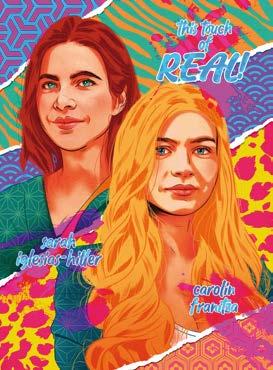

Draped in Belonging
An interview with Highsnobiety’s Vice President Creative & Buying
Herbert Hofmann and Setchu designer
Satoshi Kuwata
126 Contemporary Wins – how womenswear is transforming into a lifestyle with a great deal of style and a dash of pragmatism
134 An Italian Success Story – told by denim brand Latinó
146 Feel Good! – Liv Bergen crafts feel-good clothing
148 From Workout to Weekend –playfully effortless in Deblon Sports Fashion athleisure wear
154 Supporting a Worthy Cause with Mareile Höppner – Kennel & Schmenger acts
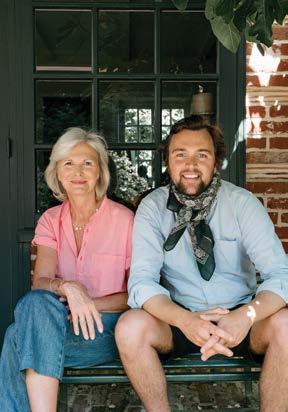





160 A Place to Be – where womenswear is brought to life









172 A New Need – what comes after the it-bag



180 “We Create Worlds” – White Milano underlines its claim 144 “We’re Not Luxury, We’re Artisans” Moismont, a French family affair





















































188 All About Fusion – at AlphaTauri
190 People of Shibuya: Back to the Roots – An Eye on the Future
191 Antony Morato: A Cultural Force
192 Fil Noir: Strengthening Strengths
193 40WEFT: “We Support Our Retailers”
194 Twothirds: The Perfect Wave
196 P448: “We Are a Lifestyle Brand”
197 Parajumpers: Changing Through Time

200 The Rise of Us The next generation speaks

206 A New Foundational Era: What New Generation Start-Ups Need
209 Hammermann Concept Store: “The Retail Industry Requires a Generational Change”
210 Rey – The Store: Appeal
212 eRBe: “Hot Shit”
214 Studio Drei Punkt Eins: “I Want Everyone to Leave Feeling Satisfied”
215 Enrobe: “We Appreciate This Amazing Opportunity”
216 Andwell Store: The Self-Conception


256 “It’s Not About Perfection – It’s About Relevance,” says Rasmus Storm, owner of the cult store Storm in Copenhagen
212 BREAKING CODES Menswear in transition
231 Diktat: “Luck Is No Coincidence”
233 Baracuta: Britishness
234 Prohibited: “We Don’t Want to Be Gangsters”
236 “Streetwear Has Opened Many Doors,” says Lars Braun of Braun Hamburg, of all people!
240 U Got The Look – where does the new new menswear become immersive? In stores.
250 Once Around the World: This is where (street) culture is shaped

FALL/WINTER ‘25


Too good to be true? Even better!
Copenhagen’s fashion people reveal their favorite spots


















284 “Close Collaboration as a Blueprint for the Future” – 100 years old, yet young at heart with Dominik Gross: Creation Gross
289 Impulso: Data-Driven Change
290 Upstream: Where the Magic Happens































Smarter Faster Greener?

278 “AI Is Simply a Tool,” says futurist Jürgen Alker








Genera is a future-oriented solutions provider




294 True Religion: Easy Romance







295 Alpe Piano: Seasonless
296 Colmar Originals: More Than Mere Outerwear







297 Avant Toi: Cocooning
298 Keeling: The Beauty of Nature




304 Pride to Be: Cuddly for the Outdoors
305 Maximilian: A Promising Start





306 Floris van Bommel: Cool Classics

307 Hiltl: Classic… Differently!





324 Altramoda/Traunstein “You Need a Good Product!

326 10 Corso Como/Milano A New Chapter


327 The Budims/Vienna Viennese Blue Bloods

308 Hartford: Quiet Luxury Sports and Casual Wear
309 Scandinavian Edition: Urban Practicality








310 Coming Up Tendencies & Forecasts for Upcoming Seasons



328 EDITOR’S LETTER The Future is Wide Open
328 ABOUT US


campaign agencies showrooms IF A PAIR OF TROUSERS NOT ONLY EXPRESSES YOUR CHARACTER, BUT STRENGTHENS IT – THEN YOU‘RE WEARING raffaello rossi.








With this issue, Martina Müllner bids farewell as editor-in-chief of style in progress. In conversation with Stephan Huber, the two reflect on supposed superficiality and genuine sense of belonging, paradigm shifts, and, of course, a future that is wide open.
Artwork: Alexander Wells @alexanderwells
SStephan Huber: Those who are not born into fashion often wind up in this strangely wonderful industry via a few detours. Can you tell us about your journey? To be honest, I still have no idea why you ended up in Milan back then.
Martina Müllner: I think I need to elaborate on my background. I come from a family environment in which a preoccupation with outward appearances, such as fashion, was almost frowned upon. Perhaps my interest was initially merely a counter-reaction. Yet when I think about it, I realize that it was never fashion itself that fascinated me, but rather the stories shaped around it. I saved up my pocket money to buy all manner of magazines. I was one of those people for whom every move was extremely exhausting, as I had to haul boxes of magazines along with me. I particularly admired the photography. Fashion and still life photography captured my heart. That was the golden age of fashion photography, at least for our generation. All the iconic shoots by Peter Lindbergh, Mario Testino…
At 15, I started working in press photography alongside school, bringing me a step closer to my dream. Convinced that I would eventually be a photographer, my long-term goal was fashion. Why? Because I gained insight into how news is constructed, especially the fast kind. It quickly became clear to me that I wanted to find a topic that was as apolitical and uncritical as possible; even back then, genuine research was rare. I believed I had found an unproblematic field in fashion – something along the lines of the worst thing that can happen is that people choose pink over purple.
It is not that simple though, is it?
Exactly. The last 20+ years have taught me that fashion is anything but trivial. Fashion is of profound social relevance, definitely not neutral or superficial.
I totally agree! Are you saying that you were drawn to the fashion industry based on a misconception?
In a way, yes. I started my journalistic training in Milan because I was planning to study fashion photography there, at Superstudio. I figured I would complete the journalism course first, learn Italian, and then move on. Funnily enough, a magazine served as my springboard yet again. I read about a scholarship in Marie Claire magazine. I applied on a whim, won it, and moved to Milan when I was 19. The programme was very Italian – in short: relaxed. The morning was
reserved for the first semester, the afternoon for the second. After two weeks, I approached the administration and told them that the pace was way too slow. I asked whether I could take both years at the same time. They agreed, to some extent because I enjoyed a kind of child prodigy status, having previously worked on a relatively unspectacular Austria supplement for Elle magazine. But that sufficed to earn me some fame. (laughs)
After completing your education, you joined style in progress and assumed responsibility very early on. You were thrown in at the deep end almost immediately. Sorry about that! But maybe it was not so bad after all? Would a career like yours be possible today?
I believe young people today are no more afraid of responsibility than I was at the time. Yet a career like mine, in which you grow and develop in different roles in a company for more than 20 years… perhaps that is less common now. I understand the urge to keep reinventing yourself. I was simply fortunate enough to do so within and beyond style in progress. I reckon this is the challenge for employers: to support their employees through these professional transformations. Think about how many different tasks I have performed here at style in progress. This is anything but a single job. And now it is changing yet again!
Indeed. The fashion industry faces the challenge of recruiting and retaining talent. Do you believe there is a secret formula out there?
We need to be smarter about how we represent our industry. I feel frustrated by how distorted the representation of fashion is. The spotlight is always on the extremes, the purple hair and latex skirts. It gives the impression that you need to be super freaky to make it in this industry. That does not reflect the wide range of jobs available at all. No one out there realizes that you can have a perfectly ordinary nine-to-five job in fashion, if that is what you want.
This brings us to your other favorite playground –communication. Would you argue that the drastic change that has transformed fashion in recent years also applies to the way we communicate?
Absolutely! I presently see two opposing trends in communication. On the one hand, we are experiencing an incredible amplification – communication is much easier to establish thanks to AI and digital tools, everyone shares everything. This leads to oversaturation, of course, and I dare to predict that moving away from doom scrolling on social media will be a major topic of 2025. The countertrend is personal






communication. Provided it is authentic and arises from genuine attachment, it cuts through the noise all the more. Yet for me, effective communication begins with something completely different.
And that is?
Listening. The ability to tell stories is one thing, but hearing them is another. This may sound trivial, but I increasingly perceive my role as that of a listener. I then structure what I have heard and decide how to convey it. If you want to be heard, you must dare to have an opinion and adopt a clear position. Being vague or trying to appeal to everyone stopped working a long time ago. So many brands claim to make the best t-shirt, but the ones that really make a difference are those that also convey an opinion and a position.
Lukewarm approaches are no longer tenable…
Exactly. The idea of trying to appeal to everyone by standing for nothing has failed. The best example is the decline of traditional department stores. People crave a sense of belonging, but you cannot feel a sense of belonging towards something that is unsure of itself.
Speaking of belonging: the pandemic has disrupted all facets of the industry. Would you describe it as a catalyst for positive change?
Absolutely, my favorite example is retail. I feel that finding their own unique voice signified a turning point for many retailers. This is how relationships are formed. When the debate is no longer about where I can buy my t-shirt cheapest or most conveniently, but rather where I prefer to buy it because I feel a sense of belonging.
How do you think this development will impact the next generation of decision-makers in fashion?
I am extremely optimistic that these new values will change the face of fashion, driven by people who enjoy making a difference, improving things for others. Quite a paradigm shift, is it not?
Indeed. How does this transformation square with the realities of our industry?
My original career aspiration, to engage in something superficial, apolitical, and neutral, has failed miserably by this point at the latest! (laughs) It gives me great joy to shape this transformation with the means at my disposal. However, transformation requires communicative stamina and, in some cases, you cannot just write it into existence. You have to roll up your sleeves and get started!
By stamina, do you mean the resilience that the next generation is often said to lack?
To be honest, I learnt a great deal from the next generation. Our generation tends to mistake resilience for acquiescence. From the outset, the next generation asks: “Why is that so?” and “That’s just the way it is” no longer constitutes a satisfactory answer.
What advice would you give young hopefuls?
Be more open to compromise than you think, but uncompromising in what you believe in.
We always agreed that the best aspect of this job is perhaps the privilege of meeting so many great people. Were there any highlights?
Of course. Listing the big names is almost unfair, as a chance conversation in a trade fair corridor has often echoed in my brain and shaped my thoughts just as much. As a journalist, however, I relish the privilege of speaking to people you would not just happen to meet in the corridors of a trade show. Nathalie Massenet, for example, was a force of nature. We were quite early with the cover interview and I thought she was amazing on every level. Particularly inspiring as a leader, the emphasis she placed on how grateful she was for the achievements of her team felt very genuine. Carlo Rivetti brought a very different kind of energy to the table, but it was just as inspiring. I recall visiting the Stone Island archives and laboratories with him, and the way he talked about each piece – as if it were a living being – was fascinating. I loved the twinkle in his eye. No matter how profound the subject of discussion, there was always a hint of child-like amusement. He is a person who has never lost his sense of wonder.
The future is wide open – where is yours headed?
It is time for me to set aside my neutrality. For people, brands, and places – some of which have been in my life for quite some time, some of which are new projects. Besides, I have a promise to keep: I promised my daughter a holiday without the distraction of a mobile phone or laptop. She turns 12 in 2025 – so it is time to keep that promise.
THANK YOU, MARTINA, AND NOT JUST FOR THIS INTERVIEW…

ANTONES GmbH. Sarah Freise, D-61462 Königstein i.Ts., 0049 6174 9159566, mail@antones.de Düsseldorf. SHOWROOM Cecilienallee 20, 20. - 23. Januar / SUPREME 3. OG 3D10, 24. - 27. Januar München. SHOWROOM Lodenfrey-Park Haus C, 30. Januar - 7. Februar / SUPREME im MTC B515, 8. - 11. Februar Salzburg. SHOWROOM Gunther Grebe, Fashion Mall, 20. Januar - 21. Februar Hamburg. SHOWROOM Susanne Haase, Gärtnerstraße 18, 20. Januar - 5. März Düsseldorf. SHOWROOM Agentur Heck, Speditionsstraße 17, 20. Januar - 15. Februar Milano. WHITE , 27. Februar - 2. März
+390743252109
rose@latinojeans.it www.latinobrand.it





What new prospects have opened up for the company one year after the takeover of Habsburg?
Markus Meindl, Managing Director Habsburg & Meindl: We have managed to relaunch the brand after the insolvency of Schneiders, and to promptly position it in the retail sector. The new winter collection will be a clear commitment to highest quality and the brand, with which we will continue to push ahead with internationalization. We believe in the same values and are further developing the Luxury Country area.
What steps have been taken?
We are focusing on our values, the logo has been revised and our media presence has improved. Design has consistently worked on details and fits, bringing artisanship to the fore. We have placed even more emphasis on our style world and thus focused on a quiet luxury. The recognition of this and the resulting self-confidence can be found in the unique brand essence, allowing customers to immerse themselves in a special brand and value world. www.habsburg.co.at


Per Lei
33 years of Sem Per Lei. How has the brand developed?
Sabine Lohèl, founder of Sem Per Lei: Very positively, especially in recent years. We owe this to our uncompromising quality, with materials from and our production in Italy, and the combinability of our models. As a family business, we also have close contact with our retail partners. What makes Sem Per Lei unique? The intense color scheme, which radiates joie de vivre, as well as the travel-friendly nature of our materials. Our customers appreciate being ready for new challenges without compromising on style or comfort. www.semperlei.com
Timelessly beautiful and unique.

With the seasonal motto Touchable Pants, Alberto is positioning themselves as a specialist for smart, modern pants.

Understanding what the customer needs – this is where Alberto not only demonstrates product expertise. The hot topic for the current season: Touchable Pants, an ode to the feel and sensuality of the product, with plenty of leeway for the brand to show off unusual looks. “The fingertips that have to fall in love, I just can’t get that image out of my head...” says Marco Lanowy, head of Alberto. Together with students from the Niederrhein University of Applied Sciences, the company has taken a close look at Generation Y this season and developed a detailed view of the environment in which Alberto’s expertise stands out the most. “The exciting thing is that young people partly know us from their parents and when they get to know the product better or wear it, they are quickly convinced by its modernity. We often get feedback that they are impressed by how innovative we are,” says Marco Lanowy.
This is where brainstorming sessions with retailers come in. “In multidisciplinary teams, we listen, work on how we can improve together and implement solutions. The best solutions often arise from side notes.” Pop-up areas, open presentations, a modified brand environment – there is no stone Alberto isn’t leaving unturned.
“The pants must be made visible – with an aesthetic that invites you to touch and feel them,” says Lanowy. For more and more men, pants are becoming a way to express their individuality, for example for young professionals who discover that the right look earns them respect. ”For us, this means offering an entry-level premium price point.”
Whether it’s golf, biking or fashion, Alberto’s success always comes from curiosity about the special situation of each customer. “We know, for example, that we often only reach golfers with a handicap of four or more. Only then does he begin to think about how he can adapt visually and stand out at the same time.” Or in retail: “If our retailer sells 120 pairs of pants and their neighbor sells 180, then we know that there is still potential to be exploited – and we all love working on these big and small steps that shape long-term success.”


Carl Gross
To mark its 100th anniversary, Michael Berngruber, Division Head Carl Gross is starting a turnaround without diluting the DNA of the Carl Gross brand. The new direction is towards sporty casual wear and a well-groomed total look in natural shades, timelessly implemented with inspiration from the past. The new Time Traveler capsule collection is a modern, uncomplicated collection that can be mixed and matched. The high-quality Black Line has also been revised, artfully interpreting modern tailoring in a trendy way. For the first time and exclusively for its anniversary, Carl Gross is presenting a capsule collection with the two partners Olymp and Maerz Muenchen. www.carlgross.de


How are you modernizing Lodenfrey?
Leonard von Pfister, Managing Director: We have updated our tried and tested designs, reviewed and adapted our cuts, reconsidered the details and reduced them to the essentials to achieve a clearer style. Our customers are not necessarily getting younger, but the demand for modernity and fashion grade is higher.
With what success?
We have doubled our sales in the fashion segments compared to the previous year. Today, we are showing designs that I am convinced people did not expect from us – for me, this is the biggest milestone.
What are you focusing on for fall/winter 2025?
On coats – ranging from short, luxurious car coats in cashmere and with lambskin, to city coats and fashionable, long raglan coats, including a new interpretation of the classic Hubertus coat or the duffle coat. There are new types of jackets, such as a shorter field jacket that impresses with its clean lines and minimalism. www.lodenfrey.eu
Agentur SchulzAco is now representing bags and shoes by Love Moschino , as well as the ready-to-wear Moschino Jeans in Germany and Austria. “Both collections are designed by first-line designer Adriano Appiolaza and thus bear the same signature as the couture collection, and that convinced us,” says agency owner Michael Schulz. “For Moschino Jeans, the designer drew particular inspiration from Franco Moschino’s archive, which he translates into the present day with fashionable, colorful styles.” www.acomode.de



This season, Ecoalf is introducing a new circular wool line, in line with the motto “Designed for you, made for tomorrow”, to further reduce the use of plastic in the collection while increasing circularity. All wool knitwear is made from an extra-soft recycled mono-material. The line is also growing with timeless coats and a selection of thick vests and handcrafted sweaters, for example in bright red or blue.
When Ecoalf started in 2009, there were hardly any recycled materials. The transformation of recycled plastic bottles into fabrics for jackets and accessories was considered an innovation. Today, Ecoalf transforms synthetic textile waste, which is created from leftover fabrics and garments, into innovative fillings for fiber-to-fiber thermal insulation layers for jackets and coats from the now legendary Ocean Yarn series. Thanks to the more than 4,000 fishermen who now collect waste from the bottom of the Mediterranean as part of the Ecoalf Foundation’s Upcycling the Oceans project, this season will also see a new Berlin sneaker capsule collection with orange soles made from recycled TPU. The iconic knitted sneakers and boots are lined with a neoprene material to keep feet warm in the cooler winter months. Ecoalf shoes have one of the lowest CO2 footprints on the market. They are also 100 percent vegan, contain no metallic components, are PFC-free and are made predominantly from recycled materials. The new Tika accessories line is now also made from 100 percent Ocean Yarn and is available in new colors and sizes. www.ecoalf.com




The US label PSD is now stirring up the European underwear business. Numerous brand ambassadors from the world of sports wear the colorfully printed shorts and shirts, including Aaron Jones, NFL star of the Minnesota Vikings, NBA star Ja Morant of the Memphis Grizzlies, or young players from the college league like Kiyan Anthony, son of basketball legend Carmelo Anthony. There are also collaborations in motor sports, for example with the Fittipaldi brothers (Formula 2) or motocross rider Haiden Deegan. Key accounts in the D-A-CH region include Zalando, About You, Blue Tomato and the DEF-Shop. Distribution is handled by Chusaja, which has showrooms in Munich and Zurich. www.psd.com
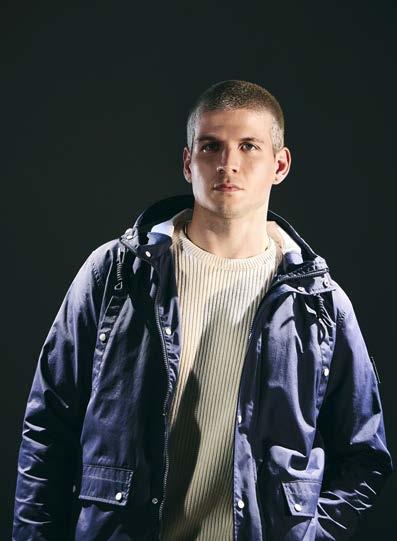
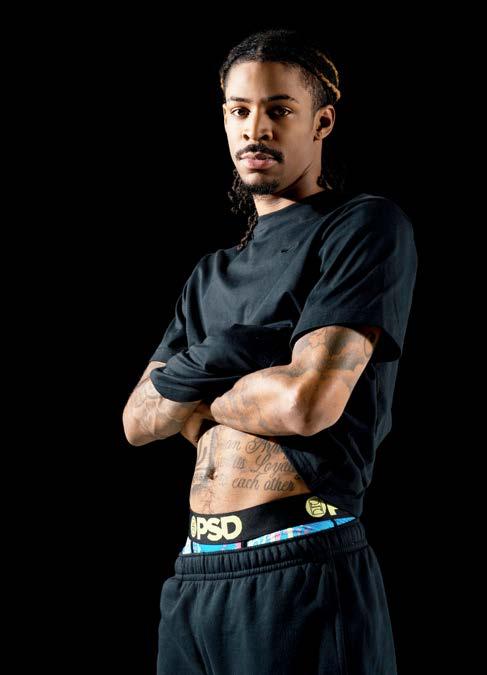

The brand, founded in South Wales in 2004, is synonymous in the UK with bold prints and designs that convey a heritage of the “admit nothing” attitude. Brand ambassadors include MMA fighter Oban Elliott and British actor Leo Gregory, with whom there is a capsule collection marking the continuation of the Green Street film series. The brand also supports the non-profit organization Calm, which is dedicated to preventing suicide among children and young people. The collection is distributed in the G.A.S. region via Chusaja, which has showrooms in Berlin, Munich and Zurich. www.weekendoffender.com
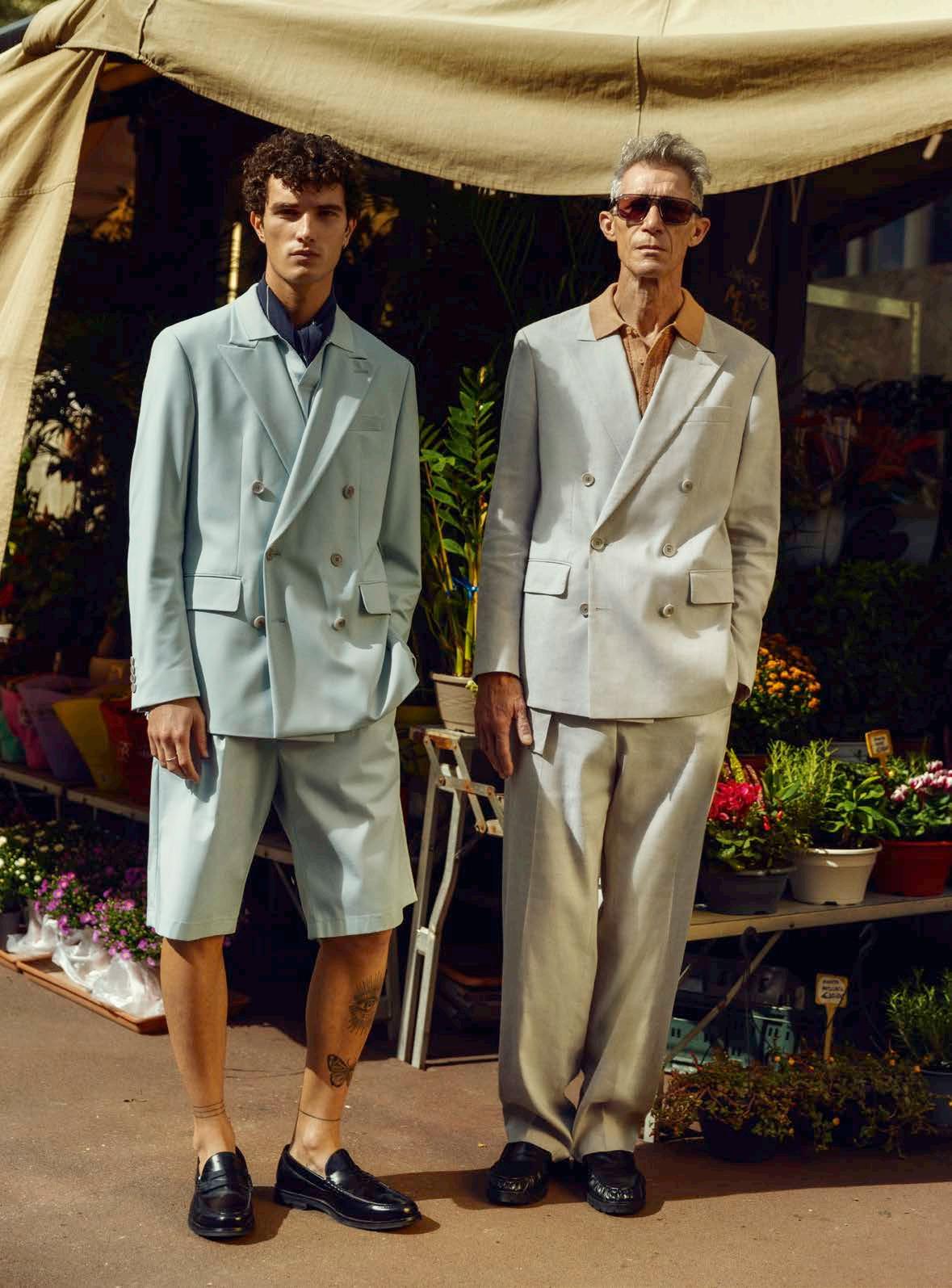



On Vacation
“Those who wear On Vacation radiate joie de vivre and make people smile – a philosophy that is attracting more and more followers,” say the founders of the label, which was established in Berlin in 2016 and stands for relaxed and carefree streetwear. The T-shirts and hoodies feature positive, humorous slogans such as ‘Paradise Is Very Nice’, ‘Do Nothing Club’ and ‘Dolce Vita’. @on_vacation_club
Rita in Palma
Ann-Kathrin Carstensen founded her label
Rita in Palma together with women from Turkey, Syria, Pakistan, Lebanon and the Kosovo in Berlin to help talented female immigrants escape long-term unemployment. The beautiful hand-crocheted jewelry and accessories combine high-fashion designs with inclusive work. www.rita-in-palma.com
1913
The latest leak-proof drinking vessel from the iconic US brand is the Stanley Cross Bottle, made of recycled stainless steel with an integrated, removable straw and color-coordinated, adjustable jacquard straps. It is the first portable, non-round, double-walled and vacuum-insulated bottle, perfectly combining a thermal function with fashion.
www.stanley1913.com

Komet und Helden
Showroom Munich
Lodenfrey-Park, Osterwaldstraße 10
80805 München
+49 (0)89 970 528 0
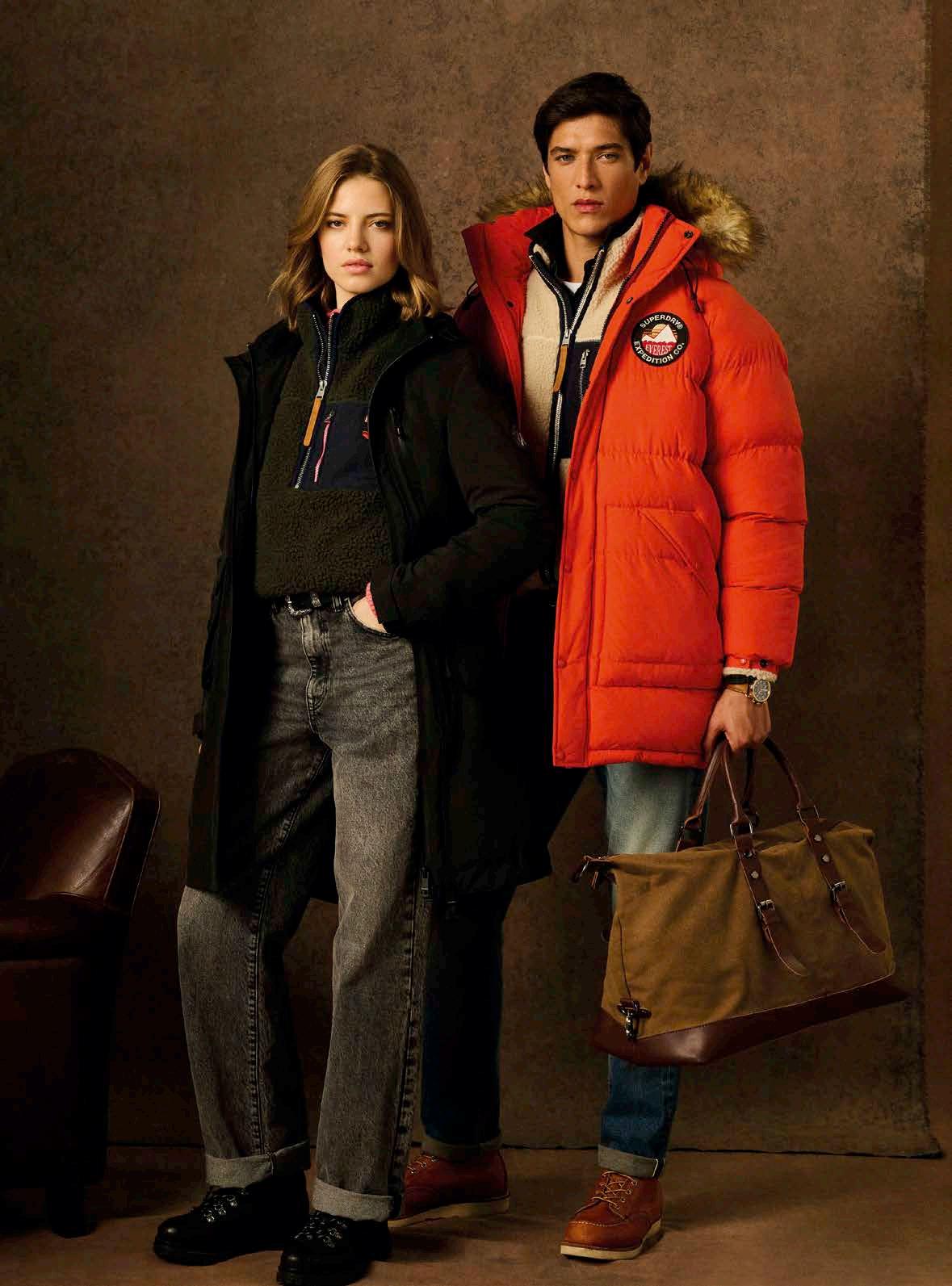
Komet und Helden
Showroom Düsseldorf
Medienhafen, Kaistraße 2 40221 Düsseldorf
+49 (0)211 209 509 0


Milestone
Francesco Rega, Managing Director of Milestone, puts a focus on the personal. The jacket specialist is always keen to engage in a lively exchange with his customers and is a reliable partner in this highly competitive business: Milestone relies on continuity.
Consumers want to feel comfortable and express their style. This certainly accommodates Milestone’s innovative spirit, doesn’t it?
Francesco Rega, Managing Director Milestone: Very much so! Our brand is firmly established in the minds of our customers, who always want to be able to rely on their jacket and express their personality at the same time. We have an extensive portfolio of unique designs that are, above all, clear, modern and independent of short-term trends. Casual cuts, vibrant materials, powerful silhouettes and lots of details set us apart. We pay particular attention to the reinterpretation of leather.
How has the expansion of the pre-collection worked out? Are you taking more risks?
We don’t really see it as a risk. Retailers increasingly expect customized and more flexible support and want an early delivery date. This year, the fall merchandise was introduced a little later than in previous years. Since the sales trend at the start was very positive, our customers were able to achieve good sales. Functionality, unlined shirt jackets and leather jackets were the bestsellers. The challenge is to offer new and wearable items at an early date. Furthermore, the early dates also offer a longer sales period without discounts, since many customers sell almost exclusively for two months. Where do you see the biggest challenges for the AW order?
Enormous cost pressure due to rising raw material and energy costs, which also leads to increased price sensitivity among end consumers. This development makes it more difficult for customers to make purchases and increases the pressure on us to keep prices competitive. More vertical and low-cost suppliers are also entering the market. In this environment, differentiation is becoming a key strategy for us: Quality and uniqueness are our advantages.


For the 100th anniversary of Création Gross, Ralf Klute, Head of Design CG – Club of Gents, presents a carefree party mood with the fall/winter 2025 collection: suit looks without jackets, combined with bomber jackets, overshirts or shirt jackets with pants that are moderately wide to create a casual statement. Jackets in understated patterns, oversized or clean, are the perfect complement to jeans, chinos or wide trousers in subdued colors. Savile Row by CG – Club of Gents presents Klute in an even more luxurious way, showing double-breasted jackets in clear lines, while Your Own Party by CG – Club of Gents showcases the celebration look in velvet. www.cg.fashion
Pin 1876 has undergone a pioneering digital transformation to optimize internal processes and improve service for retailers. The company invested a six-figure sum in a digital portal that simplifies the order process and strengthens relationships with retailers.
“We firmly believe in stores as a showcase to the world,” explains Alberto Zia, Managing Director of the renowned scarf manufacturer. ”This digital transformation simplifies the ordering process and supports our retailers in their daily business without burdening their stock levels.”
The new B2B portal is designed to meet the different needs of retailers. On the one hand, it enables large-scale orders with scheduled deliveries, while on the other hand offering a quick solution for reordering small quantities. These can be processed and paid for directly within 48 hours. The system guarantees speed and precision, thus addressing the everyday challenges of retailers, who often have to respond to unexpected emergencies.

“Quick service is one of our greatest strengths,” Zia emphasizes. ”Thanks to our complete control of the supply chain, we can deliver a finished product in as little as 48 hours – and without the need for inventory. This enables us to meet any demand in record time.”
Digitization also frees up resources. These can be invested in the development of new products and the strengthening of corporate communications.

Edition Off
Scandinavian Edition has been equipping numerous TV football commentators such as Laura Wontorra (in picture), Daniel Herzog, Laura Papendick, Ann-Sophie Kimmel and Alex Schlüter for quite some time now. Coaches such as Thomas Tuchel, who took over as manager of the English national team at the beginning of this year, have also been spotted on the sidelines, on TV and on social media wearing jackets from the Norwegian outerwear brand. @scandinavianedition






Manufacturers with high production standards and a family atmosphere characterize SALT in Salzburg.
Once again, SALT provides an exceptional showcase for high-quality, handcrafted clothing, shoes and accessories. Organized by Hubert Stolzlechner, the event at Gusswerk is becoming even more international and a must-see for discerning retailers and buyers on the hunt for truffles.
Among the new participants is Studio Ayasse. Tina Ayasse’s brand is known for its symbiosis of luxury and sustainability in leather and lambskin. Chrysalis from England stands for timeless quality. Spanish brand T.ba is also exhibiting in Salzburg again. Founder and creative director Mercedes Lopez de Carrizosa: “T.ba is a feeling inspired by my life and my soul.” Luxury brand Windsor, Phil Petter and Stetson will also be exhibiting for the first time. And, of course, many familiar names such as Habsburg, Meindl Fashion, Alpe Piano, Luis Trenker and Lodenfrey 1842. What makes SALT special is its atmosphere. The industrial charm of Gusswerk blends with the warm, family-like atmosphere of the SALT community.
SALT Order Days Salzburg, Gusswerk, @saltsalzburg, www.salt-salzburg.at
SALT01: January 21 to 22, 2025, SALT02: February 21 to 23, 2025








The iconic American brand has been a loyal partner of the Kölner Haie [Cologne sharks] ice hockey team since the 2015/16 season.
“With Stetson, we not only share a passion for ice hockey, but also common beliefs such as the pursuit of high quality and good cooperation. We are very pleased that Stetson will remain at our side for another two years,” explains Haie managing director Philipp Walter. Stetson is the official partner for headwear and has been continuously present with a prominent logo on the helmets of the KEC professionals since the 2016/17 season. In addition, Stetson provides the Kölner Haie with caps based on the current helmet design for official events, which can be purchased in the club’s fan shops. “We would like to thank the Haie for the trusting ten-year partnership. This is something very special. It makes us proud to see so many fans in the arena who express their connection to the club and experience our brand with the Stetson x Haie caps,” says Stetson managing director Sebastian Boekholt. www.stetson.eu
During Copenhagen Fashion Week, the Poet multibrand showroom initiated by Phill Holder invites buyers and the press to network and work in the spacious rooms of an art gallery right by the Christianshavn metro station. From January 29-31, 2025, selected menswear, womenswear and lifestyle brands will be showing their collections there, with a focus on innovation, individuality, sustainability and craftsmanship. The platform acts as a hub for independent brands that focus on authenticity and a departure from mass production. www.poet-concept.com
During Fashion Week, around 50 brands will show their collections on two floors at the Poet Showroom.



The new Blauer USA collection combines innovation, functionality and urban style in four lines that meet the demands of a modern lifestyle.
B. Department combines streetwear with military flair. Redesigned bomber jackets, field jackets and parkas made of robust nylon and polyester offer durability and environmental efficiency. The colors plaza taupe and black-green reflect the brand’s “uncompromising performance” and make the line ideal for urban and natural environments.
B. Urban Police is inspired by American police uniforms and combines heritage with modern urban accents. The line features water-repellent, highly flexible materials and reflective details in a color palette of black and industrial blue. Functionality and comfort are emphasized by layering options and an urban, industrial aesthetic.
B. Essential is designed for modern flâneurs and world citizens. With multifunctional down jackets, reversible windbreakers and foldable windbreakers that can be converted into fanny packs, the line offers versatile everyday garments. The color palette includes blue, beige and black with accents in burgundy and pink. Technical materials such as waterproof and lightweight fabrics ensure high comfort and functionality.
B. Project is aimed at men with an affinity for futuristic design. The collection combines breathable, waterproof and windproof materials with minimalist black silhouettes. Practical details such as the flash pouch make the line particularly suitable for an urban environment and offer an ideal solution for dynamic city residents.


Reduction to the essentials: Saendorn is a new menswear label with timeless aesthetics and functional materials. It is based on Japanese principles that combine functionality and minimalism. “Made in Germany is the heart for us,” says Viktoria Vossebrecher, who founded the label with Joost Schwiebbe. “We place great value in highest-quality artisanship, respect for the art of tailoring and transparent production conditions.” The trans-seasonal pieces are only produced in small series of 20 or more, in order to be able to react flexibly and carry out collaborations. Distribution is also done selectively, with retailers who share the values, such as eRBe Raimar Bradt. www.saendorn.de

Founded in 1927, DMI is now one of the leading trend agencies worldwide. After four years of running the business together with his successor Carl Tillessen, Gerd Müller-Thomkins is handing over the management completely to Tillessen and retiring. Tillessen has already been driving forward the internationalization and diversification of the business in recent years. In addition to fashion, DMI now advises international manufacturers and retailers in the automotive, furniture and cosmetics industries. www.deutschesmodeinstitut.de

Fortezza da
| 14 - 17 January 2025
CORTILE DEL



Collezione N°01 Daniele Fiesoli
ESSENTIAL
The Collection N°01 combines minimalist chic with exciting accents. Soft knit characterizes the collection. Fiesoli himself says: “What remains is a woman who likes to combine minimalism with interesting details – and always pays attention to quality. These are the essential pieces for a wardrobe.” www.danielefiesoli.com
Rossi
With Edition 06, Rossi is expanding its collection for fall/winter 2025 to include four denim styles, available in the colors blue and black. The unisex designs are made of modern, authentic denim. Highlights include the signature styles Noa and Noa Cropped, a high-fashion O-shape variant, and a striking extra-wide denim style. @rossi_pants
“The boots by Mono are actually classic hiking boots with all the outdoor features and a lambskin lining,” says Reyhan Lohmueller of Rey – The Store. “Great color combinations, interchangeable laces and an interesting sole design make them a fashion statement.” With retail prices of up to 319 Euros, some models have a visible lining for a cozy look. @monofoo, @reythestore


Timeless denim, well-thought-out design: The.Nim standard returns to the Komet und Helden agency for Germany and Austria.
Back to the roots: for the new season, the Italian denim collection is returning to Komet und Helden, together with Niklas Rill. “We are delighted to renew our partnership with the agency for Germany and Austria,” says denim enthusiast and founder of The.Nim Standard Claudio Parolini. “Together, we want to become even more visible and further establish the brand as a benchmark for timeless, high-quality denim.” The women’s collection focuses on flowing and generously cut silhouettes. The bestselling styles Emma, Debbie and Farrah have been further developed and new fabrics added. Blends with Lyocell and Modal ensure a particularly luxurious, soft feel. “For The. Nim Uomo, new selvedge fabrics inspired by Japanese artisanship are used,” adds Claudio Parolini. ‘The fits are becoming more relaxed for a modern, casual look.’ What else makes the collection a success, besides a very well-developed product? The price-performance ratio with a good balance. For example, the jeans cost between 189 and 229 Euros, at a retail markup of 2.8. “Constant prices are the cornerstone of our business, which we are able to offer thanks to a lean structure and strong supply chains,” explains Parolini. “They justify the trust our retail partners and end customers place in us, as does our reliable support.” www.thenimstandard.com
Everybody is welcome: Drykorn will be back in Paris and Copenhagen for the fall/winter 2025 season. The brand’s menswear and womenswear will be presented at the Paris showroom on Rue de Thorigny from January 22 to 26, 2025. In Copenhagen, the brand will be exhibiting from January 28 to 30, 2025 – not at CIFF, but at the multi-brand showroom Mandatory. www.drykorn.com

Paris (and Copenhagen) is always a great idea: Drykorn.

Glücklich
The production radius of Glücklich, based in Eppan near Bolzano, is 500 kilometers. Pure wool fabrics from local producers are used, which keeps prices down – and has become a standard that Christoph Steiner and Claudia Heiss no longer deviate from. After 17 successful years, they restructured the spring/ summer 2025 collection into a women’s collection with a focus on knitwear and blouses. “These two product groups generate the highest sales and are emblematic of our urban lifestyle with Alpine influences,” explains Christoph Steiner. The collection is available from the Manners agency in Milan and at the company’s own showroom at the Glücklich store in Eppan. This is also where logistics and the back office are located. Christoph Steiner: “A distribution partner for the region north of the Brenner Pass is certainly the next big step.” www.gluecklich.it


Since its foundation in London in 2002, Mou has stood for high-quality, handcrafted shoes and accessories made from luxurious materials. Inspired by the wild beauty of nature and the spirit of adventure, the brand uses carefully selected sheepskin, calfskin, goatskin and lambskin leathers that impress with their softness, durability and natural aesthetics. Through ethical production and sustainable practices, Mou combines traditional artisanship with innovative design to create timeless models for women, men and children. The fall/winter 2025-26 collection also stays true to this aspiration and embodies the brand philosophy: Live simply. Love nature. www.mou-online.com
Quartz Co. is part of the Virtus portfolio.

Peter Nürnberger founded Virtus Consulting GmbH together with Andre Pelzer, Markus Zanier and Philipp Wirnsperger at the end of 2024. “We combine our expertise and connect with sales agencies worldwide to position brands internationally,” says Peter Nürnberger. “In addition, we enable the import of brands thanks to our warehouse in Innsbruck, and we provide logistics and customer service.” Consulting is also part of the strategic development of the brands, which applies not only to sports and fashion brands. The initial portfolio includes not only Quartz Co., Refrigiwear and Diktat, but also Bachgold Selfpress water filters, which Virtus distributes worldwide. www.virtus-consulting.eu
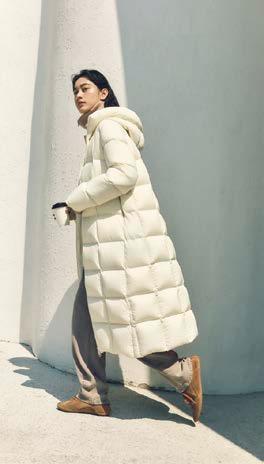


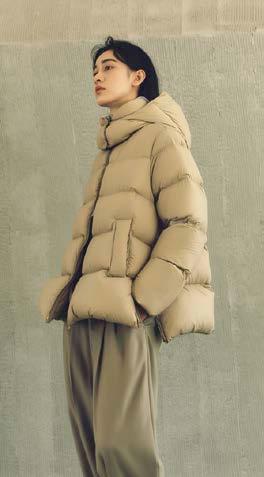


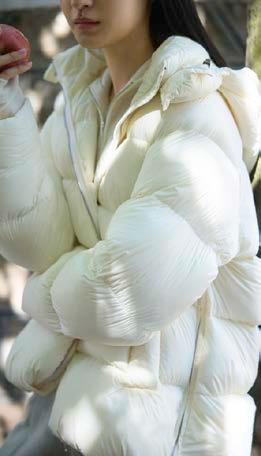
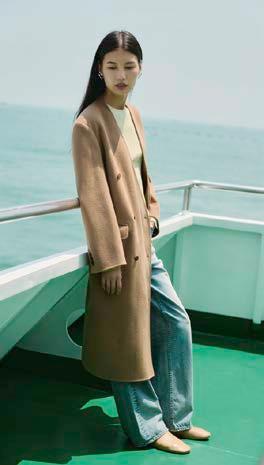



drinking water as
The TerraSkin Trailrunner by X-BIONIC combines groundbreaking technology with modern lifestyle innovation. Developed for adventurers who demand the highest performance and style, this trail shoe sets new standards for conquering nature. The TerraSkin upper is lightweight, breathable and extremely durable. It adapts to even the most de manding terrain, provides reliable water protection and excellent ventilation. The adaptive grip sole, inspired by nature, ensures optimal grip on any surface. Thanks to the patented Shock Absorption System, every step is gently cushioned to effectively minimize fatigue. With its minimalist design, the shoe combines performance and aesthetics, making it the ideal companion not only on the trails, but also in the city. Sustainability is also a focus: Recycled materi als and environmentally friendly production underline X-BIONIC’s commitment to the environment.

With the official launch of their charity collaboration “From Mannheim to the World”, Goldgarn Denim proved that fashion and art can form a powerful symbiosis. Last December, numerous guests gathered in front of the backdrop of Port25 – Raum für Gegenwartskunst [space for contemporary art] – to support the mission of clean drinking water as a human right. Local artists Timi Rößing and Water is Right

Whether for trail runners, explorers or urban adventurers – the TerraSkin Trailrunner by X-BIONIC proves that high-tech functionality and style can harmonize perfectly. It sets new standards in the world of performance gear.
Industry insider Thomas Jaeger took over as managing director of menswear specialist Dressler at the beginning of 2025. Julius Brinkmann believes Dressler is ready for the next steps in its growth and is relying on Jaeger’s expertise, most recently as managing brand director of Strellson and CEO of the ski brand Jet Set. “With its extraordinary history and high standards in the selection of materials and product quality, Dressler offers the best basis for success,” explains Jaeger. “With passion and my industry knowledge, we can successfully lead the development and internationalization of the brand, which has already begun, into the future.” www.dressler1929.com

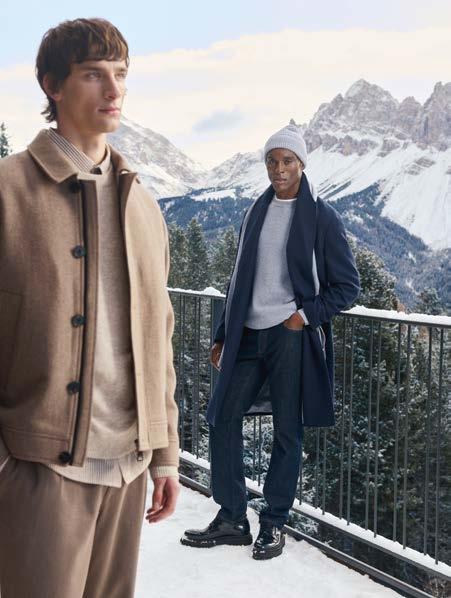
of the
With its fall/winter collection 2025/26, Save The Duck is demonstrating how technological innovation and sustainable design can go hand in hand. Inspired by the world’s highest peaks and the adventurers who conquer them, the collection pays homage to the human spirit of discovery.
The centerpiece is the 14 Peaks capsule, dedicated to Nepalese mountaineer Mingma Tenzi Sherpa. Tenzi has already scaled 13 of the world’s 14 eight-thousanders and is on the verge of completing his historic mission – in an expedition suit free from animal products. This was developed together with vegan mountaineer Kuntal Joisher, who challenged Save The Duck in 2019 to create extremely high-performance, sustainable equipment. Designed by Satoshi Yamane, the designs are characterized by technical precision and a modern style. Sealed seams, insulating stitching and ultra-light micro-ripstop fabrics ensure top performance. Geometric patterns inspired by Jofery’s original equipment, as well as interior prints celebrating the 14 peaks, add stylish touches.
In addition, the collection presents another milestone in sustainability with the Beyond Waste capsule. It uses materials such as recycled PET from remote mountain regions and Thermaloop™ padding made from recycled textile waste. This combination unites environmental awareness and performance at the highest level.
With versatile layering systems, the collection also offers flexible solutions for every season. Urban designs combine contemporary aesthetics with outdoor performance – for everyday wear or your next adventure. www.savetheduck.com
Sven, after the face lift of the Roy Robson brand – what is on the agenda this year?
Sven Brüggemann, Director Brand and Product: The face lift of the Roy Robson brand is taking shape. We have fundamentally revised the collection and, in addition to the product, we are also seeing our shop-in-shops at the POS with a new look and feel. What is the focus of the current collection?
The fall/winter 2025 collection, entitled “Fall into Comfort – Slow down in the Mountains”, is characterized by our inspirational looks. We are more contemporary, more fashionable than before, and we are also placing a greater emphasis on New Formal. The new take on formal wear impresses with technical qualities ranging from autumnal flannel stories to suits with jackets, bombers or overshirts. The focus here is on “different ways to wear”, because we want to offer our customers solutions for every occasion. We also rely on the categories coats, knitwear and chino. For the specialist trade, we offer end customer media that also underline our brand presence in B2C. www.royrobson.de


Duno continues to strengthen their presence in Germany. Thanks to the renewed cooperation with a leading premium retailer in the German-speaking region, the brand was able to further consolidate its position despite the challenging market situation. A key part of this strategy was the exclusive collaboration with the Munich fashion house Hirmer in December 2024. For the presentation of the autumn/winter collection 2024/25, Duno used an innovative shop window concept consisting entirely of down panels. Minimalist designs and clean lines reflected the brand identity and effectively showcased the high-quality jackets. Tubular supports gave the display a modern and appealing look. With around 200 points of sale in Germany and targeted partnerships like this one, Duno is further expanding its market presence. “Such partnerships are a central component of the company’s long-term growth strategy,” Wang concludes.

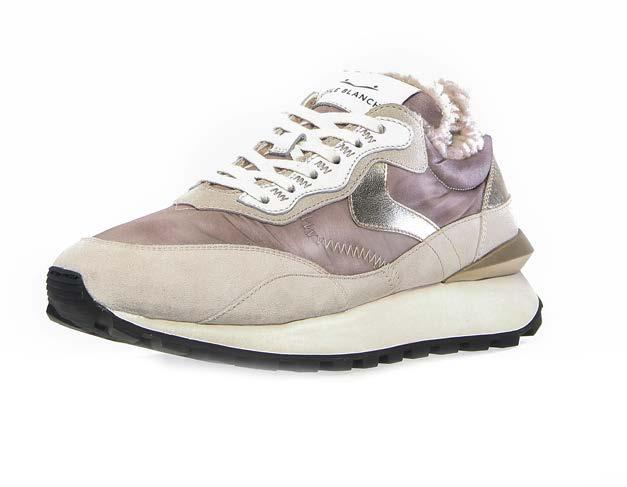

What new developments can we expect in the coming collection?
Alessandro Bisconti, Brand Manager Voile Blanche: The new collection combines innovation with our brand essence. We are focusing on vintage effects, washed materials and stone-wash processes that create a deliberately imperfect look. This style reflects the spirit of the times while also showcasing our craftsmanship. We will also be presenting products with a special foot shape. It’s a small risk, but we firmly believe in it, because originality and the extraordinary are part of the brand’s DNA, no matter what the sales forecasts look like.
How does Voile Blanche deal with the pressure to innovate? Innovation should not lead to a loss of identity. Many brands lose themselves in the pursuit of novelty. We, on the other hand, develop in a targeted way, without losing sight of our brand heritage. Our strength lies in bringing innovation into line with our values and history.

Nenette
Nenette from Italy is new at Agentur SchulzAco. For the fall/winter 2025 season, the creative collection combines Italian fashion sense with influences from Asia and the Far East, with surprising combinations of materials and patterns such as floral and micro-geometric jacquards on nylon or wool twill. Feminine blouses and figurative motifs are reminiscent of Japanese kimonos, with asymmetries and floral embroidery inspired by the art of ikebana. Another argument in favor of Nenette? The average purchase price of 80 Euros with a mark-up of 3.0. www.acomode.de, www.nenette.it


Friendly Hunting goes next generation: Mia Goldmann, daughter of Friendly Hunting founders Christian and Michaela Goldmann, is now supporting her parents in the family business. “My decision to join Friendly Hunting combines my passion for sustainability, quality and community,” says Mia Goldmann, Manager Business Development and Strategy. “With openness, team spirit and dedication, I am working to make a positive difference.” Friendly Hunting stands for mindful luxury and a living culture of artisanship, in both the womenswear and, for the past three seasons, the menswear, manufactured in Nepal. www.friendlyhunting.com
Leisure favorite Soldout presents itself in a wide range of styles for fall/winter 2025: five themes shake up the brand, known for its exceptionally soft modal qualities. In addition to Daily Modal, there is Winter Satin, Cord and Soft Touch. The denim line has also been expanded, dedicating itself to the theme of dark denim this winter. As one of the mainstays in the Modeist portfolio, Soldout not only offers particularly retail-friendly conditions, but can also serve as a basis for private-label collections. www.modeist.com

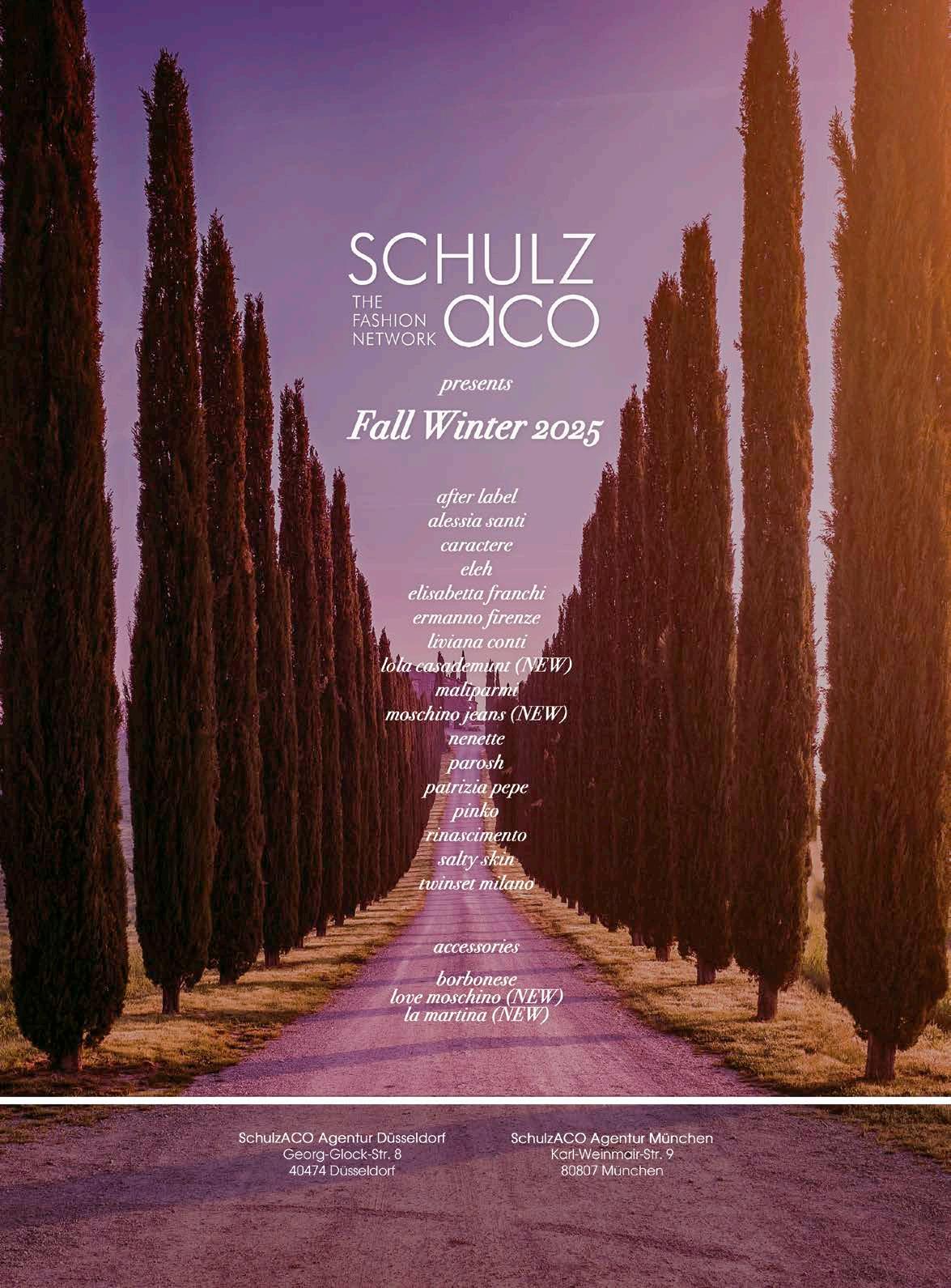




Della Ciana Cashmere has been synonymous with finest knitwear at the highest level since 1978. Today, the brand belongs to the family-owned company Al.Ma.Tes, which combines tradition with new innovation to create super-light cashmere styles, complemented by ultra-fine merino styles in 24 colors. New arrivals include knitwear in a 3D look and thermo-regulating yak wool. www.dellaciana.it
Circolo 1901 is focusing on innovation with its new fall/winter collection. The famous jersey fabric has been reduced from 800 to 700 grams. This results in lighter, more modern designs with clean silhouettes and high wearing comfort. Founder Gennaro Dargenio emphasizes that this optimization combines comfort and aesthetics, in line with the timeless style of the brand. www.circolo1901.it
Duno is once again focusing on luxury with Attic. Following the great success of the first season, the capsule is being expanded. The new jackets are made of high-quality cashmere and Italian wool and are water-repellent, thanks to innovative treatments and organically based membranes. In addition to classic single-color models, there are also micro pied-de-poule patterns in exclusive colors. d-duno.it

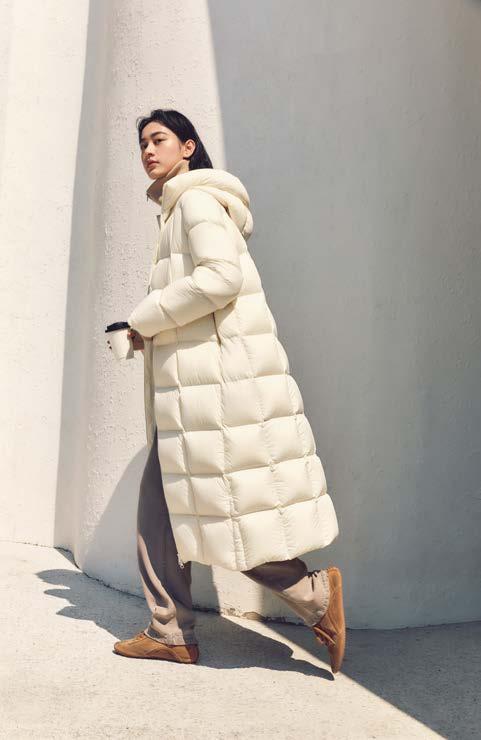

Urban, minimalist, progressive: JNBY and Less by JNBY, highlight collections at Modeist.
Since its founding in 1994, the JNBY Group, known for its innovative designs and unconventional collections, has grown from a small company in Hangzhou to an international player. With the brands JNBY and Less by JNBY, the group is continuously expanding its presence in the DACH region.
JNBY stands for “Just Naturally Be Yourself” – a philosophy that celebrates freedom and nonconformity. Starting in the coming season, the focus will be squarely on outdoor clothing: with down jackets between 299 and 499 Euros/retail price, the brand is ready to provide the commercial foundation for premium product ranges. Total Look is moving to a sub-line that will now operate under the name Less by JNBY. Less by JNBY was already able to win important accounts such as KaDeWe, Donna in Hannover and LNZR in Graz after its wholesale launch in summer 2024. In cooperation with Agentur Modeist, both brands are driving their expansion in the DACH region forward – from wholesale partnerships to shop-in-shops and franchise stores. The JNBY Group even supports potential partners in setting up their stores. In line with the customer structure of Modeist, JNBY and Less by JNBY also focus on individual retailers, who, for example, have access to a large seasonal warehouse in Germany.
The fall/winter collection 2025 will be presented in two showrooms: in Munich, the designs will be on display at Fashion Mall Bronce from December 1, 2024 to January 22, 2025 and again from January 29 to February 20, 2025. At the same time, the collection will be available to order at the Modeist showroom in Düsseldorf at Sternhaus from January 20 to February 6, 2025. www.modeist.com
Shift brings new energy to menswear –compact, selective and future-oriented.

On January 26 and 27, 2025, Shift will open a new chapter in the Netherlands’ trade fair landscape. At the Taets Art and Event Park near Amsterdam, the focus will be on quality rather than quantity. Rick van Rijthoven and Lucel van den Hoeven, the original minds behind Modefabriek, are creating a platform for innovation and values – far removed from classic trade fair formats. Shift invites you to think about the future of men’s fashion: less showroom, more exchange, more ideas. “Change begins with a change of perspective,” says van Rijthoven. A community with vision – thought of internationally, started locally.

In fall/winter 2024, Two Flowers launched a shirt collection in Central Europe and Australia. Produced in GOTS-certified factories, the pieces by the formerly renowned Italian brand impress with their quality, sustainability, fair prices and an attractive retail margin. Subtle details, washed cotton and modern design characterize the collection, which comes in plain colors, stripes and prints. Packaged plastic-free and available in sizes from S to 3XL, the brand is now owned by none other than shirt specialist Heiko Storz. www.two-flowers.com, @twoflowers_thebrand

Sebago returns to Pitti Immagine Uomo with the fall/winter 2025 collection, confirming its position as a brand that combines tradition and innovation. In addition to their classic penny loafers, the collection includes versatile pieces such as elegant blazers, classic chinos and workwear-inspired jackets, including the Dorr jacket in a wool blend. Hurricane Diaz, a jacket made of technical nylon, adds a nautical touch, while the Anglo-American Coat line combines British elegance with American functionality. The complete look is rounded off by shoe models ranging from classic loafers to winter-proof docksides. Now available at Komet und Helden. www.sebago.com

For the fall/winter season of 2025/26, Bloom’s knitwear translates the iconic 1960s style into the here and now. Inspired by Twiggy and at the same time shaped by Hanseatic practicality, the collection combines retro chic with contemporary wearability. Knitted minis, small polo sweaters in a preppy style and short, fluffy jackets with brass decorative buttons represent a new elegance, as do an aviator jacket and blazer variants. The materials are also being upgraded, for example, a fluffy, luxurious, super-soft cashmere knit thanks to the mink wash process. In fact, the proportion of natural yarns in the collection is being expanded to include pure baby alpaca or pure
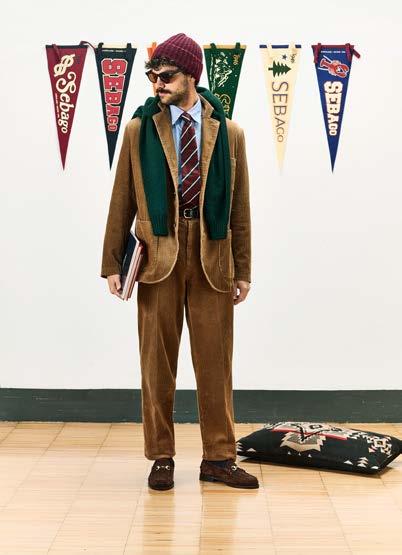

merino wool. Knitted wool fabric, newly interpreted as polo jackets, miniskirts, midi dresses with a boyish stand-up collar and boxy sweaters, defies the cold temperatures. Coarse-knit sweaters with hand-embroidered edge stitching are particularly unique.
And the colors? They are borrowed from nature and make the knitwear look even more luxurious and the stitch pattern even more expressive, from off-white and milky coffee to shades of brown such as taupe and dark chocolate. Delicate, intense berry tones and a fresh blue as an accent color go well with this. www.bloom-clothing.com
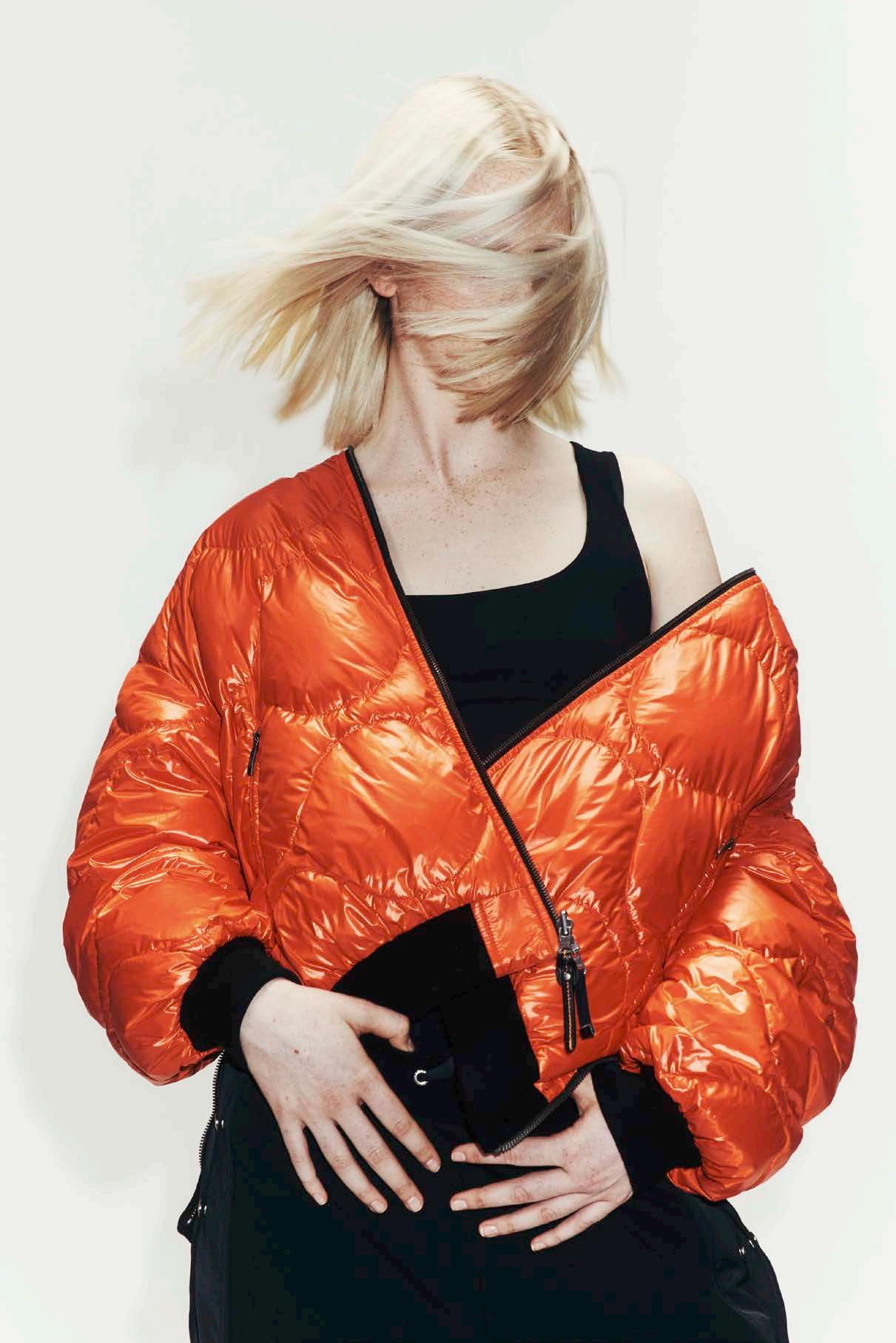


In January 2025, Eightyards officially began its work. The independent company is dedicated to innovative solutions for the recycling and reuse of material surpluses – far beyond the world of fashion. Founded by Hugo Boss, Eightyards pursues a clear mission: sustainable resource optimization and cross-industry cooperation. The concept is closely linked to the brand’s commitment to environmentally friendly production processes that conserve resources. Eightyards is managed by Marketa Miltenberger and Placido Klitzke, seasoned experts from the parent company.

Tamaris and the Wortmann Group are behind the shoe brand NEWD. Starting in spring/summer 2025, the brand will be driving its independence forward.
The aim is to serve the premium entry-level segment. “We are now also going our own way in sales,” explains Marlena Redeker, who is responsible for brand strategy. Sales are supported by the agencies FashionSuite and Nina-Jo Eibel, with Modeist joining them for fall/winter 2025. “The aim is to strengthen new business areas in fashion retail. To do this, we rely on a young, dynamic team and the backing of a strong company,” emphasizes Jens Beining, CEO of the Wortmann Group. @newd.tamaris

What challenges are you currently facing?
Michi Klemera, founder of Luis Trenker: Our potential is far from being developed to the extent that would do justice to the brand and the market. We want, and need, to break new ground. The last few years have been very challenging, and looking back, I have to say that we have been able to use this phase to our advantage. Humility and gratitude are important values for us, but so are tackling new opportunities and challenges.
What new paths are you taking as a result?
In 2025, we want to give B2B a completely new structure. To achieve this, we brought Martina Schmidl and Christian Hecht on board. They are restructuring the brand, providing advice and even taking over B2B management with their agency LEOON & THE CC AGENCY. This is how we want to bring the Luis Trenker lifestyle to life, and take it beyond our own channels.
What is the focus?
The focus is clearly on development and expansion with existing customers and their visibility, white spots in DACH region and an international roll-out.
www.luistrenker.com

Focus on short styles, innovation in materials too: IQ Studio is taking the blouson to a new level for the fall/winter 2025 season. Thanks to new fillings, the styles are becoming lighter throughout, such as an ultra-light real down puffer with down filling, which offers new comfort in a tailored cut, or a feminine down puffer with a touch of stretch that not only ensures lightness but also flexibility when worn. There are also lightweight down jackets in a new wave quilting look with a detachable lambskin collar, while active outdoor styles with real down and a new outer material with a 5,000mm water column offer even more functionality.
High-quality fake fur styles made of pure wool reimagine fur and teddy jackets and are complemented by short jackets made of double-faced wool and wool jersey. And of course, the unisex iconic bomber jackets made of recycled polyester, with knitted cuffs and collars and the typical lining, are an essential part of the collection. www.iq.studio
ID Eight is available as a 1990s basketball low or mid variant and in a running or indoor retro style.
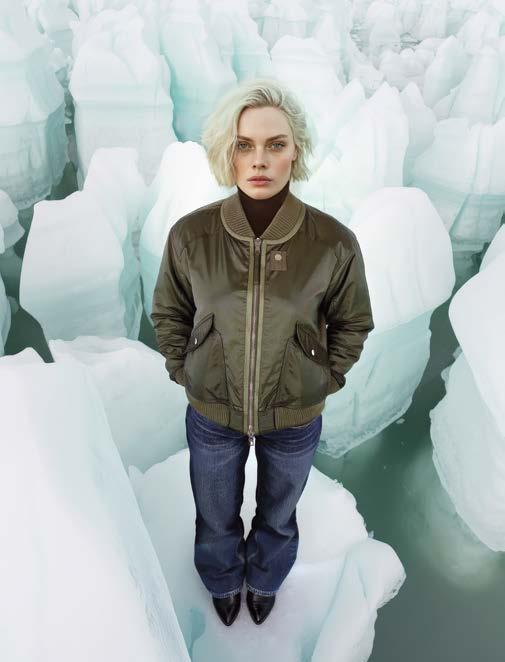

The brand was founded in 2019 by South Korean designer Dong Seon Lee and Italian product manager Giuliana Borzillo in Florence. It produces vegan unisex sneakers made of organic-based materials that contain 70 percent recycled materials and are manufactured in Portugal. There are four timeless models to choose from, in up to 16 color combinations, at retail prices between 185 and 240 Euros. “ID Eight is not only characterized by its unique design and striking silhouette, but above all, the shoes are extremely comfortable and produced without toxic chemicals,” explains Henning Kaesebier from High Five Brands agency in Munich, which is responsible for sales in Germany, Austria and Switzerland.
The brand promotes a circular economy and aims to avoid overproduction. Four types of material are used, obtained from agricultural or industrial by-products in Italy and Spain. These include recycled PES and biopolyols from corn crops that are not used as food, apple or grape skins and seeds, and recycled plastics and cotton from Europe. All suppliers are ISO and GRS certified. The ID in the brand name stands for identity and Eight embodies infinity, the ability to regenerate and thus ecological sustainability. Together with strategic partner organizations, ID Eight is committed to recycling and repairing worn shoes to extend product life and reduce waste. Around 200 international stores already stock the sneakers, and the community is growing day by day, with over 50,000 followers on Instagram. In-store events at which designer Dong Seon Lee hand-paints the shoes with individual designs are particularly popular. In addition to Pitti Uomo and Micam in Italy, ID Eight will also be on display at Supreme in Düsseldorf and CIFF in Copenhagen. New colors and combinations are added every season, and for the winter there are also water-repellent versions. www.id-eight.com




Timeless elegance with Cape Verdean origins: Alcidia da Veiga combines luxurious materials with a clear message of strength, identity and sustainability.
Where volcanoes, deserts and green valleys meet, lies the Cape Verde archipelago, home to Alcidia da Veiga. This label combines the rich culture of the group of islands with European elegance. It offers a unique interpretation of the multicultural roots of its namesake, Alcidia Kramer. Kramer, co-owner of Herzen’s Angelegenheit, grew up in Germany and now lives in Mallorca with her family. The designs are characterized by cultural versatility: Clean lines, luxurious materials such as silk and cashmere, and a focus on timeless and resource-efficient elegance.
“We see fashion as an expression of self-confidence and as an opportunity to shape the future openly – always in harmony with one’s own roots,” explains Kramer. The collection conveys a sense of comfort and security – values that are directly transferred to the wearer. At the same time, the label focuses on sustainability: The pieces can be combined in many ways, thus promoting a conscious, long-lasting wardrobe.
But Alcidia da Veiga is much more than just fashion, it is a statement. Diversity runs through all aspects of the brand, from the models to the brand message. Where do I come from, where am I going? These questions create an emotional connection to the wearers and emphasize the importance of strength and identity. “Our garments have an impact that moves and inspires – confident, secure and timeless,” says Alcidia Kramer.
The target group is successful women between the ages of 30 and 50 who value quality and sustainability. With its inspiring modernity and attention to detail, the brand occupies the price ranges between 260 and 440 Euros for knitwear and between 240 and 300 Euros for silk blouses. The collection is launched with a strong network of regional and European agencies, for example Modeist.
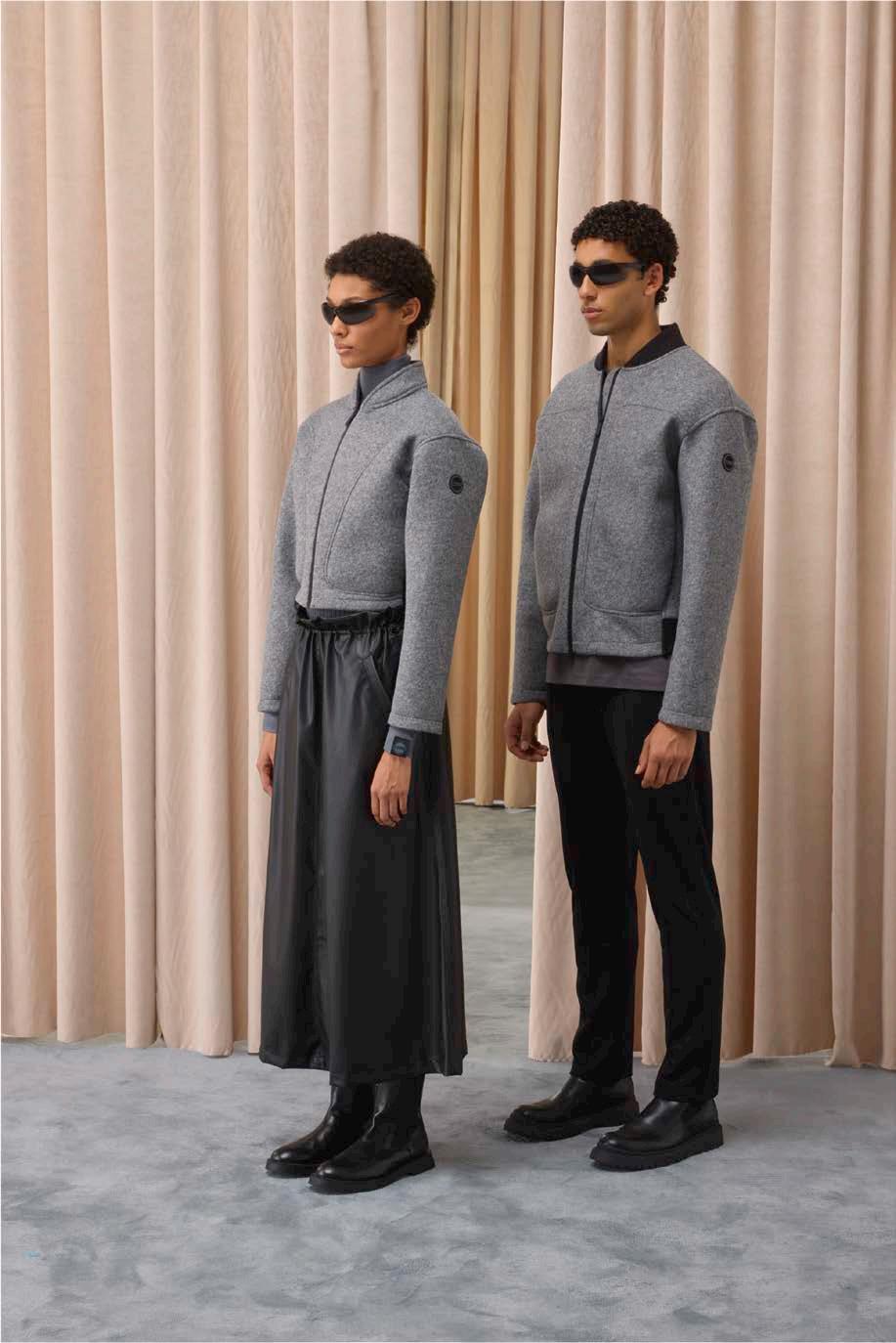

US fashion brand Rag & Bone is pursuing an ambitious expansion strategy in Germany and Europe. As early as 2025, several new flagship stores are to open in Germany’s most important cities. The first step is a 2,000-square-meter store in Düsseldorf, the brand’s second brick-and-mortar location on the European market. Further branches are planned in the exclusive shopping districts of Munich, Hamburg and Berlin. In total, the expansion will see ten new stores, including in the UK and other
European countries. Each of these locations will embody the brand’s distinctive, urban style and be realized in architecturally impressive buildings.
Alongside the preparations for the new stores, Rag & Bone is presenting its fall/winter 2025 collections in the renowned Ben and showrooms in Düsseldorf and Munich. The collections are characterized by a creative return to the brand’s DNA, inspired by the dynamic and diverse aesthetics of New York.
The women’s collection features a contrasting mix of robust silhouettes and sophisticated details. The focus is on statement jackets, luxurious leather and tailoring designs, high-quality

knitwear and the iconic Rag & Bone denim line. The men’s collection interprets the energy of the New Wave movement of the early 1980s, which shaped the cultural scene in downtown New York. With a modern approach, it combines the characteristic aesthetics of that era with innovative, contemporary designs. A highlight is the introduction of the new Infuse Denim line, which combines traditional artisanship with advanced technology in a unique fusion.
The Previews of the collections will be held at Ben and in Düsseldorf from January 22 to 31, 2025, and in Munich from February 5 to 12, 2025. Appointments can be arranged directly with Ante Brekalo (a.brekalo@ben-and.com).

Culturally rooted in the Danish capital, Mandatory aims to set a new innovative standard for collaboration in the fashion industry. Conceived by Clara Leone and Mads Petersen exclusively for buyers and press, Mandatory is the Scandinavian must-attend event for industry professionals. The personal and intimate atmosphere of the Oksnehallen in the Meatpacking District, not far from the main train station, makes it possible to get in touch directly with agencies or sales representatives of the approximately 200 brands, which range from beauty and lifestyle, sports and outdoor to street and womenswear.
@mandatorycph
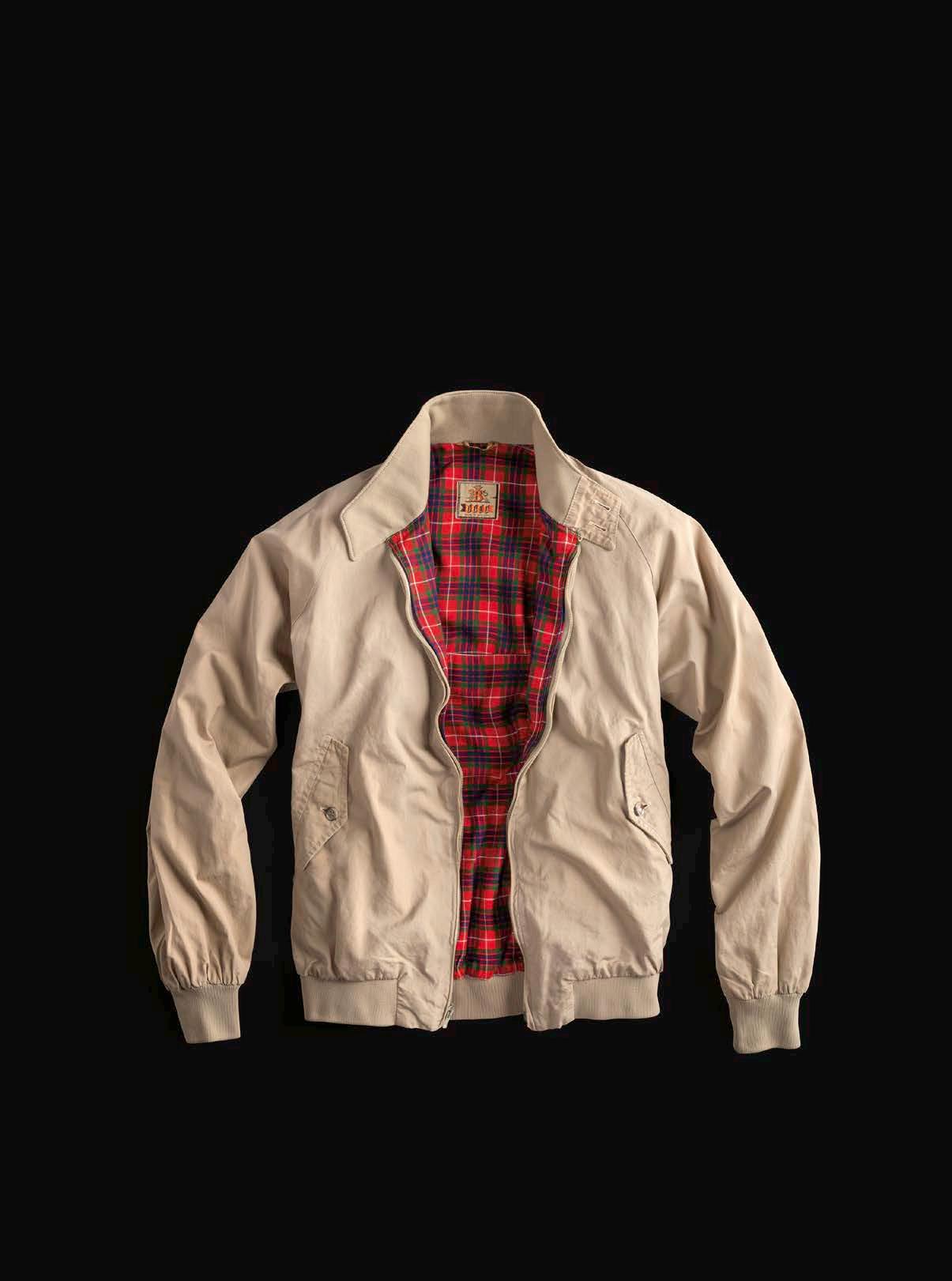

This season, the new Superdry collection once again embodies a successful interplay between tradition and innovation. With iconic statement pieces and versatile essentials, the vintage American look of British artisanship is celebrated: classic preppy elements are reimagined through cutting-edge manufacturing techniques and British textile design. Whether it’s weatherproof jackets, snow wear or tailored pieces, each item in the collection is a well-thought-out symbiosis of style and function. In addition, durable workwear, nostalgic collegiate looks and luxurious highlights round off the wardrobe. Available via Komet und Helden. www.superdry.de
For the upcoming fall/winter season, BOB is playing with unusually bonded fabric combinations that can be interpreted in many ways: denim, corduroy or velvet with a wool backing, wool with neoprene or cotton with knitwear – some of which can be worn on both sides. In addition to the very important ready-to-wear segment, which includes coats, jackets, suits and trousers, the Prato collection is expanding into the knitwear and jacket sector. Every season, a great deal of attention to detail and innovation goes into creating a distinctive look with many color variations for each piece, which is constantly being reinvented to a certain extent. @bobcompanytheoriginal




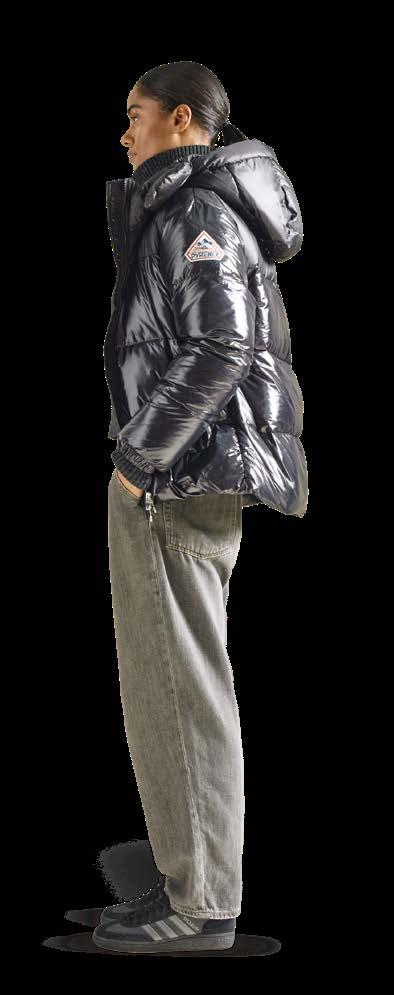
Bæstmor
Behind Bæstmor is House of Yarn, Norway’s most successful yarn manufacturer. In addition to the timeless Marius pattern, the collection focuses primarily on progressive colors and designs. With quality yarns such as merino wool, camel hair, brushed alpaca, mohair and cashmere, Bæstmor creates the unique “Rebel Granny Knit from Norway” look. Available this season at Fashion Factory by Mark Grütters. www.houseofyarn.no
Pants specialist Hiltl is launching a mobile POS display. “The shopping experience is becoming increasingly important. That’s why we rely on emotional presentation that puts our products in the spotlight. Our new pop-up concept offers our retail partners flexible options for presenting our range in an optimal and sales-boosting way,” says CEO Thorsten Grönlund.
@hiltl_official
The centerpiece of the French down collection Pyrenex is high-quality recycled down. Their unique expertise in its processing has been passed down for generations in the factory in Saint-Seve. All down is certified by the Downpass, which stands for animal-friendly, ethical and sustainable production. From the coming season, once again at Fashion Factory by Mark Grütters. www.pyrenex.com


Daniele Fiesoli Italia presents Botanica, a visionary capsule collection for the 2025/26 fall/winter season. Comprising of 20 pieces, the collection showcases cashmere, both pure and recycled, crafted using environmentally friendly techniques. Plant-based dyes made from natural pigments derived from leaves, fruits, roots and flowers, and chemical-free salt painting give the textiles authentic colors and unique textures. Clear, comfortable designs such as turtlenecks and ribbed knits in warm and vibrant hues – from shades of gray to peach and moss green – create references to nature.

“The Fashn Rooms, held alongside the Düsseldorf Fashion Days, are a meeting place for anyone interested in the latest trends and collections,” says Ulrike Kähler, Managing Director Igedo Exhibitions. “With a diverse mix of segments, it offers an overview of the latest developments in the industry.” Also taking place at Areal Böhler is the independently organized Neonyt Düsseldorf, an event that focuses on lifestyle and sustainable collections. On display from January 25 to 27 in Düsseldorf. www.fashn-rooms.com

See you in Düsseldorf: The Fashn Rooms at Areal Böhler.
What does Noumeno stand for?
Alessandra Migliolaro, co-founder of Noumeno: For the balance of aesthetics and functionality, for designs that are perfect for everyday life. The focus is on the sweatshirt, which is becoming a universal fashion piece. What else makes the collection special?
Our identity is an expression of our values, artisanship and authenticity. We focus exclusively on offline experiences and consciously turn away from e-commerce in favor of genuine, personal relationships. It reflects our commitment to quality and tradition, which is why Noumeno Concept is proudly and entirely made in Italy. www.noumenoconcept.com

Minimalist design, innovative materials:

PITTI UOMO FLORENCE
14. - 17. JANUARY 2025
PADIGLIONE CENTRALE STAND B/2-4
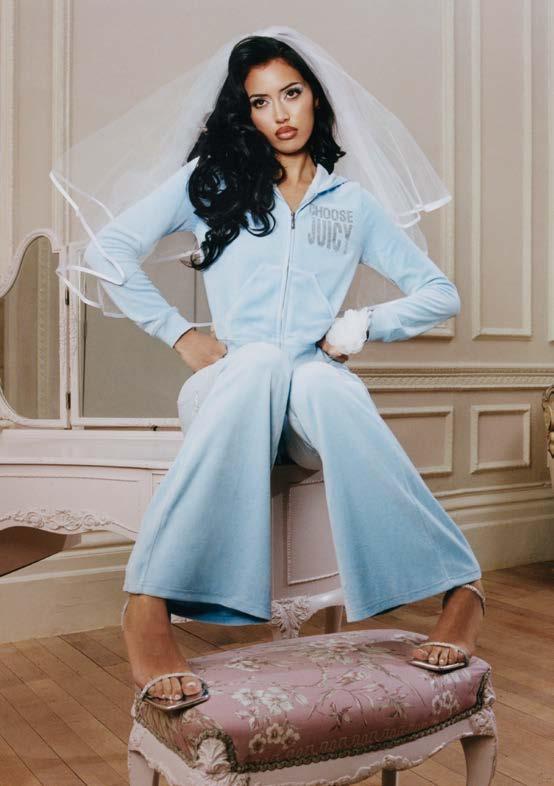
The lifestyle brand from Los Angeles embodies casual glamour and a carefree, sassy style. Juicy Couture stands for affordable luxury that appeals to customers worldwide. Originally founded in the 1990s by Pamela Skaist-Levy and Gela Nash-Taylor, the label became a must-have item of clothing for stars and starlets such as Missy Elliott, Britney Spears and Paris Hilton in the 2000s. The iconic velour tracksuits are, of course, once again the focus of the collection.
At the end of 2024, the first European flagship store was opened in London and in Berlin there was a multi-day popup event in cooperation with Voo Space to release the new campaign with model and influencer Cindy Kimberly. In DACH, Chusaja GmbH is responsible for distribution, with a warehouse in Germany.
The collection is shown in Florence at Pitti, in Copenhagen at CIFF and in Paris at Who’s Next. With Pre and Main, there are two collections per season, divided into a lingerie and a fashion section. The fashion line has three lines, White Label, Black Label and Heritage, which are then distributed in different ways. The cuddly soft velour tracksuits are available between 200 and 250 Euros retail price. Underwear prices range from 15 to 30 Euros, shoes start at 45 Euros for sliders and go up to 150 Euros. The range is rounded off with jewelry priced at 30 to 40 Euros and accessories such as a line of bags priced between 75 and 150 Euros. The collection includes around 1,000 SKUs per season. The most important key accounts are Zalando, About You, P&C, Titolo, Metroboutique and the Görgens Group.
The fall/winter 2025 collection is titled “One Night in Vegas” and features casino-inspired slogans and graphics. Camouflage prints, knitwear and trench coats are the highlights of the season. The shoe collection focuses on cozy slippers that go perfectly with the pajamas and sleepwear, as well as warm winter boots. The iconic heritage pieces from the 2000s continue to play a major role, with the new styles drawing inspiration from them. @juicycoutureuk


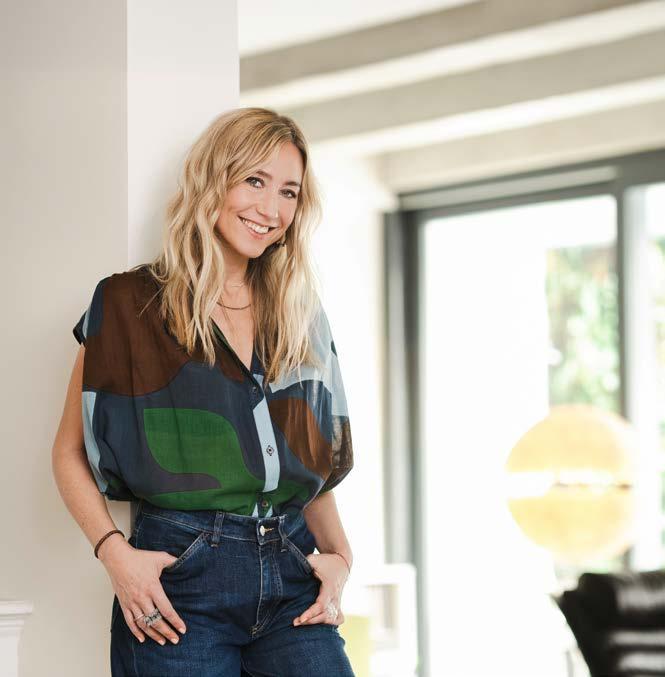
Antones by Sarah Freise

Establishing her company Antones in 2020, Sarah Freise has carved a unique niche in the competitive landscape of contemporary women’s apparel, embodying a philosophy that marries personal touch with curated excellence. Her agency, which represents them on the entire German-speaking market, is known for family-driven brands that tell a story like Moismont, Latinò, and the newly added O’Mer, emphasizing authenticity over pushy sales.
Designed in Paris, Moismont is deeply rooted in heritage and traditional French artisanship. “Moismont perfectly reflects what I aim for in a brand,” Sarah notes. “It’s not about loud logos but about quality, emotion, an attitude to life.” This perspective resonates with her retail partners, who appreciate the brand’s yearround delivery model and its ability to blend seamlessly into diverse individual

styles – whether as a daily wardrobe essential or a statement piece.
Latinò, in turn, follows a simple yet transformative approach: women’s pants designed to suit real life, delivering an unparalleled fit. Prioritizing immediate deliveries and commercial price points, the brand from beautiful Perugia has become a cornerstone of Sarah’s portfolio. “Latinó doesn’t over-promise. They simply offer what women need – a perfect pair of pants, 100 percent made in Italy,” Sarah explains.
O’Mer is Sarah’s newest addition. Founder, designer, and stylist Jean-Pierre Braillard sums up the brand’s essence perfectly: “Casualty, elegance, freedom, nonchalance. The magic of a place, the smell of a landscape, shared meals, reunions with friends, the calm of our secret gardens. Laugh, swim, eat, read, love, learn. In short, the French way of life.”
“O’Mer was a crush at first sight. The aesthetic is both current and timeless,” Sarah explains, looking forward to the season. “It’s perfect for women who just want to look amazing without feeling overdone.” For Sarah, bringing O’Mer into her distribution wasn’t just about filling a gap in the market – it was about once again finding a brand that aligns with her core.
“Fashion should feel fun, not forced,” Sarah concludes. And for her, that ethos isn’t just a tagline; it’s a mindset. By focusing on relationships over revenue and selecting brands and partners that share her values, Sarah Freise is building more than a business— she’s building a community.
Brands: Latinò, Moismont, O’Mer www.antones.de

Michael, what will next season be about?
Michael Schulz, owner of SchulzAco Agentur: Consolidation. As an extremely emotionally driven industry, we need positive signals more than ever, and fashion is able to send them. As an agency, we want to bring these emotions to the sales floor together with retailers so that they can also ignite consumers. With which new collections?
Nenette, with its own signature and sensational price performance – a label that is already well positioned internationally. Lola Casademunt from Spain is new to us; colorful and expressive, but quite different from Italian fashion, at an excellent starting price range in our sector. We are showing both only in Munich, where we are presenting a large part of our collections in the showroom throughout this season. These include Liviana Conti, which has grown steadily thanks to its colors, sense for trends, and quality. The development of Alessia Santi is also very exciting! Followed by our most important players Elisabetta Franchi, Pinko, Twinset and our high-flying collection Eleh, which is creating a stir with everyone in the premium sector with its initial price range.
Brands: After Label, Alessia Santi, Borbonese, Caractère, Eleh, Elisabetta Franchi, Ermanno Firenze, Liviana Conti, Lola Casademunt, Love Moschino Accessoires, Maliparmi, Moschino Jeans, Nenette, Parosh, Patrizia Pepe, Pinko, Rinascimento, Salty Skin, Twinset www.acomode.de
Strong development: Alessia Santi
Michael Brockmann and Malte Kötteritz from Heritage Showroom can look back on a successful season. The new showroom on Kaiserswerther Straße has not only strengthened the agency’s image, but has also resulted in numerous new contacts and customers. Michael Brockmann emphasizes that it is not just the prominent location with an open concept, but that he loves sales: “In the end, I feel most comfortable when I have personally advised the customer.” This customer proximity is the core of their success – Brockmann and Kötteritz see themselves as active participants in the sales process. The agency continues to focus on quality rather than quantity, which is reflected in their portfolio. “We made a conscious decision to work with fewer brands to sharpen our focus,” explains Kötteritz. This approach has been well received and is a prime example of how a strong concept and a clear direction can make all the difference in a demanding market.
Brands: Circolo 1901, Myths, Robert Friedman www.heritage-showroom.de
Circolo 1901 is one of the season’s winners.
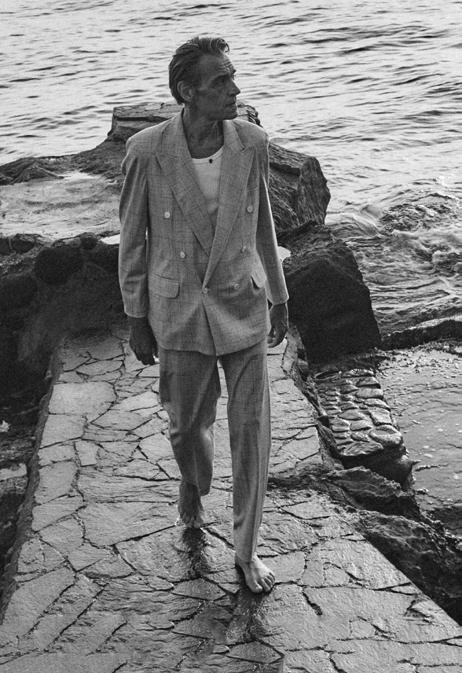


Komet und Helden
Komet und Helden has doubled the size of its showroom in Düsseldorf. What does this mean for your work?
Henrik Soller, co-owner of Komet und Helden: It’s a big step for us. We’ve added another floor, and our Düsseldorf location is now open all year round. We are not only growing in terms of space, but also structurally. You have expanded your brand portfolio. What characterizes the new labels?
We are proud to have brands like Superga and Sebago with us. Both have enormous potential. We already have a close relationship with Basic Net, the parent company, through the K-Way brand. We are particularly pleased with this brand because it is continuously growing through its innovative strength.
Alongside big brands like Save The Duck and Blauer USA, you also have space for small, exciting labels. What’s new here?
We’re really excited to have Family First from Milan join the agency. With their preppy look, they are way ahead of the pack. In my opinion, this look is replacing streetwear. You have launched a new shoe division.
Our expertise in the shoe sector has reached a new dimension. Brands like Flower Mountain and Nomad Society were already a success, but with D.A.T.E., Superga and Sebago, we had plenty of reasons to dedicate a separate division to shoes.
How do you see the retail sector developing?
Stationary retail is coming back into focus. We are noticing this very clearly – also with our brand partners. Physical retail still has an irreplaceable role to play because it offers a shopping experience that cannot be replicated online.
Looking to the future, what does Komet und Helden focus on?
The agency is changing at all levels. A lot is happening behind the scenes. We are committed to being not just a sales agency, but a true partner that masters complex challenges. This is reflected in everything we do – from brand management to the further development of our team.
Brands: 7 for all mankind, Aspesi, Baracuta, Blauer USA, Bowery NYC, C.T. Plage, D.A.T.E., Dickies, Elite 55, Family First, Filson, Flower Mountain, Icon Denim, K-Way, Le Bonnet, Nomad Society, Save The Duck, Seven Gauge, Sebago, Sunspel, Superdry, Superga, Ten C, The.Nim Standard, Two Jeys, Universal Works www.kometundhelden.de


AUTUMN/WINTER 2025
Pitti Immagine Uomo
14 – 17 January
Sala delle Colonne
Fortezza da Basso / Firenze
Your agency is doing well, a push for the next order?
Christian Klaus, owner: We are the extended arm of the retail sector. Our job is to recognize developments and new topics and to offer these in our product portfolio. We work on this all year round. This is how we manage to develop positively in a competitive environment. What incentives do you create for your customers?
We are yet again offering new products in our range for the coming season. Here, we are particularly keen to attract attention and boost footfall with new collections and innovations within the labels. With Maison Hotel, we are introducing a Spanish collection with a bohemian look to Austria. Unio Hamburg is bringing new product groups and thus a new target group to our customers’ stores. Penn & Ink N.Y. has become a mainstay for our customers. The brand boosts image and sales. How relevant is the Quiet Luxury trend?
This will continue, but alongside it, eye-catching pieces will become more of a theme again. Brands: Absolut Cashmere, Freedomday, Gustav, Henriette Steffensen, JcSophie, Maison Hotel, Marc Aurel, Margittes, Knit-ted, Oakwood, Penn & Ink N.Y., Sacrécoeur, Unio Hamburg www.modeagentur-klaus.at

Ludo, what’s new with you?
Ludovico Nees, co-founder of First Floor Agency: Printworks, in the lifestyle sector! The Swedish brand stands for well-thought-out aesthetic products that combine functionality and modern design and transform everyday objects into real eyecatchers – whether it’s stylish photo albums, modern interpretations of games or special gift ideas such as the so-called Essential Tools.
And what’s happening in fashion?
In the fashion sector, we want to strengthen the synergies between our brands. For example, White Sand for men and women is focusing even more on the total look with vests, shirts and blazers, in addition to its core competence of trousers. Paltò is also investing in its product, now with a split collection: Paltò Fabbrica stands for bestsellers made of double materials, and Paltò Guardaroba for fabric research with traditional and technical fabrics.
Brands: Academia, Bongusta, Krakatau, Meyenberg, Mikks, Paltò, Printworks, Tenue, White Sand www.firstflooragency.com
This sparks emotions: Coffee table books by Printworks.


A successful start: Michael Schippers mastered 2024 excellently with the brands Maximilian and I’m Fine Knitwear. Now three new brands are being added: Incery, the brand of Jenny and Regis Benabou, PG3 by Petra Graf and GØAT Cashmere from Salzburg. “Family and friends, if you will,” laughs Michael Schippers. He is covering the sales area with a hotel exhibition in Düsseldorf and a stand at Supreme in Munich. “Right now, at the start, it’s important to me to keep things real, that’s how I’m known.” Customer visits all over Germany were on the agenda during the off-season. “I’m happy when good stores are reaping the rewards of their work.”
Brands: GØAT Cashmere, Incery, Maximilian, PG3 @schippers.dieagentur


Torsten, what’s new with you?
Torsten Müller, owner of Room Nine Agency: P448 from Italy. The sneaker just looks different, and that makes it exciting! The quality and artisanship are exceptionally good, as is the fit. This makes the shoe cozy and comfortable.
Comfort is also one of Distretto’s strengths.
Yes, because all fabrics are functional. The collection is developing enormously, especially in coats and jackets for the winter. They are unmistakable, modern and urban.
What else is there to mention?
Tom Ripley goes all out, with knitted shirts and polo necks made in Italy. It’s a hot topic and Tom Ripley is the specialist for it. The new collection draws on themes from the 1950s and 1960s, always crafted from the materials such as cashmere, silk and merino.
Brands: Distretto 12, Love Brand, P448, Tom Ripley, Zeybra Portofino www.roomninefashionagency.de

For Tom Ripley, “Made in Italy” is not just a slogan.

P448 is new to the agency and combines style with an outstanding fit.

Last season you generated sustainable growth. Which brands are performing particularly well?
Martin Holas: Basically, all of our modern premium brands, with PME Legend standing out with an incredible performance through retailer promotions, innovative products, sustainability, marketing and delivery capability. Cinque and Vanguard are also developing well because they offer premium quality and timeless design. Ragman is a safe bet. New are engravable leather accessories by COWstyle.
What challenges do you see for brick-and-mortar retail?
The generational shift and online retail. In addition to experiences and personal advice, we have to offer products and brands that are difficult to find or compare on the web. Suppliers should rethink and clearly define in the future: exclusive designs or limited items for brick-and-mortar retail, and breadth and accessibility online. This differentiation increases the attractiveness of both channels and ensures that customers access respective offers in a targeted manner instead of just comparing them.
Brands: Cinque, COWstyle, Pierre Cardin, PME Legend, Ragman, Rockandblue, Thylie, Vanguard www.holas.net
“We are focusing even more on distinctive collections, which build up a fan base all the more quickly,” says Petra Hanna. That is why Alix the Label from the Netherlands is now represented by her agency, which focuses on the areas of Hesse, Saarland and Rhineland-Palatinate.
‘The mix of coolness, sportiness and sexiness has already inspired the first customers,’ says Hanna. The Pom Amsterdam collection relies on special, self-designed patterns as a unique selling point. Also in the portfolio: Aimée, feminine and special. “The collection is already very successful in the Netherlands because it captures the spirit of the times,” summarizes Hanna. “We now want to spark this enthusiasm in Germany too.”
Brands: Alix the Label, Aimée, Another Label, Bellamy Gallery, Cotton Candy, Crickit, Freedom Moses, Henriette Steffensen, Ibu Jewels, Ichi, Miss Goodlife, Mscw, Pom Amsterdam, Resort Finest, Wellmark www.handelsagenturhanna.de


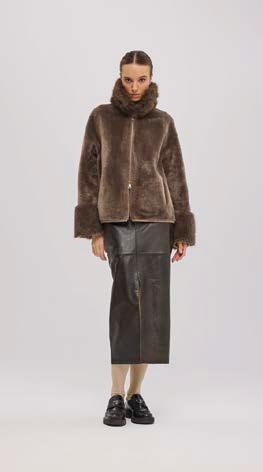








Until now, the collection of Isabelle Blanche from Paris was not represented on the German and Austrian market. After the first delivery, the second order round is now underway. “Isabelle Blanche is bold and daring. Not a smooth, boring collection, but to the point. A new contemporary sophisticated look of urban Parisian women – feminine, oversized and figure-hugging,” explains agency owner Denis Augustin. The collection, which includes around 100 pieces, will be shown in Düsseldorf at Supreme, in Munich at the showroom and at CIFF in Copenhagen. The core price points are 200 Euros for blouses, 400 Euros for coats, 180 Euros for denim, 200 Euros for knitwear and 200 to 300 Euros for dresses or skirts, all retail prices. Highlights include striking silhouettes with high-waisted trousers and shorts, voluminous sleeves and soft, structured cuts, mini and midi dresses with ruffles or asymmetrical lines. Natural fabrics such as cotton and wool meet vegan leather, often with a vintage touch. Seasonal accessories such as belts, bags, scarves, hats or caps complete the line. Brands: Bomboogie, Flona, Niu, Skills Milano, Isabelle Blanche, Viamailbag @goodnewsagency


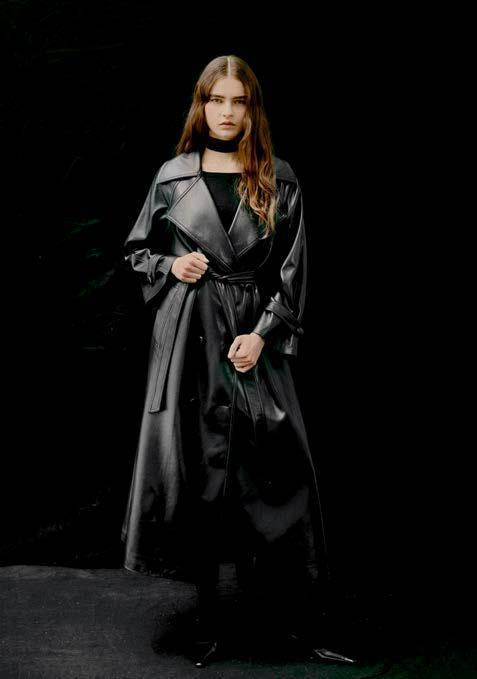
Stagnation is simply not Hubert Stolzlechner’s thing. His entrepreneurial spirit drives him to explore unconventional paths every season. For example, he is venturing into Germany for the first time for the upcoming order round. With Habsburg, he will be showing in Düsseldorf for the first time, as a temporary guest from 24 to 27 January at Regis and Jenny Benabou’s MAB Villa in Kaiserswerther Straße. Stolzlechner on his motivation: “I really believe in partnerships like this. Habsburg is on a great path. I just have to go for it!”
There are plans to show the agency’s entire portfolio in the future, which Stolzlechner has deliberately reduced. “Focus is the order of the day! All my brands have great potential. I want to utilize that perfectly.”
Brands: Dirndl & Bua, Habsburg, Manufaktur Grasegger, Me°rchen Me°dchen, Wallmann hstolz.at
“New in our agency for Bavaria and Austria is TWNS The Label f rom Belgium, a collection of cool knitwear in brilliant colors,” says René Michaelis, who runs the agency of the same name with Daniela Michaelis. TWNS The Label is produced in Europe and works non-seasonally, with timeless styles made from natural materials. Launched two years ago, TWNS supplies 300 fashion and concept stores in Europe. www.michaelis-fashion-agency.com



autumn / winter 25






For two years, Ben and has been investing in a range of initiatives to strengthen the brands with retailers and optimize performance. It was worth the effort, because the agency just closed 2024 as its best year ever for sales, with an increase of a good 60 percent.
2024 was your most successful year to date. How come, in such a time?
Ben Botas, owner of Ben and: We’ve been growing strongly for a good two years. 2024 is our strongest year to date, and of course that’s also due to the eleven new brands we’ve added. But we’re also growing with our existing brands. For us, too, the current period is not a home run, but we have invested heavily and reinvented ourselves every day. That’s paying off for us.
Which measures have been the most significant?
It’s a mixture of different measures, starting with a new IT system that we developed together with Salesforce. This system has been an absolute game changer for us. It not only enables detailed reporting, but also allows us to understand many things that would not have been possible before. Many operational actions arise from these insights. Regardless of this, however, it is becoming increasingly important for us to talk to our customers in person. We traveled a lot last year and visited over 700 customers in total. This allows us to see what each customer’s needs are at the point of sale and how our brands are presented. This is where we optimize, support and learn.
What tools are these exactly?
That depends entirely on the customer. For example, on some days we have Ben employees on hand to provide sales support in the busy times. We do this, for example, at Breuninger, where we are represented by 25 brands and thus make use of synergies.
Another measure is that we have the top 25 key accounts report their sales figures to us weekly and also proactively send reorder proposals, exchange or remove goods. We also organize activation events, provide VM support, product training and marketing measures. Two years ago, we created a new department that focuses exclusively on tracking and optimizing performance.
Brands: Allsaints, A.P.C., Axel Arigato, Banana Moon, Cheap Monday, Chimi, Copenhagen Muse, Dstrezzed, Ecoalf, Edited, Elias Rumelis, Filippa K, From Future, Gina Tricot, Hey Marly, Lala Berlin, Les Visionnaires, Lois, Love Stories, Maison Kitsuné, Malina, Masons, Moose Knuckels, Naked Wolfe, Napapijri, Oh April, Peuterey, Rag & Bone, Second Female, Sporty & Rich, Steamery, Varley, Weekday www.ben-and.com




Congratulations! This year, both Unifa and the Jades concept store are celebrating their 25th anniversaries. Reinhard Haase demonstrates a passion for denim with a few newcomers. For example, Boro Denim, which only uses traditionally manufactured Japanese selvedge denim. Moussy Vintage from Japan is establishing itself with a similarly uncompromising vintage aesthetic. “A lot has happened at True Religion, too,” says Reinhard Haase. “Alongside Originals by True Religion, the European line we produce under license is winning over customers with clean, feminine total looks that showcase our passion for denim.” CPress Studio, the brainchild of artist Cindy Press, is another standout, transforming her oil paintings into graphic tees with personality. Sunny Somewhere lets the sun into your heart, with prints on shirts and sweatshirts as well as knitwear in feel-good colors.
Brands: Boro Denim, Colorush, CPress Studio, G-Lab, Moussy Vintage, Nation Ltd., Sunny Somewhere, True Religion www.unifa-fashion.com

An evergreen

“Botto Giuseppe Pin is a bestseller and an evergreen for me and my customers,” enthuses Anna-Zoi Rybinski. “In addition to the cashmere scarves, there are now also unisex hats. Crochè, our entry-level price point, is also selling extremely well. Thanks to their high fashion orientation and outstanding price-performance ratio, the very wearable items sell just as well as impulse buys!”
Brands: Botto Giuseppe Pin, Cettina Bucca, Crochè, Kerry Grima, Oliver Lattughi Anna@meier-rybinski.de
“Brand Masters now also represents Italian sneaker brand Méliné, with men’s and women’s models for those who love a mix of styles,” says Michael Gerlach, owner of Brand Masters agency. For the fall/winter 2025 season, the collection will be expanded to include a diverse line of booties. Thea Mika is the name of the Düsseldorf-based sales agency’s own label, which now includes not only shoes and boots but also bags, scarves and hats. In addition to Switzerland, Austria and key accounts, the Düsseldorf-based company is now also responsible for the Apple of Eden collection in eastern Germany, Baden-Württemberg and Bavaria. Brands: Apple of Eden, Méliné, Mimmu, Thea Mika, Verbenas www.brandmasters.de
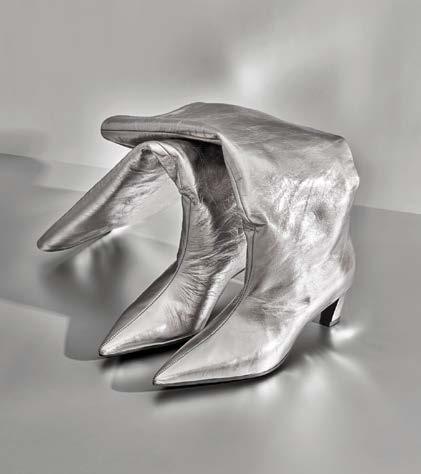






Since 2016, the agency has been offering customized solutions for distribution and marketing in the DACH region with showrooms in Munich, Zurich and Berlin to international brands. “For us, retail is more than just a business – it means taking responsibility for the brands, our partners and consumers,” explains managing director Sascha Kautschitsch. In keeping with the Y2K revival, Juicy Couture is now starting to exhibit at trade fairs in Florence, Copenhagen and Paris.
Sneakers and sportswear from Pony, New York, are brand new in the portfolio, with around 120 SKUs per collection. These include T-shirts retailing for 30 to 60 Euros, crewnecks, hoodies and pants retailing for 45 to 90 Euros, track pants, shorts, cargos and jackets retailing for 85 to 125 Euros, and sneakers retailing for 80 to 145 Euros.
The American underwear label PSD offers lines with prints of Batman, Playboy, rick+morty, the Joker and Looney Tunes. It also has numerous partnerships with NBA and NFL stars. The women’s lines are advertised by influencers such as Katya Henry, presenter Megan Patricia and model and skater Yasmin Stetter. For men, 70 boxer shorts are available individually or in packs of three at retail prices ranging from 25 to 30 and 60 to 75 Euros. Women can choose from 80 styles, divided into boyshorts, sports and triangle bras, V-neck bras, cheeky and thong briefs. Prices range from 15 to 30 Euros and from 40 to 50 Euros for three-packs. The items are made of polyester, cotton and modal with elastane.
The Weekend Offender collection comes with around 600 to 700 SKUs in the product groups of jackets from 120 to 340 Euros/retail price, crew necks, hoodies, shirts, overshirts, track tops, T-shirts, polo shirts and knitwear from 60 to 130 Euros, cargo pants, jeans, sweatpants, chinos, track pants, shorts and swimwear from 45 to 130 Euros, bucket hats, caps, socks, scarves, umbrellas, a wide variety of bags and backpacks from 25 to 150 Euros.
Brands: Juicy Couture, Pony, PSD, Weekend Offender www.chusaja.com


New perspectives at Mark Grütters: After three years, Pyrenex is returning.
What’s new?
Bettina Groeger, co-owner of Agentur Knallgrau: New this season are denims from functional legwear brand Item m6, which feature patented shaping technology that takes freedom of movement and comfort to a new level. The combination of cut, multi-way elasticity and denim know-how offers the ultimate in support for every figure without feeling tight. Also new are color-printed blouses and dresses from Schiffhauer Munich, which are also super successful on QVC. This is how we are breaking into new territory. The small family business has perfected its know-how and fit over 30 years, right up to size 46. What else is happening?
Liv Bergen is a real high-flyer for us because the product is so cool and the chemistry in our collaboration is just right. The new styles are amazing! The Floor collection is also growing, for example with a new, small program made of cotton knit that is lightly roughened like wool for warmth.
Brands: Cute Stuff, Dawn x Dare, Floor, Item m6 Denim, Liv Bergen, Noumeno Concept, Seamless Basic, Schiffhauer Munich, Shirtaporter, Wuth Cashmere www.knallgrau-agentur.de
They shape Schiffhauer Munich: Roswitha Schiffhauer and her daughter Theresa.
Mark, what are you focusing on?
Mark Grütters, Owner Fashion Factory: Continuing to focus on our expertise: niche brands. Since 2020, we have been growing organically in a fragile market environment. The reason for this lies in our mix of brands and customers. Until 2019, our customers bought an average of 1.9 of our collections. Today it’s 3.2.
Brand collaborations with selected retailers are part of this success.
More and more important! We just arranged a special with Schott with BSTN and Anita Hass, and we have implemented a collaboration with Portuguese Flannel with HHV. Further collaborations are in the works. Service for customers and suppliers is becoming more and more demanding, so we are investing here and bundling communication, PR and marketing in our sub-agency Mr. & Mrs. Brand.
Do you expect an upswing?
Definitely. Changes in politics, society and solution-oriented thinking will give a positive impetus. We are also encouraged by collections such as Schott NYC, Astorflex, Portuguese Flannel and Edmond Studios, which are doing very well. We have two new additions: The Norwegian knitwear collection from Bæstmor and the return of the Pyrenex premium collection.
Brands: Astorflex, Bæstmor, Castart, Edmond Studios, Il Bisonte, La Mariole, Le Mont St. Michel, Monchiqe, Oas, Our Sister, P. Le Moult, Pantherella, Portuguese Flannel, Pyrenex, Rivieras, Sanders, Schott NYC, Volver www.ffbymg.com




Until now, you have been rather quiet with your agency. Now you want to put it more into the foreground.
Markus Heck, owner of Agentur Heck: Yes, because our collections are worth getting more attention. I have been running the agency for 22 years, with loyal brand partners and regular customers on the retail side. Now I would like to convince more retailers of our merits and welcome them to our Düsseldorf showroom. Which collections would you recommend?
Phil Petter and MMX are long-standing partners because Phil Petter reinvents itself every season with innovative knitwear at good prices. MMX offers casual pants with a guaranteed fit, a fashionable NOS program and a 3.0 calculation. We also have a strong partnership with Fil Noir; the brand stands for high-quality blouses and shirts with great attention to detail. New from the same company are Two Flowers shirts in the core price range of 59 to79 Euros per unit retail price. We are also launching Schuchard & Friese with fashionable belts made in Italy, available in-stock.
Brands: Dante, Fil Noir Donna, Fil Noir Uomo, Helmor, I’m Fine Knitwear, Latinò Denim, MMX, Phil Petter, Schuchard & Friese, Two Flowers www.agenturheck.de

“We want to be partners for customers and brands.” Markus Heck and Jenni Heck stand behind their agency.

Fashion Agency
BY DANIELE FIESOLI
Marc Kofler, Managing Director of Adventure Fashion Agency, provides insights into the strategic realignment of his agency. The focus is on consolidation and bundling of resources. “We are deliberately concentrating on the established collections and maintaining our partnerships,” explains Kofler. An important new addition is Collezione N°01 by Daniele Fiesoli: “We are delighted to be involved while the brand is undergoing a major realignment.”
The collection not only relies on high-quality cashmere, but also on merino and exciting material mixes, as well as on price points that are particularly in demand in the current market landscape. “I see great potential, especially as alternatives to classic knitwear,” says Kofler.
Brands: 120% Lino, Anfiny, Arrels Barcelona, Be Able, Collezione N°01 Daniele Fiesoli, Duno, Iheart, Janthee, Kashette, Kiefermann Women, Sainte Mer, Tonno & Panna, Trusted Handwork, UrbanCode, Wesentlich adventure-gmbh.de

Innovative, service-oriented: Phil Petter.
Sonja Davidsen comes from the rugged, mystical Faroe Islands. She founded her brand OW Collection in 2016, which is newly represented in the agency portfolio of Soran Mohammadi and Allan Jensen from fall/winter 2025. “At OW, we embody the spirit of the modern, global adventurer by combining luxurious, vegan and cruelty-free materials with stylish occasion wear. Our meticulous design process utilizes Japanese technology to ensure that every material and detail is not only carefully sourced, but crafted with an eye for superior style, functionality and sophistication,” says the designer. OW embodies a unique synthesis of styles: Copenhagen’s minimalist elegance meets the bold maximalism of Los Angeles. In addition to lingerie, bodysuits and dresses, there is also a denim and an outerwear line.
Brands: Bareen, BRGN, Domrebel, Isnurh, Läst, LPFP Denim, Meotine, Mismo, Organic Basics, OW Collection, Zéta www.block2block.de
OW Collection strengthens outerwear with great potential.
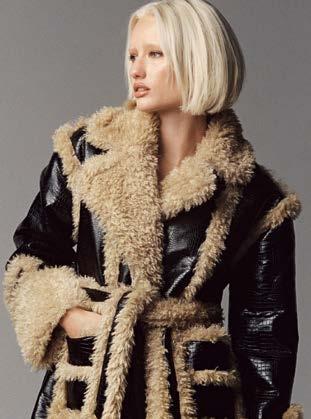
GUSSWERK SALZBURG 01 21–22 January 2025 02 21–23 February 2025

• Alexandre Mareuil • Alpe Piano •• Alpenherz • Apple of Eden
•• Ayasse • Bittner-Hüte • Boos • Chrysalis England • Cocovero
• Creation Bauer •• Daddy’s Daughters • Dirndl & Bua •• ela hubegger textile accessoires •• Elisabeth & Franzl •• Farm um’s Herz
• Frederic Meisner • Gaudiknopf • Glanz & Zauber • Glücklich
• Goiser • Gottseidank •• Grasegger Manufaktur • Grenz/gang
•• Habsburg Kleidermanufaktur • Heimatglück Tracht •• LederGott
• Lembert Hutmanufaktur • Lena Hoschek • Linda Neiber •• Litzlfelder
•• Lodenfrey 1842 •• Luis Trenker • Marianna Déri Fashion •• Me°rchen Me°dchen •• Meindl Fashion • Meliné • Michaela Feyrsinger • Mimmu
•• Münchener Lodenfabrik • Original Haferl • Ostwald Bags
•• Phil Petter •• Ploom •• Ploom xx Daddy’s Daughters • Poldi
•• Resi Hammerer •• RH 2023 • Rita in Palma • Rockmacherin
• Romy North Vienna •• Säckler Manufaktur • Schuhwerk Schwangau
• Seenberg • Stadler – Tiroler Schuhmanufaktur • Stajan Kunst & Mode
• Steiner 1888 • Stephan Barbarino • Stetson • T.ba • Thea Mika
• Verbenas • Von & Zu • Vronikaa •• Wallmann • Weat • Wildstelle
• Windsor • Wolkenstricker • Xaver Luis Schuhmanufaktur
www.salt-salzburg.at – @saltsalzburg


LAG World reflects a sense of empowerment and a fighting spirit.


The Orderlounge showroom at Kennedy Park, Düsseldorf, displays around 20 brands on 750 square meters, including four new additions. Enterprise Japan is inspired by the Japanese Shibui concept, which means beauty that develops over time. Customers include Breuninger, Lodenfrey, KaDeWe, Abseits, Rinascente Milano, Beams Japan and The Corner. The focus of the sneakers is on attention to detail, comfort, high-quality and timeless design. The resulting quality is a combination of Japanese and Italian craftsmanship.
Poeve offers handcrafted Italian shoes at fair prices, made from carefully selected materials. Poeve impresses with its first-class service, durable, versatile and comfortable products, and CO2 compensation through tree planting for every purchase.
Jewelry label LAG World is about genderlessness, individuality, and connecting the past and the future. Geometric shapes with a touch of the 1990s and Y2K nostalgia are paired with futuristic influences. The line is aimed at Millennials and Gen Z. International stars like Kylie Jenner, Camila Cabello and Elodie are fans.
Unique weaving techniques and real crystals are the main features of Hibourama’s handmade bags. The brand has been recognized by Camera Moda Milano since 2018 and now sells in 50 countries worldwide. It has prominent fans such as Laura Pausini and Shay Mitchell, and capsule collections with MVP Wardrobe and Flavia Arditi, which are already available at Selfridges, Harrods, Rinascente Milano, Russo Capri and Galeries Lafayette, are being added.
Brands: Blauer USA, Coccinelle Shoes, Colors of California, Ecoalf, Enterprise Japan, Foamers, Hibourama, LAG World, Liu Jo, Napapijri, No Name, Poeve, Replay u. a. www.orderlounge.de


All-time favorites from Modeist’s Hausbrand quartet: 9AM by Dolores, Nineto9, Pride to Be and SoldOut can also be supplied to retailers as their private label.
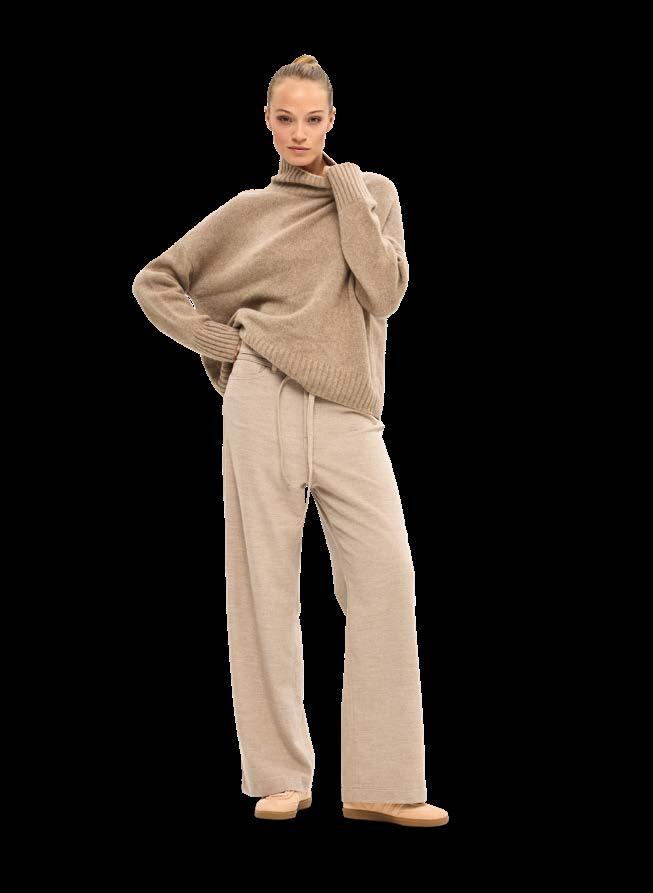
Initiative for successful brands at Modeist: with 9AM by Dolores, SoldOut, Nineto9 and Pride to Be, Marion and Timothy Hoferer form the core of their agency and offer retailers exciting private label options. “Starting with small quantities, we can talk about anything,” says Timothy Hoferer.
“Private label has clear advantages: you avoid comparability and thus the pressure to discount as soon as the first competitor starts cutting prices. For us, the store is the brand, and we are happy to have the ego of the brands take a back seat,” emphasizes Timothy Hoferer. With their free pricing, excellent delivery service and 1:1 exchange, Modeist brands impress retailers such as Lodenfrey, Abseits, Breuninger and Benesch under their own label. The fact that Modeist house brands traditionally leave the limelight to their retailers fits perfectly into this picture. None of the labels has its own online store; Marion and Timothy Hoferer categorically rule out platform business. “We are visible online, but only where we have consciously placed the brands: Predominantly in owner-managed retail stores with soul.”
For the coming season, customers can look forward to a further expansion of the range: 9AM is expanding the successful theme of casual semi-formal trousers, SoldOut is adding corduroy and showing new materials, Nineto9 is bringing a wintry material and, for the first time, prints, and Pride to Be is surprising with high-quality looks at retail prices between 199 and 369 Euros. “Whether it’s our own label or that of the house brands, the message is important to us: we want to make our retailers successful. We are meeting the challenges of the times and want to do our part to ensure that fashion retailing continues to be fun,” says Timothy Hoferer.
Brands: 9AM by Dolores, Alcidia De Veiga, Alohas, Day Birger et Mikkelsen, JNBY, Less by JNBY, NEWD, Nineto9, Pride to Be, Soldout, V von Goat www.modeist.com
For the 2025/26 autumn/winter season, the sales agency is presenting collections that meet current preferences: “We are approaching the season realistically,” says Gaby Ventrella. Tagliatore showed high-quality ready-to-wear in terms of both fabrics and the range of models. Nine in the Morning remains true to its expertise as a pants specialist and is introducing new models. Novelle, known for its lambskin and leather models, is focusing on color. Caliban offers a wide range of blouses and dresses as usual, while Sarte Pettegole is introducing a capsule collection with coarse knitwear and intarsia motifs. Bazaar Deluxe is modernizing its ethnic style with embroidery and pearls. Avant Toi is launching the Black collection, made from fine cashmere and merino fabrics and embellished with delicate rhinestones.
Brands: Avant Toi, Al Ain, Backsideclub, Bazar de Luxe, Caliban, Le Sarte Pettegole, NDV, Nine in the morning, Novelle, PAO, Sorelle, Tagliatore, Tintoria Mattei, Vipera www.agentur-ventrella.de


Carmen, what can people find at your agency?
Carmen Fischer, owner of Carmen Fischer Agents: We offer special additions for retail stores: unique add-ons that round off the product range and create a distinctive shopping experience. Our range includes not only fashion, but also accessories, jewelry and shoes – carefully selected to not only complete our customers’ looks, but also to create a small, individual world in the store. Can you give us some examples?
The Scandinavian label Sofie Schnoor, which translates trendy fashion looks into wearable items, or scarves and hats by Yasu, made from the finest Italian wool. I am also enthusiastic about My Jewellery, a brand that I have successfully established in the German market since 2017. It impresses with its vibrancy and ability to quickly implement current trends.
Brands: Charly Therapy, DWRS, Ella, My Jewellery, Place du Soleil, Sofie Schnoor, Studio Amaya, Yasu www.cf-agents.com

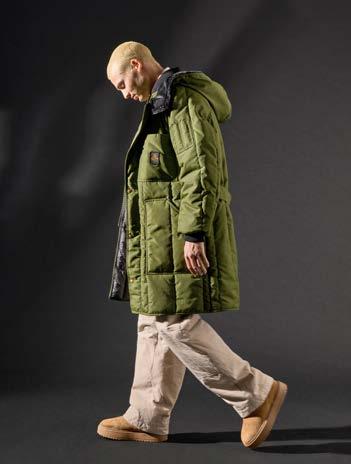
Strong design statement: Refrigiwear.
For the new season, Connectingpeoplesagency can be found in Düsseldorf – at das weiße haus [the white house].
Peter Nürnberger, founder of Connectingpeoplesagency: Yes, it’s a cool location, especially since the former Diesel house is steeped in history. The showroom offers a fantastic ambiance for our collections and we have a lot of new things to offer.
What, for example?
I am absolutely thrilled with Diktat, an Italian knitwear collection for men with modern styles in the highest quality at great prices and a mark-up of 3.0 to 3.5. To kick things off, there is an early bird discount of ten percent for orders placed by January 12. Also new to us is Refrigiwear 1954, with a strong design statement and an focus on outdoor wear. Bloom is now also joining us from Hamburg with timelessly modern styles that reveal the highest level of knitting expertise, as well as scarves handmade in Nepal by Cashmere me.
What else should you see?
The great development that IQ Studio has made with indoor and outdoor jackets. For me, the new collection is one of the best!
Brands: Athletes Eyewear, Bloom, Cashmere me, Diktat, Flowers for Friends, IQ Studio, Quartz Co., Refrigiwear 1954, Worlds Origins x Zanier www.connectingpeoples.de
Perfect addition to the portfolio: Manifattura Ceccarelli.
Manifattura Ceccarelli is joining the brand portfolio in January 2025. The Italian label impresses with high-quality natural materials such as waxed cotton, wool and down, skilled artisanship and understated styles. “Manifattura Ceccarelli is a brand that has inspired me from the very beginning,” says Schwarte. He particularly values its authenticity and the “Made in Italy” label. The collection represents a modern interpretation of heritage designs: “Luxury, but in a skillful, contemporary way,” explains Schwarte. In addition, customers can send in jackets for repair or cleaning, and individual special orders are also possible. “These aren’t just jackets, but a lifestyle – emotional, high-quality, and unique,” summarizes Schwarte.
Brands: Armani Exchange, Balr, Daniele Fiesoli, Fil Noir, Manifattura Ceccarelli, Mason Garments, Parajumpers, Sundek, Whats, Whyat





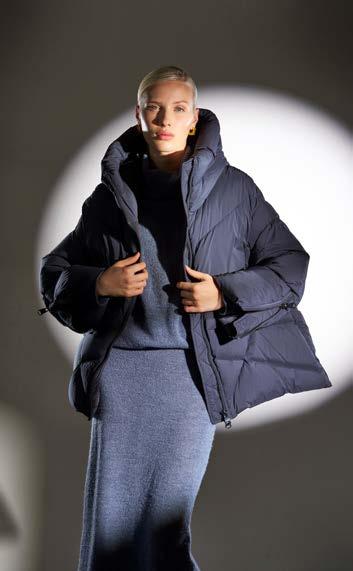
strong portfolio:
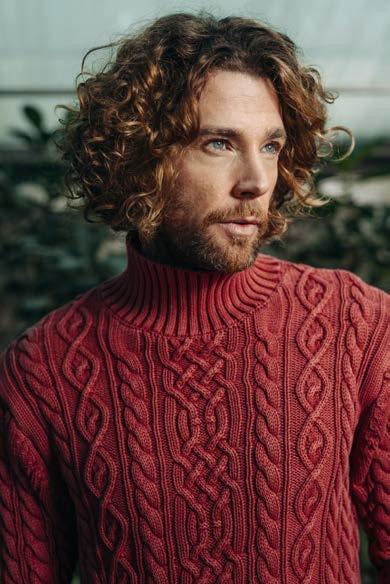

“For many of our customers, the situation is not as bad as one might expect, given the tight market situation. Of course, there are regional differences. If the goods and the price are right, they will be bought,“ says agency chief Dominik Meuer. He is well-positioned with his collection portfolio and would like to deepen and further expand cooperation with both customers and partners in the industry. “The new labels added in the last two seasons, Noir’n’bleu, Sacrécoeur and Hetregó for women, and Keeling and Hetregó for men, are doing very well in retail. We will continue to expand here. Of course, we will not neglect sales pillars such as BOB, Hartford and Des Petits Hauts. We still see a lot of potential in our existing brands. We need to exploit this even more and develop it further. We are entering the new pre-order season for fall/winter 2025/26 with focus and confidence.”
Brands: Atelier Alpiniste, BOB, Des Petits Hauts, Hartford, Hetregó, Keeling, Koike, Noir’n’bleu, Five Fellas, Four Ten, Portofiori, Prime Shoes & Hamlet, Sacrécoeur, The Jack & The Jackie, Original Vintage Style, Wool & Co. www.diehinterhofagentur.de







Christian Sanders
+49 162 605 77 77 chris@lagom-fashionagency.com
PhilippSchlösser
+49 174 106 99 88 philipp@lagom-fashionagency.com

Showroom Dusseldorf - Kaiserswerther Str. 137 I 09. 12 - 28.02. Florence - Pitti - i go out I sala de la ronda munich - mtc haus 4 - Etage 4 I 05.02. - 12.02. Copenhagen - ciff
www.lagom-fashionagency.com

Prins-Juric Agency
“THE FACT THAT EVERYTHING IS AGAINST US IS OUR CHANCE”
Let your mood be spoiled? Damir Prins-Juric is convinced that at the moment, many factors could do that. “Everything speaks against our industry, that’s our chance,” he confidently sets off a wake-up call. “Everyone has to look for new ways, revise their concept, ask themselves what makes them relevant. The issue of price has become huge, we notice that many are downgrading – this plays into the hands of an agency like ours, because our brands have always had both feet on the ground.” With a number of new additions, including Deblon Sports and Janice from the Netherlands, the agency, which operates throughout Germany, is reshaping its portfolio. “The difference is in the service: We don’t leave our customers hanging when they have problems,” says Damir Prins-Juric.
Brands: Aeon, Amaranto, Ana Alcazar, Ball, Bobi Los Angeles, Carta Libera, Deblon, Devotion Twins, Front Street 8, Herzensangelegenheit, Icon, March23, My Real Identity, I’m Brian, Janice, Johnny Was, Koon, Les Hommes, Les Tricots d’O, Lotus Eaters, Nebu, NiMo, Outryght, Pera Lima, Penn & Ink N.Y., Silk Laundry, Sincere, Smaak Amsterdam, Smashed Lemon, Sorena, Villagallo, Voluspa, Wande Vos, Wushu www.prins-juric.com
Swedish denim label Saburo Jeans is the latest addition to the portfolio of Christian Sanders and Philipp Schlösser. Behind the brand is Scandinavian denim expert Per Fredriksson, who has over 40 years of experience in the denim business. The collection includes seven to eight styles of pants in four to six contemporary and water-saving slasher-dyed washes, in both men’s and women’s fits. The silhouettes range from slim to regular to wide in several variants, such as slim bootcut or high-waist wide leg. The retail prices range from 100 to 160 Euros, with a markup of 3.0. The key styles are available in the NOS program. The collection can be seen in the showroom at Drahthaus in Düsseldorf, at CIFF in Copenhagen and in February at MTC in Munich. In addition to Germany and Austria, the Swiss sales territory is also supported. Brands: Ay Studios, Edblad, Garment Project, Mono, Saburo Jeans, Scandinavian Edition www.lagom-fashionagency.com


Three players are now sharing a location in Munich’s Lodenfrey Park: 4pm, Colorful Trade and Lollys Laundry have all moved into Kesselhaus. There, all three agencies now have more space to develop their full potential. This corresponds to the business cycles of the three agencies: Lea Korfhage, daughter of Ilka and Jörg Korfhage, is now joining Colorful Trade. With a few new brands, the signs point towards growth. Patric Maly is also constantly expanding his sphere of influence with his agency 4pm. The third in the group, Thekla-Sophie Gottschalk, has created a strong base as Head of Sales DACH with Lollys Laundry.
Colorful Trade Brands: Catnoir, Catwalk Junkie, JcSophie, Liu Jo, Seidenfelt, Tom + Hatty, Unknown Cotton Club
4pm Brands: Butcher of Blue, Kiefermann, National Standard, Neuw Denim, Maria Stella Maris, Ko Samui

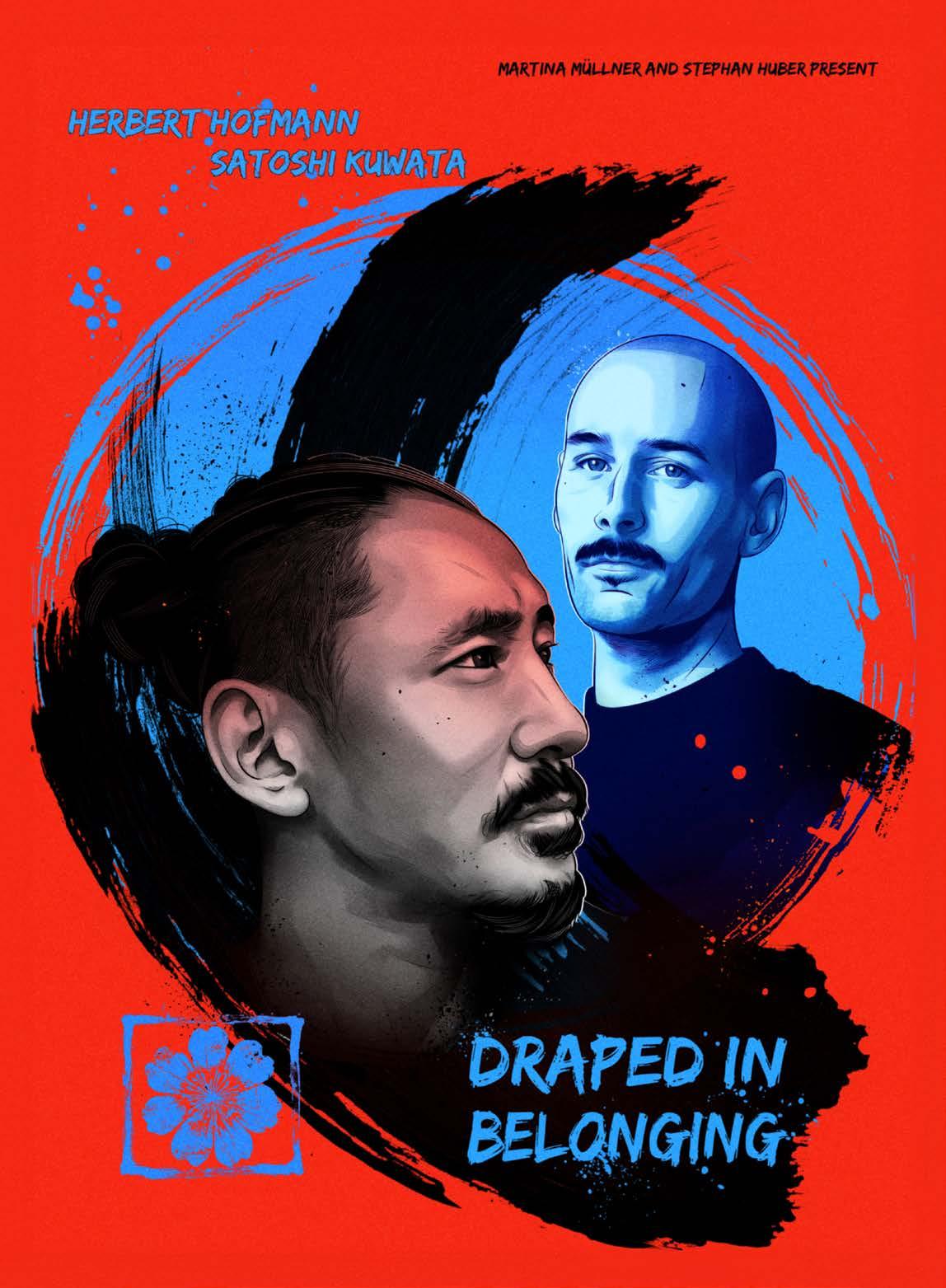
Fashion is a fundamental part of who we are, asserts Setchu founder and designer Satoshi Kuwata in an inspiring conversation with Herbert Hofmann, Vice President Creative & Buying at Highsnobiety. They take a critical look at the market-driven aspects of fashion and question whether the omnisensory experience of shopping is where fashion can unleash it’s full poetry. In conversation with Martina Müllner and Stephan Huber, Kuwata and Hofmann share their vision of a retail environment where fashion shows its values and gives a sense of belonging.
Artwork: Alexander Wells, @alexanderwells
– SATOSHI KUWATA
MMartina Müllner: Satoshi, in an interview you are quoted that “you always have to give a meaning”. A wonderful start to our conversation. What is the meaning that your clothes or collections give?
Satoshi Kuwata, founder of Setchu : For me, designing clothes is more than just making something stylish; it’s about creating pieces that resonate with people. Fashion, like food and shelter, is a fundamental part of who we are. Each piece should have meaning and purpose, reflecting a story or an experience. With so many options today, I think it’s essential to offer something more – a deeper value that justifies what people choose to wear.
Herbert Hofmann, Vice President Creative & Buying : That’s a really refreshing perspective, Satoshi. I also see retail as an opportunity to share stories, not just to sell products. Our concept at Highsnobiety isn’t only about clothing; it’s about hosting brands, events, and creating a space where people feel inspired by what they see and experience.
M. Müllner: It sounds like both of you are advocating for a return to authenticity in fashion. Satoshi, do you think online platforms can convey this same sense of storytelling that physical stores do?
S. Kuwata: It’s a challenge. Online, you don’t have the same tactile, immediate connection with the pieces, which makes storytelling harder. I find it’s often in personal interactions – seeing the garments in real life – where that story truly resonates. I feel that we lose some of that magic in a purely digital experience.
M. Müllner: Interesting! Herbert, does that resonate with your approach at Highsnobiety?
H. Hofmann: We’re trying to keep it real and relatable. Our store concept aims to break away from traditional retail, where the goal isn’t just selling items but creating moments and connections. We want our space to reflect our audience’s real lifestyle, especially here in Berlin, where people value individuality over labels.
M. Müllner: Herbert, the store concept at Highsnobiety emphasizes experiences. Could you tell us more about how you integrate brands and events into your retail space?
H. Hofmann: In our viewpoint, the store in Berlin is a platform where we host a broad variety of brands and bring people together. For example, we recently showcased a new product by an unexpected partner – McDonalds, who launched their new spicy nuggets and a capsule collection with Berlin design & creative studio Sucuk und Bratwurst. For me, it was crazy to see all those cool Berliners going crazy for Chicken & Veggie Nuggets. It might not look like an immediate match to link McDonalds and Highsnobiety but that’s our power: we can tell those stories in a unique, sometimes quirky mix, but that’s what makes it fun for everyone involved. And its our reality – we like all sort of things and McDonalds is sometimes the right thing too.
S. Kuwata: It’s so refreshing to hear that, because in my eyes, fashion is evolving into more of a team effort now, and I love that. It’s no longer just about the designer; it’s about everyone involved, from buyers to marketers. There’s this shift towards collaboration and inclusivity, which I think is essential.
H. Hofmann: Exactly, Satoshi. The physical space becomes a canvas for those collaborations. We can showcase unique pieces that tell a story or provoke thought.
M. Müllner: So, let’s explore a bit more about this “deeper sense” of fashion that both of you are passionate about. Satoshi, you’ve mentioned that garments need to carry meaning, especially in today’s saturated market. Could you talk about how this philosophy shapes your approach as a designer?
S. Kuwata: For me, it’s about creating something that stands out not just because of its look but because it holds a story. I come from a background where we didn’t have much, so I know what it’s like to want something with substance, something that feels worth it. I often think about sustainability, not just in terms of materials but in terms of the purpose behind each piece. Today, people can buy a T-shirt for a few dollars, so if I’m creating something that costs significantly more, it has to offer more – it has to have a reason to exist.
H. Hofmann: That really resonates with me. In retail, we see a similar desire. People aren’t just shopping for products; they’re looking for items that reflect who they are. I think that’s where the

storytelling element becomes crucial: to bring products into surprising environments and new contexts.
S. Huber: It sounds like both of you are redefining the traditional relationship between designer, retailer and consumer. This concept of shared meaning and storytelling could be a key to making fashion feel more grounded again. Herbert, do you think this model is sustainable in the long run?
H. Hofmann: I believe so. Of course, retail has its ups and downs, but when you focus on creating a unique experience and offering something with depth, people respond positively. It’s not just about selling; it’s about building a community and a culture around fashion. And to create a community, you have to have an opinion in first place. That’s kind of my guideline in buying or curating which brands and products we want to work with. Sorry to speak that frankly, but there is so much stuff out there that is simply insanely pricey and offers nothing to build a relationship with. Especially big brand names that only focus on the next hype – we as Highsnobiety self-assuredly take the liberty of not buying these.
M. Müllner: Well, there is a lively part of Highsnobiety’s business model based on hype products or events – like the “Not in Paris” project. A contradiction?
H. Hofmann: Yes, but in the end, the products we’re selling through the Not in Paris project are signs of belonging, let’s call it souvenirs. So again, we’re offering a community, not so much a product. And I guess the same is true with curating our online store or the physical space in Berlin: for us, it’s not about what’s popular at the moment. We choose brands that bring something fresh, something with a unique voice. We’re not simply looking for labels; we’re looking for stories and perspectives that align with what we believe our audience values. This means curating a selection that feels distinctive and true to our brand, rather than just following what everybody else is buying. When I am in a showroom and someone is trying to convince me to buy what all the others bought, I am out. That’s completely the opposite of what our customer base is expecting from us. Every buyer should keep their vision and audience in mind and not how to artificially extend it to please everyone.
S. Kuwata: That’s inspiring, Herbert. I think if you stay true to your own vision, it resonates with people. There will always be those who connect with what you’re doing because they appreciate the passion. After I won the LVMH prize, I was offered a mentorship, and I am now working on my fashion show supported by this program. But to be honest, I am wondering if fashion shows are the best way to communicate your vision.
H. Hofmann: In a way, they are, and I love those moments when you exit a fashion show and feel truly inspired because you felt that it was about the concept, the idea and the clothes again, and not just about the people in the front row and the amount of shares and reach the brand is getting out of this event. John Galliano is a genius in this. Over the last years, going to the Margiela showroom was one of the only highlights during buying season, because everybody else was either doing quiet luxury or getting logo-heavy. And then you came into the Margiela showroom being like: I don’t know what this is, I don’t know how to wear it, but it is incredible. Like his a thousand times pleated, then waxed, then a layer of glue on top or whatever t-shirts. Insane! I like this craziness, I appreciate pieces like this so much, even if I myself dress very simple. But products like this are the magic moments we’re all looking for in fashion. They’re keeping us and the fashion business alive. Understanding how much craftsmanship goes into a piece like that and taking the time to understand the idea and concept of a collection… all of this is not very easy to show online. Those things make sense in a physical store.
M. Müllner: So physical experience has to rely on those special products?
H. Hofmann: No, definitely not exclusively. There must be easy, fun things in between, a lot of realness too. On our store’s Instagram we’re going back to a very real way of storytelling. Taking instant snapshots of a shoe in his box, showing our audience: This is the shoe, that’s what it looks like in reality, it’s now in our store, come by. Sometimes it’s as easy as that.
M. Müllner: The Berlin way, more rough and uncut?
H. Hofmann: It really helps to live in Berlin. It is very close to how I grew up. Berlin is not about showing off, not about wearing nice shiny shoes to a restaurant. Here, I can go to the fanciest restaurant

WE NEED
in my white T-Shirt, Nike shorts and running shoes. And I love that about Berlin, that it’s not driven by having or wearing the latest hype, but by personality. So in a lot of buying decision I constantly ask myself: Can I wear this when sitting on a bench in a Berlin park and having a 50-cent beer? Even with the best brand in the world and in the cutest showroom you should not forget where you’re coming from and who you are catering to. Berliners want to sit on a bench and have their casual beer, that’s reality. Would someone wear a 3.500 Euros white silk dress to do so? No! We don’t have many places in Berlin where you go just to show off your latest additions to your wardrobe. So in buying, I have to stay in my lane to be successful – I don’t want to alienate people. Our customers standing in front of a white silk dress for 3.500 Euros would be alienated. Of course, we also sell expensive things at times, but we always try to have items where you can see how much work or thought was put into them - a piece like Galliano’s Margiela designs. We love to showcase outstanding things. But reality and keeping it real was always very, very important to my vision and our concept.
S. Huber: It sounds like you’re saying that these unique products – the ones blending fashion with art and design – are really what drives the future of fashion. But they seem to resonate more when experienced in person, in a one on one setting. Was that part of what you were aiming for?
H. Hofmann: Definitely. In-person interactions make that easier, but even just when strolling through our store on their own, people can see the outstanding beauty of certain products. Maybe 11 or 12 years ago, when Acne Studios did an inside-out hoodie – the terrycloth part was outside on a black sweater. We (at Voo Store) bought 15 of them because it was so different, and well-priced too. People loved it immediately; we sold four on the first day! Seeing that taught me that people shop how I shop: going through racks, noticing something unique, and saying, ‘I haven’t seen that before.’ It’s easier to convey that in person, but the real challenge is capturing that online too.
M. Müllner: Aren’t socials the place to capture and showcase this?
H. Hofmann: They are, but they changed so much. In the early days of Instagram, we used to bring people along on a journey – taking them to showrooms, posting behind-the-scenes content. That personal
approach grew our following. This happened very organically, I once blew up our Instragram because I posted a sneaker Kanye West was wearing at the Adidas showroom. I got into a lot of trouble because the sneaker was not released yet (laughs). Now, Instagram much more commercial, and that original, unfiltered vibe is lost.
S. Kuwata: Our world is an endless opportunity to tell stories and create an instant reaction. People decide in seconds if they like something. That’s why I keep it simple – just sharing the real inspiration behind the work. Social media, though, has become too market-driven in my eyes. Back then, it was pure; now it’s all about sales. It’s sad to see that shift, especially when we’re all so focused on ‘the next big thing’ and rushing from one idea to the next. I want to keep surprising people, but also question if things like fashion shows are even necessary anymore. I’m learning a lot from LVMH, and they remind me that, yes, fashion shows are essential – even though I don’t always have the budget for it. It’s a strange balance between creativity and the business realities of today.
S. Huber: It seems like both of you sense that things need to change. In a world driven by social media and marketing, what could this change look like while still keeping fashion as a business?
S. Kuwata: For me, it’s about finding spaces where real expression is possible – like pop-ups or events that don’t have to be tied to a massive budget. Yes, business matters, but we’ve become too conservative. People talk about ‘quiet luxury,’ but what does that even mean? Fashion should be exciting, like it used to be in London back when I was at St. Martin’s. Shops had fun events, pop-ups were common, and people invested in unique pieces. Now, things are just... quiet. We need more places willing to take risks, even if the industry is in crisis. I started my brand in the pandemic, against all advice, and it worked because there was no competition. That taught me to trust my vision, even when others don’t see it.
M. Müllner: Do we need to bring back fun?
S. Kuwata: Absolutely, but you won’t see the results unless you try. Right now, the fashion industry is facing a crisis, and everyone’s afraid to take risks. When I launched, I knew it was risky, but I didn’t want to play it safe. And it paid off. We must get back to that spirit, where designers can experiment, even in challenging times. Otherwise, we’re just stifling the creativity that makes fashion exciting.


WE WANT PEOPLE TO FEEL THAT THEY’RE INVESTING IN SOMETHING WORTHWHILE, NOT JUST BUYING ANOTHER ITEM. – HERBERT HOFMANN
S. Huber: Everything we talked about in the last hour is very much the opposite of how the fashion system works today. Do we have to break the seasonal concept?
H. Hofmann: I’d love for that to happen, but I don’t see it coming. Brands rely on the constant push for ‘newness’ to keep sales up, which just shortens shelf life. The frustration comes when we stock something beautiful, and right when it hits the shelf, another store is already offering a mid-season sale, Halloween Sale or whatever. It’s like, are we still in summer, or is winter on sale now? This constant cycle undermines the value of designs, and nobody wants to pay full price anymore. Even for myself, I mostly shop on Vestiaire or eBay, getting secondhand Prada or other pieces I love. Prices in fashion are through the roof now! I ask my team to be very conscious on pricing, I constantly tell them, ‘Look, think about it. How much do you earn, and what does that jacket cost? How many times will you really wear it?’
S. Huber: Are timeless designs the answer?
H. Hofmann: They would be, but then in the end, this does not work with the way our industry is shaped. Once I did an interview with the designers from Acronym, and I asked about this one ACG jacket they made for Nike. It’s perfect – adaptable, comfortable, beautifully crafted. I asked them, ‘Why don’t you just re-release it in new colors instead of designing something completely new every season?’ Their response was basically, ‘Good question. That’s how it works; brands need to keep showing new things, but you are right – we think this jacket is perfect and the wearer doesn’t change every season, either. But that’s the way it is.’
M. Müllner: But it’s exactly that constant demand for newness that ruins everything from resources to peoples mental health…
H. Hofmann: Yes, because more and more people understand that most of it is made up. The sense of urgency is gone. Everyone knows if they wait a few months, that item will be on sale. We all thought that the concept of ‘quiet luxury’ might help, but in an instant, it became a buzzword. It’s just another trend now, like ‘must-haves’ or ‘bestsellers.’ I don’t want my wardrobe to be a checked bucket list of ‘bestsellers.’
M. Müllner: So we need to develop a whole new language for fashion like Satoshis product that places meaning over hype.
H. Hofmann: Yes, but that’s tough because once a concept like ‘quiet luxury’ becomes a trend, it loses its impact. The industry just latches onto it for marketing. I don’t want to cater to people just because a product is on billboards. I want people to trust their own instincts instead of just following what’s marketed to them.
M. Müllner: In German, we don’t even have a word for something timeless and beautiful you want to keep in your wardrobe. How do you call this in Japanese, Satoshi?
S. Kuwata: In Japanese, we just call it beautiful.
S. Huber: In German, we call it Durchläufer. (Everybody starting to laugh.)
Setchu
Ann Berry to volorro mod quiaepe digenime magni dolupta vel mos auda pererspisci tota nonsequ asitatum accabor aecullabo. Et ad evenimo blaborat quunt a dentio. Nullab issim quiati dolorae entisci aerspiet re perum, solendis remposant pelende omnimus et vene volorup taspere verum hillabo. Et magnam reperuptas sim conestist, simus aut ut reperep eles quam ero volluptatque landici autemoluptat la nus as et ma sin et re et labor alit trunt, ipsapidicit aligenis aliquias esto et ut lautae volorpo rporent elendanim quiatur, quia nobitiantiae volor similiq uiatio tem quos di derit poribus alit, tem vollore stiore www.???????
Setchu, the brand founded by Satoshi Kuwata in 2020, combines Japanese aesthetics with Western tailoring. Kuwata, who previously worked for brands such as Givenchy, Edun, Kanye West and Gareth Pugh, takes a minimalist approach with Setchu. The collections are characterized by simple, refined silhouettes that impress with meticulous tailoring and functional details. The brand name Setchu means fusion. In 2023, Satoshi Kuwata won the LVMH Prize, and in January 2025 he is a guest designer at Pitti Uomo.
Highsnobiety
What started as a small blog has developed into an influential platform for streetwear, fashion and pop culture. Herbert Hofmann, Vice President Creative & Buying, came on board in 2018. Hofmann contributes his expertise at the interface between fashion and retail, including his experience as Buying Director of Voo Store, a Berlin hot spot for contemporary fashion. With his keen sense of the zeitgeist and a talent for translating cultural movements into curated content and collaborations, Hofmann has further sharpened Highsnobiety’s identity. Under his leadership, innovative projects such as curated pop-up stores, limited product drops and collaborations with global brands are emerging.
Anna Graf to volorro mod quiaepe digenime magni dolupta vel mos auda pererspisci tota nonsequ asitatum accabor aecullabo. Et ad evenimo blaborat quunt a dentio. Nullab issim quiati dolorae entisci aerspiet re perum, solendis remposant pelende omnimus et vene volorup taspere verum hillabo. Et mag quam ero volluptatque landici autemoluptat la nus as et ma sin et re et labor alit quam ero volluptatque landici autemoluptat la nus as et ma sin et re et labor alit nam reperuptas sim conestist, simus aut ut reperep elestrunt, ipsapidicit aligenis aliquias esto et ut lautae volorpo rporent elendanim quiatur, quia nobitiantiae volor similiq uiatio tem quos di derit poribus alit, tem vollore stiore www???????

Wholesale enquiries
Distribution for Germany & Austria
Die Hinterhofagentur
Roemerstraße 14 80801 München (DE) office@diehinterhofagentur.de
Hartford Showroom 6 Rue du Mail
75002 Paris (FR) showroom@hartford.fr
Is contemporary womenswear the unheralded winner, now that the luxury segment has soared to dizzying heights? Perhaps, however, the point is not to think in categories, but to capture the essence, create experiences, and immerse consumers in real worlds – far beyond fashion, beauty, and jewellery. In short: Experience it!






the mid-price segment is crumbling, they say. that doesn’t seem to hold true in fashion. However, it is now governed by new players and rules. the most important one: More than ever, it’s about an attitude to life.
text: Nicoletta Schaper. Photos: Brands
the
American Vintage womenswear store, you leave one world behind and enter another. Light colors – from warm natural tones to fresh highlights such as pink, neon yellow, and green – featured in fluffy knitwear materials are complemented by jogging pants and coats to create the French brand’s signature look. This is well received worldwide, as the current expansion proves, with new openings in Barcelona, Florence, Malibu, and Hong Kong. “In recent seasons, we have continued to develop by embracing more striking materials and colors,” says CEO Michaël Azoulay. “This has allowed us to increase our visibility without sacrificing our values.” In other words, the brand remains true to itself despite its innovative mindset –and the core price range remains affordable at 40 to 175 Euros.
The price issue has become more controversial. Temu, Primark and Shein are drifting further downwards while the luxury segment is moving upwards. The widening gap between cheap fashion and luxury clothing affects us all. A jumper for 13 Euros or a winter coat for 20 Euros seems just as absurd to us as a cashmere jumper priced at 1,000 Euros. At the very latest, the mid-season sales raise doubts as to which price is justified. Then there is our new reality, which is dominated by global upheaval. With wars raging in the Middle East and Europe, a stagnating economy, and socio-political uncertainty, it seems inappropriate even for the highest earners to spend a fortune on fashion. A significant shift stems from the fact that status is increasingly defined by restraint. Great style relies on quality and timeless fashion that is worth its price. “The mid-segment has become the new luxury,” says Brenda Bizzi Bellei, Managing Director of White, a trade fair
representing commercial fashion brands. “High prices no longer matter, because fast fashion has set the benchmark. Quality at a justified price and the individuality of the brands are gaining in importance.”
The mid-segment is growing, yet it certainly has nothing to do with mediocrity. Its fashion identity is expansive and not limited to a single look. So, what is the common denominator? This womenswear is easy to wear, universally applicable, and always accessible. It inspires young and older women alike. Style replaces trends, with timeless designs that outlast seasons. Brand identity and recognition value remain indispensable. “It is no longer just about designing beautiful clothes, but about staying true to yourself,” says Rikke Baumgarten, co-founder of Baum und Pferdgarten, a collection with a strong, fashionable DNA. It shares the densely populated field of contemporary fashion with the likes of Drykorn, Sessùn, Second Female, Ganni, Rails, and Essentiel Antwerp, to name just a few influential brands. These all-round performers offer the right look for every situation, from pants to blazers, and many of them even to bags and shoes. Total look collections are gaining new momentum because they can convey an attitude to life, both in retail and via social media. This has become particularly important because consumers’ expectations have changed fundamentally. They no longer wish to simply consume, but to immerse themselves in a world.
Representing an attitude to life is something that brands originating from France and Scandinavia are currently excelling at. One example is The Garment collection from Copenhagen, which combines feminine elegance with coolness, or Soeur with its
unpretentious minimalism, expressed in everything from coats to bags. “I aim to dress every woman in a manner that makes her feel understood and valued,” says Domitille Brion, Artistic Director of Soeur. In doing so, she sums up the corresponding mindset. Suncoo epitomises daily wear with French chic at retail prices between 80 and 250 Euros and is experiencing growth in the German-speaking market. “Within just a few months, a pop-up space in KadeWe has generated the annual turnover of an established brand that previously occupied this space,” says Susann Nuru-Waage of sales agency Selectstudio. “This proves that consumers are craving something fresh, and that the brand story is on point.” The plan succeeds all the better because Suncoo is, thanks to eight own stores, adept at bringing its universe to life for customers with ever new images. “Showcasing excellent products at the right time is equally essential for our retail partners,” says Carole Deleuse-Gojon, COO of Suncoo. The two main annual collections are available to retailers on three delivery dates each and can also be restocked at short notice.
Raiine of Copenhagen is positioned in retail alongside Anine Bing, Ganni, The Garment, and IRO. Retailers such as Søren, Fidelio, and MyClassico have been won over due to a sporty coolness that appeals to women across generations. “We strive to create favorite pieces that adapt to women’s lives, not the other way around,” explains Creative Director Maria Leonhardt. “I love the idea of the brand’s identity naturally extending to the whole world.” The balanced total look of Otto d’Ame from Italy is also internationally appealing. “I succeed because I remain true to myself as a designer while also incorporating global trends such as the needs of dynamic women from cosmopolitan cities,” states founder Silvia Mazzoli. “Today, fashion needs to be inclusive and adapt to different lifestyles.”








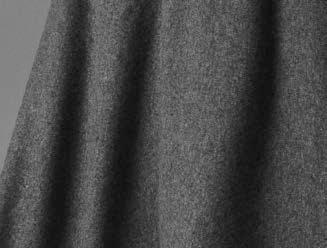







































































We as a brand see you as a customer – this message is the deciding factor. The fact that the bestsellers from Penn & Ink N.Y. are available every season in new colors and materials turns customers into loyal fans. “They like to see their favorite pieces reissued and buy them because they already know that they will fit them like a glove ,” says founder Felice de Lorme. "We design our fashion to be as comfortable as possible, so that every piece makes the wearer feel confident." That extends to the new sportswear edition, with which de Lorme continues to develop the collection for her customers. ”Penn & Ink is a way of life, with everything we we stand for in life, like love, positivity, travel, food, friends and fashion. It's about being part of our family.”



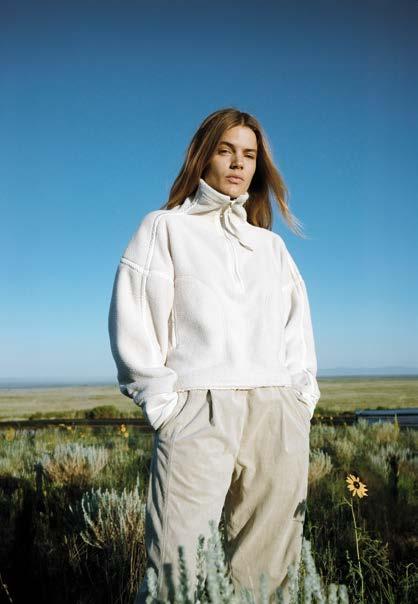




The fashionable midsegment without mediocrity: women’s contemporary fashion is not limited to one defining look. Instead, it impresses with a balanced priceperformance ratio and a style that is accessible, timeless, and easy to wear.

Collections by bloggers convey approachability, especially those created by pioneers such as Anine Bing, followed by the likes of Oh April or the Karo Kauer label. The fashion level isn’t even the major factor; authenticity is the key to success. Justyna Przygonska and Brygida Handzelewicz-Waclawek have also declared authenticity as the principle for their Polish label The Odder Side. When they launched the online shop ten years ago, they simultaneously began to build an international community via Instagram by communicating in English. “We shared everything, from the design sketches to the renovation of our first store in Warsaw,” says Justyna Przygonska. What
was perfect about it was its imperfection. “We involved our followers in the ongoing process, and they came to know us as women like friends do,” she explains. A dress with a cut-out back or casual jeans with a cardigan are fairly simple looks, yet they become must-haves because the creators embody their brand and style.
“Nothing is more individual than your own story. There is no right or wrong,” says Vanessa Baroni-Wieler. She also serves as the face of her jewellery label Vanessa Baroni on Instagram, which is increasingly complementing womenswear in international fashion stores. Costume jewellery is particularly popular in times of crisis because you can treat yourself to something for little




















A justifiable price is a basic requirement, but it is equally essential that brands maintain their own identity while ensuring that the collections suit the lives of consumers.









money, and the expressive jewellery enhances every outfit. Collabs add a new dynamic, as with Vanessa Baroni and the SoSue label. “We were so successful that we have now extended the partnership,” says Baroni-Wieler. “If the fit is right, you support each other and gain new customers through the partner brand.”
Soeur, who collaborated with K-Way and Baum und Pferdgarten, who launched the Etonic trainers in a Copenhagen flagship store last autumn, is also aware that collabs can add a new level of excitement to their
own story. A Love and Friendship pop-up concept was launched for the autumn/ winter 2024 collection, allowing customers to become even more involved. “Customer proximity is now more important than ever, which is why we established a great community under #baumfamily,” says Rikke Baumgarten. “It is important that customers engage with us to feel seen and heard.” The Odder Side also creates points of contact with the community. In September, an event was held in the Paris store to present the sustainable make-up of Submission Beauty from Los Angeles. For this purpose, The Odder Side released a compact range made of recycled cotton, not least to signal that they intend to take a more sustainable
approach in future. The two partners are keen to meet their customers live even more often, like at a recent Boys’ Day Dinner in Warsaw, to which customers brought their boyfriends along. “I loved that evening; the conversations were magical,” smiles Justyna Przygonska. “It proved once more that it’s all about community. It is a people business! And it feels a little like returning to the beginning.”



Since its foundation in 2002, Latinò has established itself as an integral player in the world of Italian legwear. Guided by a clear vision that combines tradition and innovation, the family business remains true to its roots: Made in Italy only.
text: Janaina engelmann-Brothánek. Photos: latinò
Massimo, how did Latinò come about?
Massimo Vendali, founder and CeO of latinò: Claudio Baldini and i decided to establish our own brand in 2002. After spending years in the denim industry, it seemed the logical next step to create a jeans brand that combines italian craftsmanship and modern design.
Why did you choose to produce in Italy?
Massimo Vendali: Choosing italy as our production hub was a very deliberate decision made during the offshoring boom of the mid-2010s. We develop our designs and models in tuscany, but our pieces are manufactured in Umbria. the Made in italy label is not our only incentive; we also take great pride in the artisanship that is evident in every detail of our pants.
Martina, you recently assumed responsibility for marketing and e-commerce.
Martina Vendali, marketing manager: Digitization was a crucial step for us. it allows us to reach beyond our traditional customer base to a younger generation looking for quality and style online. Social media brings us closer to these end consumers.
Camilla, you and your father are responsible for design. What makes Latinò pants so exceptional?
Camilla Vendali, designer: Working with my father has taught me a great deal. i think of our pants as more than just a piece of clothing. As my father always emphasizes, they are a refuge of sorts. Not only do they fit perfectly, thanks to their innovative design and high-quality materials, they also offer comfort and reassurance. We want every woman to feel feminine and at ease with herself in latinò pants.
Massimo Vendali: exactly. Our pants are the item in your wardrobe that you always want to wear because they make you feel self-assured.



Building a community is more important than ever for fashion brands. Does this also apply to Twinset?
Alessandro Varisco, CeO twinset: Yes, it is incredibly important! it forms the foundation for brand loyalty and engagement, with social media playing a crucial role. We leverage instagram, tiktok, and facebook to tell our stories, share lifestyle content, and interact with our audience. the twinset community is about more than simply selling fashion; we aim to build lasting relationships with our customers and foster a sense of belonging. We often refer to a certain attitude towards life in this context. Is it possible for a fashion brand to represent such an attitude?
Yes, because fashion transcends mere clothing. Consumers are more demanding than ever, seeking out brands that reflect their personal values and lifestyle, with which they can identify. We endeavour to be precisely that kind of brand, for twinset women who are independent, strong, and authentic – and whom we empower with our fashion in all walks of life. www.twinset.com
Your claim “PNTS is made for you” emphasizes your close relationship with your core target group, defined as strong and spirited women. Is this approach even more important for a brand’s success in times like these?
isabel Beckmann, Director PNtS: We find that our claim of authenticity and approachability resonates with many customers and generates incredibly positive feedback. People crave something approachable and tangible that brings them joy, especially in times of great uncertainty and multiple crises.
How does this philosophy impact your creatives in their design process?
Authenticity plays a crucial role in this regard, too. We only design pieces that genuinely reflect our DNA and we carefully consider which trends we embrace. We also enjoy being bold, having focused heavily on new shapes and silhouettes from the outset.
www.wearepnts.com









VISIT US AT PITTI UOMO, WHO’S NEXT & CIFF
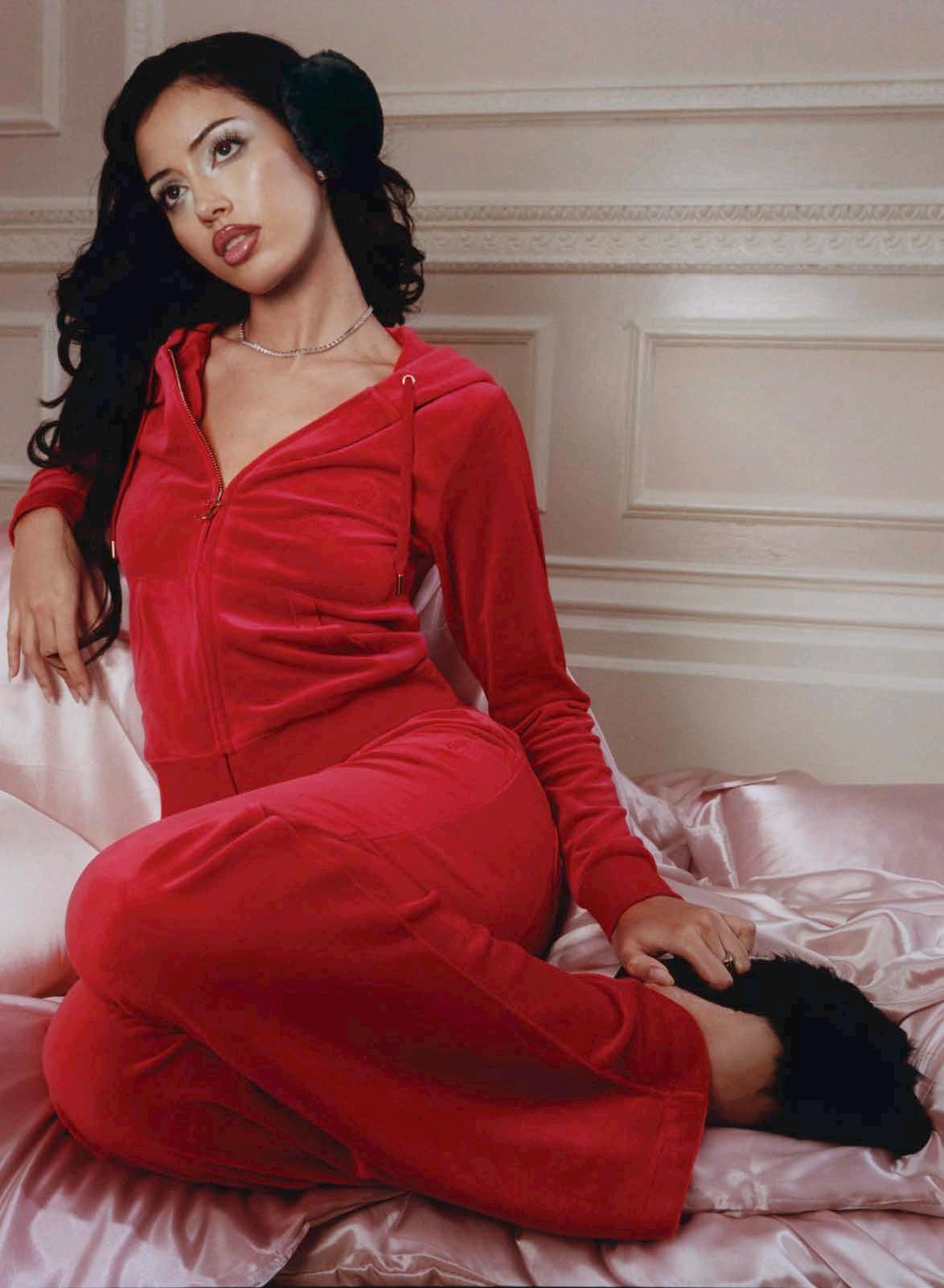
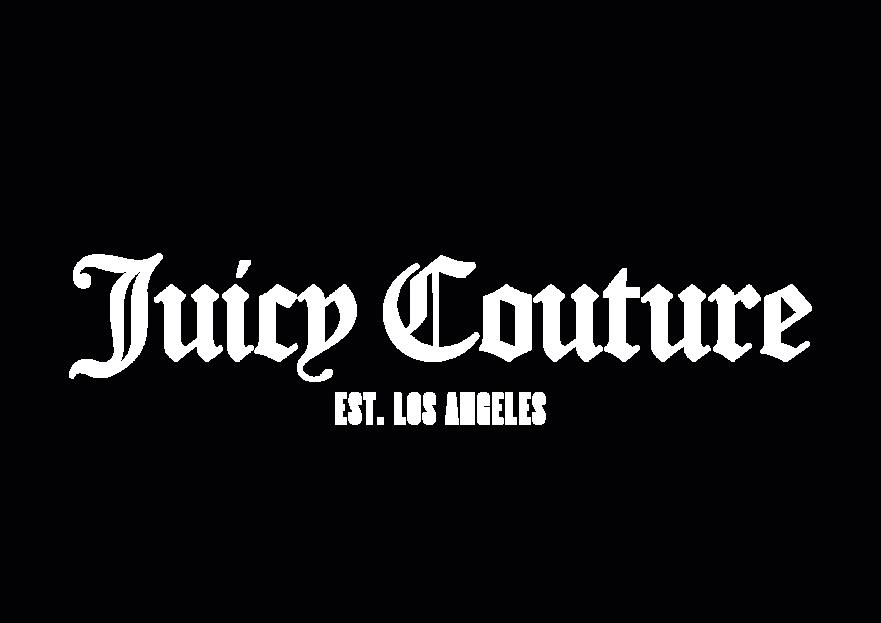


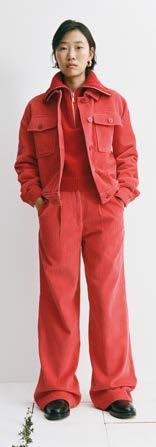

What began in Barcelona in 2008 with the idea of “common sense clothing” has now become a commitment to a humane and regenerative fashion ecosystem. “thinking MU promotes transparency, fair trade, a circular economy, and reduction,” explains CeO Cinthia Miralles. At retail prices between 49 and 229 euros, the range features cool workwear styles, oversized shirts, cosy teddy jackets, and super-soft jumpers – marketed in Germany by Haven Agency. www.thinkingmu.com















Every monthly drop by 10 Days not only delivers the appropriate fashion for the season, but also represents a certain attitude towards life. Has this aspect gained in importance?


















Barbara Hilbrink, co-founder of 10 Days: Not necessarily, especially as an attitude to life has always been at the core of 10 Days. However, 10 Days is growing, and we feel that the time has come to tell our story. We are the number one comfort brand, a feel-good brand. Wearing 10 Days makes you feel good, it makes you happy. We’re communicating that boldly now. To what extent can the collection boost the self-esteem of the women who wear it?















We are driven by comfort and quality. Our fashion fits like a glove; 10 Days embraces you and your body. to me, that represents the highest level of freedom and comfort, and it also instils the wearer with self-confidence. How do you ensure this level of quality?



impact. We also source GOtS-certified materials, ensure fair



By manufacturing a large percentage of our products in Portugal, we ensure high standards and minimise our environmental impact. We also source GOtS-certified materials, ensure fair working conditions, and distribute selectively and in partnership. each product reflects the integrity and sustainability that constitute our core values. www.10dayslifestyle.com




















10 Days represents feelgood fashion – always with a









































































































































































































































Academia blouses retail at prices between 160 and 220 Euros.

0039 Italy epitomises an easy look, featuring blouses and dresses. Is that still the case?
Rachid Bourak, owner of f. D. Retail GmbH: Definitely. the designs lend classic silhouettes a fresh look courtesy of extraordinary cuts, vibrant colors, and creative patterns. the fit and lovingly selected details ensure that a wide spectrum of women feel stylish and self-confident. 25 years of 0039 Italy. How are you celebrating? the first blouse was a long linen blouse for an italian holiday; easy for the beach and smart enough to wear to a restaurant. this white linen blouse will be available as a limited edition in our online shop, at www.0039italy-shop.com, from March 2025 –adorned with Swarovski stones.
Academia enjoyed a particularly successful last season. How come?
Mattia D’Orlando, international Sales Manager Academia: We offer a high-quality product at a very competitive price. in Germany, we doubled our sales compared to spring/summer last year and expect the positive trend to continue into the coming winter season.
What is your fashion focus?
the casual androgynous look remains. in addition to our piece-dyed shirts in a wide range of colors, we have now introduced flowing and more feminine materials. Our latest additions are blouses and shirts made of pure silk.
@academiashirt
LoveShackFancy translates feminine selfconfidence into ruffles and vintage romanticism.


Kitschy, sweet, excessively romantic? Yes!!! loveShackfancy is the tongue-in-cheek antithesis to masculine oversized silhouettes, and is particularly beloved by young women: feminine, floral, and rose-pink. founded in 2013 by Rebecca Hessel Cohen, loveShackfancy has evolved into an international fashion, beauty, and lifestyle brand – supported by collabs with the likes of Gap, Bogner, and Supergoop, as well as a growing community. today, the brand counts 17 own stores and 450 retail partners including Neiman Marcus, Saks fifth Avenue, Harrods, Selfridges, Net-a-Porter, and Revolve. let’s celebrate love! www.loveshackfancy.com



“THE
Susanne, you have been representing the Dutch brand Summum since 2009 - an eternity. How come?
Susanne Sanz, owner of Agentur Susanne Sanz: the familial spirit of the brand is exemplified by the family itself. the collection fascinates me: mainly european production, excellent value for money, always fashionably creative. What gives you particular pleasure?
Watching German customers cast off their uptight bourgeois attitudes. i observe an increase in fashion grade; retail is showing more willingness to differentiate. the traditional mainstream collections are suffering because they no longer reflect the attitudes of women who came out of the pandemic knowing that they need to live now. However, the price has to align with this enjoyment of the moment!
How does Summum impress?
four order dates per year, complemented by special capsules, excellent B2B service, and free delivery and pick-up in the event of an exchange. the brand also offers a favorable mark-up between 2.6 and 3. i experience Summum as a partner with a solution to every problem.
25 years of experience in sales, followed by a step into a new era of independence in July 2022: Michaela von Berlin, her partner Dieter Schons, and fellow creative mind Bentje von Berlin form the trio behind the cashmere brand V von Goat. High-quality cashmere scarves sit at the heart of the collection, optionally combinable with beanies, socks, and gloves. With more than 300 active retail accounts in the DACH region, Spain, and france, the V von Goat creators now aim to further professionalise and have sought reinforcement to do so. Starting with the new order round, sales in Germany are supported by MODeist, with the exception of the northern region, which has been successfully served by Neumair Zeeck Modeagentur for some time. “We aspire to a broad and accessible positioning. this is not about adding more locations; it is about intensifying the depth of collaboration and support for the individual customer,” Michaela von Berlin explains. Speaking about the collection, which features more than 250 different styles, she adds: “the core constantly evolves. We always add and remove styles to ensure a steady flow of new arrivals, while eliminating the seasons in between. We value cutting-edge designs and great qualities.” the advantage in terms of service: “We maintain a huge B2B warehouse, meaning we can deliver to the sales floor within 2 to 3 days. Also, you never really have to discount V by Goat. even we were surprised that cashmere scarves are such an all-season product.” ethically sound manufacturing and long-term relationships with producers in Nepal are important to V von Goat. top stores such as Jades, Panta Rhei, Mia Gergen, Outback Sylt, Morgaine, tina’s Moden, elfie, or ludwig Beck are among the enthusiastic supporters of the collection. www.v-vongoat.de
A market leader in the Netherlands, Summum occupies the top price and fashion bracket in some German stores, while providing an entry point in others. The familyowned company succeeds in doing so by striking a unique balance between eyecatchers, breadth, and brand recognition.


Düsseldorf 20.-23. Januar Cecilienallee 20 24.-27. Januar SUPREME 3.OG Stand 3D10
München
30. Januar-7. Februar Lodenfrey-Park Haus C 8.-11. Februar SUPREME B515
Kontakt ANTONES GmbH * Sarah Freise +49 6174 9159566 * mail@antones.de
Moismont’s heart, soul and driving force: Martine and Jacques Bijvoet.

Moismont is weaving together the heritage of the Baie de Somme and the vibrant artisanship of india. CeO Jacques Bijvoet tells a very french family story about color, passion and unique design.
interview: Stephan Huber, Photos: Moismont
Jacques, Moismont is a brand with a distinct identity. Can you share the story behind its creation and the vision that drives it today?
Jacques Bijvoet: Moismont was founded eleven years ago by my mother Martine. The name ‘Moismont’ comes from my grandfather’s apple farm in the Baie de Somme region of northern France. The brand is deeply rooted in this heritage, but it also draws significant inspiration from India, creating a unique blend of influences. That blend is exceptional…
But simply rooted in my mother’s life story. She lived and worked in India for ten years and fell in love with the country’s rich textile traditions. When she returned to France, she wanted to combine this experience with her passion for fashion. Moismont started with a fine selection of scarves, all crafted in India. Their quality – whether it’s Khadi Cotton or wool – is simply outstanding on all levels. To this day, India plays a major role in production and inspiration but it’s important to emphasize that we are a French brand enriched with global influences.


Colors seem to be really significant.
Color is so essential to Moismont, from soft pastels to bold, vibrant tones that stand out and make our products distinctive. It’s part of our DNA. But you’ll never see black in our collections. My mother always felt it’s just not part of the style or spirit she envisioned. So, the scarves are still the heart of the brand?
Scarves are our heritage and remain a cornerstone of Moismont. But over time, we expanded into ready-to-wear items, like blouses, dresses, knitwear, all carrying our very own design signature. Today apparel accounts for about 50% of our turnover. We also have a home and a travel collection.
To differentiate ourselves, we focus on unique designs, vibrant colors, and artisanship. Everything is handmade, whether it’s printed or woven, which adds an artisanal touch you won’t find elsewhere. How does Moismont’s commitment to artisan production shape the brand and its values?
It’s how we approach both design and business. Each piece we create is the result of skilled, passionate craftsmanship. We don’t mass-produce. Every item has a story. This deserves respect and also explains our price ranges.
I still find them affordable.
Let’s say reasonable. Which I consider to be really important in today’s market reality. We’re not a luxury brand. We’re an artisan brand. This philosophy defines everything we do.
How does this philosophy translate to your business model?
We operate on a pre-order basis, carefully balancing flexibility for our retail partners with our commitment to avoiding overproduction or excess stock. This approach minimizes costs and waste while ensuring that every piece is created with purpose, staying true to the values of Moismont. By collaborating closely with multi-brand retailers – our natural partners – we focus on gradual, sustainable growth. Instead of chasing rapid expansion, we aim to deepen relationships within our existing network of 700 retailers worldwide. Slow and sustainable growth seems to be a recurring theme. What are the core markets so far?
Besides our home market France, the US is very important, also Japan. And I’m happy to see a really promising development in the German-speaking markets. But we’re not trying to be everywhere; we

want to be in the right places. Moismont is about quality over quantity. We focus on refining every detail and continuously improving. Speaking about improvement, what’s next for the brand?
We recently opened a new design office to elevate our ready-to-wear collections with even higher quality and a cohesive style. We’re also exploring collaborations with like-minded brands and artists, including an exciting capsule with Le Bon Marché in Paris for next winter. There seems to be a clear plan for the future of Moismont…
We want to remain true to our roots while carefully expanding. Our focus will always be on thoughtful, sustainable growth, working closely with our partners, and creating products that resonate with people. There’s still so much to explore, and we’re excited for what’s ahead.

Feelgood pieces you just cannot wait to slip into: Liv
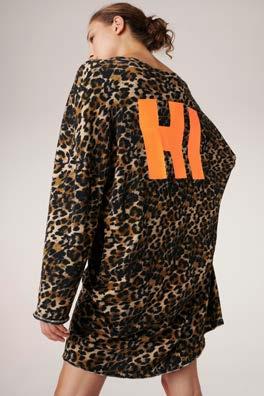
Liv Bergen


Cosy but cool: Liv Bergen’s womenswear epitomizes urban casual style. Other collections do that too, but why is Liv Bergen so popular?
text: Nicoletta Schaper. Photos: liv Bergen
“Come and liv with us”, liv Bergen’s collection slogan, is featured as a large print or, more subtly, on a small hem label. Besides being a play on the name, it is also a friendly invitation that the community is only too happy to accept. Well-made casual wear of high quality may be readily available, but it rarely comes with such distinctive character. “We embrace color, individuality, optimism, and a positive attitude,” says Sybille Mezger, who founded liv Bergen in 2012. She has developed the total look of liv Bergen from season to season. today, it not only comprises casual oversized sweatshirts, hoodies, and sweatpants, but also pieces such as sequined and woollen skirts. the brand also offers an outdoor range featuring milled wool coats, numerous bomber styles including some made of fluffy fake fur, parkas, and trench variants. there is always a special twist, such as a special print on the inside or outside, an unexpected color accent or, in the case of the fur bomber jacket, cuffs made of denim. “i aim to appeal to emotions,” says Mezger. She seems to have been particularly successful last season. “Sales were great and the customers happy,” she says, pleased with the feedback from sales agencies. What impresses them most? “Definitely the quality of products made in Portugal, but the key factor is always the element of surprise in every item.”
www.livbergen.de

“I aim to appeal to emotions.”


Deblon
A lifestyle rooted in sports: the Dutch brand Deblon understands what women want. Padelling, Pilates, or at the office – this designer athleisure collection celebrates the blurring of boundaries. text: Martina Müllner. Photos: Deblon
inspiration from the other side of the world: Rio’s women were what inspired the brand’s founder to create Deblon – always stylish, feminine, and effortlessly chic. to this day, the legendary fabric for Deblon leggings originates from Brazil. “the fabric has a slight compression effect and shapes perfectly,” explains Deblon owner leonie timmerman. She was initially an enthusiastic customer, and when the brand was up for sale, the real estate manager and developer jumped in at the deep end. Since 2019, she has been solely responsible for Deblon’s success: “We are experiencing strong growth around our core product, the high-waist leggings, and we have built an entire world around them. in the Netherlands, we are stocked by almost 90 percent of fashion stores. We are considered part of the everyday wardrobe, especially since we started offering outerwear. i cannot visit a supermarket here in the Netherlands without spotting our Carice cape on at least one woman,” laughs the dedicated entrepreneur. She has set up her office in laren, south of Amsterdam. “All the women who work here are of different ages and backgrounds, so Deblon is a product made by women for women. A sophisticated suburb like laren is also the perfect neighborhood for our brand. Pilates, lunch, meeting – Deblon is the go-to label for everything. these women are discerning and elegant, they aspire to stand out and also want to prioritise luxury in leisure and activewear.” following the launch in Germany with Agentur Prins-Juric, the plan is to export the brand’s strong market position in the Netherlands to Belgium and, from 2026, Scandinavia. “Once Deblon, always Deblon. Our web-shop data shows that women start with our core products and then fall in love with Deblon’s comfort and style. these women embrace activewear as part of their lifestyle. it is not a trend, but a mindset," says timmermann. @deblonsports
Fashion style? Active chic! Dutch brand Deblon occupies this niche.





in its autumn/winter 2025 collection, 9AM by Dolores extends its stylistic repertoire by adding feminine, casual styles in high-quality flannel fabrics. Alongside tried-and-tested corduroy and jersey fabrics, which impress with high sell-through rates, 9AM by Dolores focuses on fashionable fits. “the market is flooded with plain pants, so we firmly believe that now is the time to turn up the fashion dial a little,” says Marion Hoferer. the price range in the premium sector remains unchanged between 169 and 199 euros, thus underlining the brand’s outstanding price-performance ratio. www.modeist.com
What is your focus for the coming season?
Simone Goschler, founder of the Holy Goat: Our focus remains on the beautiful hand-knitting and embroidery that are typical for our collection. Such handicrafts are traditionally carried out from home, but we provide the women in Kathmandu with a pleasant workspace. this allows them to socialize and bring their children along. ensuring that the women enjoy a healthy working environment and fair conditions is something we care about deeply. the same applies to the well-being of the goats. i believe this is reflected in our lovingly crafted pieces. The Holy Goat epitomises exceptionally individual cashmere knitwear. Are consumers increasingly hungry for uniqueness?
Yes. Our customers seek individuality, which is reflected in our growing market presence. Our embroideries tell stories, such as the Deep forest plaid, on which a female forest ranger discovers mushrooms and birds, as well as countless other lovingly embroidered animals and plants. to match, our collection includes hand-knitted jumpers and cardigans featuring the same motifs as the plaid. Alongside these highlights, we also offer cool knitted fabrics in uni. to complement our seasonal color chart, we provide our customers with an incredibly wide range of other colors. this enables them to match our cashmere pieces to their own wardrobe. Other highlights include loose, coarse knitwear in beautiful melange shades and feather-light twin sets made of two-ply felted cashmere. You will want to wear those every day –it does not get cosier than this! www.theholygoat.com






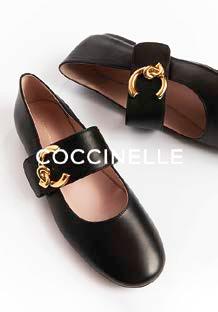


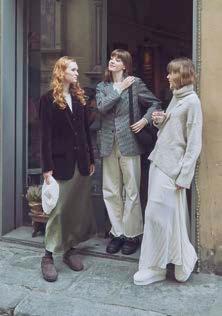


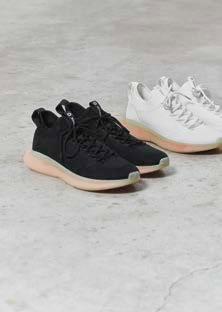
How does Caractère reconcile tradition with contemporary demands?
Martina Bucalo, co-owner of Caractère: By cultivating our values, such as high quality, italian expertise, and minimalist aesthetics. We adapt these to today’s customer needs and the fact that striking the ideal balance between price and quality is ever more important.
Yet something else has changed in terms of demand, has it not?
Yes, absolutely. While the working woman of the 1990s was expected to look perfect in a suit, today’s modern woman not only aspires to be fashionably self-confident, but also feminine and comfortable. With this in mind, we transform high-quality, mainly italian fabrics into pants and jackets that also serve as a statement when worn individually. What conclusions can be drawn for the new season? in terms of design, we have adopted the perspective of the end consumers and our B2B customers. the essential insight is that both target groups appreciate clear messages. We are a modern brand, with the majority of our collections being daily wear, including denim and knitwear, as well as perfectly tailored pants and jackets that can also be worn casually. the mix-and-match principle is central to Caractère: essential pieces from previous seasons combine flexibly with contemporary designs, seamlessly dovetailing with each other. Our selected materials – such as denim, fine wool fabrics, flannel, Punto Milano, and cotton poplin – look their best in this context. www.caractere.it





























Trendoriented, not trendaddicted: Caractère is being established in Germany and Austria by Agentur SchulzAco.











Wear it, wash it, hang it – go! if you want to empower women, liberate them from tiresome chores. Nineto9 does that perfectly. the collection centers around technical jersey, used in both lightweight and bonded forms, making it the perfect choice for everything from blouses to blazers. the perfect travel wardrobe, a featherweight, virtually wrinkle-free. As each season builds on the color scheme of the previous, many fans have created their own capsule wardrobe that can be worn from morning commute to after-work drinks. Designed in Germany and manufactured in Portugal, this season features an increasing number of readymade refinements, including the first prints and a new quality that feels warmer on the skin. www.modeist.com


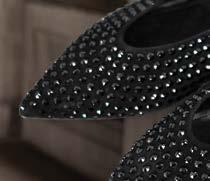

& Schmenger

The Greta ballerina model, adorned with rhinestones all over, is an absolute eyecatcher.





German designer footwear brand Kennel & Schmenger has launched an exclusive charity style in collaboration with journalist, presenter, podcaster, and author Mareile Höppner. All proceeds from sales are donated to two charitable causes: fRAUeN100, which in turn supports a foundation involved in the prevention of violence against women (frauen gegen Gewalt), and the German Stroke foundation. the charity shoes, lovingly handcrafted in Pirmasens, are thus not only a fashion accessory, but also serve as a statement of quality, tradition, and social awareness. they are an expression of appreciation for the art of craftsmanship while also supporting a worthy cause.
“What impressed me most was how seriously Kennel & Schmenger takes craftsmanship. it is inspiring to see how lovingly shoes are crafted, and i will probably wear them with a whole new attitude in the future,” reflects Höppner enthusiastically on her visit to the workshops in Pirmasens. the creation of these special shoes began with the careful selection of the most sustainable materials. Only the finest leathers are used to ensure that each shoe is not only durable but also environmentally friendly. “the art of shoemaking requires skill and patience. every step of the process, from leather cutting through to stitching and sole attachment, is carried out by our highly experienced staff, who have honed their skills over many years. We rely on traditional tools and techniques that have been passed down from generation to generation to create a unique pair of shoes piece by piece,” explains Andreas Klautzsch, CeO of Kennel & Schmenger. Particular emphasis is placed on attention to details. every stitch, every seam, and every appliqué are executed with the utmost precision and dedication. the focus is not only on visual appearance, but also on comfort.
@kennelundschmenger

























Fashionable product, excellent service: Raffaello Rossi.
What opportunities do you anticipate for Floor as a brand that emphasizes both quality and price accessibility?
Sven Benetti, CeO Boungalow 5 and owner of floor: in recent years, many brands in the mid-range segment have moved towards luxury, while others have chosen the opposite way. Our strategy entails maintaining a balance by emphasizing quality while still remaining affordable for the broadest possible target group. With retail prices averaging 200 euros, the collection is a perfect fit for specialized retailers in the mid-range and premium segments.
What other decisive factors are there?
Our fashion evokes emotion and conveys a positive message. this message is all the more convincing when you consider the quality of the products. We manufacture in italy, primarily employing natural materials that are as sustainable as possible. the typical floor woman loves to dress comfortably, without fitting into a particular mold, exuding elegant, understated femininity. We express this DNA in a wide range of colors and silhouettes. www.floorclothing.com
























Why is retailer elmira Rafizadeh of Keep loving a fan of Raffaello Rossi? “the brand embodies values,” she replies spontaneously. “it is backed by a German family business; the partnership stands on equal footing. All our needs are promptly attended to.” Moreover, the product is key. “the quality of the pants is on point and the cuts flatter all body types, resulting in a high strike rate,” the Cologne-based designer explains. “the fact that the pants are longer, meaning they also make tall women happy, is great. i am now looking forward to the new season, as i can rely on fashion degree, quality, and price-performance ratio being spot on again.” for autumn/winter 2025/26, the brand embraces variety, featuring wide-legs and O-shapes in soft flannel and flowing corduroy materials, complemented by denim and tencel. Other silhouettes come in the form of fake leather styles, for example. the fashion highlights: fringed fabrics and innovative textured jerseys. www.raffaello-rossi.com














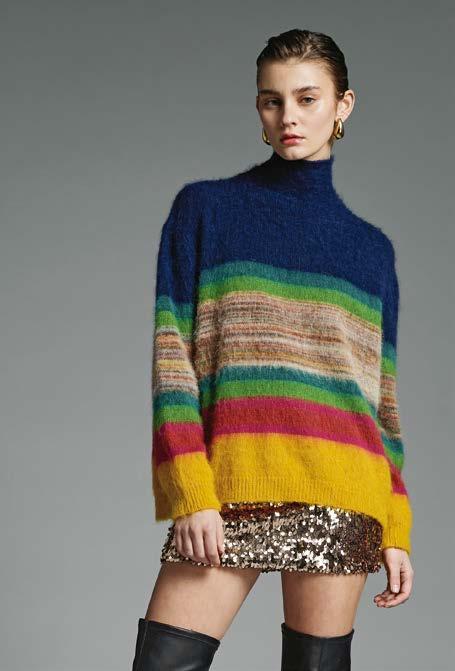





The Glambou jewellery concept amalgamates several designer jewellery labels and is featured, among others, at Globus, KadeWe, and Breuninger. Is your first own store in Zurich the next step?
Valeria Witsch, CMO Glambou: Yes, from the outset our aim was to bring the jewellery to life for our customers at the POS, which is why we moved directly into stationary retail. Now we have launched the Zurich store, where we can showcase the Glambou world in its entirety.
Small, affordable items gain in importance in uncertain times. Does this include costume jewellery?
Yes, absolutely. We are observing a distinct trend towards small gifts as a conscious reward. We strive to create a jewellery experience that meets these needs, with diverse, affordable options that blend into everyday life. the combination of emotional significance and individuality at fair prices makes our jewellery a luxury that is affordable even in challenging times. www.glambou.com
Customer proximity has never been more crucial to success. How does a brand ensure it?
Damiano Bonardi, export Director liviana Conti: By catering to the needs of female consumers and offering suitable fashion for every occasion. We aim to cover every moment in a woman’s life. We start with the brand itself, which epitomizes artisanship and product passion. We blend tradition and innovation to create a high-quality collection with an italian identity. it must offer something new and relevant to the brand every season, while also moving it forward. Prices in the luxury segment are on the rise, while discounters are undercutting each other. What does that mean for womenswear brands in the contemporary segment?
the mid-price range is gaining in importance. Our customers desire quality and contemporary design, but at a realistic and justifiable price. it is our job to strike the right balance. ensuring the right price-performance ratio is just as important as a strong brand DNA.
www.liviana-conti.com
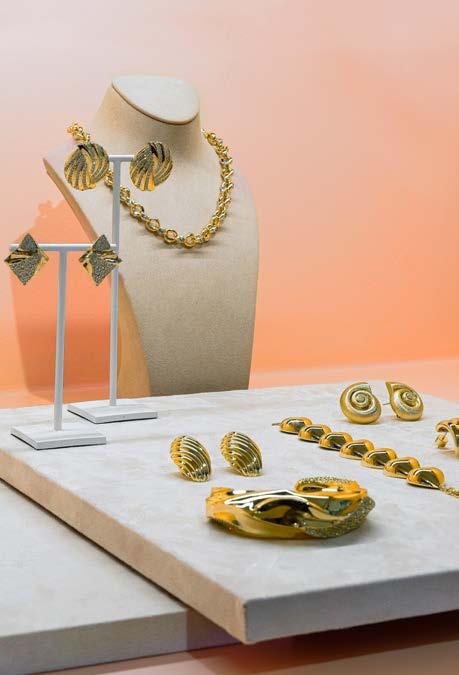
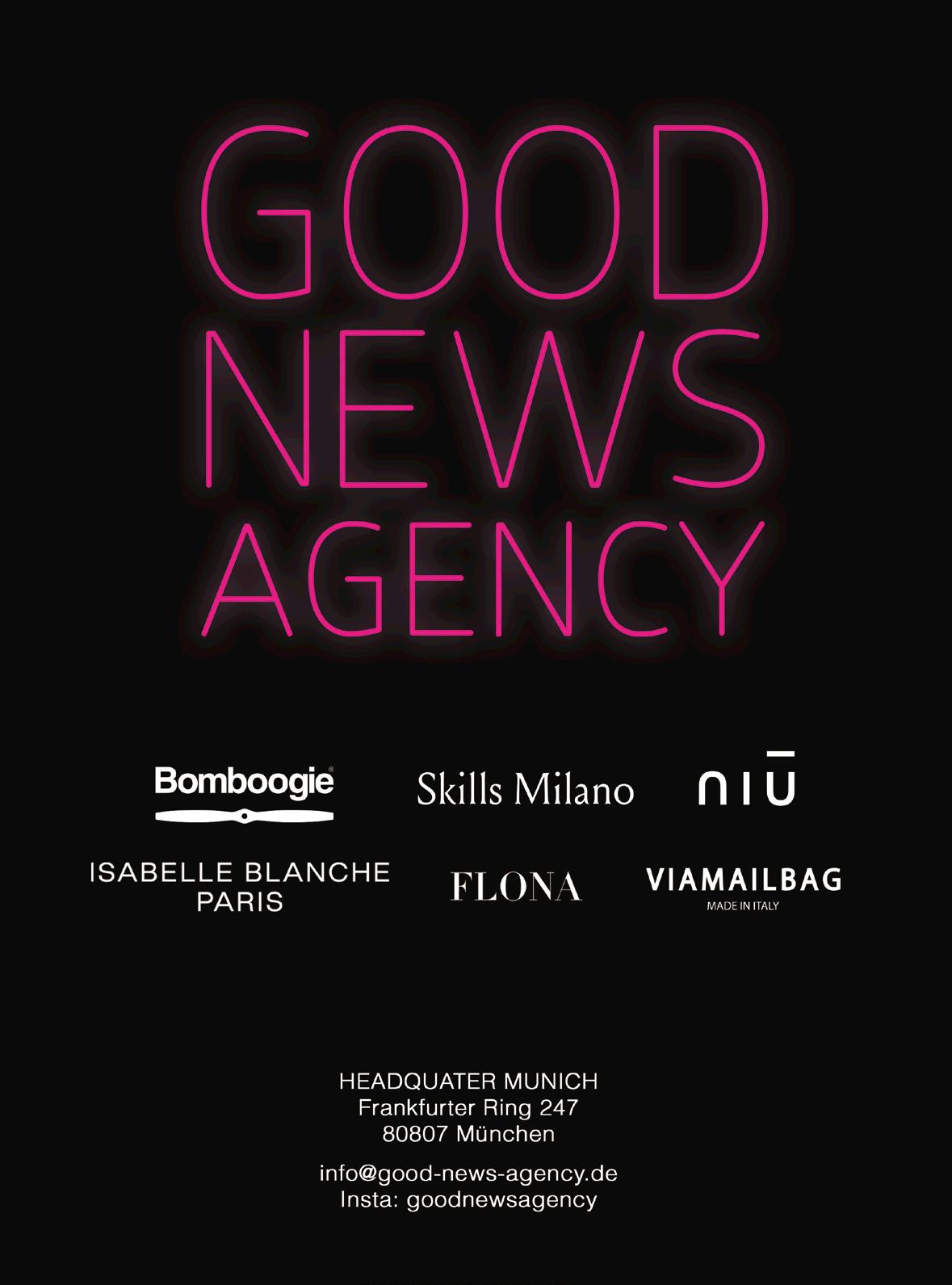
ideally, visiting a fashion store feels like visiting friends –a familiar and inspiring experience. even more so when the atmosphere is perfect, when you feel comfortable enough to treat yourself to something special. the following four multi-brand stores exemplify the premise that it's about so much more than just the products.
text: Janaina engelmann-Brothánek, Nicoletta Schaper. Photos: Retailers

“I always follow my gut feeling,” says Medo Diet, owner of the Homegirl store. “The fact that I know nothing about the old structures and don’t feel bound by them gives me the freedom to do what feels right.”
When Medo Diet initially launched her store six years ago, her aim was to create a place where everyone could treat themselves to something special. She soon realized, however, that the most important factor was not the cheapest price, but whether the price was justified. “I believe that customers have developed a sense of what they are willing to spend money on, and how much they are willing to spend.”
At Homegirl, women find many Scandinavian brands, including Mads Nørgaard and Samsøe Samsøe, followed by Maria Black, Oval Square, Vagabond, and Won Hundred. Like the store, these collections convey a way of life. The vibe also spreads on Instagram or TikTok, appealing to women who are mainly aged between 25 and 40. Medo Diet aims to create
Medo Diet has a wide range of interests. In addition to running her store, she has also launched a sales agency for Scandinavian brands under the same name. In her podcast, titled Homegirls & Friends, she discusses the future of retail with guests.
a community space for them at Homegirl. She herself hails from the club scene, having worked as a DJ and event manager at Crux club in Munich. The community spirit that she experienced in nightlife inspired Homegirl. Events – such as a jewellery workshop, an evening with Berlin beauty label Kess, or with the Mariposa Boxing Club – take place monthly. By staying true to herself, Medo Diet also meets the tastes of her customers. People come together and party, with Medo Diet herself behind the decks as a DJ. “Somehow we’ve grown into a small crew,” she says happily. “It’s great that women don’t just want to buy the fashion but also experience what makes Homegirl really special.”
@homegirlstore


Fashion and beauty side by side. With their move to Kaigasse, Lisa Leitner, her mother Tanja Erlacher, and Stella Kaltenhauser have merged their two previous stores into one harmonious unit. It looks the part too, with the shop and its range of products mainly decked out in natural tones. “We embrace minimalism and love the capsule wardrobe concept, which is how we make shopping easier for our customers,” says Leitner. “We select each collection very carefully, and a solid partnership with the brands is important to us. We are convinced that this is the only way to operate successfully.” Each segment is represented by just one brand: jeans by Agolde, jackets by Taion of Japan, and cashmere knitwear by Warm me. The soothing principle of
simplification means that many styles are unisex. It is only fitting that the selection of holistic beauty brands is also carefully curated, featuring products by Ruhi and Lesse, as well as perfume by Equality. Golden Soul also appeals to young customers. “I believe that Gen Z is developing a sense of quality and is willing to pay the price for it,” says Leitner. Some save up for a particular piece and have it put aside, so they can enjoy it all the more later on. “Others just drop by for a cup of tea or a bit of inspiration. For us, the most important aspect is that people feel comfortable here, without feeling any pressure to buy something. Here, they can be themselves for a change.” Golden Soul strives to radiate positive energy, and the three businesswomen are keen to create plenty of space for that. @golden.soul_official


Frida/Bochum
Every Friday, Frida offers bouquets for twelve Euros to kick off the weekend. “A friend of mine ties them. Each one is different and unique,” says Kiki Gralla, owner of Frida. “That’s why so many people visit us on Fridays.” Customers also stop by because Frida offers an all-round feelgood package, from fashion and accessories to little surprises. The womenswear section is spearheaded by Drykorn, Closed, and American Vintage, followed by 10 Days, Penn & Ink, Liv Bergen, and jeans by Dawn Denim and Icon Denim. In addition, Frida exclusively stocks shoes by Pomme D’Or and trainers by Diadora in Bochum. “These collections provide excellent quality at reasonable prices,” says Gralla. “That’s important because modern women are more price-sensitive and more conscious of what they buy.” This makes it all the more important to offer small gifts, such as natural cosmetics by L:A Bruket

of Sweden, as well as special chocolate or sardines by La Quiberonnaise of France. Frida appeals to women from their late twenties onwards who are seeking direction. “The range stocked by larger retailers is often overwhelming for many people. That's why my customers appreciate our range, which is tailored to their needs.” The way Gralla and her three employees welcome customers and provide personal advice makes the journey from as far afield as Wuppertal or Solingen worthwhile. The girls’ night events have become a permanent fixture in the store: after-work shopping sessions for small groups of five to twelve customers. “We offer snacks and drinks, and customers can browse at their leisure. It’s an extremely popular feature,” says Gralla, who considers herself a friend to her customers. What motivates her? “When a customer says that she wears an item she bought here all over town. That’s the best compliment I can imagine.” @frida.bochum


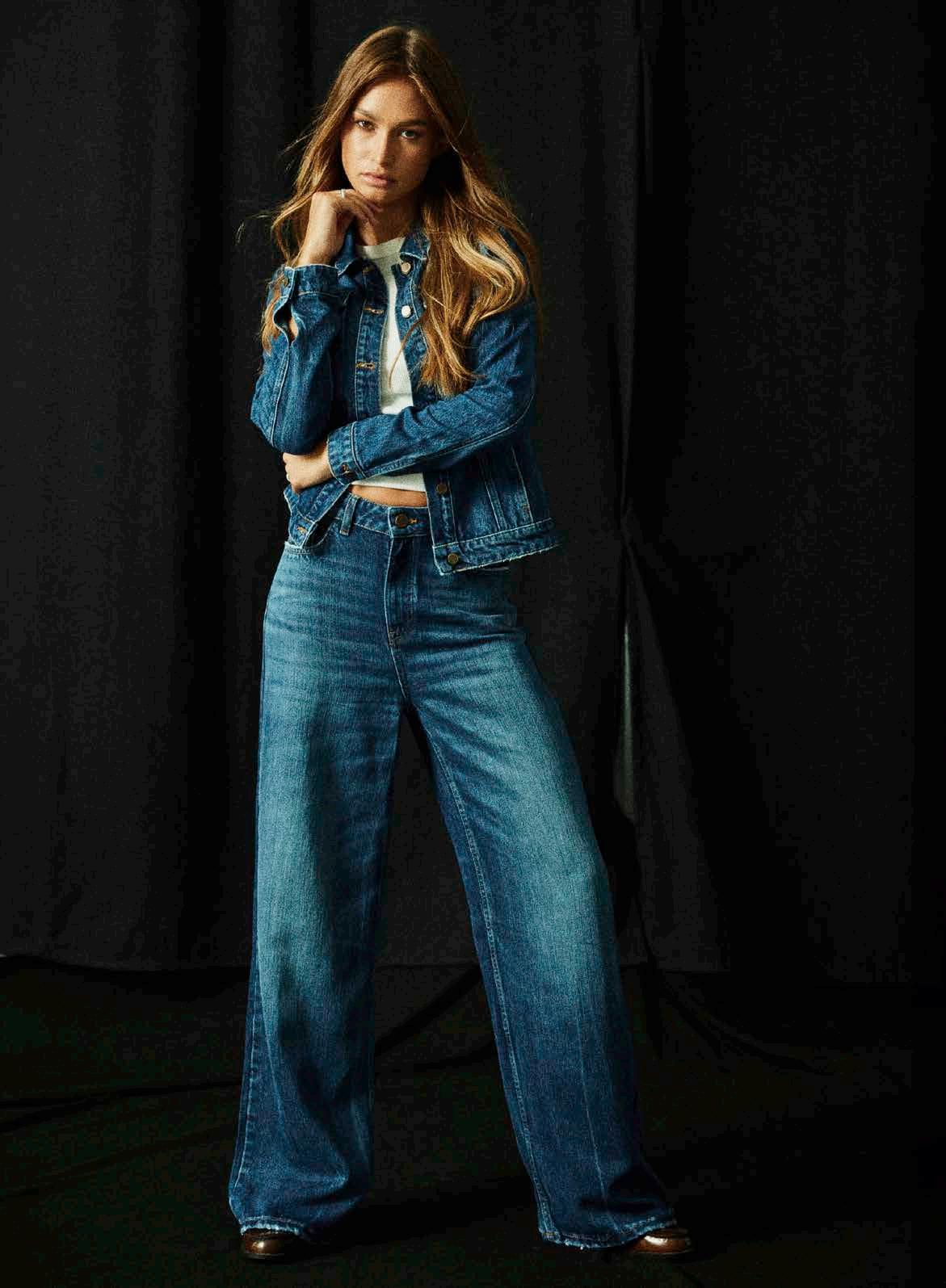

Lol Via Urbana/Rome STYLE AND INSPIRATION
In the Monti district, located deep in the heart of Rome, Lol has long since established itself as a major player in the Italian fashion scene. Founded 22 years ago by Fabio Casentini, the store has always pursued the objective of combining fashion and interaction. “With Lol, we strive to create a space that feels both familiar and inviting, like visiting a friend’s home,” explains Casentini. The concept has caught on: his team now runs five branches across the city, which will soon be joined by a design and art fashion consultancy studio.
The 200-square-meter boutique on Via Urbana in particular offers carefully curated collections, including Forte Forte, Vanessa Bruno, Sessùn, Diega, Labo Art, and

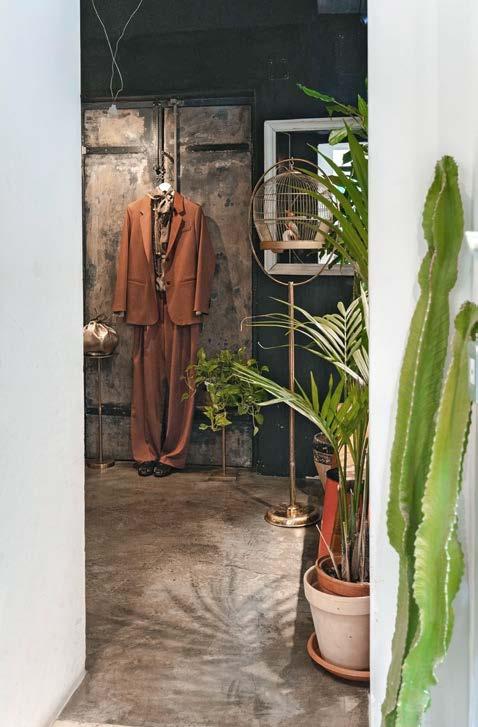
the in-house label Bee in Love. The latter offers leather accessories, cashmere knitwear, and jewellery. Lol remains true to its principles: high-quality fashion at fair prices. “We believe in transparent pricing that reflects both the quality of our products and the shopping experience,” explains Casentini. Yet Lol manages to create a welcoming space that encourages customers to linger. Artful interior details and atmospheric lighting help create a sense of unity between fashion and culture. “We want shopping here to feel like an experience,” says Casentini, who brings together emerging fashion talent and established brands to deliver an exciting and diverse assortment. This makes Lol a reliable source of style and inspiration. “When you are passionate about what you do, it creates a special bond between product and customer,” summarizes Casentini. @lolroma.moda.arte.design
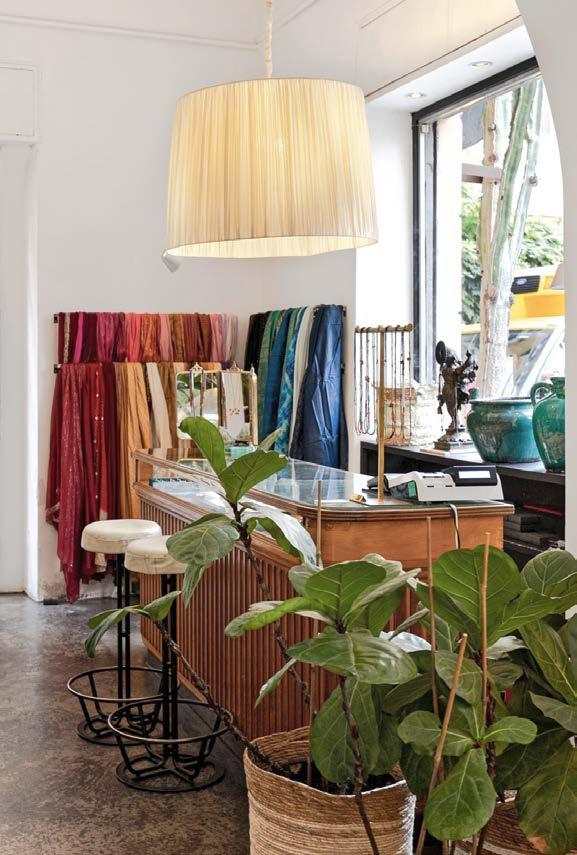















Edblad
the jewelry market is changing, and edblad is at the center of it. With an innovative mix of Scandinavian design, durable materials and a clear digital strategy, the brand is succeeding in a challenging environment. CeO eva Boding reveals how edblad is inspiring retailers, building a strong community and appealing to a new generation of consumers.
text: Stephan Huber. Photos: edblad
So many jewelry brands compete for attention in today’s market, what is it that sets Edblad apart?
Eva Boding, CEO Edblad: Jewelry is undoubtedly a competitive space, but we’re about to experience transformative changes within our segment. Edblad is at the forefront of this change. We aren’t your traditional jewelry brand. We position ourselves as a modern, digitally-driven brand, building a strong community and connecting with consumers in innovative ways. My background in fashion has shown me how brands have had to adapt to forge direct, meaningful relationships with their customers. Now, we see that same shift in jewelry.
Our uniqueness lies in combining Scandinavian design with innovative materials – like stainless steel, which is durable, water resistant, and fits seamlessly into an active lifestyle. Not many brands combine Swedish design, stainless steel, and affordability the way Edblad does. Stainless steel isn’t the material that typically comes to mind for jewelry. It feels more industrial, even masculine. How did you address this perception?
It’s true, stainless steel has traditionally been associated with tools or functional items, not jewelry. But for Edblad, it’s been part of our DNA since the very beginning in 2006. This material is perfectly aligned with modern lifestyles – whether you’re working, exercising, or spending time with your family, you can wear our pieces without worry.
For years, we didn’t emphasize the material as a selling point. Now, it’s central to our narrative because it meets contemporary demands for practicality and style. Its durability is a strength, and we’ve honed our expertise over 20 years to craft beautiful designs from it.
This must have influenced your distribution strategy. Why did you partner with agencies like Lagom?
We chose Lagom because the retail landscape is undergoing a major transformation. It’s not just department stores – fashion boutiques, lifestyle shops, and travel retail are all evolving. This shift creates new opportunities, especially for jewelry, which is becoming increasingly appealing to retailers.
The fashion industry, as you know, is under pressure. Short selling seasons, aggressive discounting, and rising production costs are squeezing margins. It’s a tough market with high risks, particularly with large stock investments that don’t always pay off. Absolutely.
This is where Edblad shines. Retailers are looking for lower-risk categories with low returns, and jewelry that fits the bill. It offers high revenue in minimal space, excellent margins, and a longer product life cycle – unlike trend-driven fashion items. By working with partners like Lagom, who understand these shifts, we position Edblad as a smart, low-risk, high-reward choice for retailers. It’s about aligning with the right opportunities and helping retailers see the potential in this evolving market.
Let’s talk about the emotional connection people have with jewelry. It’s so different from other products.
That’s so important. Jewelry is deeply personal – it tells stories and creates memories. Whether it’s gifting it to yourself or buying it for
someone special, jewelry is always connected to life’s special moments. The younger generation, especially, loves visiting physical stores to find something meaningful. For them, shopping isn’t just about acquiring a product; it’s an experience, a memory.
With this strong emotional aspect, what role does physical retail play for Edblad today?
Physical retail remains essential. Younger shoppers crave in-store experiences, but they expect more than just products. Stores need to be inspiring, engaging, and entertaining. That’s why we focus on creating environments where people feel connected to our brand.
At the same time, online channels like TikTok and Instagram are crucial for storytelling and accessibility. The challenge is balancing the emotional impact of physical encounters with the convenience of digital shopping.
Looking ahead, what are Edblad’s next steps?
Our vision is to become the iconic Swedish jewelry brand on a global scale. We’ve already established ourselves as a leader in the Nordics, and now we’re expanding to Germany, Austria, the UK, and the Benelux region. The response so far has been incredibly positive, with double-digit growth in some markets.
We’re building strong wholesale partnerships and investing in digital marketing, PR, and events to boost brand awareness. It’s about creating a solid foundation while generating excitement around Edblad as a Swedish icon in accessible luxury.




the jewelry manufacturer from florence stands for high-quality creations in sterling silver with a unique character. the collections for men and women, made using the traditional lost wax casting method, combine perfect artisanship with modern design and reflect florentine jewelry traditions. the collectible charms and the Animalier line are particularly sought after. With his clear aesthetic that makes luxury accessible, Giovanni Raspini has established himself internationally and has continuously expanded his network of boutiques in europe. www.giovanniraspini.com
Young designer Azzurra Del Sarto wants to redefine piercings with her brand: “they are unique pieces that flatter the wearer and, in a figurative sense, illuminate them.” founded in 2020, Del Sarto produces her collections in italy, with Del Sartos’ family business providing the necessary expertise. each piercing is made of 18-karat gold or platinum and finished with certified natural diamonds. Artisanship and luxury contrast with the normal image of piercing. “they are real statements,” says the creator. www.delsartogioielli.it
the goldsmith and product designer exclusively uses recycled silver for her jewelry. Her seven collections to date are all permanently available and can be combined with each other. She considers specially cast and organically shaped silver pearls to be a sustainable alternative to freshwater pearls. the necklaces, earrings and bracelets come across as soft and edgy at the same time. Prices range from 75 to 520 euros. the jewelry is designed in Gauder’s Berlin studio and then crafted at a goldsmith’s in southern Germany and in a workshop in Berlin. the individual pieces are then assembled and finished at the studio itself. www.johannagauder.com


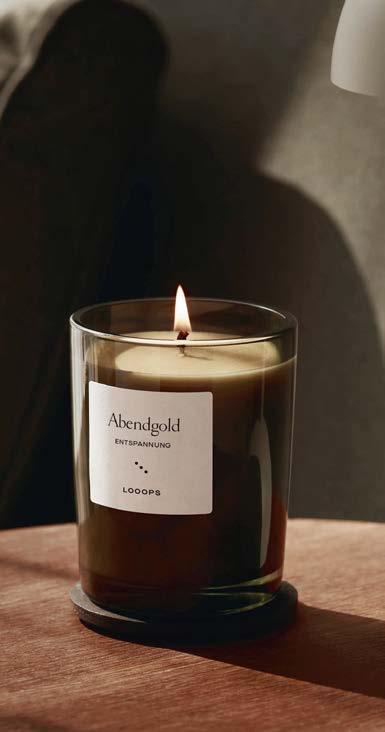
Good for the body, and good for the environment. “Raaw Alchemy only uses organic and sustainable ingredients, and that really won me over,” says Nicole Sanders of NC Showroom, who represents the Copenhagen beauty label in the D-A-CH market and counts Donna in Hanover, Gränicher in lucerne and insieme fashion in St. Johann/tyrol among her customers. Raaw Alchemy was founded by trice Angie Christiansen as a holistic concept for women and men. it all began with the Miracle Oil, which is based on plants that are said to have healing properties, especially in eastern cultures. facial products cost 59 euros per 30 milliliters, and hand and body products cost between 49 and 65 euros per 500 milliliters. www.raawalchemy.com
founder Alexander Hartan describes Studio Botanic as a natural cosmetics brand in a minimalist, unisex design. the high-quality vegan ingredients are carefully selected, purely plant-based, produced cruelty-free and certified. the delicately scented formulations, made in Germany, impress with their principle: less is more. “We use as few raw materials as possible, and as many as necessary to achieve the optimal effect,” explains Hartan. the range is based on twelve beauty products for face and body, as well as two care accessories, which were designed by Munich-based product designer Saskia Diez and launched jointly. www.studiobotanic.de
“As a Salzburg-based fragrance manufacturer, we only make products that we believe in,” say Julia Schliefsteiner and Markus Niederfriniger. their aim: to bring the scents of nature into your home. “Our scented candles are made from vegetable wax and essential oils, with no chemical additives.” founded in 2014, the product range extends from scented candles to all-natural essential oil blends, room sprays, incense sticks, aroma diffusers and accessories. to ensure an even greater affinity with nature, the company relies on regional suppliers and plastic-free packaging. there is also a refill option for large candles. the product range has convinced retailers such as Manufactum, Super Vienna and Sois Blessed, among others. www.looopsmoments.com
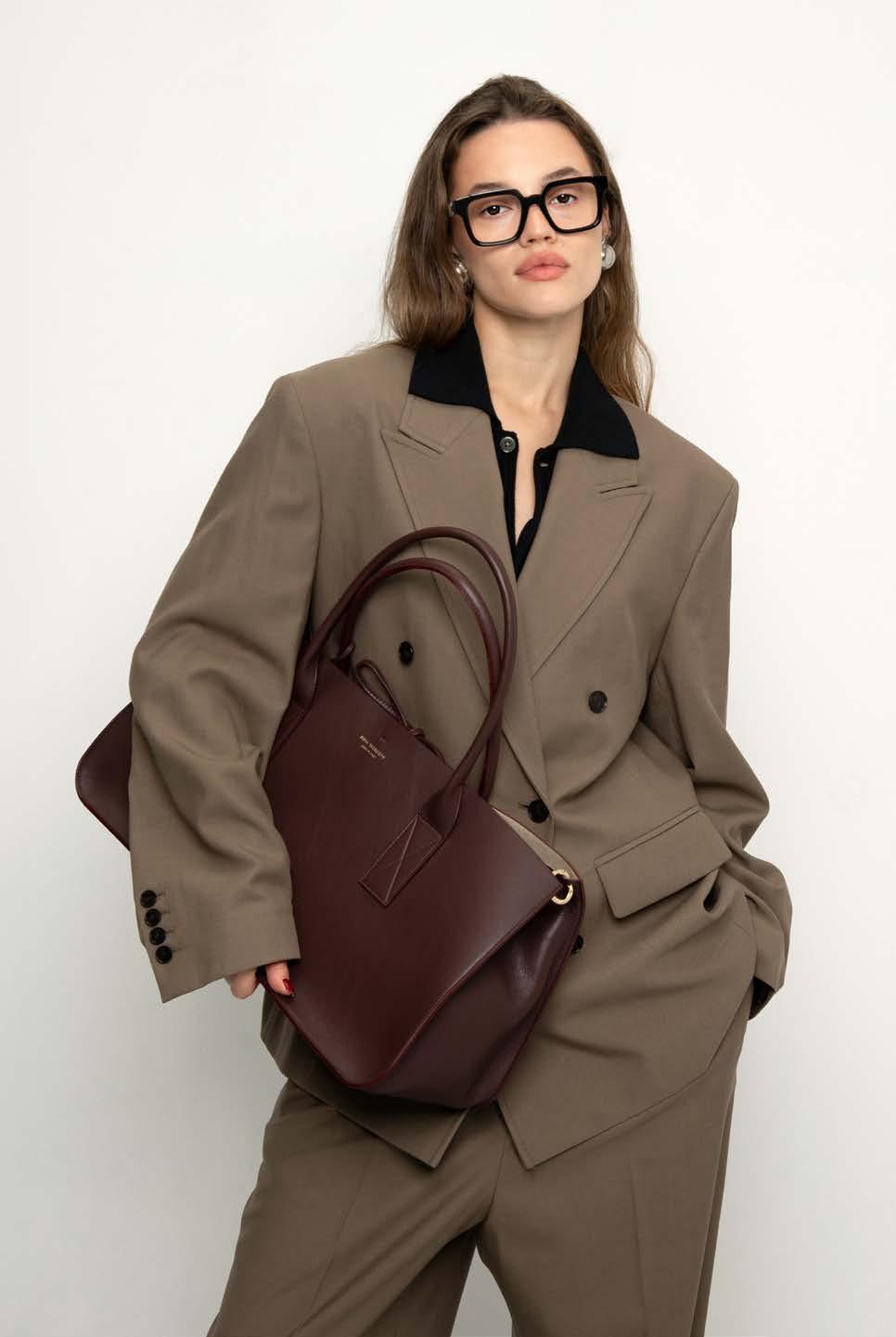
enough with the overpriced high-fashion bags! especially as no other brands are faked as frequently as Chanel, Dior, louis Vuitton et al. the rejection of the typical show-off brands is causing an exciting shift and opening up a new space in the bag market.
text: Nicoletta Schaper. Photos: Brands
The Viennese palace, which usually serves as a showroom for Domani’s high-end garden interiors, is well frequented. To coincide with the Vienna Contemporary art fair in October, Julia Skergeth set up a two-day pop-up store for her bag brand. “We carefully considered everything down to the smallest detail to create a special customer experience, from the room scent and music to the natural champagne and a Japanese tea ceremony,” Skergeth explains. “It is very satisfying that it was so well received!” What does this example demonstrate? That in times of too much comparability in the market and crises in the world, experience, individuality, and communities are gaining in importance. And that it is about more than “just” bags.
Fundamental change is underway: the luxury market is weakening in almost all areas, with far-reaching implications. One of these is a noticeable shift away from the typical show-off brands. This change is particularly visible in the luxury bag market, as hardly any other fashion product exhibits such a stark discrepancy between production costs and final price. Numerous reviews and posts on Instagram or TikTok have dispelled any remaining doubts on the part of consumers. The feeling of being ripped off is growing all the more now that prices have risen so sharply. It seems that an ever-decreasing number of people are willing to pay for very little product and a whole lot of marketing. “Many female consumers who could easily afford Chanel or Louis Vuitton bags are now looking for alternatives in the entry-level luxury sector because it offers a more comprehensible price-performance ratio,” explains Skergeth.



The bag segment appeared rigid in structure for a long time, with the same players constantly dominating the high-fashion and premium markets. Yet now there seems to be room for new collections and fresh brands – moving away from the elegant stuffiness that had manifested itself in this segment in particular, and towards brands in the accessible luxury segment. These brands succeed in combining individuality, quality, and affordability, while also injecting an attitude to life – also, or especially, for a younger clientele. Gianni Chiarini, for example, is a bag brand that has embraced core values of fashionable design and Italian artisanship at affordable prices in the premium segment. “The modern woman seeks uniqueness, a genuine expression of personality, not an object,” explains Ezio Raccichini, CEO of brand owner GC Group. The successful Dua model is available in three sizes, from a spacious shopper to a mini bag, at an entry-level retail price of 165 Euros. “These days, offering excellent value for money is even more crucial,” says Raccichini. So too is its positioning via social media, utilizing influencers such as actress Janina Uhse for the German market and Ambra Angiolini for the Italian market, as well as by Alison Toby and Olivia Palermo. However, the collection must also impress in person. “That’s why pop-ups are part of the strategy, in collaboration with department stores and e-tailers, which are currently driving most of our growth,” says Raccichini. “We are particularly effective at communicating our values on the ground, as exemplified by Ludwig Beck, where we successfully presented a capsule for last year’s Oktoberfest. Notably, the German market has more than tripled in volume compared to pre-pandemic levels, fuelled by partnerships with key players such as Ludwig Beck and Breuninger.”
STYLE AND FUNCTION!
Hardly anything is as defining for a woman’s look than a bag. Yet today, bags have to offer more than mere style; they also need to be functional – which is not as self-evident as it may sound. Iljana Tokouzbalidis has made both aspects a priority for her New York-based bag label Seyer. “Flexibility and mobility are gaining ever more importance in our working lives, which has led to an increased demand for bags that are suitable for use in the office, for working from home, and for travelling. This shift has been evident in the US for much longer and to a much greater extent than in Germany.” Design is still the top priority, but there also needs to be space for a laptop, chargers, and documents. On top of that, Seyer offers a modular concept that allows bags of different sizes to be combined. “In the upmarket, yet not overpriced, segment of the bag market, only a handful of brands combine quality, design, and functionality at a high level,” says Tokouzbalidis with conviction. “In the luxury brands segment, a large leather handbag with no real practical function is not available for less than 2,500 Euros. Filling this gap is an opportunity for fresh, untapped brands.” Having established itself on the US market, the brand is now pursuing a targeted and selective expansion strategy in Europe, starting with pop-up stores. “On an international level, I have observed a shift towards brands that represent values such as sustainability, quality, and understatement,” argues Tokouzbalidis. “Brands that embrace this philosophy will gain in global appeal as customers become steadily more aware of the choices they make as consumers.”

It is all about values, something the name Aigner has always epitomised. The fact that attributes such as quality, trust, and reliability are regaining significance in these times of crisis has enabled the brand’s bags to make something of a comeback. “Quality, great materials, and high-quality artisanship are our top priorities. We also make sure that our designs always retain the typical Aigner look,” says Head of Design Christian Alexander Beck. “The current zeitgeist, with its fashion retro revival, is also playing into our hands wonderfully.” At the same time, he emphasizes the importance of consistently incorporating new elements into the familiar DNA to maintain a sense of modernity. This modernity is also conveyed in the campaigns that further promote the brand, such as the autumn/winter 2024 campaign featuring international, high-reach influencer Leonie Hanne. “She allowed us to tap into the potential of young and very fashion-conscious customers on social media.” It is true that young people have grown up with Zara and H&M, which have socialised and sensitized them to prices. “However, the young generation values quality more than ever, especially where classic accessories are concerned,” argues Beck. “Our Wallet on Chains, retailing at 300 Euros, is a hybrid of a small handbag and a purse on a shoulder strap. It is a great, affordable accessory which also serves as an entry point into the brand world.” The majority of the collection is priced between 500 and 800 Euros. Aigner’s signature style is the Cybill Bag – handmade in Italy and therefore the brand’s most expensive bag, with a maximum retail price of 1,200 Euros. “Our customers trust our quality, which is why we never compromise on leather as a material,” says Beck. “This is why we are an active member of the Leather Working Group, an international non-profit organisation that promotes responsible and environmentally friendly leather sourcing.”



It is not only the younger generation that is more aware of who and what backs brands. As Julia Skergeth explains: “We perceive this as a competitive opportunity, especially in view of the fact that transparency in the production chain has been part of our philosophy from the outset.” She adds: “Precisely because there are so many fakes and such huge marketing markups at many bag brands, we strive to communicate everything transparently from the ground up and break down the costs on our website – showing exactly where the materials originate, right down to the smallest screw. We aim to offer the best possible prices for our Made in Italy quality, which is why we source everything ourselves and buy directly at the source.”
Skergeth knows that a perfectly designed bag is one thing, but the emotion she seeks to evoke in her customers is another. “Today, everything is about experience, which is why people are prioritising travel and why pop-up events are so important. We want our customers to have a good time, as they did at our Vienna Contemporary event – an experience that appeals to all senses.” She endeavours to transfer this attitude to online orders, too. “We dispatch our bags very quickly, which creates a moment of surprise. We provide a style guide with the selected bag, showing the best ways to wear it. We also add a scent reminiscent of the brand to the package.” After all, nothing is as memorable as personal experience.




































































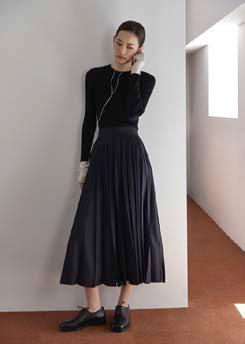
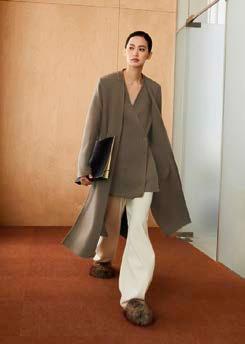































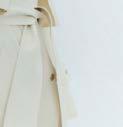





































































the functional bags by the Swedish label are designed by two sisters, Persheng and Perdica Babaheidari, with the needs of the modern business woman in mind. High-quality materials and well-thought-out solutions for folders, laptops and chargers are the hallmarks of these elegant pieces. Whether the business trip lasts a day or a week, the collection includes 12 models for every occasion. these include small and medium-sized handbags that can also be used as evenings bags. the new range also includes weekend and laptop bags, which are also made from italian leather in Portugal. Recommended retail prices are between 370 and 820 euros. www.bybanoo.com
Hidesins stands for bags that perfectly combine design, functionality and the highest artisanship. Made from finest italian leather with the utmost care in florence, the collection offers an impressive variety of models. Whether you are looking for a generous everyday companion or an elegant mini-bag, Hidesins meets every style and functional requirement. the color palette ranges from timeless natural tones to eye-catching, vibrant shades that add a personal touch to any look. With a retail price range from 189 to 387 euros, Hidesins strikes the perfect balance between quality and style. Available to buy at White Milano in february. hidesins.com
“the bags from Silfen Studio have that Scandinavian vibe, are very fashionable and enhance any outfit,” says Medo Diet, who distributes the collection throughout Germany with her Homegirl Agency. What’s more, retail prices are under 150 euros. the trendy Copenhagen label is the brainchild of twins Celine and Daniel Silfen and their five-person team. their bestseller is the lotta Bag made of vegan leather, which thanks to two interchangeable straps, can be worn short over the shoulder or cross-body. the latest hit is the lotta Bag in a cowhide look. All bags are designed for everyday use. @silfenstudio

21+ 22 / 01/ 2025

White Milano is not a fashion fair – it represents a vision. Each edition creates a unique microcosm in which designers, buyers, and fashion enthusiasts come together to celebrate innovation, ethics, and quality. Simona Severini, General Manager of White Milano, shares the latest news about the winter edition.
text: Janaina engelmann-Brothánek. Photos: White Milano
the White Milano womenswear trade show will be opening its doors once more from 27 february to 2 March 2025. the first burning question upon meeting Simona Severini is whether trade shows are still relevant in this day and age. Her answer is unequivocal: “We are not a trade show. We do more than just sell floor space to fashion labels – we create worlds. We field up to 2,000 applications per season. Brands are selected with the utmost care, on the basis of values such as excellence, sustainability, and aesthetic harmony. We prioritise quality over quantity.”
the core of the event remains Made in italy, but White is willing to look beyond borders. “fashion knows no boundaries,” Severini argues. this curatorial approach makes the salon – as Simona Severini refers to the event – a place where every label can convey its story, and all elements of the show come together to create a coherent and inspiring experience.
Visitors can expect a journey through different styles. from tailored coats to avant-garde dresses and bohemian accessories, everything is meticulously staged. “We adopt the perspective of the buyer. each collection must integrate harmoniously into the overall picture and create space for inspiring discoveries,” Severini explains. this fusion of creativity and precision makes White Milano a place designed to inspire physical retail stores. An important aspect of the selection process is the price-to-value ratio. “We are all tired of extremes – from overpriced luxury goods to absurdly low prices. it is time to return to morally sound pricing,” the general manager insists. transparency is key to regaining consumer trust. An increasing number of people want to know the background of a product. this is not merely a question of aesthetics, but also of a deeper connection to what we wear. last but not least, White Milano is committed to supporting young designers. the Secret Rooms allow fresh talent the space to develop their vision. “this is not about trends, but about creating new codes,” Severini says. these rooms provide a platform for designers who live and breathe creativity uncompromisingly and inject fresh energy into the fashion world. White Milano affords them the visibility they deserve, and in doing so, invests in the future of the industry.
“White Milano epitomizes the new luxury,” Severini summarizes. “‘for us, this signifies true quality – not an empty luxury brand, but products with tangible value, created with care, ethics, and creativity.”

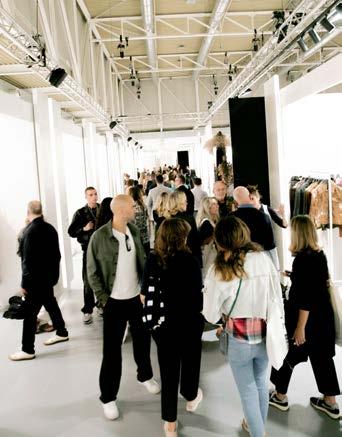


t he fashion industry finds itself at a turning point. New consumer habits, a desire for greater sustainability, and Ai necessitate a rethink. How can companies successfully engage the younger generation? Why are experiences more important than ever? Sarah iglesias Hiller and Carolin franitza joined Stephan Huber to discuss trends, values, and the question of how tomorrow’s fashion might be defined.
interview: Stephan Huber
text: Nicoletta Schaper
illustration: Alexander Wells
YYou have both enjoyed exciting careers to date and taken on responsibility at an early age. In general, we are starting to see a growing number of women take on roles at crucial interfaces. Is the industry evolving as more women enter management?
Sarah Iglesias Hiller, CEO Weave: To be honest, not as much as I would wish. We are still falling short in that regard. In fashion, women are strongly represented in design and product development, but the representation of women in management is still very limited. Consequently, structural change is slow in coming.
Carolin Franitza, Stakeholder Manager Oeko-Tex: I agree, we are not as far along as we could be. Yet I also detect progress. Women frequently bring abilities to the table that create real added value in teams, such as empathy, flexibility, and a greater affinity for collaboration. It is imperative that companies not ignore the differences between men and women, but instead make targeted use of diversity – which, incidentally, also benefits the profitability of the company.
How can companies attract and inspire young talents like yourselves, and how can they retain them?
Carolin Franitza: Throughout my career, mentoring has been a key factor. I was allowed to develop at Oeko-Tex by receiving guidance while also being trusted to explore and experiment. Today, I closely collaborate with NGOs, governments, and other partners in the field of stakeholder engagement to promote sustainability in the textile industry – and I absolutely love it! Young people need role models who offer them development opportunities. It is also important to show young talent that career and family are reconcilable. Companies ought to offer targeted support programs that address their needs.
Sarah Iglesias Hiller: I have worked in the industry for more than ten years now and have had similarly positive experiences during my stints at Inditex and Mango. One of my most valuable insights was how essential networks and targeted support are. Young talents often feel overwhelmed by the flood of information. However, when companies foster structures in which they can express their ideas and take responsibility, it builds real trust. The key is to
lend them a voice and actively involve them in the decision-making process.
We all entered the industry because we share a passion for fashion. Today, I have the feeling that the focus has increasingly shifted from short-lived trends to a consistent look. Is the blind belief in trends yielding to a more all-encompassing attitude towards life?
Sarah Iglesias Hiller: Absolutely. Today’s younger consumers demand more than products – they demand experiences. I was particularly impressed by this phenomenon when I visited Asia. Many stores there resemble showrooms, in which you can no longer buy anything. Instead, people gather there to experience the products, take photos, and then order online.
Which, in turn, has an ecological impact. Carolin, are you an online consumer?
Carolin Franitza: I used to be, but my attitude has changed dramatically as a result of my involvement in sustainability. I used to pay a fair bit of attention to trends. Today, when I buy fashion, I prioritize quality and durability. I hope that the shift towards more mindfulness continues, and I am seeing encouraging signs on TikTok and Instagram. That said, there is still a long way to go before sustainability becomes a matter of course. Vintage is an excellent example: many young people buy second-hand because the items are unique and cool. More often than not, sustainability is merely a welcome bonus. Nevertheless, this trend proves that conscious consumption can be fun.
Sarah Iglesias Hiller: I have noticed this shift, too. On TikTok, for example, you often come across videos showing how to create multiple looks with a single pair of jeans, or how to get by with an essential wardrobe of just ten pieces. Japan is a role model in this regard. They introduced platforms for pre-owned fashion years ago, and now enjoy a strong culture of value preservation. The idea is to appreciate what you have and consume consciously.
How exciting. At style in progress, we address the topic of sustainability in depth. Having said that, I believe that the industry has yet to find a way to normalize sustainability. I would go as far as to say that this is partly the fault of the consumer.
Carolin Franitza: Yes, the gap is indeed considerable. On the one hand, we have a growing community

of conscious consumers. On the other, ultra-fast fashion brands such as Shein or Temu are booming with extremely low prices – especially among young consumers. All too often, there is a lack of tangible, comprehensible explanations of what sustainability really entails.
Sarah Iglesias Hiller: I agree. Companies have to provide the framework. At Mango, for example, I developed the teen collection. Sustainability was embedded in the concept from the outset because we knew that the issue would be relevant. Even so, we still face challenges because many young people do not act solely out of conviction. Trends such as vintage or second-hand are lifestyle decisions, and sustainability is often just an add-on.
In other words, sustainability has an image problem.
Carolin Franitza: That is certainly part of the problem. Sustainability is often communicated in an abstract and complicated manner. Furthermore, pricing remains a major issue. Many people simply cannot afford sustainable products. Companies and politicians need to create an environment in which sustainable products are universally attainable.
Sarah Iglesias Hiller: It is also a matter of avoiding consumers feeling they have to undertake major personal efforts for sustainability. I recently attended the NF&TA event in Oslo. Sustainability was the main focus of the event, so all participants were required to bring their own cups. This was confidently communicated as a general rule, and there was no other option. Such approaches could prove successful in our industry if they are implemented consistently.
Coming back to our working environment, AI will fundamentally change the way we work. Do you consider it a threat or an opportunity?
Carolin Franitza: AI is a powerful tool. It can make processes more efficient and open up new possibilities. Yet I am concerned that we might come to rely on it too heavily. There is a real danger of losing our independence and ability to think critically. We should therefore be mindful of how we use AI and recognise its limitations.
Sarah Iglesias Hiller: I prefer to think of AI as a tool that supports creative processes. It can, for example, assist in tapping into inspiration or visualizing initial
ideas, but it will never be capable of replacing the human factor. To me, AI is akin to a really good intern: Exceptionally helpful, but only as good as the input you provide.
Perhaps the advance of technology triggers a yearning for authenticity?
Carolin Franitza: Yes, I do believe that people are becoming ever more intent on seeking authenticity, exchanging ideas, and real experiences. The more technology pervades our daily lives, the greater our need for tangible and human elements.
Sarah Iglesias Hiller: I wholeheartedly agree. Despite all the technological advances, the yearning for closeness and authenticity remains essential. That is precisely what will shape the fashion industry going forward.
Carolin Franitza started her career in design and sales six years ago. Now 25 years old, she has been working at Oeko-tex since 2021, currently in stakeholder management. Her role involves implementing sustainable solutions in the textile and leather industry.
following positions at inditex and Mango, where she developed the teens collection, Sarah Iglesias Hiller launched her company Weave in October 2024. Her primary objective is to make the entire supply chain more efficient and sustainable for brands, producers, and resellers by implementing Ai-supported workflows, while simultaneously reimagining the role of women in fashion and fashion technology.
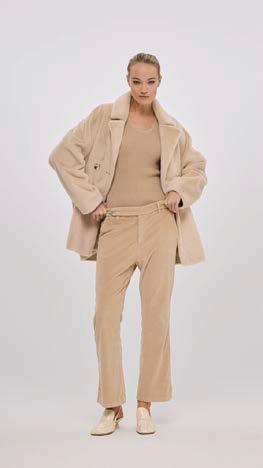










AlphaTauri
Alphatauri made a statement by appointing isabelle Ko as their new Global Head. Supported by a dedicated team, she is tasked with leading the brand, which emerged from the Red Bull universe, into a sustainable and successful future. Speaking to style in progress, Ko provides some initial insights into her strategy. interview: Stephan Huber. Photos: Alphatauri
Storytelling is crucial for brands today. What is AlphaTauri’s central narrative for the future?
Isabelle Ko: AlphaTauri is a global premium lifestyle fashion brand! While many brands collaborate to leverage synergies in fashion, sports, culture, and lifestyle, we inherently have these connections. This sets us apart and allows us to focus on building an inspiring, like-minded community united by a passion for sports and creativity. Our designs combine function and aesthetics, meaning we offer athletes a fashion advantage and the fashion community an active, dynamic vibe. This duality defines our brand philosophy.
How do you intend to take full advantage of these opportunities and connections between sports, art, and other creative disciplines? And how will that influence AlphaTauri’s future development?
That is the key question. Being part of the Red Bull family comes with extraordinary opportunities. We have already started to capitalize on these by featuring outstanding Red Bull athletes in every campaign, showcasing their personalities, and telling their stories – for example, Max Verstappen or Joël Schwärzler. This approach pairs their unique presence with compelling storytelling. The global reach of the Red Bull network is yet another advantage. We partake in various market activities, from the Red


Bull Pit Lane in Madrid to the Red Bull Bassline event in Vienna or the Miami Grand Prix. These activities are not merely about presence – they also inspire product innovation. These synergies are what make us truly special.
The 2026 Winter Olympics bring about an exciting collaboration with the Austrian Olympic Committee. How does this impact AlphaTauri’s collection?
Outfitting the team for the opening and closing ceremonies is a real honour, as well as a creative challenge. Yet it was so much fun! Engaging closely with the athletes helped us to understand their needs and preferences, which inspired our designs. While this represents a very particular sportswear project, our focus remains on premium fashion. Today, the Olympics are also a fashion and style platform – and we really embrace that.
How does AlphaTauri strike a balance between its functional roots and a sharper focus on fashion?
Innovation remains at the core of AlphaTauri. We are constantly pushing the boundaries of material innovation, from developing specialized outdoor fabrics to experimenting with 3D knitting and new yarn combinations. While innovation retains center stage, we are increasingly focused on how these advancements align with our broader vision and brand expression. It is no longer about choosing between sportswear and fashion, but about the fusion of the two.
Turning to womenswear, what are the next steps for AlphaTauri in this area?
We are looking forward to relaunching our womenswear line in spring/summer 2026 with an even more distinct and refined collection. Meanwhile, we are developing styles for couples – a rapidly growing trend, especially in Asia, where fashion often symbolises an intimate connection. This avenue allows us to develop a new narrative and create something truly special.
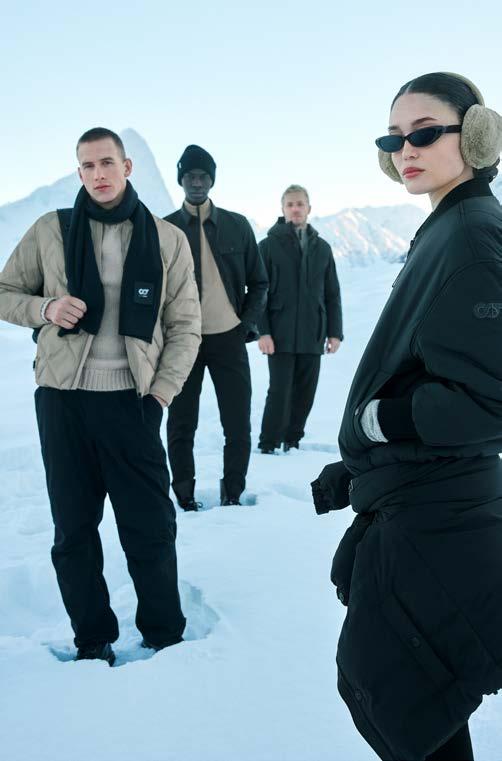
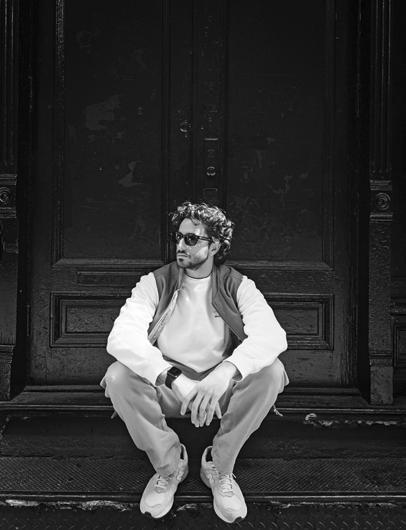
People of Shibuya has reinvented itself – and in doing so, deliberately refocused on the essentials. Under the creative lead of Alberto Premi, the brand is undergoing an exciting transformation, as expressed in the new collections. We sat down with the Creative Director to discuss the highlights of the autumn/winter 25/26 collection, set to debut at Pitti Uomo and Milan fashion Week.
text: Janaina engelmann-Brothánek. Photos: People of Shibuya
Rather than rebranding, Premi is embracing a genuine return to the roots for the new collection. The focus is firmly on layering – not just as a stylistic device, but as a savvy response to an increasingly unpredictable climate. Functionality is elevated to an integral aspect of the design: layering allows for flexibility and versatility. Materials such as Cordura, jacquard, technical wool, and softshell underpin this philosophy by creating robust, high-performance, and elegant looks for the modern man who is forever on the go. The approach is geared towards a dynamic lifestyle in which aesthetics, comfort, and versatility are of equal importance. The label’s DNA – its Japanese identity – remains distinct and recognizable, evident in precise design, high-quality materials, and meticulous artisanship. Two notable new additions include collaborations with Gore-Tex and ACBC. These capsule collections introduce innovative and sustainable elements to the line, making technical sophistication wearable. The next milestone follows in January 2025: the brand’s first womenswear collection. Premi describes it as contemporary and voluminous – inspired by Japanese aesthetics but perfectly aligned with Western silhouettes. “At last, the People of Shibuya woman can extend her hand to her male counterpart again,” he adds with a smile.


lello Caldarelli about creating a new narrative for Antony Morato through art and creativity. text: Stephan Huber. Photo: Antony Morato
You launched “The Sound of Unity” in 2024. What inspired you to create this new format?
Lello Caldarelli, founder of Antony Morato: I felt necessity. Today, the product alone is no longer enough. Customers are looking for something beyond. So, we asked ourselves, ‘What can we do to engage our customers on a deeper level?’ And music was a natural starting point for us.
And how did the audience respond to this shift in focus?
It’s been amazing. The Sound of Unity added a new dimension to the brand that resonates deeply with today’s consumers. So we elevated it into a central narrative, making it a platform to celebrate young talents in DJing and producing.
For me, personally, it’s also about giving back –creating opportunities for talent to thrive, just
as I was fortunate enough to have chances in my own life. Can we expect a sequel?
It’s in the making! But for the second edition, we’re going all-in on B2C. The event will move to Milan, between March and April, and will be completely focused on engaging end customers. It’s still a work in progress, but the vision is clear: more music, more talent, and more engagement with the community. We’re in the process of selecting the next ambassador for the project – someone who embodies the energy and creativity we want to showcase. What does this mean for the future of the brand?
We not just a fashion brand anymore. We’re becoming a movement, a cultural force, exploring ways to expand the concept to other pillars, like contemporary art and travel. It’s an exciting time.

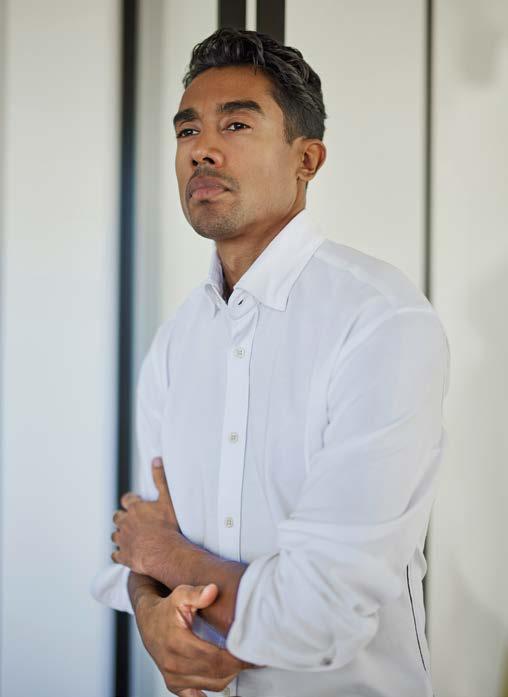

Do blouses or shirts really have to cost more than 100 euros? fil Noir and Heiko Storz reject this notion outright and are expanding the commercial price ranges of both the womenswear and the menswear collections. Also new: NOS for key pieces.
text: Nicoletta Schaper. Photos: fil Noir
“We have done our homework,” says Heiko Storz. The renewed strength of the entry-level price points is evident in both the Fil Noir Uomo shirts and the womenswear collection. “Offering a European product, Italian fabrics, and best components – that is something to be proud of!” Emotion is the second crucial factor in breaking consumer reluctance. “With our slogan ‘The Finest in Casual’, we positioned ourselves as the brand for the beautiful moments in life. This emotion lends itself to soft washes, supple collars, and tasteful prints. I am passionate about this aesthetic work, and I am a poet to the core in terms of materiality and workmanship,” smiles Storz.
365 DAYS
A (relatively) non-seasonal product demands corresponding reordering options. “In 2025, we are investing in a NOS program that impresses on two fronts: with a mark-up of 3.0 and commercial core retail prices of 79, 89, and 99 Euros.” By engaging in dialoge with customers, the brand finds out where it can provide additional support. “Our Swiss Hest GmbH is a private label supplier for some renowned fashion houses, a potential that we would like to explore further.”
What does the future hold for the Black Label business line, which was launched in 2024? “We still see great potential for elegant shirts at a reasonable price, but we are pragmatic enough to know that we still have to prove ourselves,” says Storz. Donna has grown yet again, with pants, skirts, dresses, and shirts to complement the blouses. “Always special, but timeless enough for women to know that they will be wearing the pieces for more than one season,” Storz concludes.


“WE
in a short time, italian trouser specialist 40Weft has made impressive progress on the German market. “We have doubled the numbers – both in terms of customers and pieces sold,” says the brand. these successes are based not only on quality, but also on proximity and service. text: Martina Müllner. Photos: 40Weft
Tailor-made for the German market: “We see ourselves as an emotional trouser brand – not too basic, but not overly fashionable either,” explains the company. “We are careful to not cross the line of 200 Euros.” The carefully curated collections strike a chord with discerning retailers. The fashionable variety of fabrics and models is particularly appreciated: From special washes to modern, universally wearable models such as ‘Easy Fit’, a new line of technical material with an elastic waistband that combines comfort and style.
In addition to the quality of the products, 40WEFT gains traction through comprehensive retailer support. “We are in close contact with our partners, whether through personal visits, roadshows or services such as the exchange of unsold goods.” Especially in times when retailers have to overcome challenges, 40WEFT shows responsibility: “We adapt flexibly to the needs of the market and work to find better and better solutions.”
The brand is also at the forefront when it comes to events and emotions: “Retailers who inspire their customers with special promotions such as invitations and events see great results. We support them in this where we can.”
For the coming season, 40WEFT has announced not only new fabrics and washes, but also services such as stocks of certain bestsellers defined by the market. “We are thinking ahead and building a strong presence step by step – in Germany, Austria and Switzerland.” With this strategy, 40WEFT is committed to sustainability in its partnership with its retailers, and long-term growth. www.40weft.com




Twothirds
the Barcelona-based brand, founded by surf enthusiasts in 2010, not only obtained B-Corp certification in 2022, but also offers its 450,000 customers an innovative pre-order model in the D2C sector to avoid overproduction, and processes a great deal of deadstock. Now twothirds is swiftly establishing its wholesale operations in europe with collections specially developed for the stationary retail trade.
text: Kay Alexander Plonka. Photos: twothirds
CEO Lutz Schwenke used to work for the UN before he launched Twothirds to protect the oceans for future generations by means of a sustainable brand.
“Our first wholesale collections, launched in 2024, were very well received. An immediate reorder rate of 25 percent reflected the interest of customers and the satisfaction of retailers,” explains Lutz Schwenke, founder and CEO of the premium brand for sustainable fashion and ocean lifestyle. He has steadily expanded his online business with a loyal customer base since 2017. The next logical step is to expand into stationary retail in order to develop touchpoints and reach additional consumer groups. “We can offer retailers a foundation that also benefits them. On the one hand, our findings, such as product optimization, are incorporated into the wholesale collection through direct feedback from consumers. On the other hand, our production capabilities in Europe allow us to react quickly to trends. It also results in exciting, customized communication concepts involving our 700,000-strong community of social media followers in order to generate demand in the stores,” says Schwenke.
Only natural materials, such as organic cotton and certified recycled fabrics, are employed for the wholesale menswear and womenswear collections comprising around 100 items. The brand is also establishing a NOS program. Retail prices range from 190 to 450 Euros for jackets, 100 to 230 Euros for knitwear and sweatshirts, 50 to 80 Euros for t-shirts, and 100 to 150 Euros for pants.
Twothirds currently serves ten European markets. “Germany is definitely our main market, followed by Switzerland and the Benelux countries. In these countries, we will start supporting our specialized retail partners locally via agencies with immediate effect. This allows us to concentrate in-house on developing other markets such as France, Austria, the UK, and Scandinavia,” says Schwenke. The autumn/ winter 2025 collection, entitled Northern Tales and inspired by Nordic coasts and the Baltic lifestyle, is on show at Who’s Next in Paris and CIFF in Copenhagen. Agentur Brandstof of Amsterdam handles sales in the Benelux region. Jan Arend’s Friendly Products agency from Cologne is responsible for the north and west of Germany, while Agentur Corinna Hesse covers the south, east, and Switzerland. Schwenke: “We firmly believe that our online and offline channels complement each other in terms of long-term, sustainable growth and are pressing ahead with global growth such as in the USA, Canada, Australia etc. with over 2,000 POS by 2030.” @twothirds_bcn



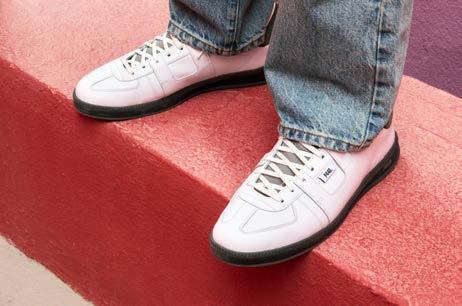


in expansion mode: P448 is ready to take on the european market. What does the italian sneaker brand bring to the table? Know-how, but perhaps even more important is the lifestyle that the brand embodies. text: Nicoletta Schaper. Photos: P448
With so many sneaker brands competing in a hotly contested market, what makes P448 unique?
Quintin Donders, Commercial Director New Markets: P448 has a clear identity. We are not a traditional footwear brand that has transitioned to sneakers, but rather a lifestyle brand from the ground up. We embody values such as self-expression, inclusivity, and sustainability, using recycled materials and the most environmentally friendly production methods. Our designs are influenced by art and subcultures, as well as traditional Italian craftsmanship. We also sponsor athletes, including surfer Balaram Stack and Olympic skateboarder Bombette Martin.
P448 recently underwent a strategic sales repositioning.
Yes, by implementing a segmentation strategy and clear brand message. The US has been our largest market to date. We are stocked by Bloomingdales and Nordstrom, for exam-
ple. In Europe, Italy is our strongest market, followed by France. Our e-commerce business in Europe has experienced particularly strong growth of 55 percent. Now we aim to grow in stationary retail and have found a powerful expansion partner for Europe in Barcelona-based The Camp Brands. The goal? To establish a unified global presence for P448 while also making a local impression, not least with mono-brand stores in key cities. The same applies to the DACH region, where we have found the perfect partner in TP Studio. Germany is our fastest growing market in Europe and is set to become our largest going forward. With which fashion highlights?
Monochrome designs, muted metallics, and surprising materials such as velvet or alpaca wool. In addition, colored soles or a subtle vanilla scent make our shoes unmistakable. We also offer customizable options for the first time, to bring us even closer to the customer. www.p448.com


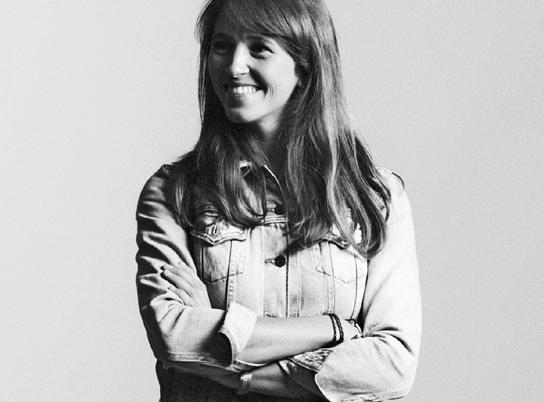
Parajumpers is renowned for its high-quality outdoor collections. Yet how is the company responding to global challenges such as climate change and shifts in the retail sector? Cristina Paulon, the visionary head of the family business, discusses the developments of recent years.
interview: Janaina engelmann-Brothánek. Photos: Parajumpers
How did you overcome the challenges of recent years?
Cristina Paulon, Brand Manager Parajumpers: During the Covid pandemic, we managed to compensate a great deal through the e-commerce boom. After that, however, we experienced oversupply as many retailers had overfilled their warehouses. This led to a natural correction in order volumes. Despite the decline, we consider it a necessary return to more balanced quantities.
How are you addressing the issue of climate change?
We have significantly expanded our collections – from sportswear to lightweight down jackets and transitional styles. Lightweight products are gaining in relevance. We are also specifically adapting our drops to suit the seasons and climatic conditions.
What role do your iconic masterpieces play?
They represent our DNA and remain an integral element of the brand. However, we have modernized them by slightly modifying the cuts and using new materials such as fine wool qualities, as well as special leather and lambskins.
How is the womenswear collection progressing?
We are working on a more feminine, contemporary silhouette whilst focussing on high-quality materials such as premium wool. The total look approach, which was easier to realize for menswear, will also be applied to a greater extent in the womenswear collection.
What is the pricing policy at Parajumpers?
We carefully analyse the purchasing power of our customers and set our prices accordingly. Of course, the cost of raw materials – such as down – has risen sharply and we are forced to pass on some of these increases. Nevertheless, we maintain a precise and responsible pricing policy.
Diverse by conviction, open, permeable, an environment where lateral entrants are welcomed with open arms – the fashion industry is a paradise for expressive individuals seeking to assert their individuality.
The “anything is possible” mantra promotes talent – or is that precisely what acts as a deterrent?


Tt he fashion industry is suffering from a talent shortage. An ever-decreasing number of young people are attracted to a career in the industry. employers, accustomed to being held in the highest regard for years, often fail to find answers to this problem. t hey are quick to resort to Gen Z and Gen Alpha bashing, insinuating that entire generations of talented individuals are not willing to work. We decided to listen to those who know best: young people taking their first career steps in fashion. from the apprentice to the dual student, from the purchasing trainee to the newly self-employed. t hey reflect on what drives them, what slows them down, and which opportunities they identify in this industry. An open and honest conversation about courage, challenges, and making a difference.
interview: Martina Müllner
illustration: Alexander Wells
YYou have all made a conscious decision to pursue a career in fashion. This would not be the first choice for many of your peers, especially considering challenges such as prominent bankruptcies in our industry, which are a frequent topic of media coverage. The retail industry is under great pressure to reform. Not exactly the sort of environment that reassures parents or friends that you have made a wise career choice. So why did you decide to enter the fashion industry?
Romy Stirner, student at Duale Hochschule Heilbronn with Mustang: I realized early on that I would like to study business administration, so the dual study program in fashion management seemed like the perfect fit. It was a heartfelt decision, simply because I really like the field. What surprised many is that I decided against venturing into the industrial segment. It is very prevalent in my home region and is traditionally considered a dependable employer. Compared to that secure image, even a long-standing company like Mustang seems like the more uncertain option. Fashion has a somewhat questionable image; I agree with you there. Yet for me, this is an incentive. I would like to show that you can also be successful in fashion, and I regard this as a rather exciting challenge.
Vanessa, you even decided to start your own business in this somewhat volatile industry. Did you get any apprehensive comments from family or friends?
Vanessa Quehenberger, partner at Eibl am Kajetanerplatz/Salzburg: Not really, as I have been working in the industry for several years and completed my training in fashion retail. The fact that I am now striking out on my own by running the men’s department of Eibl am Kajetanerplatz in Salzburg on my own account has surprised many. Nevertheless, I have primarily received encouragement. Of course, I have also been asked whether I am sure if this choice is wise, but it has always been clear to me that fashion is my path.
Oliver, do people expect a young man your age to go into fashion?
Oliver Christoffel, third-year apprentice at Modehaus Zinser/Tübingen: My friends were sceptical at first, too, especially as many of them choose a skilled trade or a technical career. Many of them perceive fashion as a difficult and insecure industry. I think they associate fashion with a certain image – social media has not managed to change that. Many of them are unaware that the fashion industry offers so many opportunities and is about more than just trends. I am always happy to set the record straight!
Alexa, in terms of prejudices associated with your profession, which ones have you been able to dispel in your immediate environment? There must be quite a few, especially given your remarkable career to date. After graduating from high school, you completed your training as a retail manager. In your third year of training, you were already a department manager at Peek & Cloppenburg, then deputy managing director. You then switched to the trainee position at Mein Fischer to pursue your dream of working in purchasing.
Alexa Talko, purchasing trainee at Mein Fischer/Taucha: I have wanted to work in fashion since I was a child and have come a long way since my very first steps as a temp while I was still in school. I also feel that the public image of the fashion trade does not correspond at all to what I – and many of my colleagues for that matter – experience in terms of opportunities. I now work in purchasing and often have to explain to family and friends how demanding the job is, from negotiations to market analyses. Purchasing is much more strategic than simply viewing beautiful collections in beautiful places. There is so much to discover in fashion that an outsider might not even be aware of. Many think of glamour and glitter without realizing that a lot of hard work goes into every item that makes it to the sales floor.
You all describe a gap between the one-dimensional image of the profession and its varied reality. Do you think that this discrepancy contributes to the fact that many young people no longer view fashion retail as an attractive career option?
Oliver Christoffel: Definitely! What does anyone really know apart from the clichéd image
of the salesman or completely out-of-touch positions? For many people, fashion is associated with the catwalk or designers, but that is far from the truth. Hardly anyone realizes how diverse fashion can be. To be honest, I did not know either until I joined Modehaus Zinser. You can move into purchasing, marketing, visual merchandising – there are so many jobs that the general public know nothing about. In my opinion, the industry could do more to communicate these opportunities.
Vanessa Quehenberger: I believe the flexibility of the job should be more effectively communicated, too. The fashion industry offers so many possibilities to organize my day and my work independently, especially now that I am self-employed. Many people are not even aware of the creative and flexible nature of the fashion retail business, yet this aspect was the decisive factor for me to enter and remain in this line of work.
Romy Stirner: I agree. The public image of the fashion industry is often somewhat one-sided, and that may put people off. I think the industry needs to broaden its focus and show the earnings potential and level of professionalism in fashion. That would certainly get more people interested.
This is an interesting point. Alexa, what do you think? How could fashion houses attract more young people?
Alexa Talko: I am convinced that it would help if fashion houses made a greater effort to showcase their diversity. Young people should know that they can accomplish a great deal in fashion and that their ideas are valued. That is actually quite an advantage in fashion. As a young person, you are presented with many opportunities to develop and take on responsibility, provided you perform well. We should really emphasize more how open the fashion industry is to change. That is a compelling argument for a generation that wants to make a difference.
Key aspects of the fashion industry that are off-putting include the low starting salary and the working hours, especially on Saturdays. How do you feel about these aspects?
Oliver Christoffel: The generally poor image of retail is a major problem. There is this prejudice: “What could be more menial than
standing in the middle of the shop floor, selling stuff?” Frequently, the job is presented as something that people who cannot do anything else resort to – yet selling and providing advice requires a great deal of skill. Learning these skills also has many positive effects on one’s personality. If this were properly communicated, the negative aspects, such as working on Saturdays, would quickly fade into insignificance. For example, I have the option of working on a Saturday and getting a day off during the week in return – I think that is great. Some see that as a disadvantage, but that flexibility is something I appreciate.
Vanessa Quehenberger: I really love working on Saturdays, just like I love my day off during the week.
Alexa Talko: The perception of a salesperson is far from clear. Many assume that you just stand there, doing hardly anything except selling and clearing away stock. The fact that even standard salespeople have much more complex tasks today, whether this involves analysing figures or deciding which items should ultimately be displayed where, and that there is much more to it than that, is hardly known to the public. I always say that anyone who has made it in sales can make it anywhere. From that point on, so many doors are open to so many departments and fields of work.
Vanessa Quehenberger: I totally agree. Of course, I enjoy a greater degree of flexibility as a self-employed person, but even in my permanent position, I was often able to organize my working hours to accommodate my lifestyle. As for salary, it really depends on the company and your own negotiating skills. I learned early on how important it is to be proactive and show what you can do. Then you also have a chance of being remunerated fairly.
Alexa Talko: I made a conscious decision to enter the retail business, despite the occasionally challenging hours. What is important is to be certain about what you want. I see it this way: you are offered the chance to accomplish something and advance quickly through hard work. This dynamic is a great source of motivation for me.
Taking on responsibility early on – does that work at every level?
Oliver Christoffel: Yes, those who show initiative have real prospects. In my second year of training, I was already entrusted with designing my own spaces and implementing my ideas. I found that highly motivating. Initially, I had imagined my training quite differently – that I would simply have to follow instructions. My superiors, however, assigned responsibility to me early on. That made me think: Cool, my opinion really counts!
Romy Stirner: That really is a perspective that many people are unaware of – how quickly you can take on real responsibility in the fashion industry if you perform accordingly. During my dual studies at Mustang, I passed through various departments: from marketing to logistics to product management. I was always given full responsibility for the work I took on in each of these departments – I was never given unimportant tasks or intern work but was always given real work to do. So, I had to do it well!
Alexa Talko: In my position as a purchasing trainee at Mein Fischer, I quickly gained the trust of my superiors through keen interest and commitment, so I was allowed to work independently. In purchasing, you realise the importance of strategy and planning day in, day out. I feel like a creator, helping to advance the company. I find it fascinating to see how many details have to come together to implement a concept.
How has this responsibility changed you as individuals?
Oliver Christoffel: I am certainly a completely different person today than I was when I commenced my training here three years ago. It took a great deal of resolve to work on the sales floor for the first time. I simply was not used to opening up in that manner. I would never have believed I was capable of conducting a conversation like that back then – but today I absolutely can. You learn to engage with people and handle difficult customers. Last Saturday, for example, I noticed a customer who clearly had no desire to go shopping himself. He was there because his wife wanted him to. I was able to impress him with the first pair of pants I showed him, and suddenly he had a smile on his face.
What challenges come with the job?
Vanessa Quehenberger: As a self-employed person, it is often a case of juggling many tasks simultaneously. You think you are prepared, but then the day-to-day business kicks in. I had to learn how to organize my time and make decisions quickly.
Alexa Talko: In purchasing, the biggest challenge during the main order phase is to manage the heavy workload while setting priorities. There is always something to do.
Oliver Christoffel: One challenge is adapting to different target groups. I really noticed that when I switched from young fashion to classic menswear. You learn to empathize with different target groups over and over again.
Speaking of target groups, you are all part of the young generation and have first-hand experience of how fashion is consumed today via social media. How do you think the image of fashion has shifted within your generation?
Romy Stirner: Fashion is extremely prevalent in our generation and, thanks to social media, a much bigger part of our everyday lives. In the past, fashion might have had an elitist touch, but today you can find inspiration everywhere. Platforms like TikTok show that fashion is not the sole preserve of big-name designers, but that many people are developing their own style.
Oliver Christoffel: Exactly. Today you can express yourself fashionably regardless of how much money you have, and that is important to many people. Fast fashion and social media have made fashion more accessible, and that encourages a younger generation to take an interest in fashion.
Alexa Talko: For us, social media is a great source of fashion inspiration. Yet even for us in purchasing, it is important to monitor these channels and filter out current trends. It is precisely these that you often see reflected in the next few seasons, albeit in a slightly modified form.
Which aspects of fashion appeal most to you? What gives you the greatest pleasure?
Vanessa Quehenberger: For me, the greatest pleasure is the feeling of creating something of my own. Fashion affords me an opportunity to express myself and experiment. I cannot imagine a more fulfilling profession.
Oliver Christoffel: I enjoy interacting with customers and the trust they place in me. It makes me feel like my work has an impact. Even small things make a difference. I once had a customer who was looking for an outfit for a date. After work, I happened to see him downtown on his date, and I can say with certainty that it went well. It made me happy to think that I might have played a small part in making it happen.
Alexa Talko: In purchasing, one has to see the bigger picture and help shape it. Shaping the private label, in particular, is loads of fun. You directly influence the style and direction of a company, which is incredibly exciting.
Romy Stirner: As for me, I love the versatility. Fashion is a combination of creativity, business savvy, and strategy. I really enjoy this diversity.
What advice would you give to young people who are interested in fashion? Why should they choose a career in fashion?
Vanessa Quehenberger: I would emphasize that fashion is a profession in which you can grow. Those who are willing to take on responsibility and work creatively will derive a real sense of satisfaction from it.
Alexa Talko: The fashion industry has a lot of potential and is an extremely versatile professional field in which you can contribute your own ideas and make a difference. Having the opportunity to see the latest collections at suppliers and sift through the latest trends at fashion fairs like in Copenhagen and Florence inspired me to move into purchasing.
Romy Stirner: For me, fashion is a way of expressing myself and being part of a vibrant, ever-changing market.
We have four enthusiastic advocates for fashion at the table. What would a campaign that conveys your enthusiasm to potential supporters involve?
Romy Stirner: It would have to reach young people who, after graduating from high school, often have no idea what to do. I know the feeling of not having a concrete plan all too well from my own experience. Many are hesitant to start an apprenticeship or a degree program because they simply do not yet know which direction they wish to take. This is precisely where we could step in and generate enthusiasm for fashion at an early stage by addressing it directly and showing what the industry has to offer. It would also be helpful not to stereotype Generation 2000 and younger as if we all don't want to work, or are solely interested in a four-day week. Of course, there are different views, but many young people actually want to make a difference and are working hard to find their calling.
What is the message?
Romy Stirner: We should proactively shape the future and encourage the younger generation to embrace responsibility. Once you have found your own interest, as Oliver said, motivation increases naturally. Instead of focusing on grades and traditional career paths, the objective should be for everyone to find their passion and do what they really enjoy.
Oliver Christoffel: I could not agree more. I am a prime example of how you can thrive without top grades. School was always a chore for me, as I perceived much of what was taught there as irrelevant. Fashion was my escape. If I had continued to pursue my A-levels, it would have meant at least four more years of school for a certificate that would have meant very little to me. My training in fashion has opened up a perspective I would never have discovered in school. Today, I feel like I have arrived, enjoying just as many opportunities as I would have had after graduating from high school. I also notice that social media distorts career prospects for many people my age – images of yachts, luxury cars, and designer watches tend to create false expectations. This dream world of Instagram is not realistic for everyone, and not everyone can go down this path. However, ‘I want to do my own thing’ is actually still the preferred option for many. Yes, who knows, maybe I will feel the same way one day, but then I will always have a profession to fall back on. I believe fashion is a stable industry that offers me
security and development opportunities, even if the retail industry itself is subject to change. If the number of retail spaces decreases, there will be other tasks and areas of work. The fashion industry remains exciting and, with a good foundation like an apprenticeship, you are assured of a secure future.
Interesting thought. Alexa, would you regard fashion as an industry in which you want to have a long-term career? Perhaps even until you retire?
Alexa Talko: Yes, actually! My love of fashion is strong enough for me to envisage a long career in this industry. Fashion is multifaceted enough for me not to worry about getting entrenched at some point. Of course, retail will continue to evolve. Perhaps cities will lose even more stores, or the balance will continue to shift towards online retail. Yet I believe that the brick-and-mortar business will also continue to evolve and perhaps even give rise to a countermovement over time. Regardless of the direction the industry takes, I am sure that we, especially young people, will adapt and find our place. One thing is certain: If you remain open to new ideas, something interesting will always come along.
Vanessa, what prejudice about your generation would you like to dispel?
Vanessa Quehenberger: I often hear that all young people aspire to become influencers or TikTok stars. Of course, social media is hugely important to many of us, and there are quite a few who genuinely dream of being an influencer and put all their eggs into that one basket. I often gain the impression that some people think of a career in sales in the same way as they do of being an influencer. They do not realize that you gradually grow into the tasks. At the beginning, you are expected to sort goods, create decorations, or even clean windows – but all of this is part of a process. The prejudice that many in our generation are no longer willing to go through that process, but rather want to do the glamorous stuff from the outset, may hold true for some. The majority, however, understand that the purpose of an apprenticeship is to learn one task after another while also developing as a person. We are not all princesses; we can also roll up our sleeves and get things done!

Different times, different rules, different priorities: young people have a distinct approach to launching businesses. New entrepreneurs prioritize agility, sustainability, and new technologies. A closer look at the motives and strategies of young founders reveals why. What also becomes apparent is that they bring different values to the industry.
text: Martina Müllner. illustration: AdobeStock 1494
Young founders grow up in a digital world, giving them a competitive edge over those who first have to translate an analog model into a digital format. Every new store considers Instagram to be an important sales and marketing tool from the outset, and every new brand gathers loyal customers on Tiktok or Instagram before venturing offline. This generation’s affinity with technology allows for a high level of interaction with their target group. For young founders, e-commerce and digital branding represent an integral part of their start-ups. Not only is the face of fashion increasingly digital, but AI- and automation-based process tools in the background also underscore the digital-first approach of this generation.
SUSTAINABILITY AS A CORPORATE ETHOS
The notion that sustainability is no longer a topic of discussion is a prejudice of the fashion industry’s Old Boys Club. The German Start-up Monitor shows that 48.1 percent of domestic start-ups identify as part of the green economy, up from 46.7 percent in 2023. In terms of fashion, it is evident that an ever-decreasing number of people regard fashion as a purely mass-produced consumer product. Longevity, ethical production, and environmentally friendly materials are considered a must, as are the values of transparency and environmental friendliness. Resale, upcycling, and repair are by no means mere hypes, but natural components.
THIS TODAY, THAT TOMORROW
A franchise agreement that binds a business to a single brand world for the next 40 years sounds like a horror scenario for a generation whose brand reality consists of drops, limited editions, and collabs. It should therefore come as no surprise that their business models are also dictated by temporary phenomena: pop-up stores, interim uses, and community spaces. Irrespective of the part in the chain, founders often shy away from long-term relationships. This poses a particular challenge for landlords and cities, which needs to be overcome. According to Statista, the global market for pop-up real estate was worth 80 billion US Dollars in 2023, and a study by PWC predicts an annual market growth of 15 percent. In a Shopify survey, 87 percent of DTC brands said they were planning a physical pop-up in the coming year.
Purpose is the magic word. Financial success is accorded a lower priority, which our affluent society can afford. The level of social security in Central Europe is high. In addition to traditional loans, public funds and private assets are available to support start-ups – many founders come from privileged backgrounds. This affords them the freedom to embrace values such as authenticity, autonomy, and social responsibility. The fashion industry is relevant to many people’s lives, so the idea of contributing to social change with innovations, products, or ranges comes naturally. Founders use their companies as a platform to implement values such as equality, inclusion, or environmental awareness faster than they could be implemented in traditional business models.
Young entrepreneurs often view competition differently than their predecessors. Instead of focusing solely on competitors, they are increasingly looking for creative collaborations to grow together. In the fashion industry, this trend is reflected in collaborations with influencers, other brands, or artists. Through such partnerships, they can expand their reach, share resources, and develop new ideas together. This form of networking is not only cost-efficient, but also an important aspect of the business model, as it allows them to position themselves flexibly and innovatively in a highly competitive market.
Sources: Deloitte “Millennial Survey”, Statista, KfW Start-up Monitor, IFH Cologne “Stadt, Land, Handel 2030”, Deloitte, McKinsey fashion reports, Greenpeace “Konsumwende in Sicht”, Global Entrepreneurship Monitor, Institut für Mittelstandsforschung, DSM
Andrea Dvornikovich is an auditor, tax consultant, and cooperative revisor. The Burgenland native has specialized in cooperatives since 2003. She started her own business in 2014 after working for Deloitte, Ernst & Young, TPA, and Raiffeisen for several years. www.dvornikovich.at

What tips do you have for founders who wish to break into retail? What works?
Andrea Dvornikovich, auditor: it’s quite simple, really. You need an excellent idea! Something that stands out from the crowd and appeals to customers directly. Something that echoes the passion or even the enthusiasm of the founder. Naturally, organizational and legal frameworks are equally important. As a result of structural changes, financing is a particularly challenging area for many companies. An ever-decreasing number of banks are willing to finance the retail sector, while payment service providers are only interested in financing growth, not start-ups.
At this point, it is worth exploring new or old, yet often forgotten, avenues. there have been difficult economic times in the past, too, when banks lost confidence in founders and alternative ways of setting up a company had to be explored. One option is to establish a cooperative.
How do cooperatives fit in with fashion? in recent years, the legal form of the cooperative has experienced a real renaissance. Originally, they were created because the challenges of establishing a company often exceed the economic capacity of founders. they enable investors, customers, and suppliers to jointly develop a business. Why should someone consider joining a cooperative?
there are many reasons: Because shared values create sustainable success, because it’s fun to work together and find solutions, because a company stake – even if it’s only small – encourages identification, and because you can achieve more together, especially in difficult times.
How does the spirit of entrepreneurship have to change to make young people enthusiastic about taking over or opening fashion stores again?
Martin Berghofer, Head of BBe Handelsberatung Austria: Completely! We asked students at Heilbronn University of Cooperative education to draft business plans for alternative uses of an existing retail space. All concepts featured strong community aspects: cafés, pop-ups, complementary product ranges, gaming areas, repair services. the young generation has understood that, as a store, you need to tap into a different share-of-life than just selling clothes. You do not subscribe to the lament about the new generation?
the next generation of entrepreneurs is purpose driven. Rather than accepting leaders by title, they recognize leaders by competence. they are self-confident enough to ask questions from the outset and provide very direct feedback. Yes, that may hurt at times, and our generation is not used to that. i would not have dared to do that at their age either. Yet i really like this spirit. they want to succeed!
What hurdles need to be overcome?
it is almost impossible for young people and concepts to access capital, and the high level of bureaucracy is equally prohibitive. A recent statistic indicates that, in principle, around 40 percent of young people toy with the idea of starting a business, but only nine percent actually follow through. We lose many along the way who claim they lack business skills. this can be changed.
What else?
We need lower-threshold entry options, for example with franchises. i advise associations and system suppliers, who are all approaching a huge recruitment problem, to think about simple concepts that facilitate the handover to capable employees. Not everyone is capable of cash flow or purchase planning; in a new understanding of commerce, it must be possible to substitute this. Besides, these entrepreneurs also require exit strategies. this generation of life-stage partners does not commit to one partner for their entire working life.

Gen Z Bashing? “I really like them. They have spirit, but in a different form,” says Martin Berghofer, who strengthens BBE Handelsberatung in Austria as senior manager.
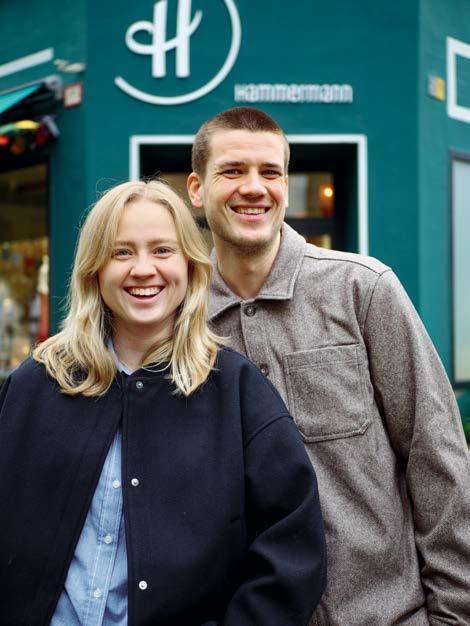

Hammermann Conceptstore
leonie Wolff and her partner Simon faßbender took over the Hammermann Conceptstore in Düsseldorf’s loretto district in spring. it was a bold move, but a logical one.
text: Martina Müllner. Photos: Hammermann Conceptstore
“Fate played a part,” says Leonie Wolff shortly after taking over the store from Karin Hammermann. At the time of initial contact, it was not yet clear that her first job after graduation would yield this opportunity. Yet the new owners and Hammermann were an ideal match from the outset. Wolff’s job, which originally involved Excel expertise, quickly expanded to include her favorite task of purchasing, as well as the back office, sales, and developing social media channels. “Instagram reach is crucial. Even in the Loretto district, we can’t rely on walk-in customers alone.” The amicable relationship meant that the young entrepreneurs were privy to the fact that Hammermann planned to travel the world. “Quite matter-of-factly she told us that we would need to run the store while she’s gone. Naturally, we needed some time to decide. Such a step requires courage,”
Wolff explains. “It would have been unthinkable without family support. Simon comes from an entrepreneurial family, and they really encouraged us.”
Is managing the store is a life-long project? “In line with our motto, we will pursue this project with the utmost passion while it is fun. Karin’s example illustrates that everyone has different stages in life. I’m so impressed by how she has the courage to leave it all behind at 50. I consider her a role model, and our example demonstrates that our generations can benefit from each other.”
What about future plans? “I have hundreds of plans, but my first priority is to prove myself to our regular customers. A store under such hands-on management requires reliability. I would not want to fall into the trap of turning everything upside down and losing loyal customers,” says Wolff. Even the name of the former owner remains on the door, at least for now.
Takeover: 2024
Owners: Leonie Wolff and Simon Faßbender
Brands: among others Emily van den Bergh, Gestalten, JC Sophie, POM Amsterdam, Stetson, White Sand www.hammermann-store.de

it is only logical that the store bears Reyhan lohmüller’s own name. the owner of Rey – the Store exudes personality, be it in the store or during order season.
text: Martina Müllner. Photos: Rey
“Is this cashmere jacket also available 100 Euros cheaper?” is the kind of question that Reyhan “Rey” Lohmüller dares to ask in a showroom. As a lateral entrant into the fashion industry, she shows no undue reverence but articulates her thoughts without hesitation. Bystanders often think: “She is right. For 100 Euros less, that would be a great jacket.” Yet this unfailingly charming directness is just one side of a woman who worked in the industry for years before, after two city trips and visiting many stores, declaring: “I can do better myself.”
After returning home, Rey Lohmüller drew up her business plan and set about implementing it. “I have been passionate about the textile industry all my life, and I have always been curious about what goes on behind the scenes,” says the entrepreneur. After some initial hesitation, she decided to market her shop based on her own personality. “It really took an effort on my part. Only when I convinced myself that I back every piece 100 percent and that nobody can represent it better than I, did things improve. Today, I am delighted by the huge amount of personal encouragement I receive. Customers often know exactly what we featured on Instagram, which is impressive.”
She is just as hands-on in her ordering: “My typical order outfit is something I can quickly throw on over any top,” Rey laughs. She really enjoys cherry-picking from the collections: “I am absolutely convinced that Heilbronn needs a bit more style, a fresh, uninhibited look at international fashion. I am still a beginner, but maybe that is what makes me so professional, because I want to understand things first.” Her combination of gut instinct and life experience makes Rey a role model for many female customers – not only in matters of style.
Rey – the Store, Kirchbrunnenstraße 30, Heilbronn/Germany
Owner: Reyhan Lohmüller
Brands: among others Aeon, Aleo Studio, Barena, Baum & Pferdgarten, Billibi Copenhagen, House of Dagmar, Filodee Atelier, Herskind, Icon Denim, Ivy Oak Stories, JNBY, Nineto9, Raaw Alchemy, Raiine, Susanne Bommer



A personal selection, carefully curated in line with the profile of the store: Rey – the Store surprises with a modern selection of products.

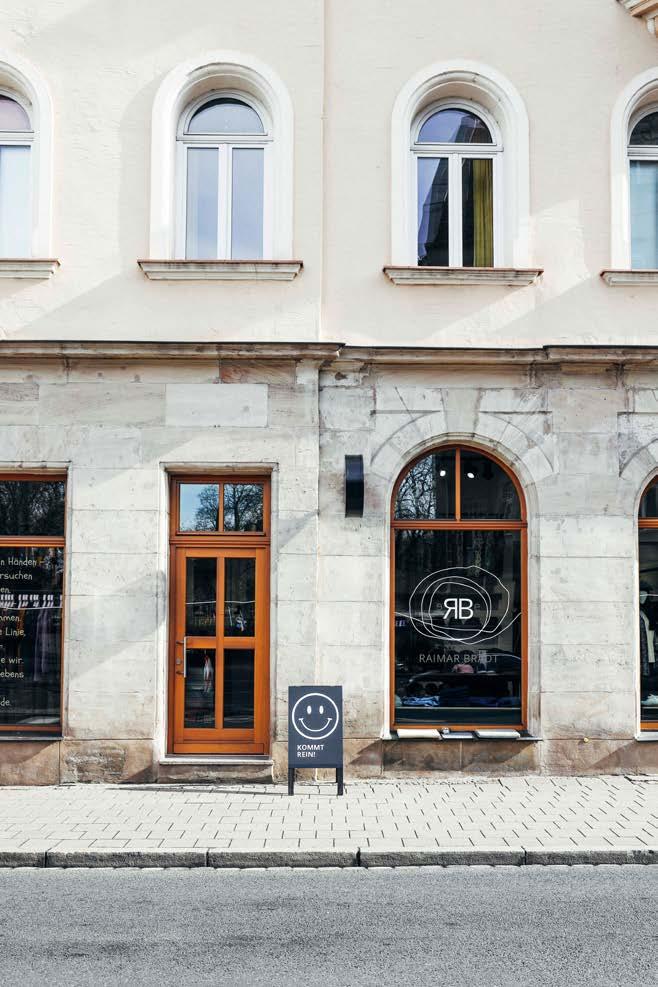
“Hot shit” has become his signature slogan, but the bold statement belies the subtlety of the curated range at eRBe in Fürth.
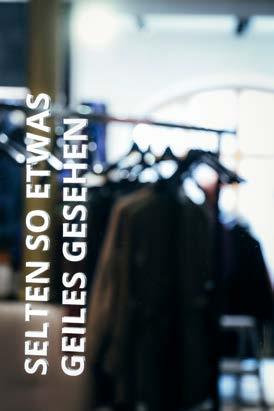
Raimar Bradt/Fürth
Raimar Bradt is no stranger to the community. together with his two business partners, he established Bubeundkönig, but has now moved on to a new city for personal reasons. in fürth, he is now offering “hot shit”. text: Martina Müllner. Photos: Raimar Bradt
“I was impressed that you showed up for work every day,” was how Raimar Bradt’s first mentor, a master tiler, described his apprentice. Yet laying tiles was not enough to satisfy Bradt’s hunger to explore the world. His desire for fashion, which had been simmering beneath the surface, proved stronger than the promise of a secure craftsman career. He tried his luck in Nuremberg, going from fashion store to fashion store, until he found an opportunity at Crämer & Co. “I was invited to work for a day. There I was, proudly standing in front of a G-Star wall, as was state-of-the-art at the time. I picked three styles and promised myself that I would sell them.” Five sold jeans later, the trial had grown into a job – and Bradt had arrived.
Success came with Bubeundkönig. Alongside two business partners, Bradt’s reputation in the industry grew. After the pandemic, he decided to take on a new challenge in Fürth. “Everyone warned me that Fürth was much too small for my range.” Bradt loves these kinds of challenges. When no customers are in the store, he enthusiastically launches into storyteller mode on Instagram. He puts his heart and soul into ensuring the range is regional and tracks down the last artisans of their kind – be it a belt maker, with whom he hosts DIY events at the store, or the last clothing manufacturers to have survived in this once-thriving textile region.
For a small-town niche store, collaboration is virtually mandatory. Personalities, restaurants, and cafés are incorporated into Instagram videos. Attention and reach are shared wherever possible. The break-even point for Bradt is reached when he can support himself and his small family through the store. “I am a man of conviction,” the passionate retailer says. The aspiration lies in the name: eRBe – German for heir – stands for products that can be passed on to the next generation. When Bradt’s young daughter takes to Instagram to invite people to come and buy “hot shit”, you get the idea.
eRBe, Königsstraße 147, Fürth/Germany
Owner: Raimar Bradt
Brands: among others A Kind of Guise, Hiltl, Krill, Merz b. Schwanen, VOR, Zebraham





Studio Drei Punkt Eins/Heilbronn
Opening a menswear store at the age of 60 sounds bold. for Wolfgang frommer, however, it was the only alternative that really made sense. After Palm, his former employer, went out of business, he decided to make a virtue of necessity – and has no regrets whatsoever.
text: Martina Müllner. Photos: Studio Drei Punkt eins
“To be honest, if I had needed to pay for the renovation and shopfitting work myself, it would never have been financially viable.” Wolfgang Frommer attributes the fact that he was in a position to launch his store in November 2023 to fortunate circumstances. “The premises required renovation after water damage, which allowed me to customise the space to my exact specifications. I took over the furniture from Palm, and the suppliers were incredibly accommodating.” He also won a start-up competition organized by the City of Heilbronn. “I thought long and hard about this step, but in the end, I said to myself: it's now or never.” Frommer describes opening a new store at the age of 60 as his early retirement – albeit one that gives him pleasure. “I have no interest in losing money with expensive shopfitting romanticism; I want to focus on sales and enjoying myself.”
As for the range of products, Frommer relies on his experience and contacts: “Drykorn and Profuomo are my primary suppliers, along with classics such as Gran Sasso and Stenströms, as well as a few Scandinavian brands including Scandinavian Edition. I also stock footwear by the likes of Nubikk and IDEight. I refuse to take on low-margin products, even if the brand is well known.” “The store should radiate coolness,” Frommer explains. “I want people to feel comfortable, even if they just drop in for an espresso. Selling is not the only aspect that matters; I strive to connect.” His customers, many of whom he has known for years, appreciate this personal touch. Even the layout of the store reflects Frommer’s concept: “The classic area on the one hand, its more fashionable counterpart on the other. It is a perfect fit.” Despite a promising start, Frommer admits that he still has his doubts: “I sometimes lie in bed at night and wonder if it was all worth it. Yet when I reflect on the positive feedback from customers and suppliers, I know that I am on the right track.” He believes that Heilbronn offers great potential: “There is a gap to be filled here. I feel that customers have been waiting for this kind of concept.”
Studio Drei Punkt Eins, Kirchbrunnenstraße 31, Heilbronn/Germany
Owner: Wolfgang Frommer
Brands: among others Baldessarini, Drykorn, Nubikk, Roy Robson, Scandinavian Edition, Seven Dials
Enrobe
“We
Swiss start-up enrobe is stepping onto the resale stage. What makes this project special is that it is run entirely by loeb AG apprentices. the young team from Biel is pursuing ambitious goals on the department store’s second floor: Sustainability and employee branding complement each other perfectly. text: Martina Müllner. Photos: enrobe
You have put together a wonderful project. How did it come about, Michèle?
Michèle Gottier, CEO Enrobe: The idea originally came from our CEO Ronald Christen. He was attending a conference in New York when he came across a similar project involving apprentices setting up a store independently. He felt so inspired by the idea that he was keen to implement the concept here in Switzerland at Loeb AG. He presented his vision to us in December. We had a lot of questions at the beginning and, to be honest, we had to grow accustomed to the considerable creative freedom. The project grew step by step and the opening finally took place in September 2024.
Is Enrobe deliberately targeted at a younger audience for Loeb AG?
Yes, exactly. Buying second-hand is trendy these days, not least due to flea markets and resellers being promoted by influencers. Our CEO was eager to appeal to a young audience because Loeb tends to attract older customers. Tapping into the young market with Enrobe is a jackpot for us.
Quite a brave step, especially in a department store with a very traditional outlook. Are the young people responding?
To some extent, yes. Many are simply curious about the store and what the project is all about. Yet there is definitely still work to be done in terms of increasing our reach and effectively attracting customers to Biel. We need to advertise more to show that our store is worth visiting.
How important was this opportunity for you personally?
It was an amazing opportunity for me! The fact that I have been entrusted with so much responsibility and gained such valuable experience in only my third year of training is not something I take for granted. I appreciate it immensely, because it allows me to learn and grow independently. It will be a difficult farewell, because my exams start soon. Since Enrobe is run entirely by apprentices, I will drop out of the project thereafter.

Andwell/Innsbruck
the tyrolean capital innsbruck certainly does not lack character. the city is home to an urban ski and snowboard community in winter and exudes a cool vibe in summer, too. it is the ideal culture dish for Andwell, an agency and store located under railway arches. text: Martina Müllner. Photos: Andwell
“We have poured so much personal commitment into this shop,” says Teresa Tanler, who co-founded the Andwell store in the viaduct arches with her partner Michael Baum two years ago. The premises are not merely a salesroom, but also a meeting place for people who combine urban and outdoor fashion as a matter of course. “We used to travel to South Tyrol, Munich, or Nuremberg for shopping, because we simply could not find what we wanted in Innsbruck,” Tanler explains. A little coincidence and a great deal of enthusiasm got them started – at first with a sales agency. Yeti was the first brand they positioned whilst travelling in Austria. Opening their own store was the next logical step.
“Events feature prominently, be it with brands we stock or local partners,” Tanler explains. These events, which range from casual get-togethers to sports-related community runs, have earned the store a devoted customer base. In summer, the terrace in front of Andwell serves as a popular hangout spot. “We prefer to be informal. So, if someone just drops by for a coffee, that is fine with us,” smiles Tanler. “The fact that our team acts like hosts rather than proactive salespeople often bewilders new staff members at first.” Even as a trendy store, it has become more difficult to find staff. “It is definitely easier for the online store and social media,” says Tanler. As for their purchasing strategy, Tanler and Baum are guided by their own lifestyle: “To be honest, we have not yet come across a trade fair that reflects our lifestyle and the store’s brand mix. In fact, we find most brands through our own research or because customers recommend them to us. Our taste evolves constantly, as do our customers. Perhaps one day we will operate without the price limit that is still incredibly important to us right now.”
Andwell, Viaduktbogen 52, Innsbruck/Austria www.andwell.store
Owners: Teresa Tanler, Martin Baum
Brands: among others Big Green Egg, Butcher of Blue, Dawn Denim, Eat Dust, Mazine, Universal Works, Yeti






innovation is key! Matthias
on the challenges and opportunities for his company in a radically changing market.
Last December, you received an ISPO Award on behalf of Mey. For what, exactly? Please tell us.
Matthias Mey, CEO Mey: The ISPO Award 2024 winner is our Base Layer from the Prfrmnc+ series. This product excels in moisture management. During demanding ski or hiking tours in cold conditions, the combination of materials we use is unparalleled. Everyone knows the feeling: you’re climbing with a backpack, sweating, and your back gets wet. Then, during the descent, you feel chilled. Our product solves that problem. It can absorb a significant amount of moisture, so you can stay dry on the inside. It’s the perfect companion for ski tours or active skiing.
Is innovation a key strategy for Mey to remain relevant in such a highly competitive market?
Innovation is at the heart of our company’s philosophy and has always shaped Mey. Interestingly, the innovation we’ve applied to the back panel of our Base Layer is based on a fabric my father developed 20 years ago. I recently rediscovered it, improved its quality, and re-imagined it with a new material mix and context. Staying relevant means offering consumers solutions – even for problems they weren’t fully aware of before. This drive for innovation continually inspires us.
Can you share more examples of how Mey has implemented innovations in product design, materials, or processes to stay ahead of the curve?
We are constantly bringing innovations to market, such as Softball, a men’s short with a specially developed jockstrap for the ultimate fit, or the ‘Drunterhemd’, a functional vest that is invisible under white business shirts. There’s also the Spacer Bra—one of the finest T-shirt bras: breathable, invisible. The Spacer Bra innovation, which we branded a little tongue-in-cheek as “Blusenwunder” in 2015, was a breakthrough in the lingerie segment. It played a significant role in establishing us as one of the leading lingerie brands in the DACH and Benelux regions. A validation of our innovative strength is that we often face copycat products—a true acknowledgment of our pioneering role and relevance in the market.
The market is undergoing profound changes – from supply chain disruptions to a new generation of consumers with different expectations. Where do you see your company heading amid these challenges and opportunities?
This transformation is unmistakable. In all my years in the industry, I’ve never witnessed such a comprehensive upheaval. The critical question for us is: how do we stay relevant? Our strong brand is a significant advantage, characterized by unique selling points and a broad, loyal customer base. Ultimately, it’s about clear brand positioning: what do we stand for? What makes us unique? Why are our customers willing to pay for our products? And how do we justify our prices in a market with dominant vertical brands? These questions drive us and push us to keep evolving. Our success stems from an unwavering commitment to quality—perfect fits, durability, and timeless products. We aim to create “favorite pieces,” the go-to items in our customers’ wardrobes. That’s our standard. Additionally, our claim, “seriously sexy underwear,” helps us stand out across various product lines with bold, fashionable accents. This positioning has significantly contributed to our success over the years. While sustainability isn’t yet a deciding factor for many consumers, few companies can match our transparent, fully integrated production in Germany and Europe. Despite limited political support for such efforts, we remain steadfast in our approach. For us, sustainability is not a trend but a fundamental principle rooted in our philosophy, shaping our daily decisions and actions.
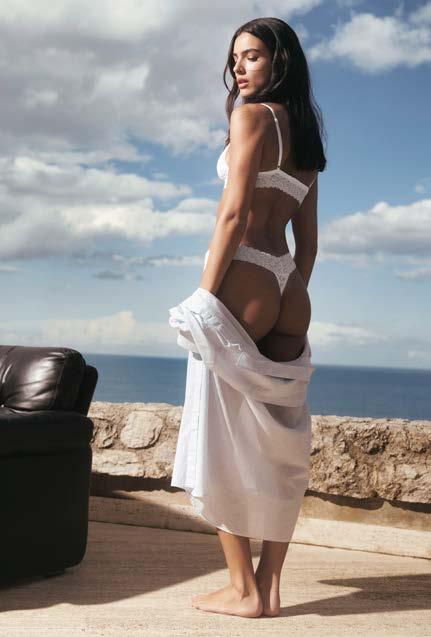
Seriously Sexy Underwear! Mey's successful path into the future is built on innovation and an unwavering commitment to quality.

The fashion world covers a lot of ground – from the hard edged masculinity of streetborn brands to the blurred lines of gender fluidity. Somewhere in between, a new image of masculinity is emerging, for which fashion is more important than ever in shaping identity.



flexibility, comfort and a willingness to experiment have revolutionized menswear. the clear distinction between formal and streetwear is becoming increasingly blurred, old norms are giving way to a new openness. the result is a new overall concept for menswear that prioritizes personal expression above everything else.
text: Janaina engelmann-Brothánek. Photos: Brands

“Customers are increasingly keen on timeless pieces that can be worn in a variety of ways.”
–
Gennaro Dargenio, CeO and founder of Circolo 1901
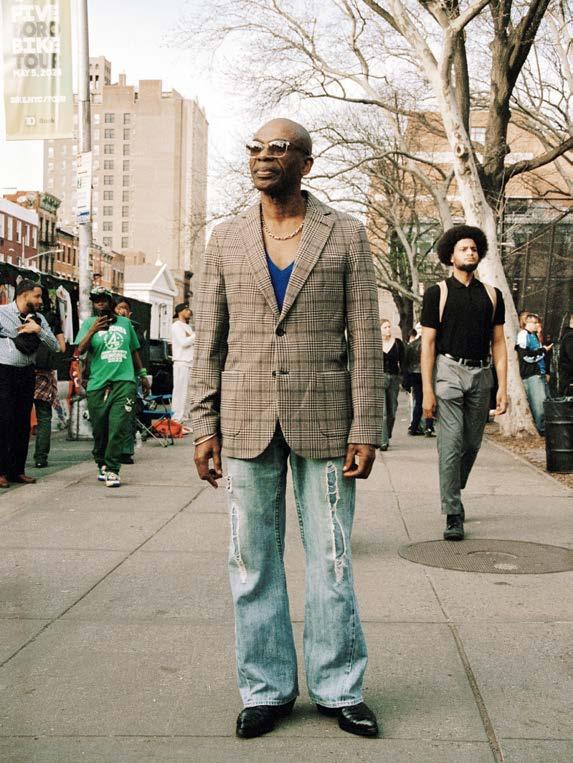
highlight look from
MMore than ever, fashion is an expression of individual freedom; the rigid mold of social expectations has cracked. Men are abandoning traditional etiquette and blending styles – a shift that women’s fashion has long embraced. The role of the sports jacket is a prime example. While still a staple of men’s fashion, it is no longer a mere marker of formal elegance. It now lends sophistication to a look without feeling too heavy or formal. The classic suit, once the defining piece of a man’s wardrobe, is being replaced by more dynamic ensembles: relaxed wide-leg pants, often double-breasted oversized jackets, and t-shirts that replace the classic shirt. These new looks reflect a modern, easy-going aesthetic that also appeals to Millennials and Gen Z.
“The classic look has not evolved – it is stuck in a narrow, traditional aesthetic,” says Massimiliano Giannelli, founder and owner of Société Anonyme of Florence. Marino Edelmann of Strellson shares this view: “Even we, who are primarily known as a suit brand, have to admit that the classic blue banker’s suit no longer holds the same relevance as it did ten years ago, when it was considered a uniform
and an obligation for many men in their everyday lives.” Suits still matter, but they are now mostly associated with special occasions like weddings. “Today, it is perfectly fine to wear wool pants and a polo shirt to the office,” Edelmann adds. This shift is a direct result of the rising acceptance of street style elements in menswear. Antonio Longo of Marcona3 also emphasizes: “It took breaking down rigid conventions of formal wear to create something new.” Gennaro Dargenio, owner of Circolo 1901, adds: “The formal side of the wardrobe has become outdated. For us, the challenge was to create a jacket for those who normally would not wear one. Our Easy Jacket combines a classic cut with unconventional jersey or sweat fabrics.”
The iconic Virgil Abloh may have revolutionised menswear more than he himself intended or realised. For Antonio Longo, Abloh’s influence as the creative head of Off-White and mastermind behind Louis Vuitton collections stands out in particular: “We met Virgil as a client in our showroom when he was still running RSVP in Chicago. As an architect, he brought a unique perspective to fashion, creating a new understanding of the blend between street culture and high fashion.” Yet this fusion ultimately led to an elitization of streetwear, a development that Abloh criticised as early as


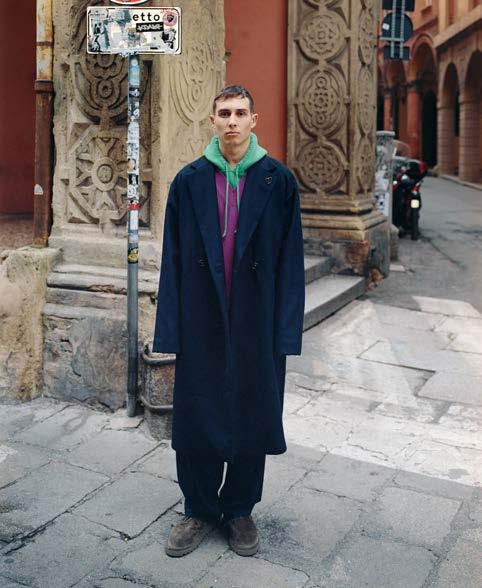

2017. “Virgil wanted fashion to be accessible for the people on the streets,” Longo notes. Initially, Off-White t-shirts priced afforably between 49 and 59 Euros reflected this spirit. But over time, prices rose. In an interview with Dazed, Abloh predicted the death of streetwear as a victim of its own success, trapped in an oversaturated market.
The breakdown of traditional categories not only affects classic menswear, but also streetwear. For legacy brands like Bugatti, the challenge is to integrate modern influences while preserving brand identity. Bugatti CBO Florian Wortmann describes the shift: “We no longer cluster by age, target group, or occasion, but by emotions. We aim to gently provoke and occassionally jolt our customers with style updates.”
Streetstyle has not only influenced the aesthetics of fashion, but has also empowered men to approach their wardrobe with more confidence. “Men have become bolder in expressing themselves through their clothing style. This is a direct result of inspiration from urban cultures and streetwear.

“the colors we are selling would have been unimaginable three or four years ago.”
– Marino edelmann, Managing Brand Director Strellson

“everything is becoming wider. especially in times like these, people are always looking for more freedom. And that is reflected in the clothing.”
– florian Wortmann, Chief Brand Officer Bugatti
Social media and youth culture have fundamentally transformed men’s relationship with fashion. It is no longer about the suit or shirt alone, but how these pieces are styled together,” says Marino Edelmann of Strellson, adressing the creative freedom his customers express through fashion.
While the classic style runs the risk of being perceived as overly conservative and inflexible, streetwear – without stylistic developments – risks being confined to its subcultural niche. The merge brings evolution to both: classic looks become more contemporary, while streetwear gains in aestethic elegance. “Our goal is to blend comfort and style, so every generation can authentically express its stance,” says Gennaro Dargenio.
The merge sounds like a balancing act, especially for classic menswear brands. “The biggest challenge is to avoid watering down your brand DNA, but instead to continue developing it gently while maintaining authenticity,” says Florian Wortmann. The resurgence of 1990s aesthetics presents, as Wortmann notes, an opportunity to modernize collections while retaining excitement. Marino Edelmann of

Strellson echoes this need for a strategic approach to fashion design, adapting trends as needed: “You need to distinguish between your playing field and your revenue, as well as between your brand’s added value for retail partners and end customers,” he argues.
The pricing gap between fast fashion and luxury is widening, leaving many brands in the middle struggling to maintain their position. “Customers are becoming more price-sensitive,” notes Antonio Longo. “In a volatile market, they seek alternatives that are stylish yet affordable.” Massimiliano Giannelli also criticizes the confusion caused by extreme price differences: “I cannot understand how a quality pair of pants can be produced for 12.90 Euros. It is simply not possible.”
All these challenges bring about new opportunities for menswear: a chance to reinvent itself, reach new customers, and broaden creative horizons. Both new and traditional brands stand to benefit. A sticking point remains the increasing price sensitivity of consumers who, now better informed than ever, radically juxtapose quality and affordability. “The consumer demands quality, personality, comfort, style, and fair pricing – qualities that are, now more than ever, essential,” argues Gennaro Dargenio of Circolo 1901.


“fashion should represent us, reflect who we are. it is important that we return to enjoying the game of fashion.”
– Massimiliano Giannelli, founder and owner of Société Anonyme



of styles as a positive enrichment of the market.
“THE
Is the sports jacket still a central menswear element?
elvis Giglione, owner of elvis fashion Agency: Yes, it is, and it has even gained in importance by utilizing new materials and structures. today, sports jackets are made of innovative, technical materials that emphasise both athletic and functional aspects. lightweight structures offer modern comfort that reflects the zeitgeist. in the formal sector, we are observing an increasing influence from streetwear, which creates a more athletic look. How is streetwear specifically influencing the development of formal menswear?
Streetwear is definitely here to stay. it introduces fresh approaches, creates new fabric types, and adds more relaxed silhouettes that invigorate and modernize the segment. the sportswear spirit is inspiring brands to develop more innovative and less traditional designs. So, it isn’t a passing trend?
the streetwear aesthetic is much more than just a trend. it is an integral element of menswear. even if classic formal fashion retains its presence and the need for dressy styles remains, there is room for new interpretations and innovative concepts.

Fattore K House
Which trends are shaping today’s menswear?
Gianni Klemera, CeO fattore K House: formal and streetwear have evolved into hybrid looks over the past decade, integrating heritage, workwear, and sportswear. Asian influences, pop culture, and social media have accelerated this shift. Men now switch flexibly between formal, athletic, and outdoor styles – the classic or sporty type no longer exists in pure form, and the willingness to experiment has increased significantly. How is this change affecting retailers and agencies?
We have expanded our portfolio because modern retailers are much more versatile. Mix-and-match dictates the presentation – different styles and age groups are combined. Personalized advice is back in demand, which is why instore retailing is gaining in importance. What developments are emerging?
Quality remains the focus. Sneakers are giving way to loafers and boots, while outdoor-inspired styles are creating new momentum. Accessories such as belts and bags are also experiencing a revival. loud branding is declining in popularity – customers are increasingly opting for durable, high-quality products.



Diktat
It is relatively easy to offer a luxurious product at a high price. The challenge lies in offering a luxurious product at an affordable price. This is precisely the strength of Diktat, as Francesco Bosso explains.
interview: Nicoletta Schaper. Photos: Diktat
Francesco, what makes Diktat unique?
francesco Bosso, CeO Al.Ma.tes: Our collection offers sporty yet elegant men’s knitwear that appeals to a broad audience. innovation drives our design, shapes, and materials, the latter of which we frequently develop in collaboration with manufacturers. Our objective is to make luxury affordable. that is the more challenging task, and thanks to 30 years of expertise in manufacturing and seamless quality control from the raw material to the finished product, we are now in a position to strike a balance between quality and price.
The brand is only four years old. How has the company developed?
We realigned our strategy in 2022 with the founding of Al.Ma. tes. Diktat is our flagship brand, complemented by entre Amis pants and Della Ciana cashmere. i am particularly proud of the fact that my sons have joined the company. Nicola is responsible for sales and administration, Giovanni for design and production. Collectively, we have modernized the collection and strategy, resulting in a 50 percent increase in sales per season over the past two years.
Now the focus has shifted to international expansion. We have expanded our network in northern europe and are launching in Germany, Sweden, Denmark, Poland, and Belgium. Germany is a key market for us, where we have teamed up with the Connecting Peoples Agency and Peter Nürnberger. together, we are highly confident that Diktat will be a success there, too. You once said: “We are a lucky company”. What does that mean?
i am delighted that my sons are leading the company forward into the next generation. Yet luck is no coincidence. We invest strategically in products, structures, and sales. What else distinguishes the Diktat collection? in our Second Skin capsule, we combine wool and technology. this line already accounts for 50 percent of our sales. this is how we reconcile tradition and innovation - through expertise and, almost more importantly, passion. You need both to do our job!

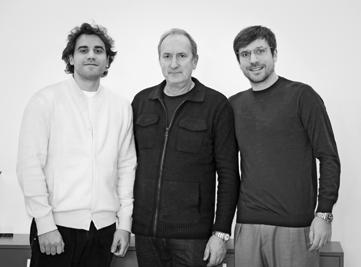

What does the current vision of 04651 Trip in a Bag entail?
ilaria Gori, Sales & Marketing Manager: founded by lars Braun ten years ago, 04651 trip in a Bag provides high-quality essentials that fit neatly into a travel bag. Our vision is to establish the bag as a symbol of a dynamic lifestyle for the stylishly dressed man. What are your strategic priorities?
We are targeting a clear positioning in the luxury segment, particularly in resorts and spas. With this in mind, we are expanding our network with pop-up stores and venturing into new markets such as Japan and Scandinavia. We also plan to expand our network of 45 outlets in the DACH region. What makes 04651 unique, and where is the journey headed in the long term?
04651 combines quality, style, and flexibility. in the long term, we intend to grow in europe, Asia, and the United States, with a focus on exclusive department stores. through our high-society brand ambassadors, we convey our message of an elegant travel style.
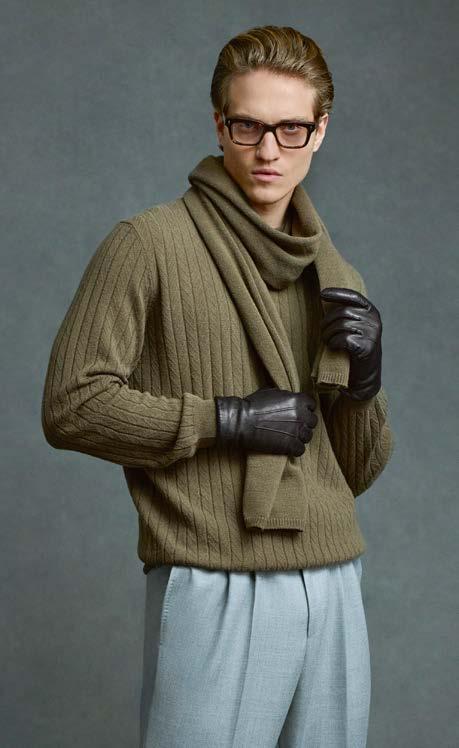

The menswear revolution has also impacted Dressler. Rebranding, a new logo, and modernity – what is your key focus for the 95th anniversary?
Christian fenske, Head of Design Dressler: the anniversary presents us with an opportunity to look back proudly on our company history while also looking ahead to the future with fresh vigor. the changes not only demonstrate our capacity for innovation, but also pay homage to our long history. We combine the timeless elegance for which we are known with modern elements to appeal to both our loyal customers and new target groups. Is “affordable luxury” gaining importance as a core philosophy?
in today’s fast-paced world, the fashion industry is undergoing an exciting transformation. the desire for “affordable luxury” is growing steadily, and for good reason. An increasing number of people are looking to balance quality and price – they seek real value for their money. this is precisely our philosophy. Our customers not only buy clothing from us, but also experience a sense of appreciation and style.
How are you, as a formal wear specialist, implementing the hybrid look trend?
Our latest collections have shown that hybrid looks are steadily gaining in relevance. We are delighted that Dressler is part of this trend. High-quality materials combined with modern designs create a look that reinterprets classic style. this interface between tradition and modernity is an obvious and exciting opportunity for us to fuse the elegance of formal wear with a modern twist.
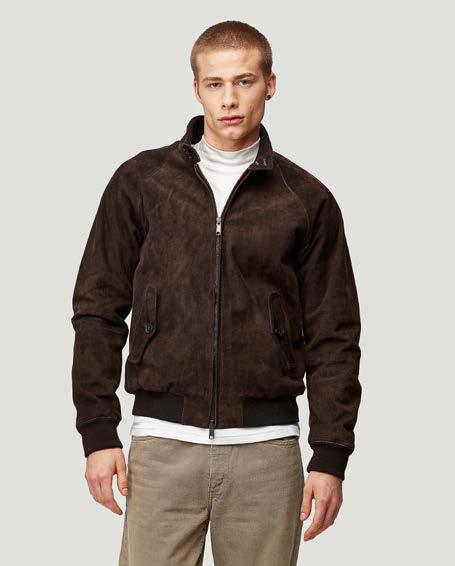
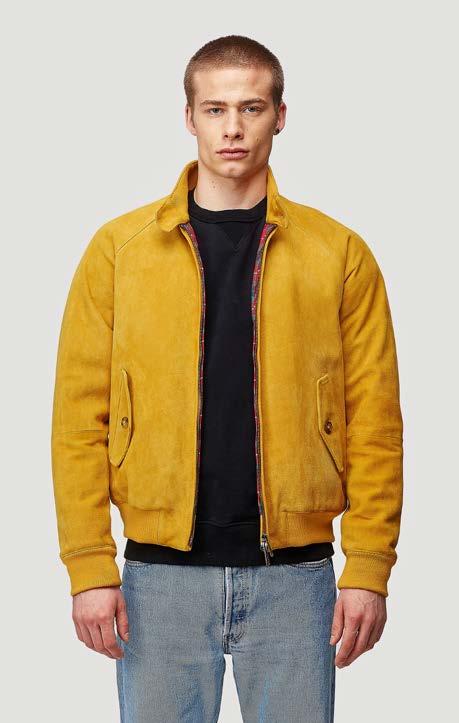

Baracuta
the new Baracuta collection encapsulates the true essence of Britishness – and surprises with the new G18 jacket. the latter impresses with its sleek silhouette, combining classic Baracuta aesthetics with contemporary elegance. the iconic G9 model remains a pivotal element and is available in new colors, without compromising its timeless character and versatility. the collection is complemented by two new wax jackets: the Mods Parka made of British Millerain is perfect for cold winter days, while the compact Deck Jacket combines functionality with rugged elegance. in its third year, the Barbour collaboration yields an exclusive wax cotton collection. it now debuts women’s styles, inspired by the music and movements of the Northern Soul era. Another highlight is the redesigned tartan, based on the classic fraser tartan. this traditional pattern is featured in key pieces such as the Pinnacle Mods and combines Baracuta’s heritage with modern style to create a contemporary look.


The growth strategy of German label Prohibited was TikTok first. Today, the brand bridges the gap between retailers – such as Dodenhof, Kult, L&T, and Leffers – and its own community. Photos: AnnikaYanura
Why is Prohibited more than just the next D2C brand?
Philip Krause, co-founder of Prohibited: We stumbled right into it, without a grand master plan. in 2024, for example, we presented our brand at the Katag Brand Day and these retailers responded with great curiosity.
Are you flirting with the fact that there was no master plan? Naturally, we take our work seriously. Our growth on tiktok is no coincidence. We have specialized and accumulated knowledge. As a result, the brand has grown to a seven-digit turnover. We will soon reach eight figures and have struck an excellent balance between passion and commercial success. Our aim remains to make the best sweater for 70 euros. What makes Prohibited different?
We were fed up with the gangster bubble that many German D2C brands seem to be stuck in. fast money, fast cars, everything dark – that’s not us. ever since we abandoned that aesthetic, Prohibited has been performing excellently. We champion oversized and streetwear pieces infused with sportswear and old-money aesthetics.
As an online-driven brand, you possess a great deal of knowledge about your customers. What makes them tick? Our data shows that we cater to a broad range of customers. there is no generalisation; each customer is an individual case. that’s why it’s more important than ever to take a detailed interest in your customers.
Do you lose credibility within your established community when you suddenly start serving 180 retailers in Germany? i think the secret lies in the term suddenly. Given that we are developing our sales network with our own resources, we are organically adding one retailer after another. Our customers consider it a service to be able to visit a local retailer and actually experience the products up close.
Is that your promise: to guarantee the target group? Definitely, although we’re far from complacent. it still gives us a real buzz to be stocked by a new retailer. www.prohibited.shop



Always on point:
“fashion is so much more than just clothing – it is an expression of attitude,” explains Hajo Strick Managing Director Wolfgang Müller. tom Ripley takes that philosophy literally: With the autumn/winter collection 2025/26, the brand delivers an interpretation of retro chic firmly rooted in the here and now. the aesthetics of the 1950s, in all their sophistication and timeless clarity, serve as inspiration. Yet nostalgia is not the only factor at play. the collection thrives on contrasts: warm sepia tones such as beige and ecru meet the cool gray and deep navy blue of the black-and-white cinema world. “every piece tells a story – not loudly, but subtly. this is precisely what lends this line its charm,” says Müller.
tom Ripley offers a collection with added value for specialist retailers. timeless knit overshirts in the style of field jackets, versatile cardigans, and reimagined essentials such as the cricket jumper appeal to a discerning and mindful consumer base. “these pieces are intended for men who know what they want: Hgh-quality materials, perfect workmanship, and enduring style,” emphasizes Müller.
Manufacturing takes place exclusively in italy, in factories with decades of craftsmanship tradition. Natural materials such as merino wool and cashmere are combined with modern finishing techniques that guarantee comfort and functionality. www.tom-ripley.com
With 30 different models, Tom Ripley offers a selection that can be combined all year round.
the new tagliatore collection by creative director Pino lerario pairs timeless elegance with modern comfort. inspired by lerario’s travels, the designs feature premium fabrics such as cashmere, silk, and mohair. Jackets with stand-up collars exude minimalist sophistication, while oversized coats and soft silhouettes characterize the relaxed style of the collection. Classic patterns, such as glen plaid and tartan, are presented in a color palette of olive green, burgundy, chocolate brown, and orange highlights. With the Pino lerario tagliatore capsule line, the label introduces a modern vision of masculine elegance – versatile, contemporary and unmistakably Made in italy.
www.tagliatore.com




























































“STREETWEAR HAS OPENED MANY DOORS”

“I
A dedicated TikTok channel is just one of the surprises that Lars Braun has in store for us. As CEO of Braun Hamburg, he is the defining figure of men’s fashion in Germany. When it comes to the influence of streetwear in this market segment, his opinion is indispensable. A conversation about sneakers, authenticity, price – and ties.
text: Janaina engelmann-Brothánek. Photos: Braun Hamburg
Let’s broach the issue head on. How has menswear evolved in recent years?
Lars Braun, CEO Braun Hamburg: It has changed a great deal. However, this is being perceived as more pronounced than it actually is. Sure, we have many innovative designers and strong trends out there, but I doubt whether the typical end consumer is introducing all these innovations into his wardrobe. Yet new products such as broken suits, shirt jackets, short jackets, and wide-legged jeans have revolutionized the menswear segment to a certain extent, that much is true.
As a formal menswear authority, can Braun afford to ignore the streetwear topic?
I cannot ignore it, and I do not intend to. I believe it is essential to view this development through your own lens, and to carefully curate your range accordingly. Some retailers tend to lose touch with their customers by thoughtlessly adopting every trend. This is not a healthy approach. Streetwear has opened many doors, enabling the look to find its place in formal settings. The success of e-commerce is definitely based on casualization.
How high is the proportion of online sales at Braun Hamburg?
Right now, about two-thirds of our sales revenue stems from online retail. This requires us
to curate our range carefully to avoid including items that may not suit our style.
Have certain brands reached must-have status?
Absolutely. Brands like Moose Knuckles and Maison Kitsuné, for example. In the past, I would have found it difficult to get used to the idea of selling trainers by brands like Golden Goose. I would also never have imagined that the high-quality shoe business, which once flourished, could be reduced to what it is today. Although it is challenging, we have quickly adapted to the new scenario.
Which products and looks are emblematic of the fusion of streetwear and formalwear?
I think that sneakers are among the most successful examples of this fusion. We are not talking about extravagant bouncer sneakers by Balenciaga, but about a look that is elegant even in combination with sports shoes. Jackets featuring drawstrings are another interesting trend, lending an innovative and technical touch. This mix of styles is primarily rooted in the hip-hop and street culture of the 1990s.
Which brand?
Difficult question. Maybe Stone Island. They are positioned somewhere between streetwear and workwear, backed by meaningful heritage.
“The success of e-commerce is definitely based on casualisation.”

“This is more about an evolution towards a stylish, functional, and comfortable look that combines different influences.”
Very few brands have managed to establish such a strong transversal identity. They have also understood the importance of gender. Lots of women wear Stone Island. The look is really interesting.
How do you leverage social media to communicate with customers?
Traditionally, our customer has relied on our service, but now they are extremely well prepared when they visit us. They are familiar with the brands, the latest collaborations, and the trends on social media. This forces us to keep our team ahead of the curve and responsive to the needs of a rapidly evolving market. We know how important it is to maintain relevance. Our e-commerce business is very well established, and in the future we will also (have to) launch a channel on TikTok.
Speaking of Tiktok. What is your take on grandpa style?
The grandpa look is making a huge comeback – and with it the tie, waistcoat, and suit. What is particularly exciting is that such trends are increasingly transforming ties and suits from a necessity into a style choice. Take ties, for example. They are still worn, but more for pleasure than out of necessity. The same goes for accessories like pocket squares. Cufflinks, on the other hand, are really outdated.
Via TikTok, you reach a clientele that is very price-sensitive. How do you account for that?

Finding the right price is a real challenge. It has, simply put, increased too much. A cashmere sweater for 1,200 Euros is simply not tenable. Our goal is to offer quality products at reasonable prices. A good cashmere sweater should cost between 300 and 400 Euros, a high-quality shirt no more than 170 Euros. If some brands fail to adapt to these price levels, we will be forced to implement more of our own collections – we have the expertise and means to do so.
As so often, the key is striking the right balance – in terms of style too?
Naturally. I think a comeback of rigid, tight clothing styles is unlikely, as is the abundance of hoodies and sneakers that has prevailed in recent years. Instead, this is more about an evolution towards a stylish, functional, and comfortable look that combines different influences. Braun Hamburg intends to actively support this change by offering products that reflect this progress.




Showroom Kleinmachnow / Hamburg / Munich / Düsseldorf
Tel.: 030 60031330
E-Mail: info@prins-juric.com
www.sorenahandmade.com
literally embedded in the vibrant retail and hospitality conglomerate Signal in the art district of los Angeles, you will find the concept store Departemento. But only if you go through the coffee bar Concierge Coffee. the store inside the building has no shop windows. it is one of the best-kept secrets of the Californian menswear avant-garde, which reopened in summer 2024 after renovation.
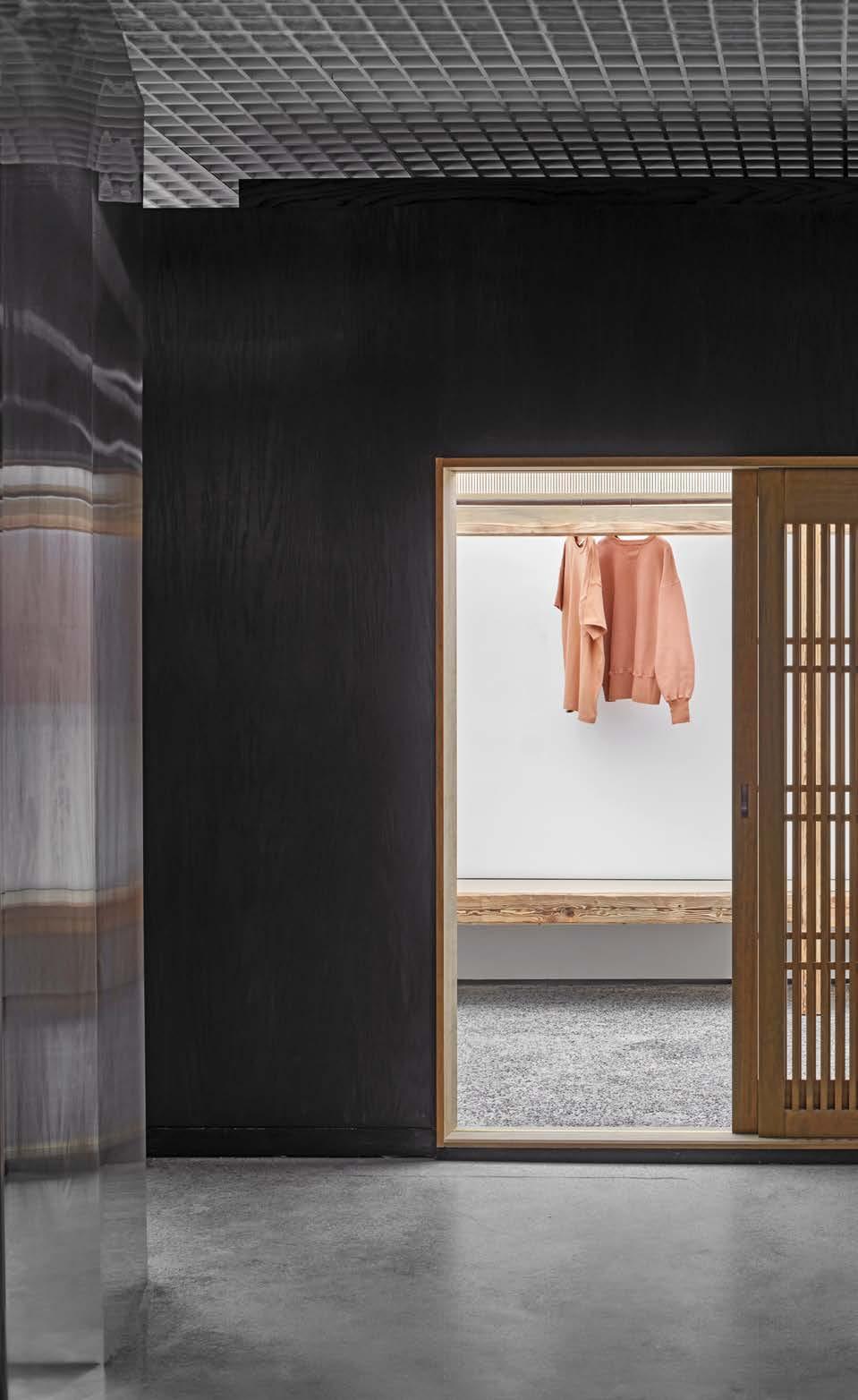
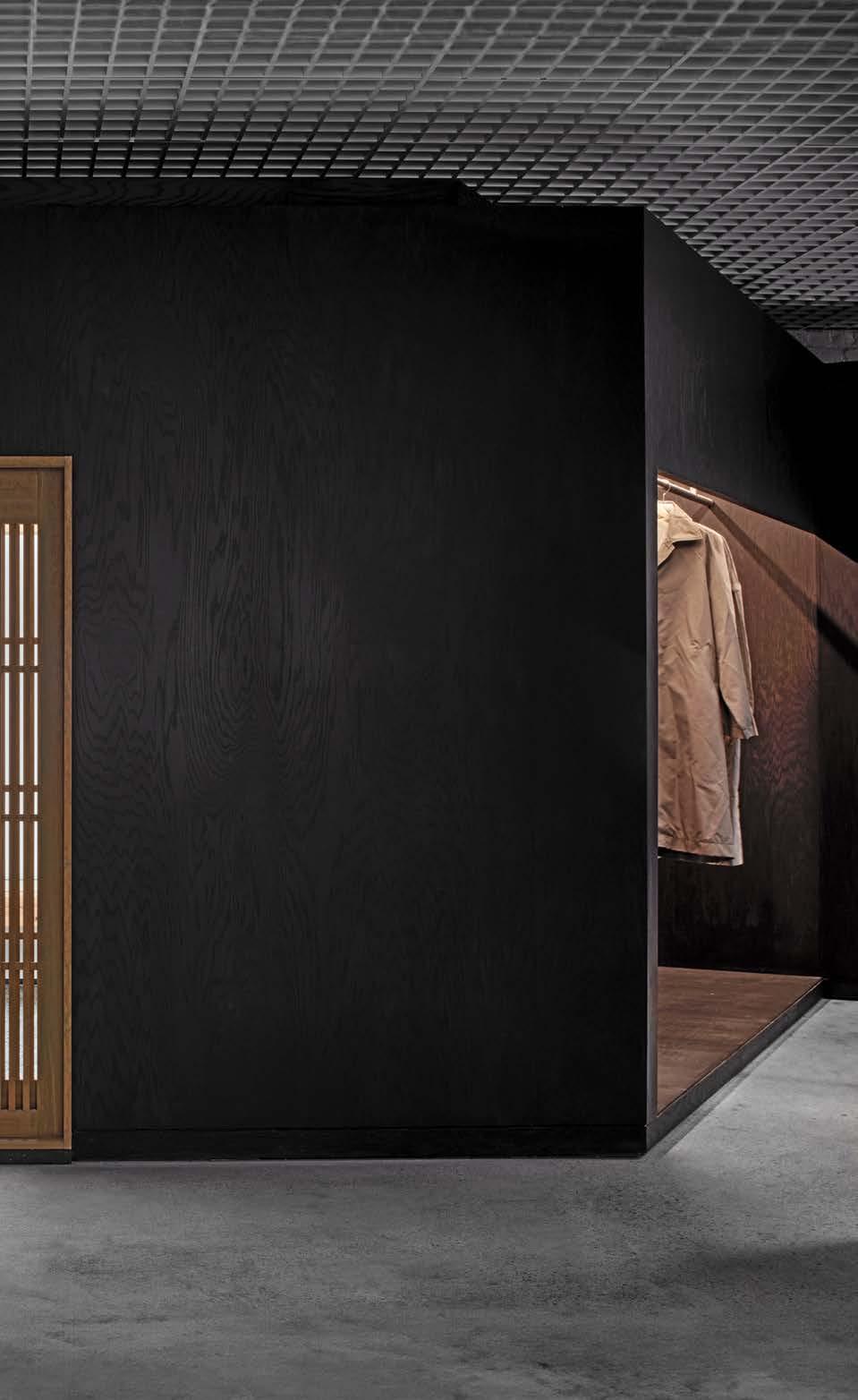
for some time now, streetwear and contemporary menswear stores have been cultivating a new attitude. they are emblematic of the substantive and visual evolution of a fashion segment that has emerged from the sneaker and t-shirt corner. Japanese and US aesthetics are particularly influential here, making use of tidy styles, sartorial references and many nods to traditional menswear. following brands like fear of God, the Nerdys or Honor the Gift through the line-up of their stockists reveals a completely new image of contemporary menswear stores. text: isabel faiss. Photos: Stores

Signal 2023 is a multidisciplinary cluster in the middle of the los Angeles art scene, featuring trendy store concepts, restaurants and bars in an overall architectural concept. Anyone who finds Departemento in this cluster enters a kind of art gallery. Photos: eric Stackpole, Undehn, Spencer lowell
Andrew Dryden and Joseph Quiñones are countering the Californian penchant for sporty casual looks that is deeply rooted in their DNA with an international, carefully curated and extraordinary alternative. they opened Departemento back in 2017 as a creative space for their styling service. the insider tip quickly became a multi-channel business with an online store, retail space and a styling service.
Departemento not only embraces diversity in its overall image, but also in its range. Brands such as enfants Riche Déprimés, the Row, Maison Margiela and Martine Rose are casually hung alongside pieces by lanvin, Zegna and Jil Sander. At the end of September, the second location, DPtO:ANNeX, reopened after renovations. this branch sells discounted pieces from previous collections. www.dpto.la
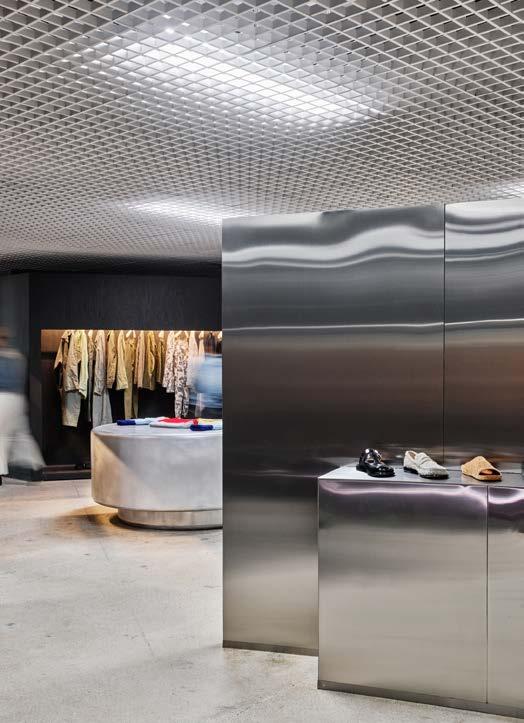
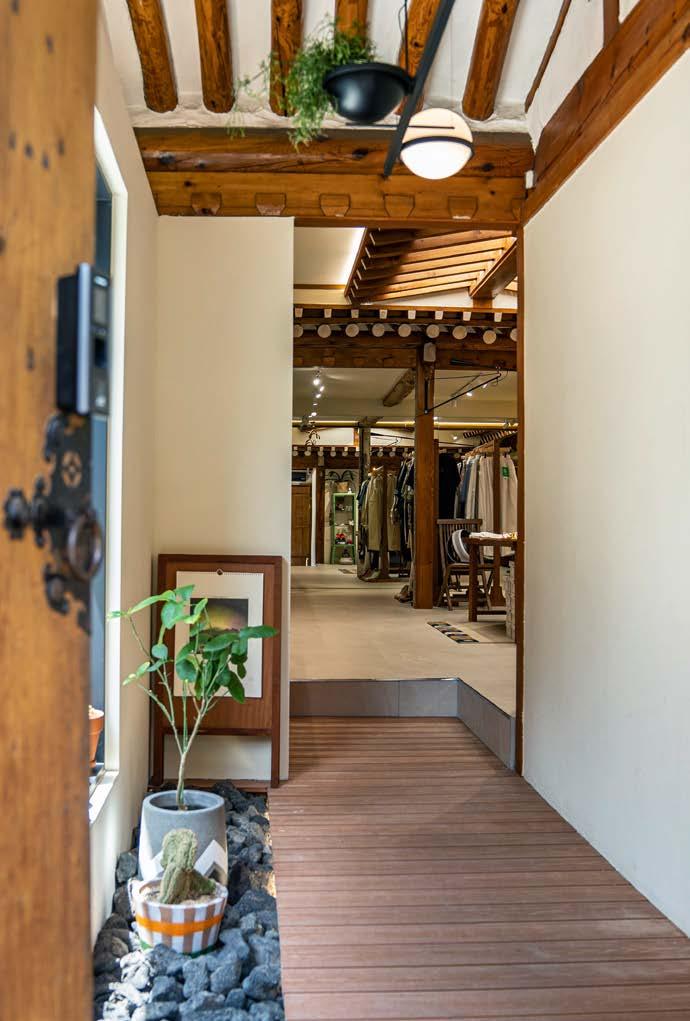
The mix captures the zeitgeist: brands that immediately catch the eye at SomeOneLife in Seoul include Porter Classic, TooGood, Anachronom, The Nerdys, MOIF and Riding High.

Kim Gangmin from South Korea is a born networker and, as an industry professional, deeply rooted in the fashion scene. He started out as a buyer for the Beams store in Harajuku, a district of tokyo, where the idea of his own store first came to him. He is currently not only the owner of the SomeOnelife store in Seoul, but also the designer of streetwear brand Darenimo and the mastermind behind the Nike x PeaceMinusOne pop-up store in Seoul. He launched his own brand, Palette Color Research, in fall 2024. He mentions his own art exhibition House by Kim Gangmin in passing. On his instagram channel @ssomeone.life, he takes his fans with him into his everyday life as a creative jack-of-all-trades. www.someone-life.com



“Progressive independent Clothing Store” is how tim Mctavish sums up the factor that makes his menswear store in Manchester a boost for the image of the labels listed there. He was largely inspired by business trips to Japan, which showed him how much potential there is in a carefully balanced niche.
those who shop here benefit from a very loyal and rapidly growing core target group that celebrates urban outerwear and pared-down street styles. With brands like Goldwin, Homespun Knitwear, Mizuno, Norbit, and Mountain Research, it quickly becomes clear where this thing Of Ours, a store that’s unusual for Manchester, wants to be heading. the community meets here regularly for special events centered around brands like Gander. these events and their deep roots in the community have quickly made this thing Of Ours a port of call for fans from around the world, who are closely networked on social media, despite the store’s niche existence. www. thisthingofours.co.uk
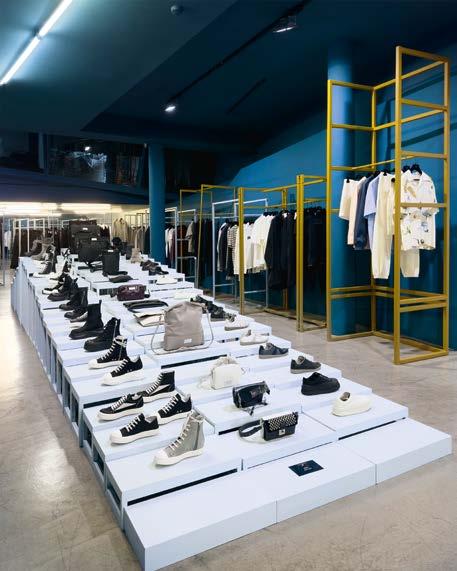
João Pedro Vasconcelos has been constantly developing his concept for Wrong Weather since 2009. With his store, that he opened in a former parking garage in the heart of Porto’s shopping district and near famous concert hall Casa da Música by star architect Rem Koolhaas, he set new standards in domestic menswear retail.
in 2017, Wrong Weather life, a younger, more progressive brand selection, moved in as a direct neighbor on Avenida de Boavista. the final step was the addition of an in-house art gallery to round off the concept. By defining an area in Wrong Weather life as a pop-up corner where local and international new brands and artists can present themselves to his selected clientele, Vasconcelos prescribed a constant self-injected shot of freshness to himself and his store team. Brands such as Davii, Rhude, Harmony Hustlers and Pace have already taken advantage of the opportunity to present themselves in this high-quality space, alongside collections from brands such as A Cold Wall, inbetweeners, Off-White, Kenzo, Vetements, Polo Ralph lauren and Y-3. www.wrongweather.net

The
Fish Market/New York City
“WE ALL HAVE LIED ABOUT HOW BIG OUR FISH IS”
A fresh idea for summer 2024: CeO Vinod Kasturi and the creative team around cult brand Market, founded by Mike Cherman, enriched downtown New York with yet another illustrious location. fish Market was a community meeting place, art platform and event space in one – and then moved on to the famous Musinsa Concept Store in Seoul as a pop-up shop.
fish Market was made to be different. in collaboration with artist Gustavo Barroso, a store was created featuring an oversized Bigfoot figure and artificial hunting trophies, peppered with visual quotes from the famous American store chain Bass pro Shops, a chain of specialist stores for outdoor activities. A separate area of the store, accessible only with a password, was also given over to the brand Secret Club and was only open to newsletter subscribers. However, fans of the brand could not only hunt for exclusive Market and Secret Club products, but also for collaborations with local brands such as iggy NYC, frog Radio Caps, towndust, father figure or Nations fC only NY. www.marketstudios.com


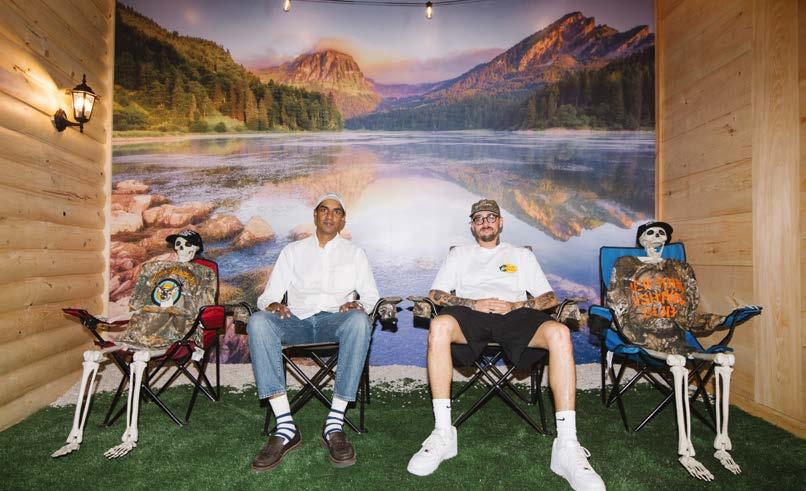
“We all have lied about how big our fish is.” With this slogan, Vinod Kasturi (left) and Mike Cherman welcomed their customers at the door. Their brand, Market, stands for an unconventional fusion of music, fashion and zeitgeist. The two founders traditionally approach this claim with a great sense of humor.

they present their vision of Japanese-American preppy chic in their selection. Club luminaries is the further development of menswear store the Decorum, the sidekick for streetwear and street culture.
What makes Club luminaries very unique is its location. in the middle of the bustling city center, the store concept seems so international that it could be in New York, tokyo or los Angeles. But it is in Bangkok. the casual old-school streetwear look represents the twist between the aesthetics of the 1980s and 1990s and completely new, young brands. it makes Club luminaries the hipster hotspot for a community that styles itself using iconic brands such as thisisneverthat, Universal Overall, CRt-Jeans, Drôle de Monsieur and Knickerbocker. the result is a combination of relaxed casual looks with sartorial elements. According to Numwa Srimontha, head buyer and manager of the Decorum Bibliotheque and Club luminaries, it is this mix that makes the store concept in Bangkok unique. www.clubluminaries.com
Through events and collaborations, the team around store manager Numwa Srimontha always keeps its customers up to date on new brands, artists and collections.

“Through our visual language on social media, we quickly inspired a larger audience for our collection. We are now pursuing this path further with our selected brands and our own label,” says Simon Faure. The store serves not only as a shop, but also as an office for the affiliated sales agency.


it is one of the most fashionable stores in the southern french city, and one of the most active on social media. Solar also includes the sales agency of the same name. “We put MtP on the map” is the motto to which the team has dedicated itself.
Behind Solar stands a family business with several supporting pillars. in addition to Simon faure, founder, creative director and buyer, his brother françois and father Charles have also been on board for logistics and retail, along with their two cousins Jade and Jean, since the opening of the first store. “from day one, our goal was to show a style and attitude with Solar, and not just be another multi-brand store. this is how we bridge the gap between sportswear and contemporary designers,” says Simon, describing the way they see their own in-house label positioned alongside brands such as Jaquemus, A Kind of Guise, Acne Studios, Arise, Baracuta, Norse Project and Reception Clothing. www.solarmtp.com


As casually and matter-of-factly as James Dean threw on a white t-shirt and jeans to become a style icon, store owner Seiji Akutsu describes what his range stands for: Japanese Nerd Style represents the coolness of uncoolness, the almost casual combination of old-school and preppy looks.
elementary Store Bin is a relatively small shop in the Nakameguro district of tokyo that quickly made an international name for itself with its the Nerdys collection, for which Seiji Akutsu has been the designer since 2013. the assortment is just as carefully curated as the designs, with a fine selection of brands such as Goldwin, Norbit, Asics, Poten, Burlap Outfitter, A-Yarn, infielder Design and a few vintage garments. With Bin, the designer fulfilled his dream of being able to experience customers’ reactions to his collection live. the Nerdys is still Bin’s flagship brand, but the store has since become emblematic of a new style that is celebrated not only by the Japanese streetwear scene. www.shop-tokyo.jp
Streetwear has established itself as a global phenomenon that blurs the boundaries between genres, drives innovation and is constantly evolving. it is currently moving in a more formal direction, with new and established brands alike referencing it in a variety of ways. At the intersection of tradition and innovation, street wear is saying goodbye to casualization, just like menswear. Between the two strong poles of Japan and the USA, this image can be seen all over the world.
text:

As owner of the creative agency Maison Matador in Los Angeles, you are behind the strategy of one of the most successful streetwear brands of the moment. How did you go about it?
Jeanne le, owner of Maison Matador: the biggest challenge was to set up authentic storytelling that reflects the spirit of Russell Westbrook and his constant testing of boundaries through the question “Why not?” Our goal was to translate the story of the kid from l.A. visually and digitally in a way that would touch customers.
Honor the Gift is a prominent example of how streetwear has evolved.
We have seen countless brands come and go in recent years, often lost in the noise of a saturated market. Honor the Gift wants to stand out and motivate young customers, regardless of their background and circumstances.
The brand is developing very quickly and is driving its international expansion forward.
And because of this rapid development, our top priority was to find the right balance between digital best practices and authentic storytelling.
www.honorthegift.co

York Men’s Day
the next NYMD will take place in february. Designed as a concentrated miniature trade show for new menswear, streetwear and unisex collections, the event will be curated by a star-studded jury consisting of stylist Memsor Kamarake, Complex Media editor-in-Chief Aria Hughes, Grazia USA editor-in-Chief Joseph errico, and Nordstrom Men’s fashion and editorial Director Jian Deleon. www.newyorkmensday.com


LHP x Tappi x Avirex A STELLAR LIAISON
Menswear multi-brand store lHP in tokyo’s Harajuku district is a hotbed of unique collaborations with brands and artists. the latest image boost: A collaboration with outerwear brand Avirex and tattoo artist tappi. www.us-onlinestore.com/lHP

With its Cultural tie digital road map, Zalando aims to showcase its expertise in trend spotting. On the website and in the app, customers can use Cultural tie to find an interactive map that allows them to follow current trends and topics within streetwear communities in cities such as Amsterdam, Paris and Berlin almost in real time. the new platform is based on the technology of Zalando’s trend Spotter tool, which documents trends in european fashion capitals. With Cultural tie, Zalando is focusing on an aspect of streetwear that Daniela Klaeser, team lead for Streetwear Buying, considers to be one of the most central to the scene: local flavor. “We want to give a stage to those who are driving streetwear as a form of cultural expression.” www.zalando.com
A new (inner) life for a style icon. through a collaboration with the designers of Japanese down collection taion, Schott’s famous biker jacket One Star has been upgraded in terms of function and protection against the cold. the mini collection, consisting of an inner jacket, a vest and a biker jacket lined with down by taion, was designed so that the three models can be worn together or separately. www.taion-wear.jp, www.schottnyc.com


The depth of Stetson’s collection is emblematic of the stylistic triumph of the current bridge between streetwear and more formal menswear looks. Is that playing into your hands?
Christopher Bartsch, Head of Sales Stetson europe: this opens up additional design possibilities for us in the development of the collection. Sophisticated and high-quality products bring streetwear even closer to the core competencies of our brand.
Is the gradual de-casualization in streetwear sustainable? We are aware that menswear tends to pick up trends rather cautiously. Nevertheless, we see it as part of our brand DNA to always create a comprehensive range for the more dressed-up looks. these products already account for the largest share of our sales and will become even more important as a result of this development. What are you working on right now? in streetwear, our range is heavily focused on baseball caps, which many offer. We are preparing for the fact that customers not only expect further developments of this product, but are also open to completely new approaches and thus product groups. www.stetson.eu








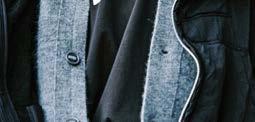





LATE CHECKOUT ISSA LIFESTYLE. Harmony in Chaos
they are driven by the eventful lives of a cosmopolitan, globetrotting community: Madrid-based designer duo Antón Álvarez and Alex turrión stage their streetwear collection as loud, humorous, provocative, diverse and endlessly eccentric. Since its foundation in 2019, this fresh attitude has anchored late Checkout in the assortments of numerous concept stores in Asia, the USA and europe, for example at well-known institutions such as Minishop in Madrid, the Business fashion, Selfridges or el Corte inglés. DMSR in london is the only sales agency to date. late Checkout issa lifestyle puts the fun back into business. www.latecheckoutissalifestyle.com, www.dmsrlondon.com
UNAS TOKYO. Home Is a Feeling
Yazeed Ahmad comes from Saudi Arabia, but moved to Japan at the age of 18 to found the streetwear label Unas tokyo, together with two friends who had also made their way from the Arabian Peninsula to Japan. they incorporate the cultural influences of their homeland into their designs. their passion for streetwear translated into sartorial fashion came with their adopted country: “in Japan, people understand the effort, identity and the different qualities that go into a collection. they understand and appreciate details,” says Yazeed, which is why he produces exclusively in Japan. At the moment, the collection is only available in Japan, but he is planning to expand to europe. www.unastokyo.com
APPLIED ART FORMS. Form Follows Function
three factors make this brand so special: the designs are created in a studio in Amsterdam, which houses a gigantic archive of vintage clothing from around the world; designer Marcel Verheijen’s deep understanding of quality, workmanship and materials; and the fact that co-founder and designer Guy Berryman is the bassist for Coldplay. He put together the archive that reflects his fascination with craftsmanship, functionality, and precise workmanship. the result are constructed-looking, nerdy, technically sophisticated collection pieces. Andreas Murkudis in Berlin was found to be the perfect representative for the internationally successful collection. www.appliedartforms.com






































With her namesake menswear brand, london-based designer Martine Rose is one of the grand old dames of the scene. the list of stores that carry her collection reads like a who’s who of high-end streetwear and makes it very clear how up-to-date her design language is. Her designs, which are sometimes a little quirky, quote traditional British menswear and are interrupted by subcultural codes from punk, grunge or reggae, creating moments of surprise at image stores such as BStN, HBX, luisa via Roma, end Clothing and Selfridges. Martine Rose interprets the slogan “Same Same” in her own way. www.martine-rose.com
Unorthodox doesn’t fully capture it, because the style icon and prototypical muse of Japanese streetwear collection the Nerdys is the average consumer, who chooses their clothes almost in passing. Accordingly, the sophisticated nerd style is reduced to the essentials. Seiji Akutsu captures the zeitgeist with his designs. they are an ode to simplicity, because the look stands for the random coolness of conscious uncoolness. With the Pick Store in london and Bungalow in Stuttgart, the Nerdys is represented not only in Japan, the USA, Korea, taiwan and China but also on the european market. Distribution is handled by the owner himself, who also runs the store elementary Store Bin in tokyo. www.nerdys.jp
A prime example of how streetwear has developed: sneakerhead Sean Wotherspoon rose to fame with his design for the Nike Air Max 97/1. His media presence, the hype surrounding his person, and his sneaker expertise contributed to the success of the Round two stores, which now exist in Richmond, los Angeles, New York, Chicago, and Miami. together with brand manager Haile Cano, Wotherspoon launched the self-titled collection, for which he drew designs from his archive filled with streetwear icons. He deliberately breaks down the boundaries with formal menswear. the collection is currently listed in the US, Japan and China, with european retailers to follow. www.roundtwostore.com

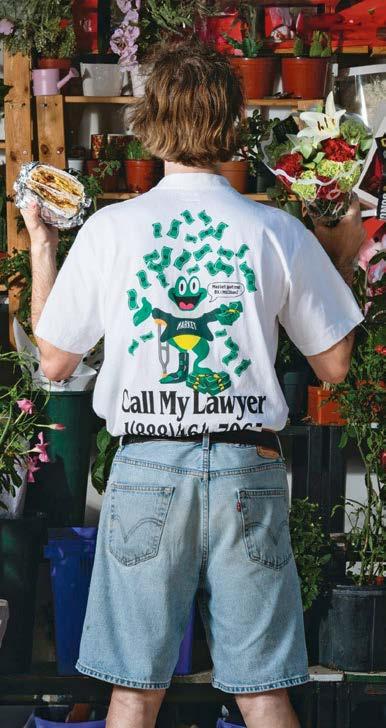

Gramicci has always been rock-solid, not only in the raging surf of the outdoor and streetwear market. Rocks are also part of their DNA, the brand has its roots in climbing. they are continuously working on their further development: with release parties in the london store that opened in 2023, round trips to outdoor sports enthusiasts with gigantic fan bases like Common Ground, and many collaborations with brands like Deus ex Machina or And Wander. the image is from the current collection, which is already the second collaboration between the two outdoor specialists. Gramicci has been represented by Agentur Säck & Nolde for the German and Austrian markets since 2021. www.gramicci.co.uk
the motifs and designs of the New York cult brand do not go easy on their audience. “Just do Nothing” in iconic typography and an X-ray tracksuit with fracture markings strike a chord with an international fan base, as humorous allusions to clichés. the company recently announced the deepening of its partnership with Smiley and the launch of the Smiley Sports line. for CeO Vinaud Kasturi, this is another important step in bringing together influences from sports, fashion and culture with Market Studios’ creative patronage of like-minded people. Market is represented, for example, at farfetch, USG and GlueStore. www.marketstudios.com
“... beats roast beef at the Ritz”. While the slogans of Reception read like a menu recommendation from the chef de cuisine, the list of their retailers gives an idea of the standing that the streetwear from lyon now has. it includes stores such as firmament in Berlin and Minishop in Madrid. they always remain true to their motto that good food is the basis of a functioning community. “it’s like a dinner with friends that goes on late into the night,” describes founder Pierre Boiselle in his design manifesto. in 2022, Reception opened its own multi-brand store in lyon as a home base and symbol of the relaxed lifestyle that surrounds the brand. www.reception-clothing.com
28.01 – 30.01



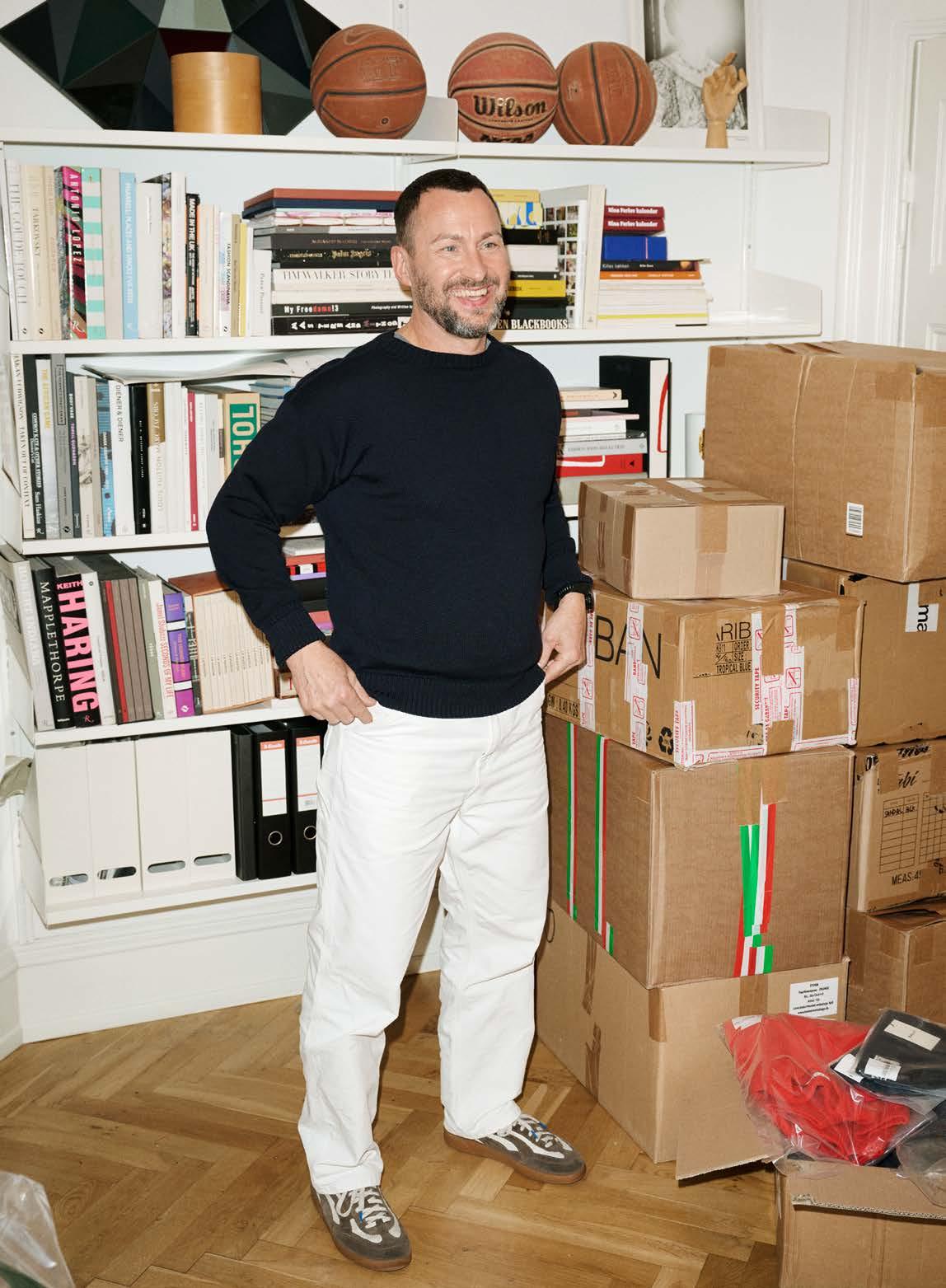
“IT’S NOT ABOUT PERFECTION —IT’S ABOUT RELEVANCE!”
Should you happen to lose faith in the integrity of our industry, try meeting Rasmus Storm for a chat. I did it, and learned a lot. About his incredible journey from school dropout to becoming the heart of STORM, one of the world’s leading concept stores. About the three basic rules he agreed on with his family. And about relevance.
interview: Stephan Huber. text: Petrina engelke. Photos: Storm
RRasmus Storm, founder of STORM (checking a message): Oh, I just got a reminder - today is actually pretty special. I’m waiting for a friend to bring back one of the posters from the opening of the store. I think it said 10-29-94, so this interview marks the 30th anniversary.
Stephan Huber: Oh wow, what an amazing coincidence! I feel honored. So, there was a poster for the opening?
Yeah, we kept it simple. Actually, we had to. It was just a poster with the logo – an “S” in a circle – and the date. That’s it. Nobody really knew what to expect at the time. And this was for the very first store?
Exactly. We opened this tiny shop in what was, back then, a pretty run-down area. The area was affordable, but everything exciting in Copenhagen 30 years ago was happening only in the city center. Outside of that, there were very few streets with anything interesting on them – barely any stores worth mentioning.
I noticed it’s STORM followed by design, art, and fashion. That order caught my attention since you originally started as a fashion store. Why this sequence?
Honestly… it just came down to what sounded best. It was more about the flow when you say it aloud. But also, I wanted it to reflect what we stand for. Our interests aren’t just about fashion –they also extend to art. For me personally, I’m deeply interested in art, but more so in its aesthetics.
How so?
Well, I grew up in a creative environment. My mom is an artist, and she had this incredible sense for colors and combinations. Her sensitivity to how things fit together was amazing. That shaped my own sensibility – whether it’s color, art, or aesthetics. For me, it’s natural to pick, collect, and combine things in a way that feels right.
So, it’s really just the way you see the world?
Exactly. It’s all about imagination.
Speaking of formative experiences, you once mentioned working in Bavaria at a young age at a company making sandblast equipment. You spoke about it like it really shaped you.
It definitely did. That job taught me so much about life and interacting with people from all walks of life. I came from a very intellectual household – not wealthy, but intellectually rich.
My dad’s a psychiatrist, and my mom, as I said, is an artist. We originally come from Copenhagen, though I grew up in a small city. My father’s side of the family worked in culture – journalists, editors, that sort of thing. My grandfather was even a prominent cultural editor back in the ‘60s, hosting these incredible dinners with writers and artists in this huge flat.
That’s quite a background.
Yeah, but I broke away from it. I left school early, no formal education, and started working in a factory at 16. Eventually, I ended up in Munich. Working hard so young, especially in that environment, taught me about people – about life. It gave me a broader perspective.
So, you learned about people from different backgrounds?
Exactly. It taught me to respect everyone as human beings, no matter their background. It also helped me learn how to navigate different layers of society. That period in my life taught me so much about humility and respect.
Do you think that experience is one of the foundations of your success as an entrepreneur?
I think you’re right. I’ve always felt a little out of place in the more pretentious or even snobbish parts of the luxury industry. Honestly, I’m more comfortable around factory workers than in overly polished settings. That’s why I treasure moments when I collaborate with factories or talk to the people on the ground. I learn so much from them.
But at the same time, you’ve built relationships with some of the biggest names in the industry – like Virgil Abloh, Jerry Lorenzo, and others. How do you balance that?
For me, it’s simple. I don’t see them as just famous figures. First and foremost, they’re human beings who share the same values and interests as me. That’s what really matters – the connection on a human level.
How did a small store from small Copenhagen become connected to those designers?
Honestly, it just kind of happened. You bump into people, start talking, and then you realize you share similar ideas, interests, or inspirations. From there, connections just grow naturally. You’ve managed to balance being avant-garde while staying true to something I’d call small-town respectfulness. Copenhagen is international, sure, but it’s still not Paris or New York.
Absolutely. In fact, I think that’s always been an advantage. If you look back 15 or 20 years ago, Copenhagen wasn’t the city it is now. When I started STORM in ’94, it was a much smaller place. I was just this young guy with a dream – wanting to create my own little universe. My goal was to bring together everything that inspired me at the time. It wasn’t just about fashion; it was about combining different ideas and creating something free and unique. I had this idea of curating everything I found exciting –sunglasses, perfumes, underwear, jewelry. Pretty soon, I started going to Paris for buying trips. Back then, there was only one trade show.
SEHM, right?
Yeah, that’s the one. They had this tiny section for independent brands. Everyone with a design store would show up the minute it opened, running around, tossing business cards, trying to grab the new stuff.
A real hustle.
Definitely. You’d walk up to a booth, say, “This is interesting,” and they’d show you a business card, like, “We’re already working with a store in Copenhagen.” That’s how it worked.
What was your first real “fashion crush” during those trips – a brand or designer that just blew you away?
Oh, Dirk Bikkembergs, for sure.
Interesting!
When I started going to Paris, Bikkembergs was one of the top menswear designers – easily in the top three. This was before brands like Dior dominated; it was all about the Belgians – Bikkembergs, Margiela, that crowd.
But for a small store from the outskirts of Copenhagen, it must’ve felt impossible to carry a brand like Bikkembergs. It did! I honestly thought it wouldn’t happen. He was only working with the best stores. But I took a chance. I contacted them –not by email, mind you, but by fax!
Ah, the analog days.
Totally! So, I reached out, and to my surprise, they invited me to Antwerp for a meeting. I was just a young, unknown guy, but I showed up. I met this really kind guy working at Bikkembergs and he opened the brand up to me. I placed my first order, even though I barely had the money for it. But it worked out. What’s even cooler is that he introduced me to Dirk Schönberger, who was interning for Bikkembergs at the time. Schönberger had just launched his own line, and I was one of the first to see it. I flew to Antwerp, where he and his partner picked me up in a minivan, took me to their apartment, and showed me his first collection. It was surreal.
A great memory?
It is! While we were driving around Antwerp, Schönberger mentioned that I should meet Veronique Branquinho. Later, I walked into a shoe store, tried on some boots, and casually mentioned to the girl working there that I’d just come from meeting Schönberg -
er. I also brought up Veronique Branquinho, and she looked at me and said, ‘That’s me.’ It was such a magical moment. Back then, the spirit in the industry was incredibly open – people shared contacts, dreams, and ideas freely. It was all about connecting and building something meaningful together. That was so formative for me and for STORM. Becoming friends with these amazing people in the industry. These connections helped me build a network that took the store to another level. Not long after, we moved from our original location to the city center. That was another turning point. It was a massive investment – 2.2 million kroner just to get the space. And this was 25 years ago, so you can imagine how crazy it seemed. People thought I’d lost it. And then, right after we opened, 9/11 happened. The market crashed, and we were on the edge of bankruptcy for two or three years. It was tough – really tough. The kids were small, and it felt like everything was on the line. Was it passion that kept you going?
100%. I believed in the project. There was no plan B. I’d put everything I had into STORM – my time, my money, my heart. I knew it had to work because there wasn’t another option. Slowly, we climbed back up. And then came another pivotal moment: Carrying Parisian brands.
Like Dior, right? That must’ve been huge.
Hedi Slimane was the new Superstar, just launching Dior Homme, and he came to Copenhagen to scout models. Somehow, he ended up at the store. He bought a few pieces and we started talking. When he went back, he told his commercial director, “I want Dior in that store in Copenhagen.” That’s how we became one of the first stores to carry Dior Homme. That whole experience was one of those organic moments. I wasn’t chasing it – it just happened. Around that time, I also started bringing in other brands like Louis Vuitton and Chloe when Phoebe Philo was designing there. And when she moved to Celine, her commercial director reached out to me. We were one of the first stores to introduce Celine under Phoebe Philo. It felt like we were riding this wave of incredible Parisian brands during such an exciting period.
That must’ve been such an amazing time, working with designers who were redefining fashion.
It was. Back then, everything revolved around the fashion houses. The focus wasn’t just on selling products – it was about pushing boundaries and creating something meaningful. These days, it feels more calculated, like it’s all about message control and having a master plan. Back then, it really was just pure passion and collaboration.
How did streetwear start at STORM? Because today, a lot of people see it as a luxury streetwear hub.
That’s a great question, and it’s something I’ve wanted to explain. Everyone always saw STORM as this high-end, creative fashion store – representing European designer houses and Parisian brands. But I’ve always had this deep connection to music, especially hip hop. It started when I was a kid, listening to early hip-hop on the radio in the 80s – straight out of New York. And it wasn’t just rap – it was house music, the club scene, everything happening at the time. That fascination with music led me to bring some of that culture into STORM. It was just gut feeling that the time was right. I think it was around 2008. That’s when things really started shifting for you?
Yes. I was on a trip to Tokyo with some friends, kind of an inspirational trip. And we had an evening celebrating Tyler Brûlé’s birthday. Tyler and I had known each other for a while. He’d been visiting the store whenever he came to Copenhagen. He used to write about us in Wallpaper when he found new and interesting things here.
That was his northern period?
Absolutely. At this birthday, I met Yoon Ahn from Ambush. The next day, he took me around Tokyo, introduced me to people, and showed me the Ambush jewelry – the POW necklaces, in particular. I brought some back home in my suitcase. That was the start of something new for STORM. At that time, I think Sarah
Andelman from Colette had already picked up Ambush necklaces, so the buzz was building.
It must’ve been such a shift for the store’s audience.
It was. And it was all connected somehow. When we displayed the Ambush jewelry, people were like, “What is this?” But the younger crowd got it immediately. They’d seen it worn by rappers, or in the magazine Nigo did for his brand A Bathing Ape in Tokyo. Again, it felt like a natural evolution, but at the same time, I loved challenging people’s expectations. How so?
Everyone thought they knew what STORM was – “Oh, it’s about Celine and high-end fashion blablabla…” And then we started introducing brands like Ambush and pieces tied to street culture. That’s when Kanye West came into the picture.
He visited the store?
Yes, in 2009. He visited STORM and we started talking. That same night, he called me up and said, “Take me around Copenhagen.” So I did. We spent time together, and through him, I met Don C and others. Again… it wasn’t planned, it just evolved. You have a way of connecting with people. Why do you think that is?
Maybe because I’m just me. No hidden agenda. I’m genuinely interested in people – their stories, their creativity. That’s how these connections happen. And then, through Don C, I saw these snakeskin caps they’d made for themselves. I asked if we could sell them at STORM, and he agreed.
And those caps became a thing?
And how! They were expensive, I mean really expensive for caps. But the kids saved their money and bought them. It showed me how much they connected with what we were bringing in. These pieces weren’t just products; they represented something cultural, something aspirational.
So this brought a new generation to STORM?
We’ve always been about staying relevant, and that’s how we’ve managed to bring in the next generation over and over again. It’s not about clinging to one identity – it’s about evolving while staying true to what feels right. What I’ve learned over the years is that things often happen simultaneously but without much exchange. You have like-minded people working on similar ideas all over the world, but they don’t necessarily connect. They’re moving in the same direction because of external forces – it’s almost instinctive.
I can hear a little melancholy between the lines… You know, I’ve been thinking a lot about how things have changed in the industry. I’m passionate about what I do – I still love it – but if you ask me if I still love the industry? I’m not sure anymore. I don’t think I’m in love with it like I used to be. Go on!
You shouldn’t talk to much about old times. But still… back then, it was all about connecting with like-minded people. We exchanged ideas, created things together. Giving was somehow more important than receiving. Now it feels different. It’s more about status – what’s your track record, who do you know, and what can I gain from you? That openness is gone. Back then, you could experiment, fail, and still move forward. These days, everything feels calculated – driven by money and message control. The magic has been replaced by metrics.
And that’s exactly why what you’re doing stands out. It’s deeply rooted in authenticity. You started in the analog age, when everything felt tangible and personal. Yet, even now, in this hybrid, borderless digital world, your values continue to resonate – especially with the younger generation.
I think it’s because we don’t try to be something we’re not. We trust ourselves and follow our instincts. We create and share what we genuinely love, and people feel that. It’s not just about selling a product – it’s about building a culture, a vision, something immersive.
Like your store is a never-ending artwork?
Exactly. We work on it every day, adding, refining, and evolving. It’s all about keeping it relevant – staying connected to what


Every object and every picture in Rasmus Storm's completely unpretentious Office tells a story.

matters. I see everything in images. When we’re curating, I can visualize how it will all come together. It’s not about perfection –it’s about relevance!
And that relevance is so important, especially now. People are overwhelmed with noise – thousands of images and products thrown at them constantly. They’re longing for something that cuts through, something that feels real.
That’s the key. If you’re not relevant, you’re just noise. I’ve always believed that as a fashion store, your job is to be relevant – to tell stories, to connect with people. Otherwise, you’re just selling things people don’t need.
It’s interesting how the younger generation is reacting to all of this. They grew up with fast fashion, vertical concepts, and D2C brands. They expect good design at a reasonable price. But at the same time, they crave experiences – something deeper than just buying a product.
They do. They want authenticity and connection. But they’re also overwhelmed by the pressure of this perfect, curated world they see online. It’s all about beauty and money, and it makes them insecure. They’re stuck between wanting to belong and not knowing what they really want.
That’s the thing. Back in the day, dreams felt rare and precious. Now, with billions of images flooding our screens every second, everything feels disposable. We’ve lost that sense of wonder.
And that’s what I’m trying to bring back – the magic, the dreams. Through storytelling, through the store, through the way we connect with people. It’s not easy, but it’s necessary. There’s still magic out there, if you’re willing to look for it.
So what’s the next magic? I’m curious because you’ve mentioned Jerry Lorenzo and Fear of God. Will this merge of streetwear and formal wear be the next big thing?
There’s an almost organic evolution happening right now. Fear of God is a great example of this. It feels very modern, the way Jerry connects these two worlds. He’s managed to create a language that bridges luxury and street in a new way. He’s taking something as rigid as formal wear and infusing it with the energy of street culture. It’s maybe a bold comparison, but Fear of God does feel like the next chapter after Virgil. It’s interesting because while it’s not necessarily my personal style, I deeply respect what he’s doing. What he’s created feels relevant and modern, which is what matters most.
Looking at your anniversary, I’m probably even more curious now to hear what’s next for you and STORM?
Everything we do at STORM reflects who we are as a family – our age, our lifestyle, the way we see the world. It’s all deeply connected. So, what’s coming next? I can’t say for sure. But what I do know – what I feel with absolute clarity – is who I want to work with, what I want to see in my store, and what I want to stand for. It’s not about trends or plans; it’s instinct. I just know when something feels right. And when I think about this, I realize how much this has always been a family thing. STORM isn’t just a business. It’s me, my wife, and our son – it’s our life. We’ve been doing this together since the beginning, and every single day, we talk about the industry. We talk about how people behave, how things have changed, and how long we want to keep going. Not just in a financial sense, but in a moral sense. What are our limits? At what point do we say, “That’s enough”? I think we really started to confront those questions during COVID. The shutdown gave us time to stop and reflect. It was a tough time financially, sure, but it also revealed people’s true colors – suppliers, partners, everyone. At first, there was this talk of unity, “We’re all in this together.” But it didn’t take long for the big players to show their true faces. Some were respectful, yes, but others? They quickly forgot about solidarity and went back to their usual behavior. It was disheartening. As a family, we had a lot of conversations about this. And during that time, we made an unwritten rule. We agreed to focus on what really matters to us – to only work with people who align with our values. COVID gave us clarity. It forced us to decide who we want to
surround ourselves with and who we don’t. That’s been one of the most important lessons for us as a family and as a company. What have been the key take-aways from these lessons? There are certain rules we’ve set for ourselves as a family and as a business. One of the most important is maintaining our freedom. We’ve decided we’re not going to take on loans or credits just to survive. That independence defines STORM. It’s why we can act the way we do – because we don’t owe anyone anything. And as a family, we’ve all agreed we want to keep it that way. That freedom allows us to stay true to ourselves, to act based on what feels right, not what’s expected. That’s one rule we live by. Another is only working with people we respect and who respect us. People we could imagine sitting down with for dinner, talking about life beyond business. Not just fashion, but family, music, politics, movies, holidays. It’s about working with people who share our values.
That’s a great rule.
It’s become essential for us, especially in the last five years. The pandemic really sharpened our perspective on this. It gave us time to reflect on who we want to work with and who we don’t. And it showed us who the real ones are, the partners who stuck by us and treated us with integrity when times were tough.
So, it’s about freedom, but also about building the right relationships.
Exactly. And the third thing we’ve agreed on is that the work has to fit into our personal lives. We’ve done this for 30 years, and we’re proud of what we’ve built, but we won’t let it take over our lives. For example, our store hours are shorter than most. 11:30 am to 5:30 pm. It’s enough. It allows me to live, to enjoy breakfast with my wife, to swim in the morning, go to training, spend time with my family. That’s what matters. We’re not chasing trends or trying to be the hippest shop. We’re doing what feels right for us. If people think that’s cool, great. If they don’t, that’s fine too. That seems to be the perfect way to approach the next 30 years. Rasmus, thank you!



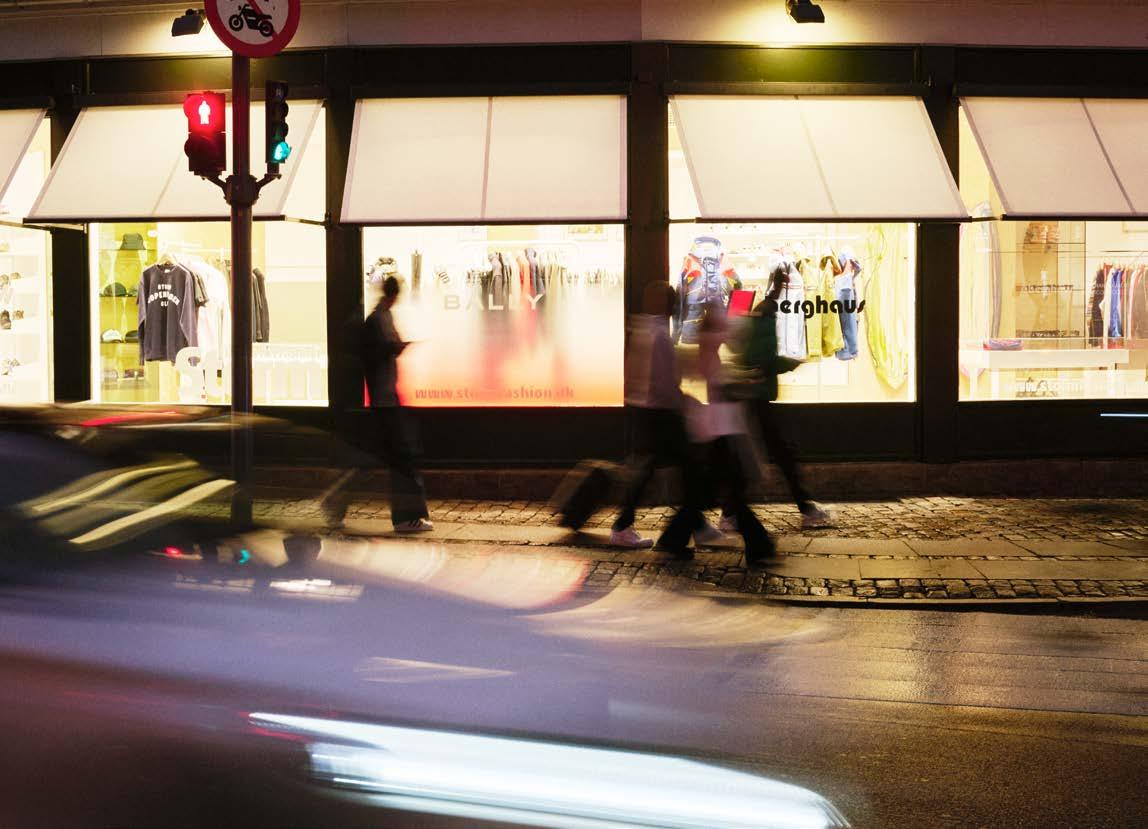
Loving Copenhagen feels almost trivial. This city has kind of everything we long for. a cosmopolitan flair wrapped in a lovingly cultivated local charm. The water, the people, the food, the style, the people... and then there’s the way they all ride their bikes everywhere – and look effortlessly good doing it! Love is blindness? or perhaps it’s just the dazzling clarity of Copenhagen. a city that feels effortless, yet never careless. Where sleek minimalism meets hygge warmth, and tradition blends seamlessly with innovation. Where a harbor swim at sunrise is as natural as a Michelin-starred dinner at sunset.
But is Copenhagen really this perfect? Could it be that this dreamlike façade hides deeper layers? of course it does – and that’s what makes it even more fascinating. From its timeless design heritage to its avant-garde culinary scene, and from edgy contemporary art to cozy neighborhood hangouts, Copenhagen is full of contrasts waiting to be discovered. Join us for a walk, guided by some very special locals… as special as Copenhagen. Come along and see the city through their eyes.
By Malene Wagner and Stephan huber. photos: Jens Langkjaer, @jens_langkjaer

1 | Coco Hotel
(Vesterbrogade 41, 1620 Copenhagen; open Monday-Sunday 7am -10pm)
Coco is like a hidden gem in the heart of the city. In the winter, its cozy indoor atmosphere is perfect for quiet work sessions or intimate meetings, while in the summer, the lush courtyard becomes a peaceful haven. It’s a versatile spot where I can seamlessly transition between work and personal time, making it one of my favorite places to retreat. tococo-hotel.com, cocohotel.dk
2 | Værnedamsvej
(1800 Frederiksberg C)
Værnedamsvej, my beloved neighboring street, has a unique charm that never fades. The lively atmosphere, filled with an eclectic mix of small boutiques, fantastic eateries, and charming wine bars, makes it an inviting place to explore. Whether I’m grabbing a coffee, strolling through the shops, or enjoying a meal, the sense of community and warmth here always makes me feel at home. It’s a perfect blend of urban energy and local intimacy.

3 | Soho House
(Havnegade 44, 1058 Copenhagen; member’s club)
Soho house coming to Copenhagen felt like a long-awaited addition to the city’s creative scene. even though it’s part of a global brand, they’ve managed to keep the space intimate, cozy, and authentically Danish. It’s become my go-to place for productive work sessions and inspiring creative meetings. Located in a former Customs house, the atmosphere is both relaxing and stimulating, almost like a shared living room for those in the industry. With CIFF and Soho house now collaborating more closely, it has become an even more integral part of my professional world. sohohouse.com/de/houses/soho-house-copenhagen, @sohohouse

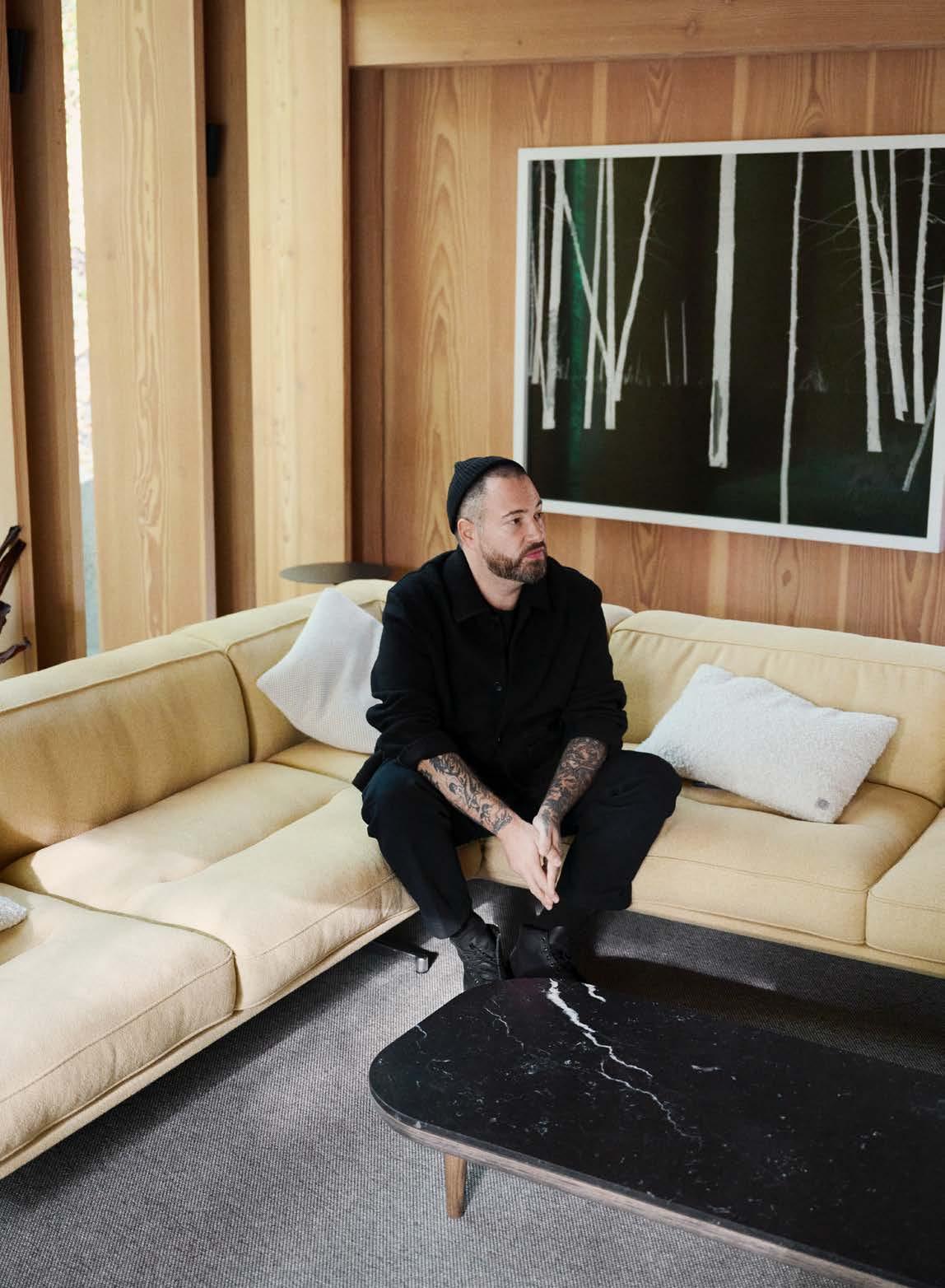
1 | Noma
(Refshalevej 96, 1432 Copenhagen; booking required) noma is more than a place, it is the epicenter of the biggest modern cultural revolution when it comes to food and, as consequence, dining. In a nutshell: ideas, innovation, change. The primary reason that led me to move to Copenhagen was the possibility to gravitate around its ever-changing system. The impact of its work somehow transcends hospitality business and on a more personal level made me question not only what I do but especially how and why I do it. Forever grateful. noma.dk, @nomacph
Restaurateur at Bar Vitrine, Barabba and Propaganda


2 | Cisternerne
(Søndermarken, Roskildevej 25A, 2000 Frederiksberg; open Tuesday-Sunday 11am-6pm)
This is the place for me to hide and almost disappear. every time I step in here, the binary frame of time/ space somehow cracks; in this sort of “limbo”, thinking becomes more meaningful and silence becomes the sound of my thoughts. Their exhibitions are different and well-curated. When I leave this space I always feel full and more centered.
frederiksbergmuseerne.dk/en/cisternerne, @cisternerne
3 | Frama Studio Store (Fredericiagade 57, 1310 Copenhagen; open Monday-Sunday, 10am-5pm (weekends 3pm) embarrassingly enough, Frama is a “new” thing to me. What I love about it? This shop is special, personal and effortlessly beautiful. It is definitely the dynamic process from appreciating the great people behind it that brought me to understand the result of their incredible work. niels (the founder) is a friend of mine and our relationship keeps enriching me with different points of view on functionality, meaning and possibility in design. framacph.com/blogs/stores/frama-studio-store, @framacph

Perfumer and fragrance designer
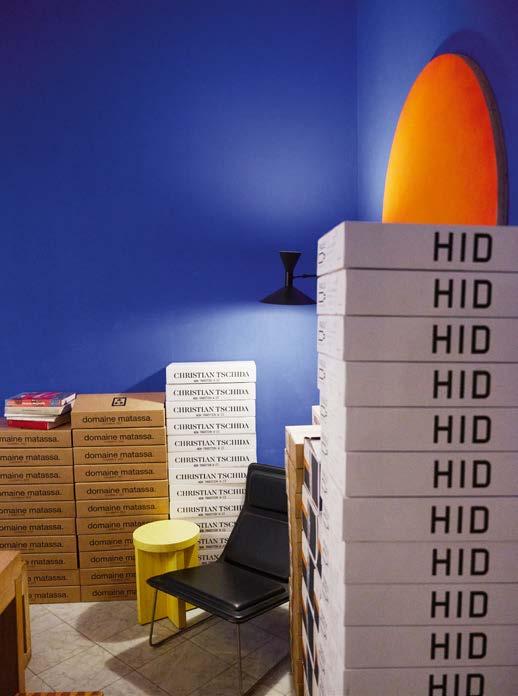

1 | Ny Carlsberg Glyptoteket (Dantes Plads 7, 1556 Copenhagen; open Tuesday-Sunday, 10am-5pm. Thursday 9pm) ny Carlsberg glyptoteket is an endless source of inspiration to me – both in my work and personally. When I walk through the museum and experience the works by artists like auguste Rodin and Vincent van gogh, I feel connected to history. Van gogh and his influence from Japan actually played a part in my creation of the perfume Komorebi for Frama. glyptoteket.com, @glyptoteket
2 | Den Hirschsprungske Samling (Stockholmsgade 20, 2100 Copenhagen Ø; open Tuesday-Thursday, 10am-5pm) an artistic refuge that I love both for its historical charm and timelessness. The museum was designed in 1902 to house the personal art collection of henrich and pauline hirschsprung. It is surrounded by a park, where I like to take a quiet stroll. history, art and nature melts together bringing me peace – and a lot of inspiration. hirschsprung.dk, @hirschsprungskesamling
3 | Lille Blå Vinbar (Esplanaden 3, 1263 Copenhagen; open Tuesday-Saturday, 3pm-11am)
Lille Blå is the place where I meet up with friends for deep and meaningful conversations. The intimate and cosy room creates a feeling of comfort and intimacy. In the summer, we always sit outside, enjoying the sun and the moment – alongside a glass of austrian wine of course – before we continue on our bikes to one of our other favorite places in the city. splanadegaarden.dk/lille-blaa-vinbar, @lilleblaavinbar


Designer, Founder, CEO IX Studios

1 | Garden of the Royal Library (Christiansborg Palace, Proviantpassagen 1, 1218 Copenhagen; Open Monday-Sunday 6am-10pm)
I often go for walks here and in the summer I might come to sit and draw. This garden is my getaway from the busy city. I find a lot of inspiration in nature, and when I’m close to water [the garden is behind the harbor], my thoughts flow freely and I open up to new ideas.
2 | Inipi – Amager Strandpark Havkajakvej 8, 2300 Copenhagen S; booking required): as a winter swimmer, this is my favourite spot in Copenhagen where I can find complete peace and go into ‘zen’ mode. It helps me enter a new mindset and allows the creativity to unfold. It has been my hidden gem, and I even swore to never share it –but I’ll make an exception. inipi.net/da
3 | The Roe Bar (Vognmagergade 9, 1120 Copenhagen K; open Monday-Friday, 9am-6pm and Saturday 10am-5pm)
Roe Bar is just around the corner from my show room. When I need a change of scenery to brainstorm or have a meeting, this is my place to go. I love the clean and simple interior which reflects my own aesthetics. The perfect place to find space for thoughts and let ideas come to me. louiseroe.dk, @louiseroecph



1 | Ipsen & Co
(Gammel Kongevej 108, Frederiksberg C) a small local café in the part of Copenhagen where I lived for twelve years. Les Deux had its first actual office space right across from Ipsen, but at that time we couldn’t afford café visits. as the company grew, we moved premises, but we have always returned to Ipsen for meetings. For many years, I would also come every Sunday with my wife. ipsenogco.dk, @ipsenogco
2 | Jurahuset
(Studiestræde 34, Copenhagen K) When I founded Les Deux, I was studying Law, and this building used to house the former Faculty of Law, part of the University of Copenhagen. exams, all the ups and downs – this place brings back memories. This is also where I met my wife, who was my teacher then. My most fond memories are of our secret encounters after class.
3 | The Heart Stone
(Sortedamsdosseringen, Copenhagen) By the lakes towards the east side of Copenhagen [Østerbro], there is a small stone with a heart shape. You won’t notice it if you do not know it’s there. But it has great significance to me – it’s where I kissed my wife for the first time. Later, she gave me a similar stone that she made herself. It is now by the entrance to our house north of Copenhagen.
Founder of Les Deux

1 | The Library of the Danish Design Museum (Bredgade 68, 1260 Copenhagen; open Tuesday-Thursday, 10am-2pm. Thursday 5pm)
This place has been truly significant to my academic path. at 18 years old, during my early art history studies, I would spend much time in company of the French 19th-century art critics and Japanese art collectors, travelling back in time in this beautiful space designed by Kaare Klint in the 1920s. Kept in its original state, it remains a precious time pocket with the largest collection of design books in Scandinavia. designmuseum.dk/en/bibliotek/library/, @designmuseum_bibliotek/
2 | „Liggende Pige“ (Laying Girl) by Gerhard Henning (Grønningen, 1270 Copenhagen)
The Swedish-born sculptor gerhard henning made numerous nudes, many now in museum collections in Denmark. But this is one of a few in a public space and therefore a special joy to bump into her by chance. hardly affected by time and the weather, she just lays there unbothered watching the world pass by. open.smk.dk/en/artwork/image/KMS5747
3 | 7115 By Szeki (Klopsterstræde 19, 1157 Copenhagen; open Monday-Saturday 11am-6pm; Saturday 4pm)
I first met Szeki when I had just returned to Copenhagen after many years in London. Szeki had moved here with her family from new York one year prior to open her Copenhagen store. She brought such a wonderful sense of internationality and outlook, which made me appreciate Copenhagen again. her designs are like an organic continuation of her – genuine, effortless and made with integrity. 7115byszeki.com, @7115nyc



The AI revolution offers the chance for a fresh start: because cooperation wins and individual performance takes a back seat, the next generation of leaders has the chance to fix the industry's bugs at the backend. It's as cool as it sounds!



Jürgen Alker is a nerd in the very best sense of the word, driven by constant curiosity and a desire for innovation. In an interview with style in progress, he provides an in-depth look at the opportunities and risks of AI, describes its influence on consumer behavior and explains why human creativity nevertheless remains irreplaceable. text: Stephan Huber. Photo: Jürgen Alker
LLet’s start with the essentials: what exactly is the Soccer Bible, and what’s your role there?
Jürgen Alker: Soccer Bible is a platform dedicated to football culture—everything happening off the pitch. It’s not about match results, but about the massive world of football culture beyond the games. It began as a print magazine 25 years ago, then evolved into a blog and eventually social platforms like Instagram.
How did you get involved?
I met the team while working on projects with Mario Götze. They had significant reach, attracting followers like Adidas’ CEO or Mbappé. Brands began approaching them for collaborations, from photo shoots to campaigns. I’m now helping them structure a business model around these opportunities.
Football has become the world’s largest youth culture. Collaborations like AC Milan with OffWhite, Boss with David Beckham or my favorite, Yohji Yamamoto designing the jerseys for the Samurai Blue are great examples.
Footballers today are creators. They sit front row at fashion shows and collaborate with major brands. It was about time for players like Mario Götze to think about more than flashy cars, and start investing in startups and building something sustainable.
Talking about startups - you’ve always had a knack for identifying the potential of emerging technologies.
I’ve always been drawn to creative industries, which naturally connected me to transformative tools like the iMac and iPod—both cultural milestones. The iPhone was the real game-changer. I managed to get one before it was available in Germany, and I immediately saw its potential to revolutionize daily life. That led me to design accessories like iPhone cases, but funding a product-based business proved challenging. So, I pivoted to services, helping brands adapt to this new mobile-first world.
That was incredibly forward-thinking—recognizing the massive shift toward mobile. We started a mobile-focused agency in 2010, showing brands how to fit their offerings onto smaller screens—a significant challenge back then. The agency grew and was eventually acquired in 2015, by which point digitalization had transformed every aspect of business.
Your curiosity didn’t stop there—you’ve also explored blockchain and cryptocurrencies. What sparked that interest?
I’ve always been drawn to decentralized systems. Web3 caught my attention for its potential to create a decentralized internet, redistributing power from corporations to individuals.
Do you think the dream of Web3 has failed?
Not entirely, but the hurdles are immense. Building decentralized systems in a world dominated by tech giants is challenging—they have no incentive to give up control. Instead of decentralization, things are becoming even more centralized. AI is a clear example—only companies like Microsoft or OpenAI can afford to dominate. Web3 efforts, like blockchain-based tokens or NFTs, were often used as marketing tools by brands like Nike and Adidas, rather than fully embracing decentralization.
It sounds like some of the foundational Web3 ideas still have potential. Do you think they’ll resurface in the future?
Absolutely. Technology is often overestimated in the short term but underestimated in the long term. While many Web3 initiatives flopped, their principles could still integrate into everyday life. Younger generations already spend time in virtual worlds like Fortnite. Why wouldn’t they value rare digital items from brands like Adidas? Web3’s promise of decentralization might not be here yet, but practical evolutions are likely.
And how do you see youth consumption habits evolving? They’ve grown up in digital worlds, unlike us who had to adapt.
For today’s youth, digital identity often outweighs physical presence. They express themselves on Instagram or TikTok, which is why I thought virtual fashion might boom. Platforms like DressX seemed perfect for offering variety without the need for physical clothes. But I underestimated their love for physical experiences. Concerts are packed, restaurants are buzzing—there’s still a deep appetite for real-world interactions.
Maybe even more so now—almost like making up for lost time.
Exactly. Whether it’s a Travis Scott concert or an Adele show, being there matters. Technology enhances these moments, but physical connections remain central.
The digital and physical interplay is fascinating—like Apple Vision Pro redefining immersive experiences for younger generations. On point! For them, immersion is always intertwined with digital. My son, for example, attended a 90-minute Travis Scott concert, but spent hours afterward revisiting the experience through TikToks and videos. For him, it stretched into something much bigger—true immersion.
“TECHNOLOGY IS OFTEN OVERESTIMATED IN THE SHORT TERM BUT UNDERESTIMATED IN THE LONG TERM.”
While VR and immersive tech might grow, live events will never be fully replaced. There’s a place for both. Even if you can’t attend in person, tech lets you participate meaningfully. I’d love to watch the New York Knicks in a hyper-realistic setting, rather than flying across the world. This kind of hybrid accessibility has huge potential.
You’ve highlighted a key distinction between AI and Web3. AI seems to have broader, more immediate applications.
That’s the difference—utility. Web3 was more of a “front-end” trend with flashy promises but limited day-to-day impact. AI, meanwhile, is transforming operations. Businesses use it to streamline marketing, content production, and logistics. For instance, AI can replace traditional model shoots with 3D scans, saving time and costs. Actually AI is integrating into every aspect of operations, from logistics to product design. Instead of hiring a designer for repetitive tasks, AI can instantly create something like a green teddy bear print for kids’ pajamas.
But that’s also a bit unsettling. People often mistake AI for human intelligence, but it’s just advanced deep machine learning. So… nothing really new.
Agreed. AI identifies patterns and makes predictions using vast datasets—it’s not creating sentient beings. Its applications span creative industries, logistics, and customer experience, driving cost savings and efficiency across the board.
AI should enhance creativity, not replace it. By handling repetitive tasks, like generating endless pattern variations, it allows human designers to focus on innovation. The risk, though, is over-reliance, where everything starts looking “safe.” Human oversight is crucial because AI is a tool, not a replacement for the creative spark.
It’s all about balance—leveraging technology while keeping the human touch. How does AI fit into evolving consumption patterns, especially for younger generations?
AI has reshaped consumer behavior by personalizing experiences. Platforms like Instagram or Spotify use AI to curate content so specifically it feels intuitive. Younger consumers, accustomed to this level of personalization, now expect it across shopping, entertainment, and beyond.
In fashion, AI will predict trends, optimize supply chains, and create hyper-personalized products. Imagine a wardrobe dynamically curated based on your style, preferences, or even climate data—that’s the future we’re heading toward.
Hybrid experiences will define this future. Attending a live concert is irreplaceable, but technology enhances it through shared videos, virtual merchandise, or exclusive digital content. It’s not about
replacing the real—it’s about augmenting reality to create richer experiences. Community remains central to all of this. People want to belong, whether it’s through shared fandoms or exclusive experiences. Technology just expands the ways we can connect and engage, making those communities more accessible than ever.
Are these trends sustainable or just hype?
It’s a mix. While the hype around digital fashion and NFTs has cooled, the core idea remains relevant. Owning unique digital items or participating in exclusive online events is compelling, especially for younger generations immersed in online spaces. It’s execution, however, needs to evolve. Early projects lacked clear value, but brands like Nike and Adidas are getting it right by blending innovation with community engagement. Nike’s Dot Swoosh initiative, for example, rewards members with tokens for participating in events. These tokens unlock early access to exclusive drops or experiences, fostering loyalty and a sense of belonging. The key challenge is ensuring these efforts feel meaningful and not like forced attempts to follow trends.
It’s a fine line to walk. Innovation is exciting, but it risks alienating audiences if it feels inauthentic or overly commercialized.
The brands that succeed approach innovation as a natural extension of their values. Gucci experimenting with Roblox, for instance, might seem unusual at first, but it engages younger audiences in spaces they already value.
Not every brand needs to be present in Fortnite or Roblox, but understanding where your audience is and connecting authentically is key. It’s about meeting people where they are while staying true to your brand.
And that’s a universal principle, right? Whether it’s Web3, AI, or any other emerging technology, the focus should always be on enhancing consumers’ experiences or deepen their connection with the brand.
That’s key! Technology should serve the story, not the other way around. When done right, it opens opportunities for deeper engagement—through personalization, exclusive access, or entirely new ways of interacting
You’ve touched on a critical point: AI’s potential to disrupt jobs and redefine industries. How do you see this playing out?
AI is a double-edged sword. It can make industries more efficient, reduce costs, and free up human talent for creative or strategic work. But it also displaces roles, especially repetitive or technical ones. In fashion, for example, AI can design entire
“AI SHOULD EXPAND CREATIVITY, NOT REPLACE IT.”
collections, simulate materials, and generate patterns. This is transformative for brands, cutting production times and costs, but it’s a challenge for individuals whose jobs depend on these tasks. That’s why reskilling is crucial—people need to learn to work alongside AI rather than be replaced by it.
It sounds like humans need to shift from execution to orchestration, using AI as a tool rather than competition.
AI amplifies what we can do, turning basic inputs into remarkable outcomes. But it still requires human vision and context. In marketing, for instance, AI can analyze data and predict trends, but only a skilled human can craft emotionally resonant campaigns.
Are we moving too fast? It feels like the pace of AI adoption is overwhelming societal frameworks like education and regulation. That’s a valid concern. Technology advances faster than we can adapt. Ethical issues like data privacy, algorithmic bias, and intellectual property are still being debated even as AI becomes more widespread.
Education is another gap. Our systems were designed for an industrial era, not a digital one. Without preparing people for AI, we risk deepening economic divides.
That’s a powerful call to action. Beyond structural changes, do you think there’s a cultural aspect to this transition? Are we ready to embrace a deeply integrated relationship with AI?
Culturally, we’re still grappling with what AI represents. For many, it’s a black box—powerful but mysterious—creating both fascination and fear. To move forward, we need to demystify AI, showing what it can and can’t do, and how it fits into our lives. Transparency is key, whether in how AI makes decisions or how data is used.
We also need to focus on storytelling. The narrative shouldn’t be one of domination or replacement but of collaboration and empowerment. If people see AI as a partner, not a threat, it will be much easier to integrate into our cultural fabric.
That reframing feels crucial—turning the story from concern to possibility. How do you see AI shaping creative industries in the next 5 to 10 years?
AI will revolutionize creativity in ways we’re just beginning to understand. Imagine generating a film script or composing a symphony with a few prompts, or brands creating immersive ad campaigns that adapt to each viewer’s preferences. The twist is that the most successful creators will know how to infuse AI-generated works with human authenticity. AI can handle the heavy lifting, but
it’s the human touch that gives a story heart and resonance.
Over the next decade, we’ll see a rise in hybrid creators—part artist, part technologist—using AI not as a crutch but as a canvas to push boundaries in art, media, and storytelling.
It’s exciting to think about hybrid creators blending artistry and technology seamlessly. Do you see risks of losing traditional artisanship or individuality in creative voices?
That’s definitely a risk. Over-reliance on the same tools and algorithms can lead to homogenization. AI excels at generating what works statistically, but it’s not inherently innovative. For traditional craftsmanship, the challenge will be preserving its value in an AI-driven world. But this could also spark a renaissance for artisanship. As mass production grows, people may crave the uniqueness and imperfections of human-made creations. It’s all about balance—leveraging AI for efficiency while celebrating the irreplaceable qualities of human creativity.
Jürgen Alker is a German entrepreneur and consultant with extensive experience in the digital and creative industries. in the late 1990s, Alker served as Marketing Director at eastpak and later as Account Director at Jung von Matt, where he successfully managed global communications for MiNi
in 2010, he co-founded the mobile agency Swipe, the leading specialist in app development and mobile websites. in 2015, Swipe was acquired by the digital agency SinnerSchrader, where Alker became Managing Director. in 2021, Alker shifted his focus to Web3, Nfts, and the metaverse. He spearheaded the Nft studio at Highsnobiety and developed Web3 strategies. He is also a podcaster, hosting UNWORDY, where he interviews people who have successfully brought ideas to life. Alker is a renowned advisor in the digital economy, known for his unparalleled curiosity and dedication to innovation.


Carl Gross/CG Club of Gents
In 2022, Dominik Gross became the fourth generation of his family to join the Hersbruckbased company, which celebrates its 100th anniversary in 2025. A conversation about the future of the suit, the healthy balance between industry and trade, and the unspoken challenges of this industry. text: Martina Müllner. Photos: Création Gross
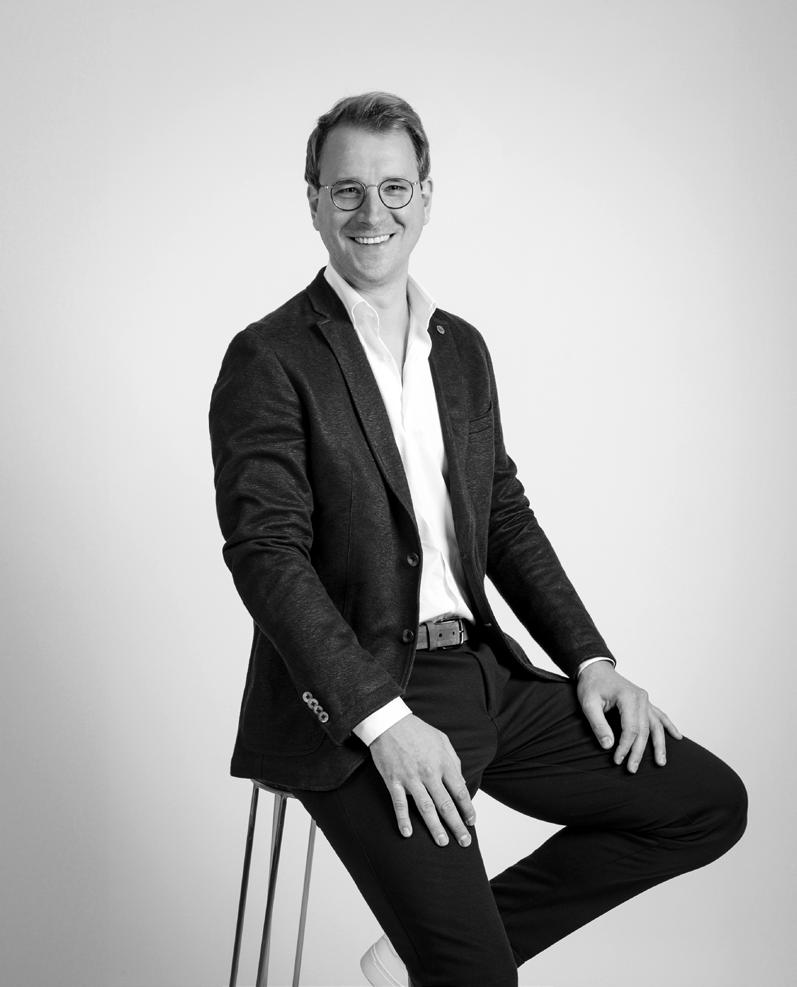


The casualization megatrend is calling traditional suits into question. What is your company’s response?
Dominik Gross, Managing Director of Sales, Product and Marketing at Création Gross: We are actively contributing to this shift by evolving classic business suits into versatile, casual-oriented looks. Suits that are paired with a bomber jacket or jersey top instead of the classic lapels are gaining in popularity. Our objective is to interpret the suit in a way that ensures it retains its relevance in more relaxed settings. We are witnessing growing demand for comfortable, versatile garments that work in both a professional and private context. Jersey and knitted elements in particular have claimed a new place in the business wardrobe. How much control does a manufacturer like you have to exert at the POS today?
I would not call it control. As a brand, you have a natural interest in actively shaping the POS. We consider it a strategic interface where brand identity and sales strategy become tangible. We collaborate closely with our retail partners and take on additional tasks to ensure that our products are optimally presented and offer a consistent brand experience.
How healthy is the current balance of risk between retailers and manufacturers?
There is a tendency for retailers to increasingly expect support from manufacturers. We, as an industry, certainly cannot shoulder everything, because we are likewise confronted with rising costs. I always consider risk distribution to be healthy when both sides are committed to their original responsibilities. As a manufacturer, these undoubtedly include providing an excellent product and seamless processes.
Speaking of processes: Création Gross recently completed a huge IT project and launched a logistics hackathon. Tell us about it!
The complexity behind each individual piece in our collection is immense. Our IT processes cover all the steps, from yarn procurement and production planning to precise inventory control. A button or piece of fabric for a suit is combined with up to 180 other components, which then
have to arrive on a coordinated schedule involving all our suppliers to be processed and delivered on time. Multiply that by 1,600 options per season. That kept us busy for a while. We have now even offered this IT solution to a competitor to avoid them having to undergo the same learning process.
How unusual! Is that the spirit of your generation, a greater emphasis on cooperation?
The current challenges require a different way of thinking and an openness to abandon competitive thinking, to exchange ideas and grow together. Ultimately, we compete at the POS, not in the backend.
Is that a lesson from your time in the consumer goods industry? There, collaboration on data, for example, is common practice.
Indeed, data exchange in the fashion industry has room for improvement. From my previous experience, I was familiar with working with up-to-date benchmarking data on all competitors, so I was amazed at how restrictively the topic of data exchange is handled in fashion in some cases. Whether and how intensively data is exchanged with retail partners depends primarily on one’s own negotiating position. There is definitely still a great deal of persuading to be done, because a more comprehensive exchange of data would help everyone react faster and more purposefully to market changes and thus increase overall efficiency.
Do you think there is sufficient pressure for fashion to finally address this issue?
Yes, although I always prefer changes to arise from a sense of responsibility, not from pressure. As a manufacturer, we bear responsibility: for the environment, for resources, for our employees, and for our retailers. Everyone benefits when change is guided by these principles.
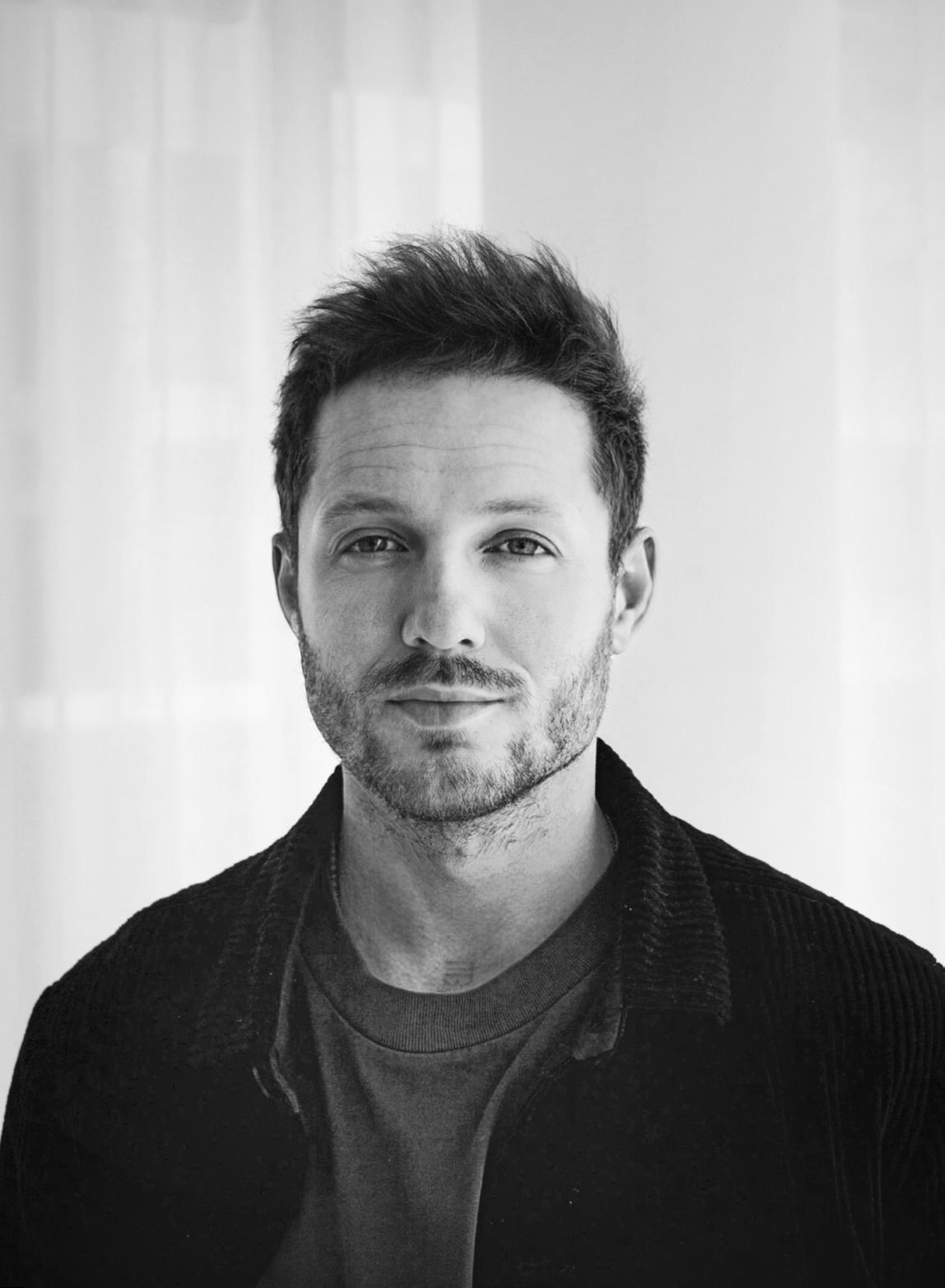


Could AI be the game changer the fashion industry needs?
From virtual sampling to immersive try-ons, platforms like Genera show how AI can optimize workflows, reduce waste, and revolutionize the way we design, produce, and shop. These changes not only promise greater efficiency and sustainability, but also significantly increase profitability. In an interview with Ana Varava, Genera founder Artem Kupriyanenko provides a glimpse into the near future.
interview: Ana Varava. Photos: Genera
AAna Varava: Please start by briefly explaining: What is Genera and how is it addressing the key challenges of the fashion industry?
Artem Kupriyanenko: Genera is an innovative platform that uses artificial intelligence (AI) and advanced visualization technologies to drive digital transformation in the fashion industry. It addresses critical issues such as reducing waste, accelerating product development and improving internal brand communication through hyper-realistic product visualizations. Genera also optimizes content production and offers unique solutions for interacting with consumers. In this way, it empowers brands to become more agile, efficient and environmentally friendly.
How did Genera come about and what makes it different from traditional production processes?
Genera is the product of a collaboration between myself, having over 16 years of experience in hyper-realistic visualization for architecture, film and advertising, and Keiron Birch, the former creative director of Calvin Klein Europe. Together, we have developed a platform that redefines traditional brand processes by delivering a visual quality that matches or even surpasses physical alternatives. Genera’s mission is to integrate hyperrealism and AI into various areas of fashion, setting new standards for production and presentation.
Tailormade tools for the industry's most pressing needs: Hyperrealism meets hyperpersonalization.
How do you combine AI technology with fashion to redefine workflows such as sampling and prototyping?
Our AI-driven tools are revolutionizing the creation and visualization of fashion products. Hyper-realistic results save resources and increase efficiency, enabling designers, marketing teams and commercial departments to increase productivity by more than tenfold. This holistic approach optimizes the management of collections, visualization, communication and the preparation of marketing content, making these processes both efficient and predictable.
What is Genera Space and what solutions does it offer the fashion industry?
Genera Space provides a range of innovative tools that address key industry needs. These include the Digitizer and Tech Pack Converter, which simplify product development and create a basis for visualization; campaign creation tools that make the production of marketing and internal content more efficient; AI-powered fashion models that optimize casting and photo shoots; and a PDP/Lookbook Creator that enables brands to create product detail pages and lookbooks before physical production begins.
Our hybrid business model serves different brand needs. For tier-1 brands, we offer comprehensive outsourcing solutions through an internal production network. Tier-2 and tier-3 brands, on the other hand, benefit from scalable, accessible SaaS tools that make advanced technologies accessible to smaller players.

What notable successes have you achieved so far?
We are currently working with over 50 brands, including several tier-1 and tier-2 players. Although confidentiality agreements limit the details, we can say that many of these partnerships are already at advanced stages, and that announcements are imminent. Aside from customer successes, building our team has been a particular highlight. Our specialists bring a wide range of expertise to Genera, from hyper-realism in visualization to fashion industry operations and advanced image processing.
How have collaborations with brands like Daily Paper and Neil Barrett demonstrated the potential of Genera?
Our work with Daily Paper and Neil Barrett showcases the tangible value that Genera offers. These partnerships have optimized internal communication and accelerated the development processes for collections. For example, Daily Paper is testing our AI try-on system to explore new ways of interacting with their community and engaging with their digital audience.
You also have fitting technology in the pipeline. How will this revolutionize the online shopping experience for brands and consumers?
Our AI Try-on technology creates digital twins of real clothing, allowing consumers to
virtually try on items before or after production. This innovation supports collections in terms of customization, on-demand production and improved feedback loops. It significantly increases business efficiency by reducing waste and return rates. Above all, it creates a completely new, deeply immersive shopping experience for the end consumer.
What practical benefits does the Digitizer Tech Pack Converter offer designers and manufacturers?
Traditional 2D tech packs often lead to misunderstandings and errors that require multiple sampling runs. Genera’s hyper-realistic visualizations eliminate these inefficiencies, enabling clearer communication and significantly reducing sampling errors and production times.
How does Genera integrate speed and flexibility into its solutions for fashion brands?
Our approach accelerates time to market by creating marketing, advertising and sales content before physical production. We work closely with brands at key process stages to reduce sampling runs through detailed visualizations, improving collection previews with AI-powered mockups, replacing traditional photo shoots with digital alternatives, and creating comprehensive marketing campaigns. These innovations save Tier 1 brands up to six months in operational processes while guaranteeing consistent quality and predictability.
Isn’t this just for big brands? What specific advantages can you offer medium-sized and smaller brands?
On the contrary! Our cutting-edge technology opens up completely new possibilities, especially for small companies, to optimize their processes and achieve significantly better results with comparatively little effort.
Does Genera support sustainability and transparency goals?
Absolutely! Our digital-first strategy minimizes waste and carbon footprint by relying on hyper-realistic prototypes, virtual fittings and digital content creation. By providing transparent supply chains, brands can build trust with sustainability-conscious consumers, particularly Gen Z and Millennials.
What is your vision for the future of the fashion industry?
We envision a future where sustainability, innovation and digitalization shape the fashion industry. By reducing resource-intensive practices such as physical sampling and photo shoots, we aim to establish digital tools as the industry standard. Our goal is balanced development – equipping brands with efficient, sustainable and adaptable solutions that meet modern consumer demands.
Impulso
Data is the new gold. Swedish SaaS (Software-as-a-Service) platform Impulso bridges the gap between suppliers and retailers, creating an ecosystem that allows for sustainable purchasing decisions. Deeply rooted in the fashion industry, the company is spearheading the data revolution. text: Martina Müllner. Photos: impulso
The independent retail sector has long grappled with a lack of digital tools, leading to inefficiencies in planning and overproduction. Jakob Vahl-Zeuthen, Sales Manager at Impulso: elaborates: “In fashion, nobody had to care about data, apart from the sell-in perhaps. Everybody cared about a beautiful product, but the rest remained a huge blind spot.” It is time for a rethink: both industry and retailers are aware that the billions of garments circulating annually require more intelligent tracking. At the heart of Impulso’s SaaS offering lies its Product Tracker, a module that provides real-time sales performance data, pivotal for planning and profitability while aligning with all upcoming DPP regulations.
Viktoria Lindqvist is the founder of Impulso, a SaaS provider that aims to eliminate industry’s blind data spots for the benefit of retailers.

Additionally, the Auto Payment module minimises credit risks by automating transactions between brands and retailers. In everything, the focus on individual multi-brand retailing is clearly evident. Impulso creates a blueprint for how brands and retailers will collaborate in the future. The robust infrastructure ensures scalability and swift implementation, offering valuable insights into market trends and inventory management not long after onboarding. The SaaS solution is fuelled by a team of industry veterans and tech innovators. Founder and CEO Viktoria Lindqvist brings decades of entrepreneurial experience in tech to the table, while Chief Creative Officer Mathias Olsteg has a rich background in global fashion retail. In the DACH region, Michael Prues is expected to replicate Impulso’s strong market penetration in Scandinavia. www.impulso.se


It’s like mental arithmetic. Even if the mouth says the result at the end, the head calculates the multiplication tables first. A dazzling result is based on a clever, complex and invisible, because upstream, thought process. Also known in our industry as the preliminary stage. Its innovative and economic superpower is still underestimated. This is reason enough to involve the bright minds of this sector in a discussion about developments that have always driven them: About innovation, product and sustainability.
interview: Stephan Huber. text: isabel faiss. Photos: Sorin
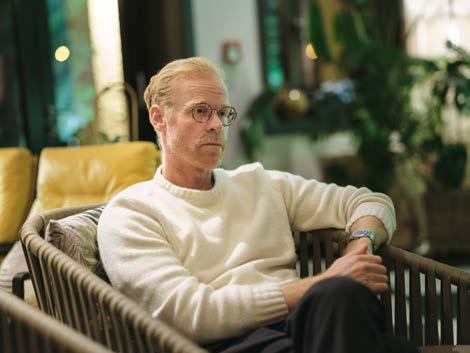
“THE MAGIC HAPPENS MUCH MORE IN THE PRELIMINARY STAGE THAN IN THE DESIGN DEPARTMENT.”
Sebastian Klinder, Managing Director of Munich Fabric Start
Let’s begin with the topic of innovation. Why does it still not have the spotlight it deserves when it comes to sourcing? We’re talking about incredible potential here –especially in terms of sustainability.
Sebastian Klinder, Managing Director of Munich Fabric Start: This question is what we all deal with literally every day. It’s part of our job to answer it with innovative concepts and creativity, every season.
Christof Hornung, Owner Agentur Hornung: For over 25 years now! Every day, I meet customers, and I try to bring them to a new level – whether it’s a new season, a fresh perspective, or innovative thinking. Without innovation, I’m lost. If I don’t have something new in my collection, my clients recognize it immediately, and I feel uncomfortable. Innovation drives my work each season. Everyone is so hungry to see new fabrics. Having the right appointments at the start is key.
Particularly in the sourcing industry, innovation sometimes feels to be more like an evolution. It’s not about seasonal trends shifting dramatically. When people talk about innovation, it’s often tied to trends. What’s your take on this?
Christof Hornung: That’s the exciting part. Among my clients, you have those who are

“THE FUTURE IS DURABILITY”
Luca Balugani, owner BUREAU31
years ahead – two or three years, sometimes. They see something and say: “Wow, this is brand new; we’ve never done this before.” Then there are others who don’t understand it at all. That’s the beauty of working in textiles. There are always different speeds, different markets, and various directions.
Luca Balugani, Owner BUREAU31:
Exactly. From my perspective as someone from Prato, Italy, I focus on a specific category of fabric. Christof has exclusively Italian suppliers, which reflects a conscious decision to work within a high-quality, innovative niche. When we talk about fashion, it’s a wide range from Primark to luxury brands like Balenciaga. Each has different concepts and needs. Making a universal statement is difficult. What we see today is that everything is available on the market, at any price. But our clients expect Italian fabrics to offer something innovative. Something they can’t get from China or Turkey.
They expect a certain kind of magic?
Luca Balugani: Exactly. Take recycled cashmere, for instance. A mill we work with created a collection using 100 percent recycled cashmere. They started with jerseys and later developed woven fabrics like coats, all using the same yarn. The concept was affordable cashmere that’s also sustainable. It’s cheaper than new cashmere, reduces water use, and requires no new dyeing since it’s recycled. That’s why it was a hit.
It feels like science spearheads this kind of innovation. Would you agree that science is the driving force here, more so than design?
Sebastian Klinder: Absolutely. The magic happens in the sector that we call the preliminary stage, not necessarily in the design department. That’s the evolution we are focusing on with Munich Fabric Start. This sector is gaining more and more importance in the whole industry because they are not only inventing new fabrics, but they are also inventing new stories and new looks.
Christof Hornung: Yes, and people often forget that this preliminary stage isn’t done by designers but by technicians who take inspiration from our ideas and concepts.
Luca, Prato is fascinating. It’s an old hub of textile innovation. How does it maintain relevance today?
Luca Balugani: Prato has been recycling fibers, especially wool, for over 150 years. Originally, it was about affordability, but now it’s about sustainability. We collect old garments, sort them by color, and blend them to create new materials. This process saves water, reduces the use of chemicals, and eliminates waste. Recycling isn’t new for us –it’s in our DNA.
Christof Hornung: And that ties perfectly into durability – buy less, buy better.
Luca Balugani: Exactly. But durability isn’t just about the product; it’s also about
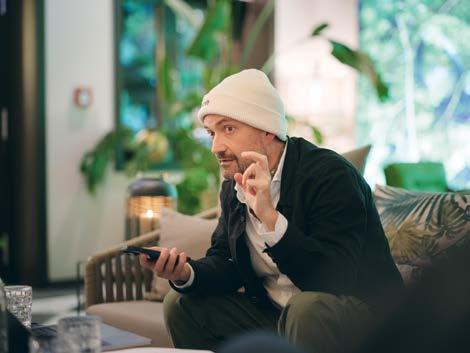
“DURABILITY IS SUSTAINABILITY!”
Stephan Huber
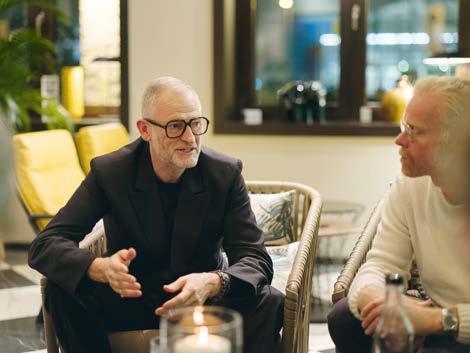
“CREATIVITY IS THE HEART OF SUSTAINABLE INNOVATION.”
Christof Hornung, owner Agentur Hornung
preserving technical expertise. Prato’s mills specialize in specific processes. If those mills shut down because trends change or markets move, it’s almost impossible to bring them back.
Durability is sustainability! It’s about producing smarter, not faster.
Luca Balugani: And that’s something our clients are beginning to value more. For example, Windsor, one of our biggest customers in the German-speaking market, loved the recycled cashmere we showed them. We started with jersey fabrics, but when they asked us to expand into woven fabrics, we delivered. Now, their winter collection includes coats and blazers made with the same yarn. That’s how innovation grows – by building on strong concepts.
It’s a powerful story, and storytelling seems to be key to repositioning concepts like “Made in Italy.” It’s synonymous with quality and artisanship, but it’s often seen as expensive. How do we change that?
Luca Balugani: Through storytelling, absolutely. Recycled cashmere is a great example—it’s not just sustainable; it has a narrative that resonates with consumers. It’s stylish, resource-saving, and affordable. People want to know the story behind what they’re buying.
It reminds me of the food industry. Brands like “Ja! Natürlich” [Austria’s first and biggest all-organic foodstuff
brand] succeeded because they created an emotional connection with their audience. Fashion needs that same approach.
Sebastian Klinder: And that’s where platforms like Munich Fabric Start a re coming in. We’ve evolved beyond being just a trade show. It’s about creating a space where sourcing, design, and marketing come together as a matrix to share knowledge and inspire. Where people have the advantage to match with experts and to use the knowledge and expertise out of the preliminary stage and combine it with creativity and marketing. With new approaches to the market and the costumers. The story of this stage isn’t just interesting for buyers and producers anymore—it’s for the end consumer too. Because in the end, the stories and concepts are the only reason this industry exists.
But how do you balance that? Informing without overwhelming or offending your audience?
Frank Junker, Creative Director & Partner of Munich Fabric Start: We must take care that we are not losing the important part of it, the culture, the inspiration, the fun of fashion. Since a few years, we are not calling it trade fair anymore, we are talking about a show. A show that brings connection, that fuses the buying and the selling act with a lot of information, inspiration and innovation. That’s a completely different approach.
So, if we talk about redefining the preliminary stage, can this be the path to a more conscious consumption? Fast fashion
drove unconscious consumption, but there’s a growing demand for conscious, thoughtful practices. How do we encourage that shift?
Luca Balugani: Smaller, smarter production cycles. Focus on fewer, better-quality products. And bring manufacturing closer to home – Europe can thrive on reindustrialization.
Sebastian Klinder: Shorter lead times, local production, and reconnecting consumers with their products – that’s the way forward. And for this approach you need closeness to the market and the consumer.
Christof Hornung: Creativity must lead. When turnover drives everything, the magic disappears. Let’s bring that creativity back –it’s the heart of sustainable innovation.






Denim know-how, investment in the product: The European edition of True Religion is developed under license from the Unifa Group.


For the new fall/ winter season, True Religion is translating the Western-bohemian trend into the here and now with casual ease.
Thanks to a high-quality material mix of recycled denim, modal and spandex, the new denims have a surprisingly soft feel and are particularly comfortable to wear. The new straight and straight-fitted jeans are joined by a wide range of variants such as wide legs, O-shapes and cropped styles, which go well with boots. The typical Western details are more subtle, as in pants with slight distressed effects and frayed hems.
Blouses made of Georgette, soft denim or fine flannel with fringed and flounced details, as well as checks, match the modern romantic attitude. Sweatshirts, sometimes overdyed, sometimes with embroidery, become favorites and, along with cozy knitwear such as oversized ponchos, boxy jackets and long coats, complete the contemporary Western style. www.unifa-fashion.com



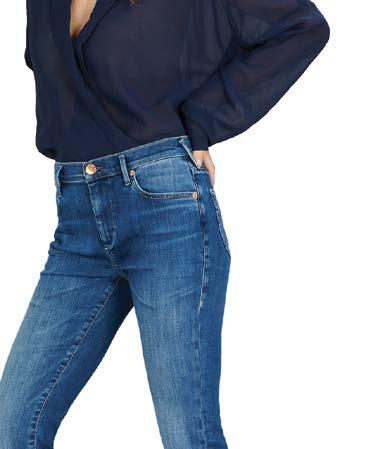









The decision to abandon the seasonal rhythm was a direct result of the product itself. The sophisticated outerwear collection Alpe Piano can be worn all year round, especially in times of increasingly unreliable temperature periods. The jackets and coats, made from locally produced loden, boiled wool and tweed fabrics, are just as effective against the wet and cold of late fall as they are against the springtime frosts. Consequently, the South Tyrolean company only produces one collection per year. Presented for the first time at Pitti Uomo in 2024, the first season saw the addition of Kabira International from Osaka as a partner for Japan, alongside the Manners agency in Milan. An agency is still being sought for GAS-region. The collection represents a reduced, understated style that interprets classic fabrics in a very modern way. With fashionable cuts, sporty hooded jackets and casual blazers, as well as classic outerwear, Alpe Piano translates the functionality and advantages of alpine fabrics for an international audience. www.alpepiano.com


THE NAME SAYS IT ALL: ALPE PIANO IS THE ESSENCE OF ALPINE FABRIC EXPERTISE PAIRED WITH THE LUXURY OF DECELERATION.
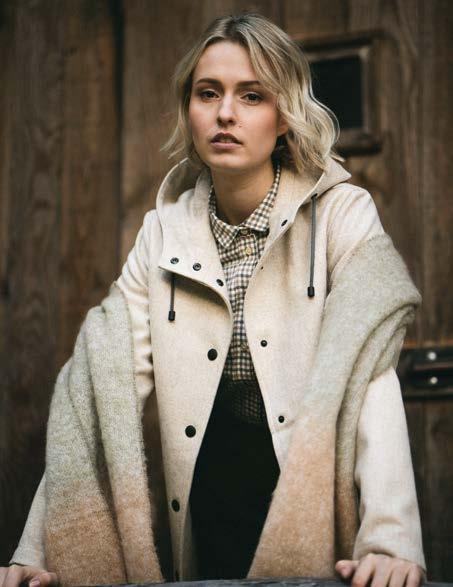
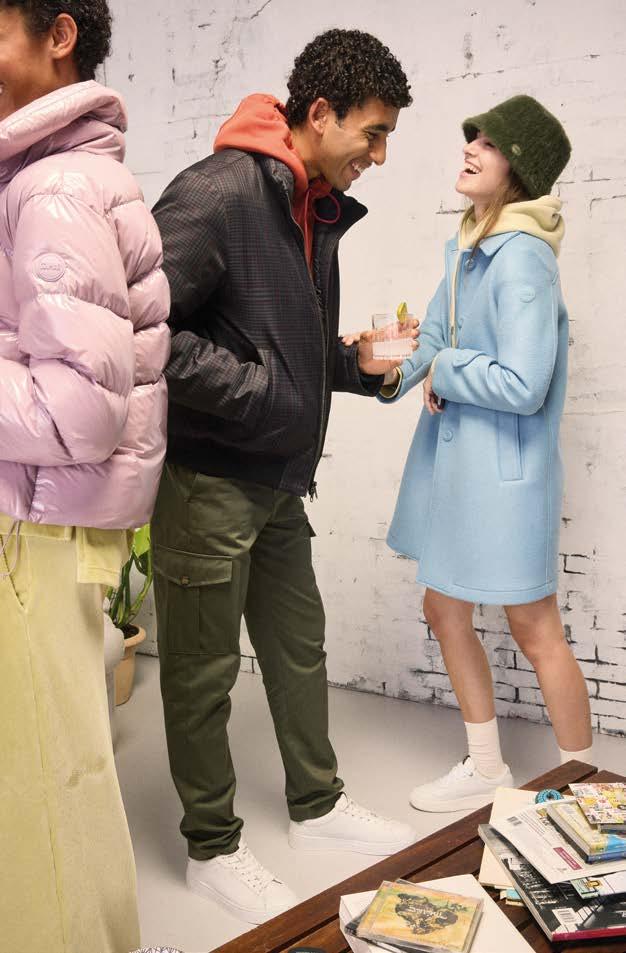



WARM, COZY AND COLORFUL: THE NEXT WINTER COLLECTION BY COLMAR ORIGINALS.
COLMAR ORIGINALS
Colmar Originals presents a wellthought-out collection that combines originality and functionality. The focus is on the total look.
Urban designs meet sporty inspiration, implemented in high-quality materials and innovative details. For men, classics are given a modern interpretation: puffer jackets with geometric tribal patterns, jackets made of technical wool and innovative designs set new accents, while light parkas and scuba jackets add versatile options to the line.
The women’s collection impresses with creative fabrics such as jacquard, terrycloth and chenille. Reversible faux fur, shiny down jackets and hybrid models offer both elegance and function. New additions such as jumpsuits and flannel blouses set highlights. The Revolution line adds timeless, combinable pieces to the collection. Wool jackets, imitation leather bombers and knitwear feature clean lines and harmonious colors, while sweatshirts and ribbed wool dresses add casual accents. www.colmar.com

















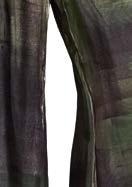





GENEROUS AND ENVELOPING SILHOUETTES ARE A MUST.























is one of the
of

































The new Avant Toi pre-collection for women has a clear focus on comfort and a sense of security. The collection is centered around the concept of cocooning. Generous, enveloping silhouettes and soft, tactile materials create a feeling of protection and warmth that appeals to body and soul alike.

High-quality fabrics such as cashmere, silk satin, recycled cashmere and ribbed viscose jersey underline the label’s unmistakable style. Surfaces made of soft felt, brushed textures and marbled effects convey a sensory experience inspired by nature. The collection is complemented by knitwear and accessories such as silk scarves, hats and gloves, which perfectly round off the cocooning look. The color palette is both calming and timeless. Earthy tones such as taupe, houndstooth brown and antelope meet mystical heather green and deep midnight blue. avant-toi.it








THE KEELING COLLECTION IS A REFLECTION OF BREATHTAKING MOUNTAIN LANDSCAPES.

KEELING

The sales results for lifestyle and sportswear line Keeling after their first fall/winter season in German-speaking countries were very encouraging. The core theme of the collection remains piece dyeing and its sustainable production process. The patented dyeing process saves up to 90 percent energy and water and makes it possible to donate a portion of the profits to a selected environmental project each year. This season, the Andean Forest Keeling Collection will help local communities in the region around the Naciente del Rio Tigre National Park in Argentina to reforest an area of over 29,000 hectares that was destroyed by fire. For the fall/winter season 2025/26, more winter themes are being considered, such as warmer sweaters and an outerwear line that offers more than just transitional jackets. The jackets, knitwear, sweatshirts, jerseys, pants and accessories are inspired by remote, wild mountain regions where the vibrant hues of rugged mountains, crystal-clear water and expansive skies come together in perfect harmony. @keeling.io

Pitti Uomo Florenz 14.01. – 17.01.25
Fashn Rooms Düsseldorf 23.01. – 28.01.25
Areal Böhler, Hansaallee 321, Kaltstahlhalle
Showroom Munich, Römerstr. 14, München 30.01. – 28.02.25
www.diehinterhofagentur.de













Founded by creative director Jakub Kubica, managing director Inti Castellazzi and head of production Stefano Gargano, Dualle is thoroughly shaking up the image we have of Italian underwear brands. Inclusive, without overt sexiness, but with a great sustainability factor. High-quality fabrics from natural sources are used, all woven in Italy. The brand also uses a cold dyeing process developed by Dualle in their studio in the Italian Alps. With plans to expand the range to include perfumes and special experiences, Dualle is positioning itself as a lingerie brand that fits women’s modern self-image. dualle-store.com
Welcome to Lola’s World! The Lola Casademunt collection is new at Agentur SchulzAco for the German and Austrian markets. She translates urban chic into versatile styles that create a total look with satin dresses, cargo pants and tweed-tartan blazers, trench coats, metallic down jackets and animal print fur vests. Colors such as khaki, lime, orange, purple or copper, as well as zebra and snake prints, are also characteristic. Luxurious textures such as satin, jacquard and a material in leather optics go well with this. The average retail price is 150 Euros. The brand, founded in Barcelona in 1981, has been managed by Maite Casademunt since 2018. www.acomode.de, www.lolacasademunt.com
Short supply chains, sustainable materials and a touching detail: each product bears the label of the seamstress who made it. The Franconian accessories specialist combines tradition and innovation with a clear stance. Natural and functional fibers ensure comfort and a clear conscience. Production takes place mainly in the P.A.C. Green Factory in Schweinfurt and in European knitting mills. The result are timeless essentials and trendy it-pieces that stand for fairness – in design, quality and price. Suggested retail price: 19.99 to 49.99 Euros. www.pac-original.de, @pac.original



Founded by Michela Parrini and her daughters Diletta and Benedetta Barontini, Archivi Sartoriali focuses on high-quality custom-made clothing for men and women. By using materials from exclusive fabric archives, sustainable production methods and Italian artisanship, unique garments are created that embody elegance and individuality. Archivi Sartoriali is aimed at people who see fashion as an expression of their personality and value quality, authenticity and timeless aesthetics. Each piece is unique and a statement at the same time. Available to buy at the studio at Manifattura Tabacchi, Florence. archivisartoriali.com
Founded in 2024 by Marco Huelsebus, the brand is much more than just jewelry – it’s a movement. The brand combines traditional artisanship with modern technology, in particular artificial intelligence, to create unique, personalized designs. The collections stand for self-realization, diversity and body positivity and send a strong signal supporting individuality. Ethical manufacturing and sustainability are particularly important to Maison le Super. Each piece of jewelry is made with respect for the environment and in close collaboration with talented artisans who incorporate their passion into every detail. www.maisonlesuper.com
Leather jackets? Often, you buy that perfect one, once in your life. And for this one perfect leather jacket, Salvatore Santoro is a good choice. After all, he has been working on leather with dedication since 1987. He has had machines customized and pushed the boundaries of leather processing techniques more than once. In addition to women’s and men’s collections and a reworked collection made from leather remnants, there are also Shearling models. Modern oversized shapes and a contemporary visual language underline the international fashion approach of the label, which is managed in Europe by renowned distribution agency Marcona3. salvatoresantoro.com
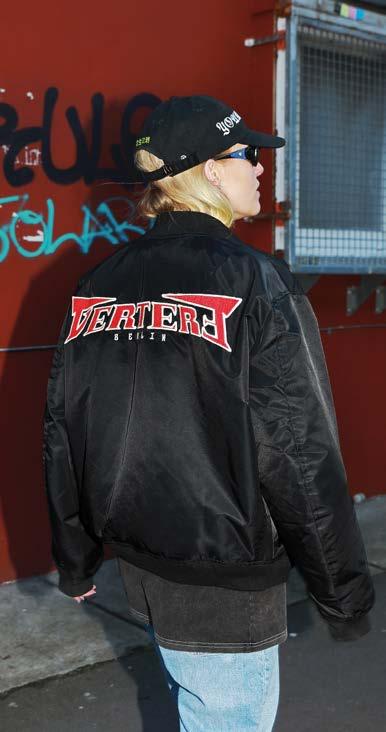
















Ulrich Hasselmann and Jonas Michalak founded the top-of-mind streetwear brand in 2018, inspired by Berlin’s dynamic club culture and electronic music scene. Since then, there has been a capsule collection with Hugo, a pop-up at Breuninger in Stuttgart, parties during Milan Fashion Week, monthly parties in Berlin and collaborations with DJs, designers and artists. In addition to the Superconscious Store and the record in Berlin, the styles are also available at Geschwisterliebe in Stuttgart and at Ansons and Wormland. Their first own store has just opened at Rosenthaler Platz in Berlin-Mitte. @vertere_berliin
Cultura. A streetwear brand that has been combining Italian heritage with urban style since 2017. Completely made in Italy, the Milan-based brand boldly reinterprets workwear, creating hoodies, cargo pants and T-shirts with often provocative graphics. Also inspired by skate and motocross elements, the brand combines Italian quality with the authentic spirit of American streetwear. Represented by Marcona3, Cultura has convinced renowned retailers such as Antonia, is annually growing by 30 percent and achieves an average sell-out of 80 percent – figures that speak for themselves. culturaofficial.com
In the forests of the Virunga Mountains and Bwindi Impenetrable National Park live the endangered mountain gorillas. The sale of That Gorilla Brand t-shirts and hoodies supports the gorilla conservation organization founded by primatologist Dr. Dian Fossey. The project also includes organic farming and tree planting to provide impoverished communities with the opportunity to earn a sustainable income without relying on the natural resources of the forest where the gorillas live. At the same time, educational projects spread the message of gorilla conservation among communities in Central and East Africa. www.thatgorillabrand.com



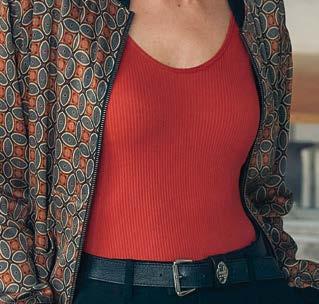

Chalo. “I grew up with my father always wearing cowboy boots in India in the early 1990s,” says passionate founder Mitali Gupta. “Since then, cowboy boots have been part of our family.” And so, in 2023, a women’s boot collection was created that combines traditional artisanship and fashion – small and simple, easy to wear and at retail prices between 195 and 245 Euros. The production site in northern India is equally small and deliberately designed, with recycled materials being used to manufacture as sustainably as possible. So far, Chalo is available not only in India but also in the United States and Germany, where the aim is to expand the presence organically. The next step? Cowboy boots for men. www.madetochalo.com
Will the headbands from Vienna also become a trend up further north? Their story is definitely worth telling – and adorable, as Ibby and Puzz are the nicknames of the grandparents of the founder, Danielle Dahlstrom. “Don’t worry, I love you” is the phrase that Ibby used to end letters to her husband with. It can be found on each of the handmade, unique items. The starting point was 2023, after Dahlstrom found richly patterned fabrics on her travels in Uzbekistan. The headbands are available in two widths, made of ikat silk, cashmere, velvet and leather, and retail for 90 to 140 Euros – at Popp & Kretschmer, Reyer and Rasper, among others. www.ibbyandpuzz.com
The Berlin label, founded in 2016, stands for ethically manufactured clothing with a vintage aesthetic and modern cuts made from environmentally friendly materials such as Oeko-Tex-certified cupro, Tencel and GOTS-certified cotton. They started out with a reversible bomber jacket made from recycled Indian textiles, which set new standards for environmentally conscious fashion with artistic aspirations. In addition to jackets, Yahmo also offers shirts starting at 139 Euros, pants starting at 149 Euros, kimonos starting at 159 Euros and fanny packs starting at 45 Euros. All items are transparently manufactured in their small workshop in Mumbai, India, where fair working conditions and living wages are guaranteed. www.yahmo.de


So beautiful that you instinctively want to touch them – Pride to Be jackets and coats. In an unprecedented variety of materials, feminine as always. The range of models extends from the well-known fake fur mink qualities, in the coming season in such poetic colors as rose or ivory, to longer Toskana fur looks, teddy or a fine wool quality. The silhouettes are varied, from short bomber jackets to long coats. “Pride to Be is perfect for all days when winter is not freezing cold – whenever you want to make a statement with a jacket or coat,” says mastermind Marion Hoferer.

The full range of materials and colors comes with a top price-performance ratio: between 74 and 129 Euros purchase price and with a continuous calculation of 3.0. A stock for exchange and reordering accompanies the season. “We only serve independent retailers with Pride to Be, no large online retailers, no marketplaces. This makes the product insusceptible to reductions and is incomparable.” Pride to Be also offers private labels to retailers who want to stand out even more. “Your own label is not a problem,” says Marion Hoferer. What is her personal highlight of the collection? “I like the modernity, everything has a little special twist.” @pridetobe



















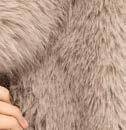









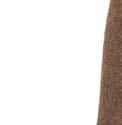





















Tuscan lamb style, mink fake fur, shearling look or teddy: Pride to Be shows off all its skills.














Joseph Payr, managing director of the successful, long-established Austrian company Steinbock, has made a strong statement with the establishment of outdoor brand Maximilian. He relies on a well-coordinated team, trustworthy cooperation with suppliers and a well-maintained image.
Maximilian stands for a contemporary lifestyle. What innovations does the current collection showcase?
Joseph Payr, managing director: “Maximilian reflects the desires of a stylish fashion world. Beyond the general mainstream, Maximilian does not focus on maximizing margins, but on the use of carefully selected materials that are crafted into unique coats and jackets using tailoring skills that have been handed down for decades. Noble cashmere fabrics with climate-regulating functions and new technical surface structures provide a state-of-the-art appearance. Warming down inlays turn fluffy wool pieces into cold-resistant winter companions.
Where do you currently see the biggest challenges?
Our biggest task will be to bring our special products to the attention of our interested consumers. The reduction of sales channels due to the closure of many stores is making it increasingly difficult for us to access the market.
Which markets are you focusing on in particular?
Our main customers are certainly in Germany, Italy and France, although we also want to use targeted marketing to increase sales in other markets such as the US and Asia.
www.maximilian-fashion.com

MODERNITY AND INNOVATION WITH A LOT OF TRADITION.
Maximilian combines contemporary designs with a sense of style.





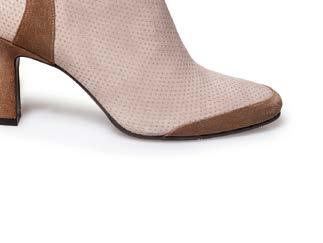

The collection by the Dutch shoe manufacturer features many new highlights for fall/winter 2025/26. The assortment is accentuated with belts and bags. Elegant, lightweight women’s sneakers with glittering velour, the finest black nappa, delicate, airy organza laces and a wavy, lightweight sole with a heel tab are chic all-rounders for any look. Waxed suede in a leopard look meets golden metallic elements and glittering mesh-like suede for a sophisticated and elegant upper. This is combined with a new, timeless rubber sole made of a phylon blend and a vintage-inspired logo. Funky and classic at the same time: A Norwegian model with sparkling pony hair, dark leopard details and luxurious snake-embossed suede. For men, classic indoor sneakers made of high-quality leather blends with abrasion-resistant rubber soles, inspired by a retro 1970s sports style. Brand new derbies and desert boots are made of printed Italian suede with a felt-like finish. Archival branding pays homage to more than 300 years of heritage. @florisvanbommel






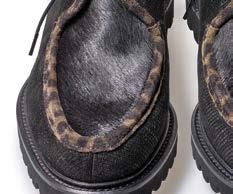



















“A classic man meets a casual style” - this is the motto for fall/ winter 2025. Minimalist design meets sporty elements, striking structures and technical details. The color palette ranges from clear, neutral tones such as light gray, cream and off-white to intense nuances such as moss green, chocolate brown, burgundy red and indigo blue, rounded off by accents in amber, chromatic gray-green and earthy cognac. The material concept relies on naturalness and thrives on exciting contrasts between different textures and designs. Soft flannels and tweeds made of wool, cashmere and silk provide comfort and warmth. The new silhouettes feature single or double pleats for a modern, casual look. Flowing fabrics emphasize the luxurious coziness of the round, supple styles. Chinos and five-pocket pants, on the other hand, tend to be slim-fitting – a perfect balance between classic and modern. @hiltl_official

For many years, Hartford has been impressing time and again with high sales figures every season.


You won’t find any outward labelling at Hartford from Paris. “American lifestyle interpreted in a French way” is how the casual style of Yves Chareton, the founder of the brand, can be described. Understatement with an authentic message, always with high-quality materials. The complete Hartford look includes jackets, coats, knitwear, sweatshirts, jerseys and shirts, with new favorites for men coming out all the time. The Hartford women’s collection has been around for several years. With a great sense of style and quality, but also with the appropriate fashionable up-to-dateness, the French brand has made a very good name for itself in the high-quality women’s wear trade. The coats and jackets, the perfectly fitting trousers and skirts, the soft and extravagant blouses and, last but not least, the sporty knitwear range, which was expanded this fall/winter, are all worth mentioning here. @hartford



SCANDINAVIAN EDITION
For fall/winter 2025/26, the collection of the Norwegian brand has been expanded again to include a few new styles. The Loro Piana capsule now includes a new winter jacket made from the legendary breathable, water-repellent Storm System fabric, available in two colors. Also new is the Apex line, in which bestsellers have been refined and further developed to offer the highest level of functionality. The use of stretch material in both the upper materials and the inner linings ensures maximum comfort with outdoor functionality, while maintaining a restrained, timeless design. The detachable hoods provide additional versatility. In total, there are 25 models for men, including two vests, dressed jackets, coats, blousons, shirt jackets, as well as short, long and mid-size jackets with and without hoods. Weather protection, comfort and contemporary design also merge in the independent women’s collection, which includes 18 models in up to seven colors. The updated lining materials are made of exclusive fabrics and sophisticated seamless construction, giving a feeling of understated luxury every time you wear them. www.scandinavianedition.com

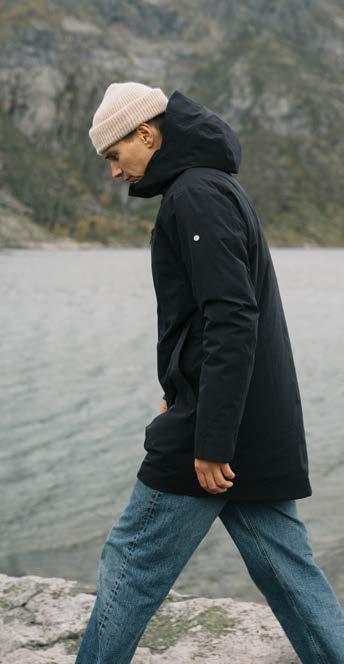



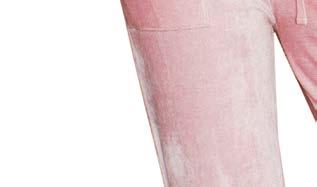



The formalization of fashion as a major counter movement to the casualization of recent years is progressing unfailingly. Sports and streetwear are not spared, but, as usual, they find their very own characteristic way of incorporating successful references. As so often, there are two styles whose divergence dominates everything: one that celebrates big performances, deliberate exaggeration and the fun of loud statements. And a very quiet one that is dedicated to the sustainable trend of slow fashion and the luxury understanding of thorough quality. To sum up the charged tension that unfolds between these two strong slow fashion and the luxury underpoles in one word: Fashion.
























































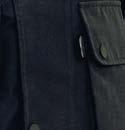





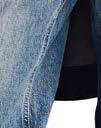



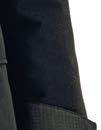


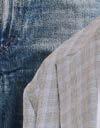
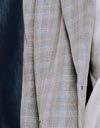

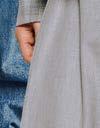
















































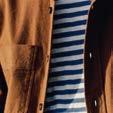


















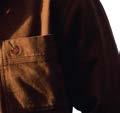


















































Robust elements of functional mountain and winter sports equipment provide the basis for stylish adventure looks that are suitable for the city. Topics such as wearable tech and intelligent fabrics, new material blends and utility design play just as important a role as technical down and multi-functional detailed solutions.

























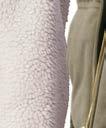



































































































































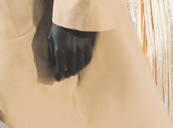











































































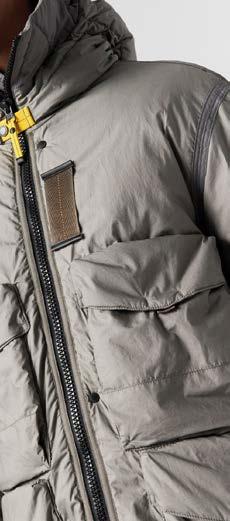



























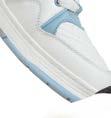























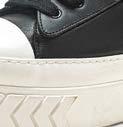

















































Street- and sportswearbrands combine breathable materials with urban cuts and design approaches. Elastic fabrics, functional features such as mesh inserts or technical material combinations meet unisex silhouettes that are not only comfortable but also aesthetically striking.

















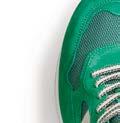




















































































































































14-17 FEBRUARY 2025



































More is more. That’s the maximization of form, cut, volume, pattern and color. Oversized silhouettes are combined with chunky boots, XXL jewelry and accessories with lots of volume like puffer bags. Down is used as well as XXL knitwear. It’s all about the pure fun of making a bold statement and like puffer bags. Down
































































































































































































































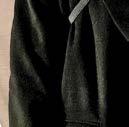





























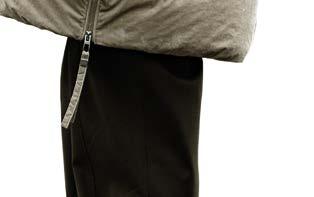

















Formal wear incorporates many boho and Western elements. Boxy, structured blazers and androgynous suits with asymmetrical cuts are just as likely to be seen as exaggerated lengths and volumes –right up to the highlight of this look, the floorlength blazer. In terms of color, it remains classic, tone on tone in powdery, natural nuances.













































































































































































































































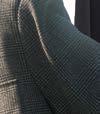
























































processing techniques, sustain-
Attributes such as slow fashion and silent luxury hardly do justice to this topic, which is primarily about materials. High-quality fabrics and subtle, unobtrusive colors allow the focus to fall on high-quality processing techniques, sustainability as a major driving force, and delicate details.









































































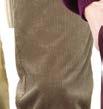










































































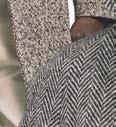
















































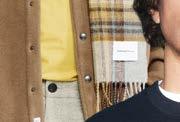





















































Denim is coming back more and more as an all-over look, very much in the style of the 1990s. Wide-leg, flared, and boyfriend cuts remain present. Laser-printed and patterned fabrics are statement pieces and special highlights. Denim is showing itself in all its facets: Sustainable, innovative, and extremely versatile.
























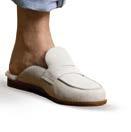



















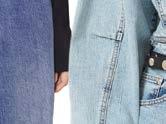


















































































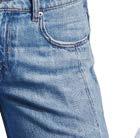

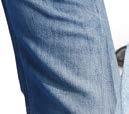






























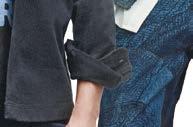






























An invitingly laid-out table in a fashion store, with imaginative ceramics by Les Ottomans? Anyone familiar with Peter Blösl and Altra Moda knows that it’s all about that special twist.
Text: Nicoletta Schaper. Photos: Altra Moda
Uniqueness is the main focus of the collections that Peter Blösl selects for his store. “Fashion doesn’t live off the label,but through cuts and materials,” he emphasizes. Added to this is the style, which lasts for seasons, as does the quality.
Menswear, for example, is led by Cellar Door, Ten C, Roberto Collina and Dondup. In womenswear, Dušan, Sofie D’Hoore and Plan C define the range. These are creative without being loud. The input of his wife, Monica Marando, owner of MMB consulting, is also reflected in the selection. The two are an inspiring couple. “She is the visionary and travels a lot, I’m more of a calm haven,” says Peter Blösl. At the end of the 1980s, he had caught the fashion bug and opened his first shop in Traunstein with brands such as Replay, Blue System and Oxbow. In 1993, the second shop followed, which closed again in 1996 because the workload as a one-man show could not be managed. What remains is a concept with Altra Moda that has evolved alongside its customers. “Multi-brand stores like ours are rare. At the same time, we have built something here that will last, by clearly differentiating ourselves with our range,” says the Traunstein native. No less important is the customer base, which extends far beyond Traunstein. This is thanks to popular store events, social media and the lovingly cultivated tradition of sending personal postcards to the most loyal customers every year. They bear selected motifs by photographer Oliver Spies, who has been a close friend for many years.
Altra Moda. Stadtplatz 26, Traunstein, Germany, Owner: Peter Blösl, 90 square meters
Brands: 8 Eden Avenue, Aliita, Dondup, Cellar Door, Dušan, Hannes Roether, Hidnander, Konrad, Ludwig Reiter, Marsèll, Péro, Plan C, Suzusan, Roberto Collina, Sofie D’Hoore, Ten C, Weingut-Heinrich www.altramoda.de


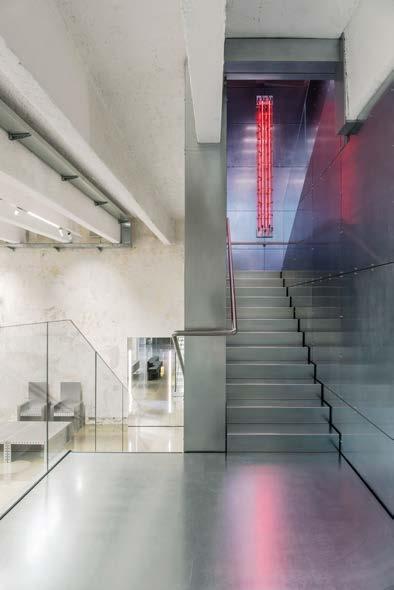
10 CORSO COMO/MILAN
It was time for a makeover at 10 Corso Como in Milan. Under the creative direction of Tiziana Fausti and Agentur 2050+, the legend is receiving an update.
Text: Janaina Engelmann-Brothánek. Photos: 10 Corso Como
Whether it’s for order appointments or Design Week, a visit to 10 Corso Como is simply a must when you’re in Milan. With this slightly nostalgic touch of the birthplace of the modern concept store. Since fashion entrepreneur Tiziana Fausti became involved as an investor and also took on an operational role, 10 Corso Como has taken on a new spirit. Internationalization is forging ahead – most recently, for example, with a guest appearance at Lodenfrey in Munich. Their impressive network is fully utilized in the renovation: the central element is a staircase clad in stainless steel. International designers shape the redesign: Jesper Eriksson designed a counter made of black carbon, Laurids Gallée combined metal shelves with upcycled resin, and Odd Matter designed tables from recycled glass. A highlight is the fiery red neon lamp by The Back Studio in the stairwell. And how do you celebrate a reopening like this? With the launch of Phoebe Philo’s collection, exclusive to Italy. Network, baby!
10 Corso Como. Milan/Italy
Owner: Tiziana Fausti, Area: 570 sqm
Brands: Alaïa, Alainpaul, Comme des Garçons, Comme des Garçons Homme Plus, Loewe, Magliano, Maison Margiela, Molly Goddard, Namachenko, Niccolò Pasqualetti, Phoebe Philo, Sacai, Yohji Yamamoto
Magdalena and Markus Budim have given Vienna another great jeans store. Do jeans stores still exist? They do if it’s up to this denim-crazy couple, who have turned a backyard location into a best-kept secret in the sixth district.
Text: Martina Müllner. Photos: Daniel Kalt
Off-location on Mariahilferstraße. The Raimundhof is the perfect home for a real specialist store: The Budims, that’s Magdalena and Markus Budim, who together have been the soul of their “Denimdealer No 1” since 2018. A blue wall, the heart in the right place and a lot of blue blood in their veins. Service and advice are at the top of the list of things that make The Budims special. With a competent range of authentic brands, from Levi’s to Butcher of Blue, they find the perfect jeans for every customer. The magic word here is intensive customer care.
The Budims are denimheads themselves – with a penchant for events that promote togetherness. Whether it’s a table tennis tournament or dip-dying, when Magdalena and Markus issue an invitation, the rush is so great that events even have to be relocated to the courtyard. “Luckily, we share it with some really great shops that are happy to see the courtyard come to life.” Workshops could also follow soon; the topic of upcycling is close to the couple’s hearts and Magdalena wants to show what is possible with a little creativity.
The Budims. Mariahilferstrasse 45/15, Vienna/Austria
Opening: 2018, Owners: Magdalena and Markus Budim, Retail space: 60 square meters
Brands: Butcher of Blue, Dawn Denim, Denham, G-Star RAW, Kings of Indigo, Kuyichi, Levi’s, Orbitkey, Secrid



From its very inception, style in progress was more than a magazine title – it was a programmatic statement. Embedded within this name lies the essence of our DNA: “ e Future is Wide Open!”

Change is, by its nature, a challenge. At times, it can feel like an imposition, disrupting the comfort of familiarity and the security of consistency. So it is deeply human to long for stability, reliability, and the known. Yet, it is equally human to evolve, to strive for growth, and to dream of something greater.
Fashion, like life itself, is an ongoing narrative of constant renewal and reinvention. ese are not just constants that we are at the mercy of, but opportunities that we should gratefully seize. It is therefore not enough to accept the inevitability of change, it must be actively and consciously shaped. e future is nothing to be afraid of. It is a canvas waiting to be shaped by the courageous. Of course, following this belief is not always easy, especially when change is initiated or even forced from outside. In such moments, it is all too common for the rst glance to obscure the clarity of a necessary second glance.
Last summer, Martina Müllner informed me that she was stepping down from her position as editor-in-chief of style in progress, seeking the freedom to pursue new and di erent challenges. Admittedly, it took me a moment to recognize the opportunity. Consistency is not just a matter of convenience; it is o en the result of undeniable quality. “Never change a winning team…” as the saying goes. ere is a great deal of truth in it.
During a recent late-night drive, I calculated that the core team at style in progress has been together for an average of 18 years. If I may be so bold, that makes me very proud. A er all, it says something about the magazine, the people, and yes, about me as well. But to stay with the picture: even a winning team can be strengthened and enriched by a di erence-maker. is summer, I had the pleasure of meeting Lisa Hollogschwandtner in person – a serendipitous encounter, as I like to call such moments. Lisa is 27,
Publisher, Editorial Office, Advertising Department and Owner style in progress
B2B Media GmbH
Postal address
Postfach 0031, 5027 Salzburg
Austria
Company address
Bachwinkl 2, 5081 Anif/Salzburg
Austria info@style-in-progress.com
www.style-in-progress.com
@styleinprogress.magazine
www.linkedin.com/company/style-in-progress
Management
Stephan Huber
the same age I was when I published my rst own magazine, X-RAY. Next generation! It quickly became clear that Lisa represents both further development and consistency. Despite her youth, she brings with her many years of experience, in-depth industry knowledge, and, above all, the enthusiasm and belief in the future that de nes style in progress. is puts me in an exceptionally privileged position: I want to thank Martina for her invaluable contribution to style in progress. She has shaped and molded this magazine in countless ways. In terms of content and as a person. And fortunately, in this case, change does not mean goodbye.
At the same time, I am thrilled to welcome Lisa Hollogschwandtner as the new editor-in-chief. She will lead style in progress alongside me, combining the vitality of change with the strength of consistency in an ideal way.
e Future is Wide Open!





Editors-in-Chief
Stephan Huber
stephan@style-in-progress.com
Martina Müllner
martina@style-in-progress.com
Art Direction, Design, Production
Elisabeth Prock-Huber
elisabeth@style-in-progress.com
Managing Editor Johannes Seymann
Editorial Staff
Janaina Engelmann-Brothánek
Petrina Engelke
Isabel Faiss
Claudia Jordan
Kay Alexander Plonka
Nicoletta Schaper
Anna Varava
Malene Wagner
Veronika Zangl
Stephan Huber stephan@style-in-progress.com




English Translation
Georgmaria Prock
Manfred Thurner
Editor
Georgmaria Prock
Image Editing
Hannes Hemetsberger
Printing Sandler Gesellschaft m.b.H. & Co. KG, 3671 Marbach, Austria
Printing Coordinator
Manfred Reitenbach
Advertising Director
Stephan Huber
stephan@style-in-progress.com
Accounting
Verena Wigoutschnig
verena@style-in-progress.com



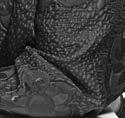





Digital Edition www.style-in-progress.com/en/epaper/
Next Issue #98 2 July 2025



